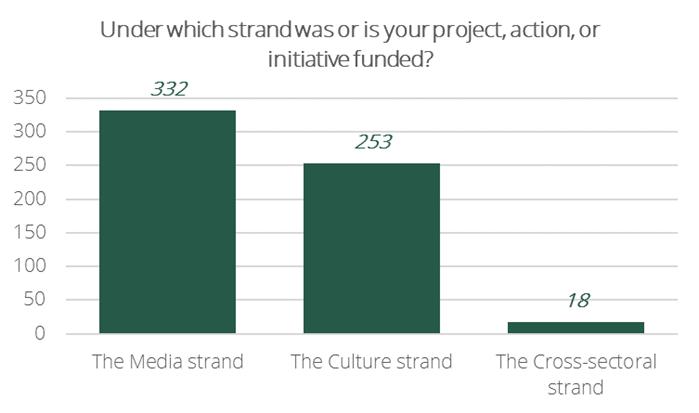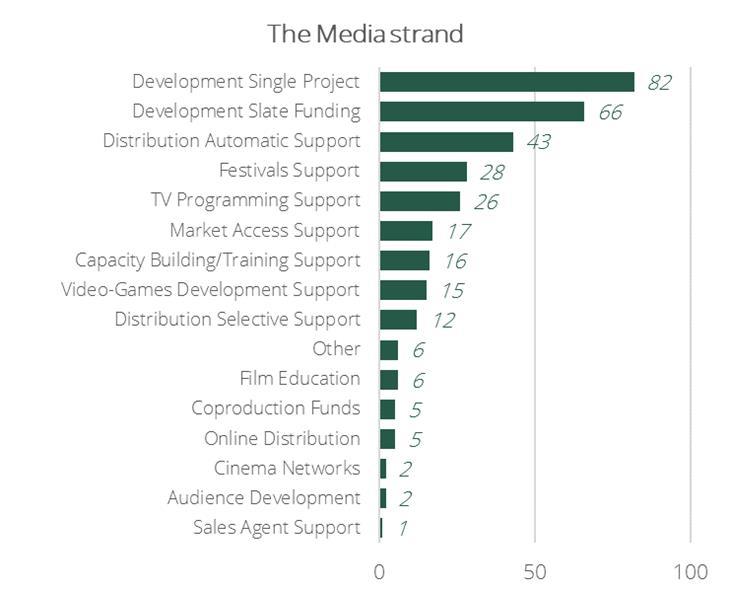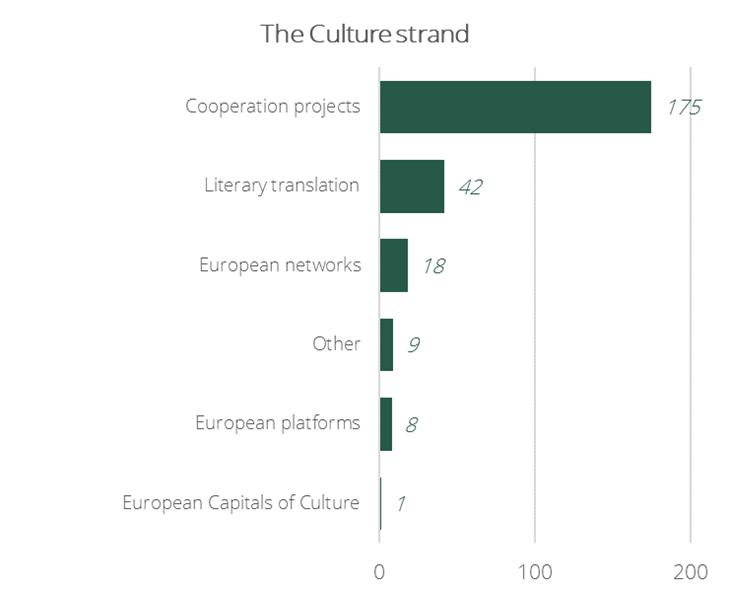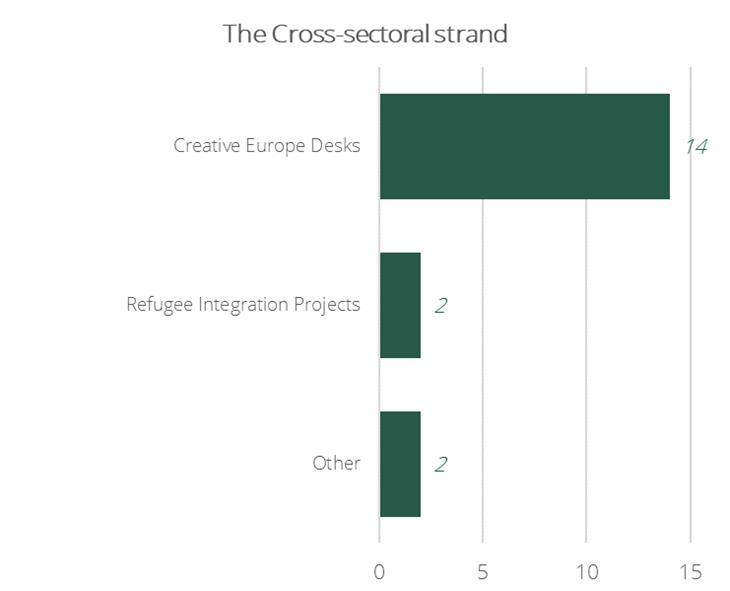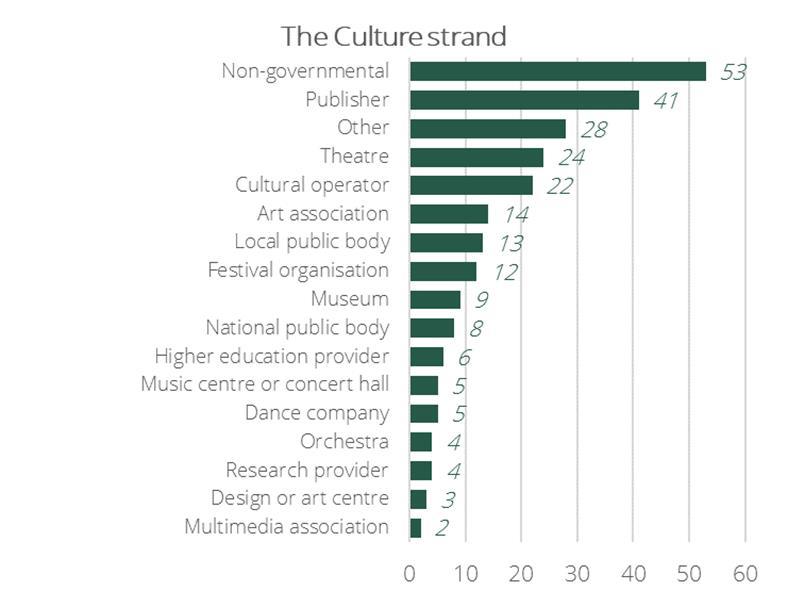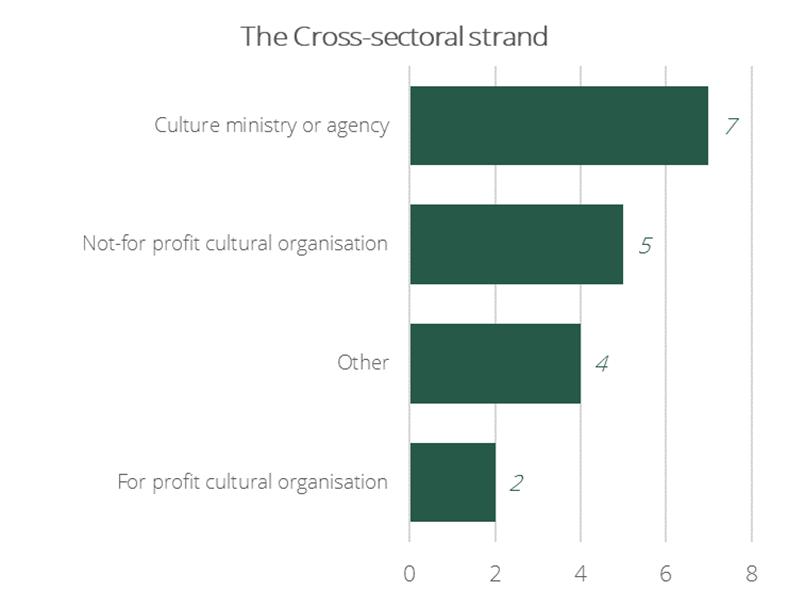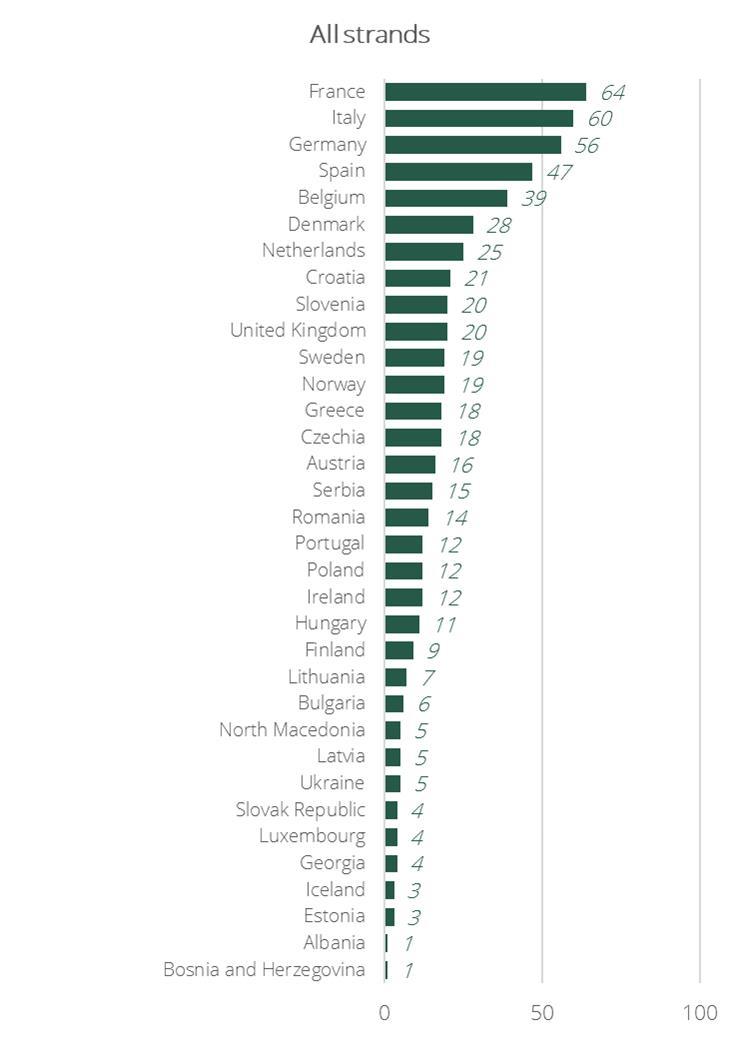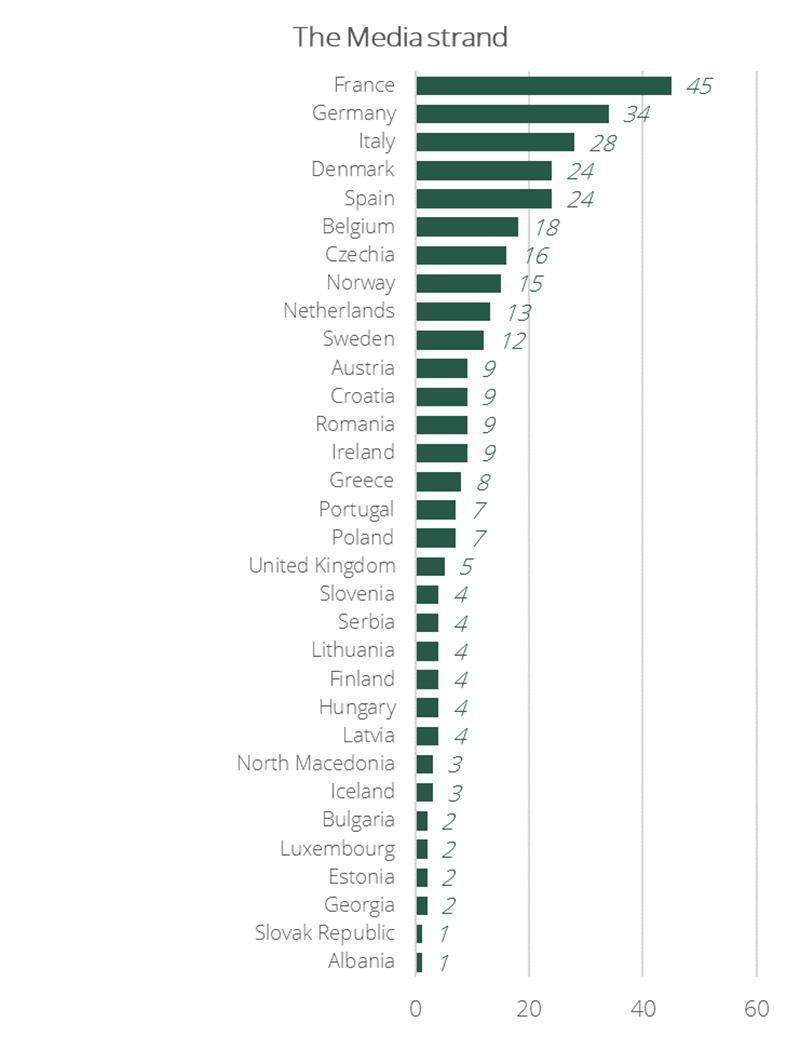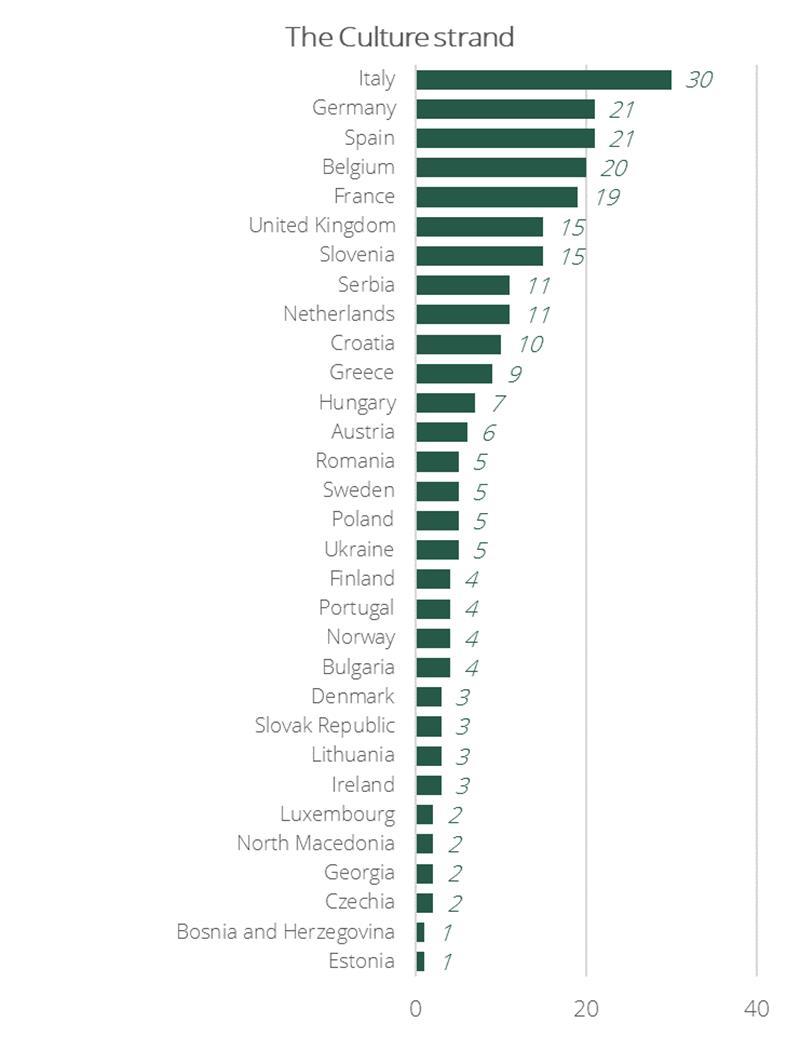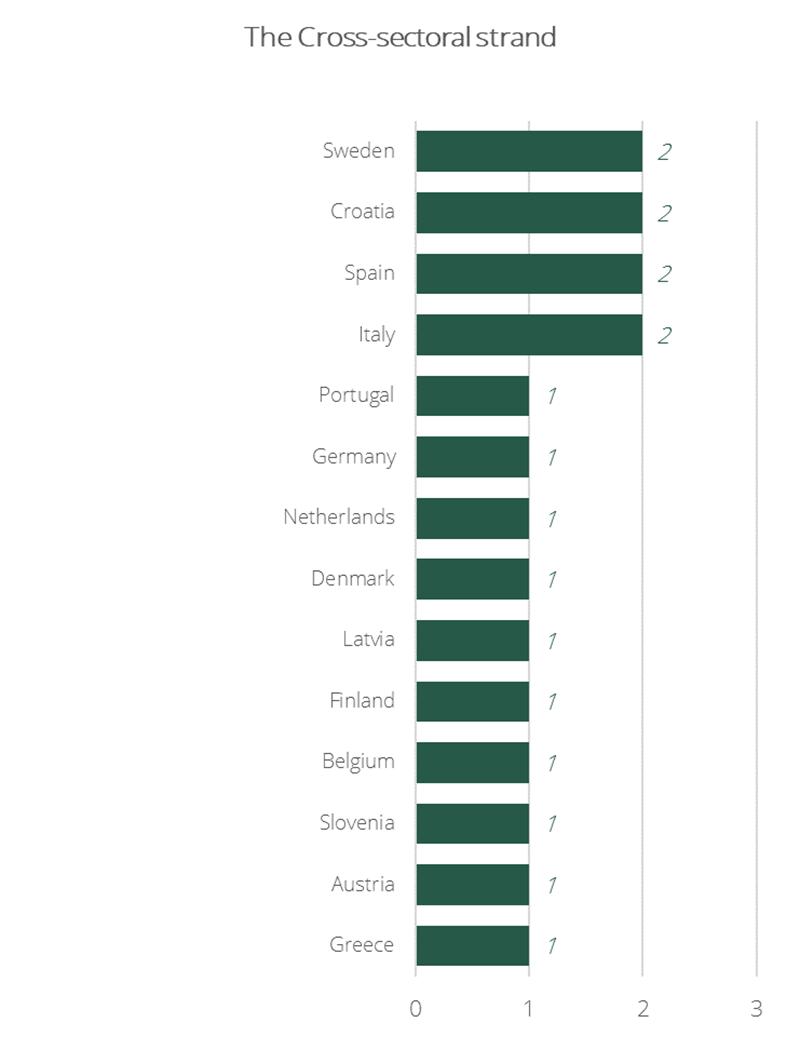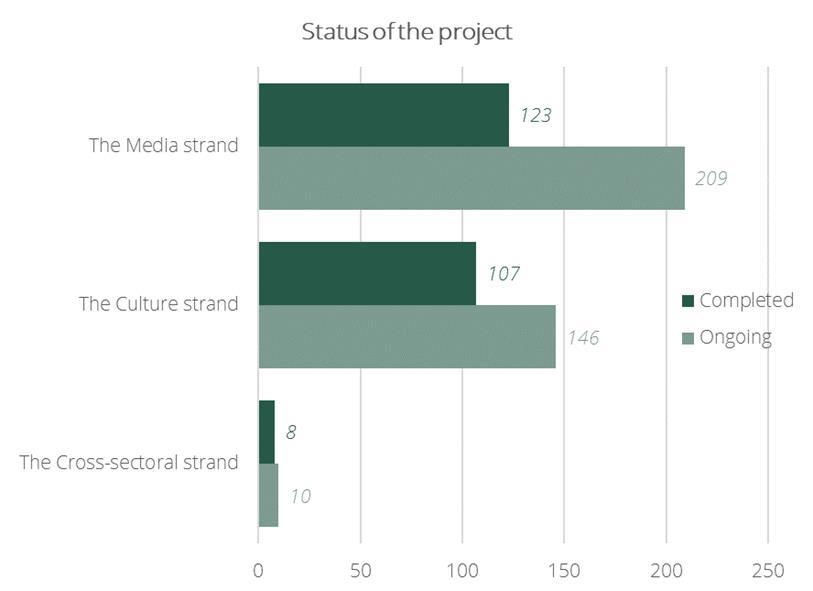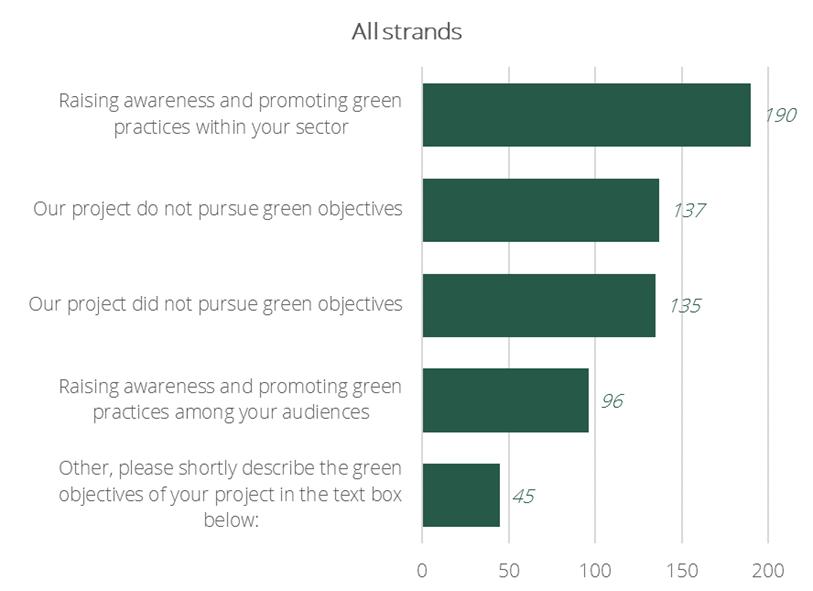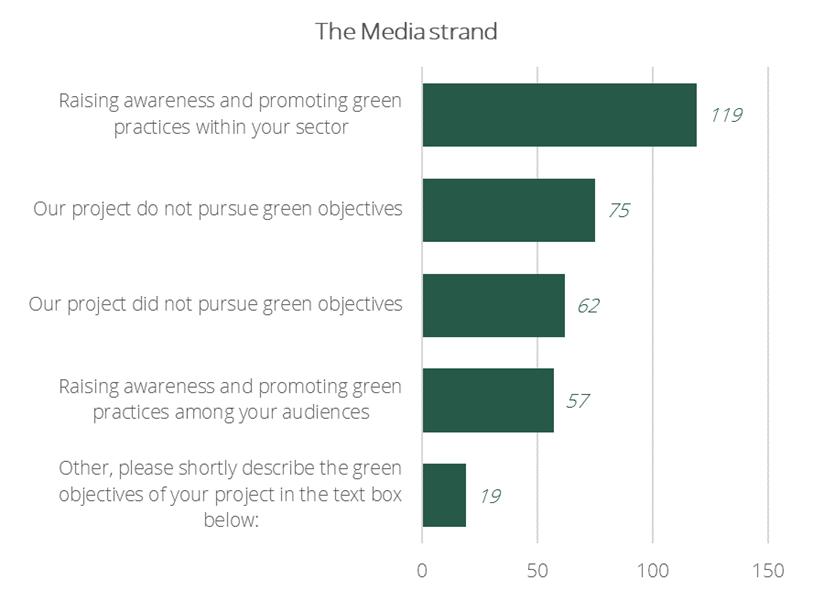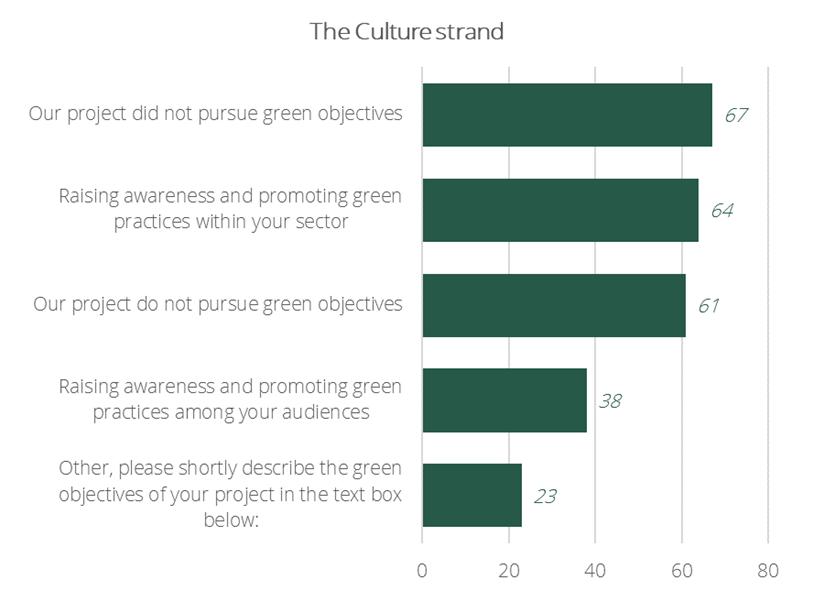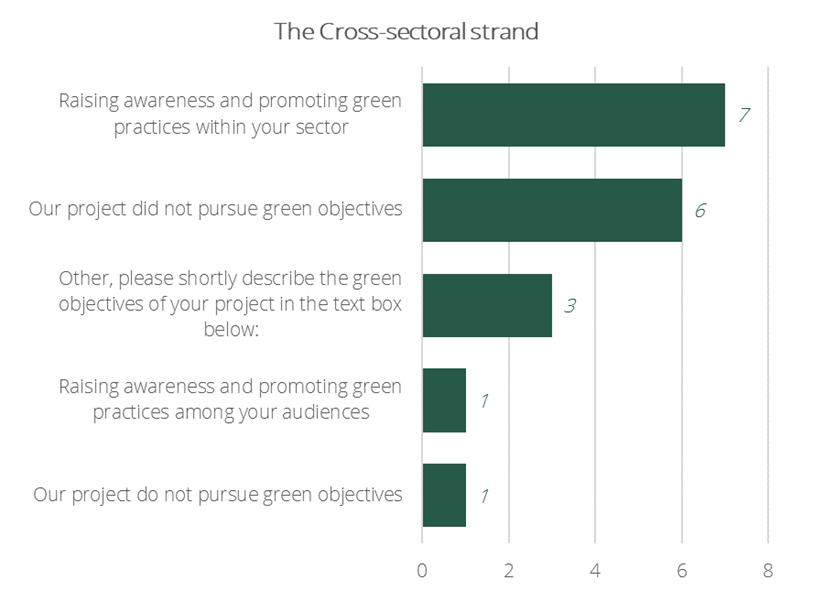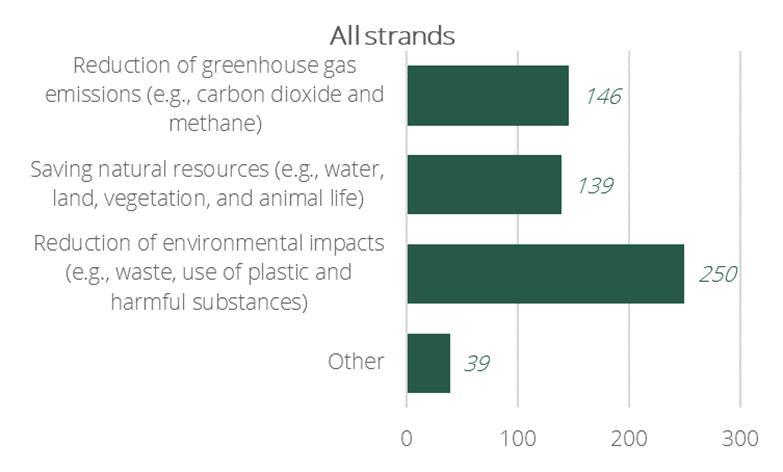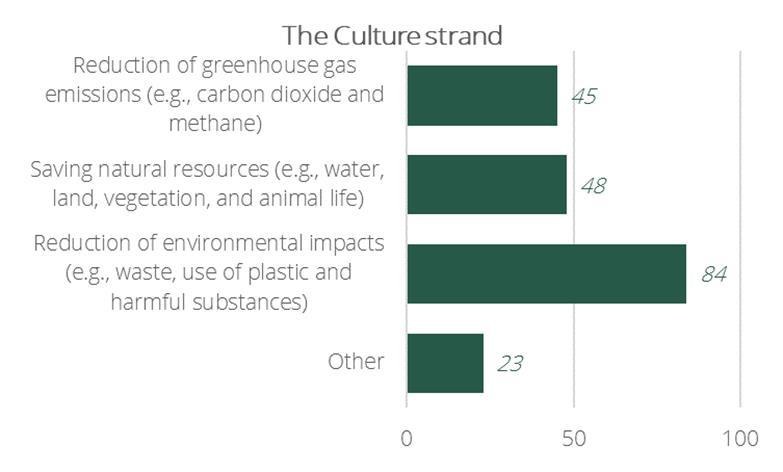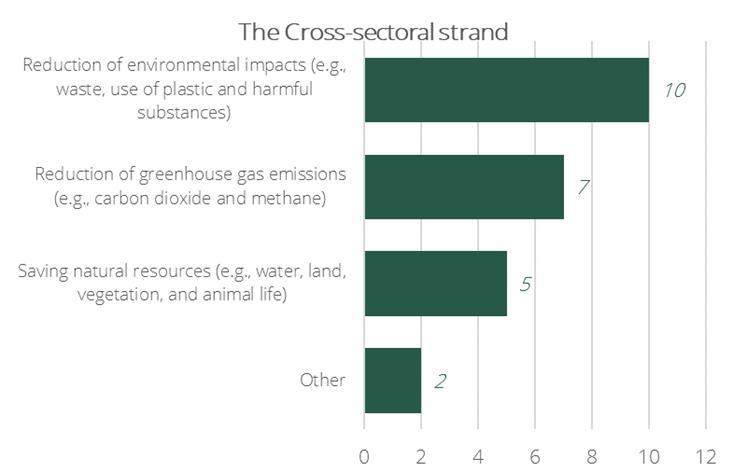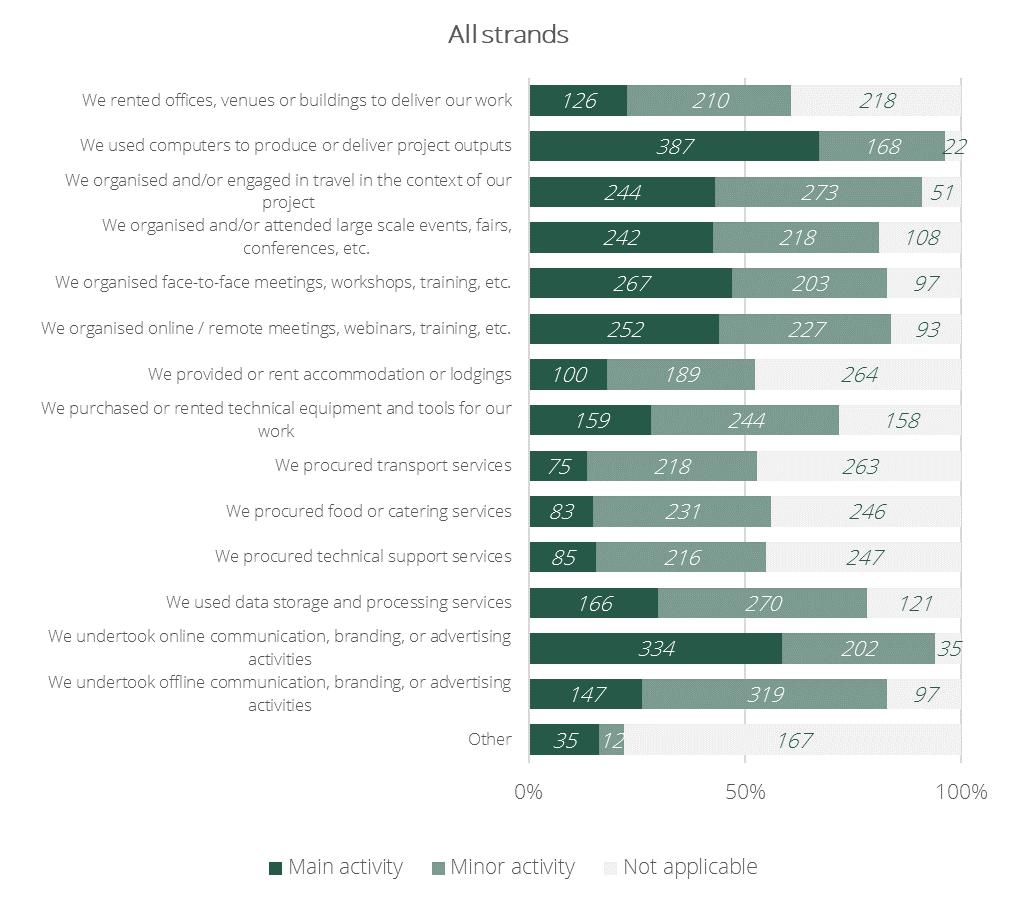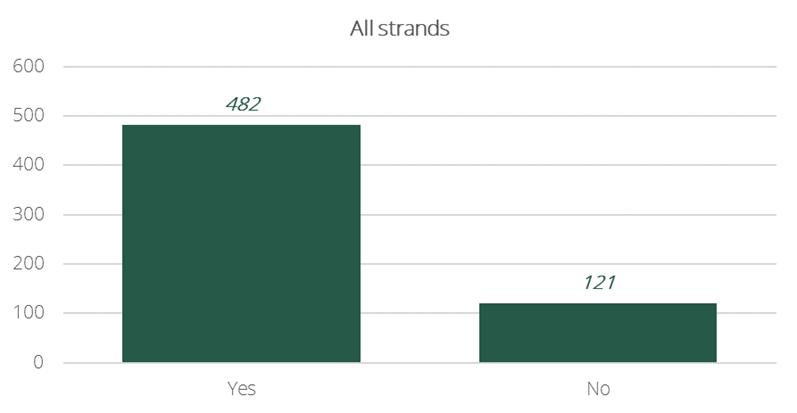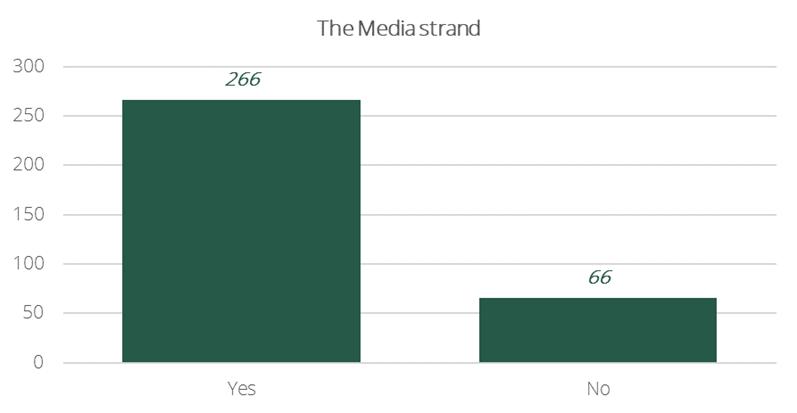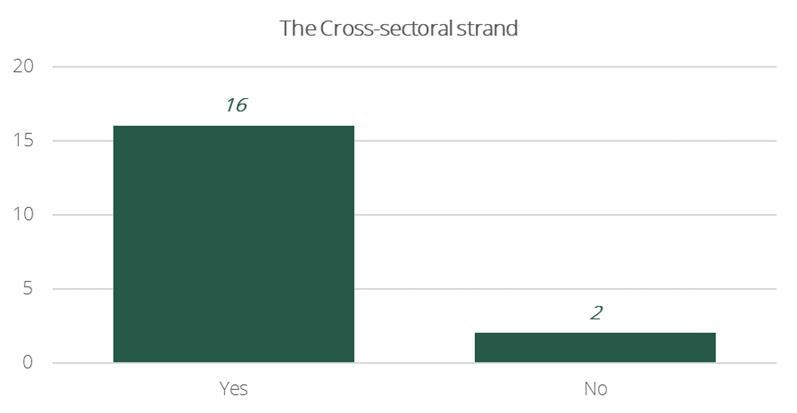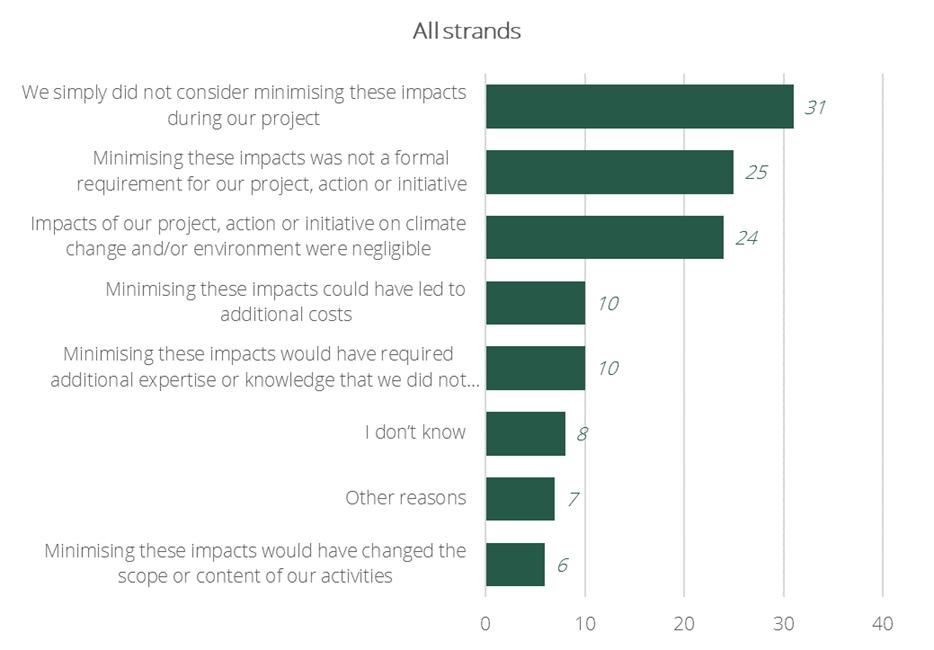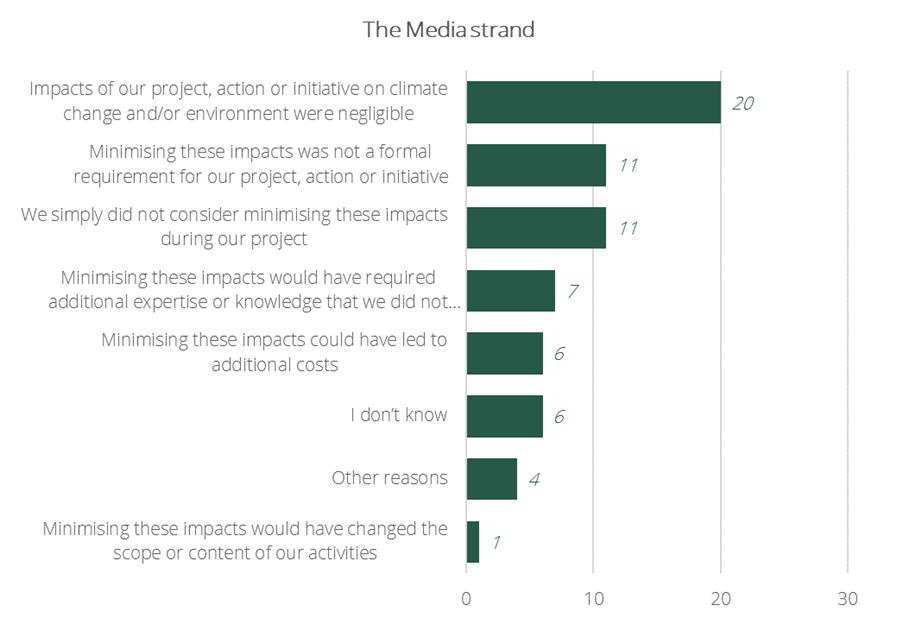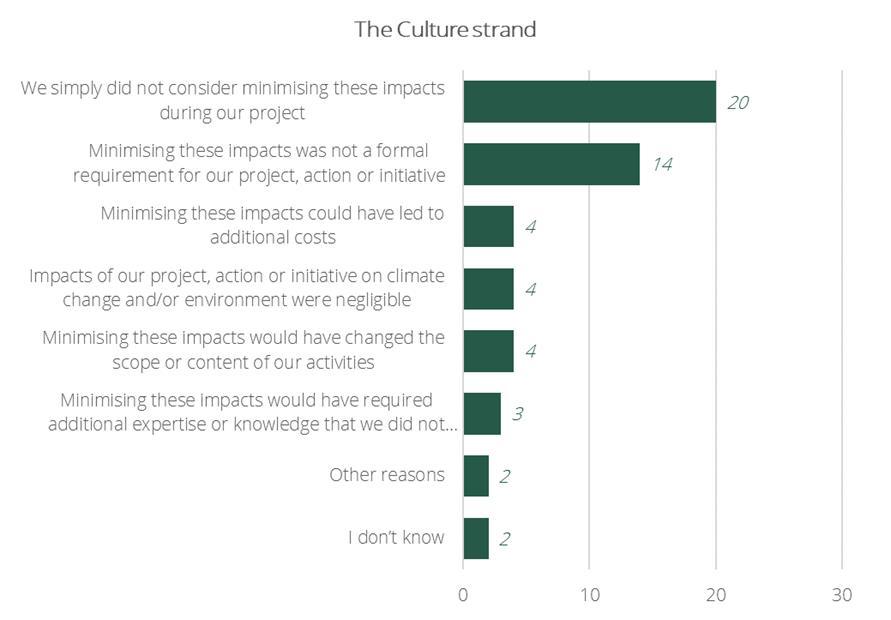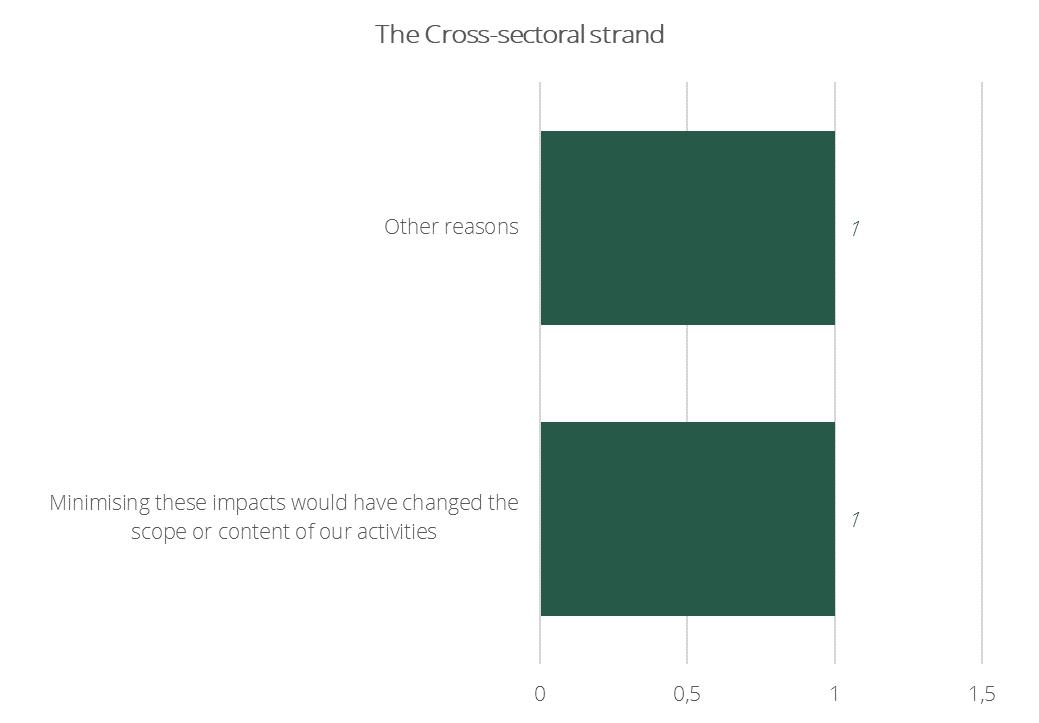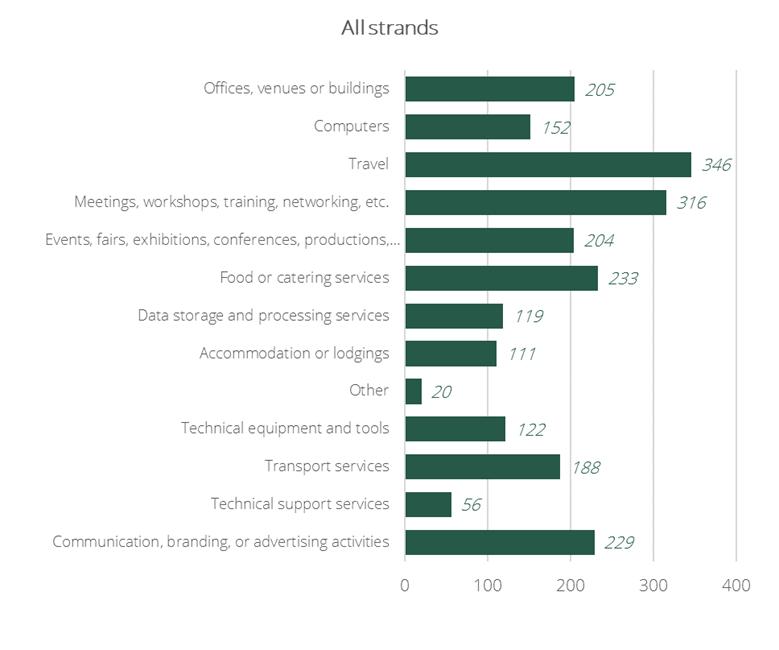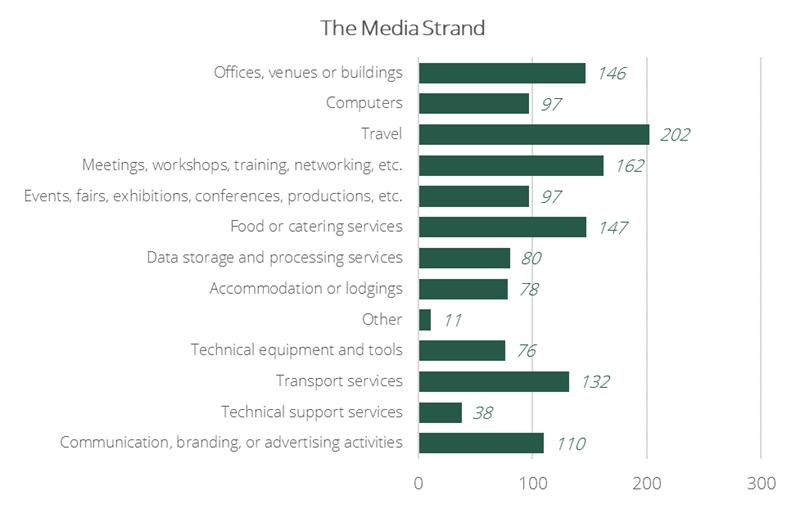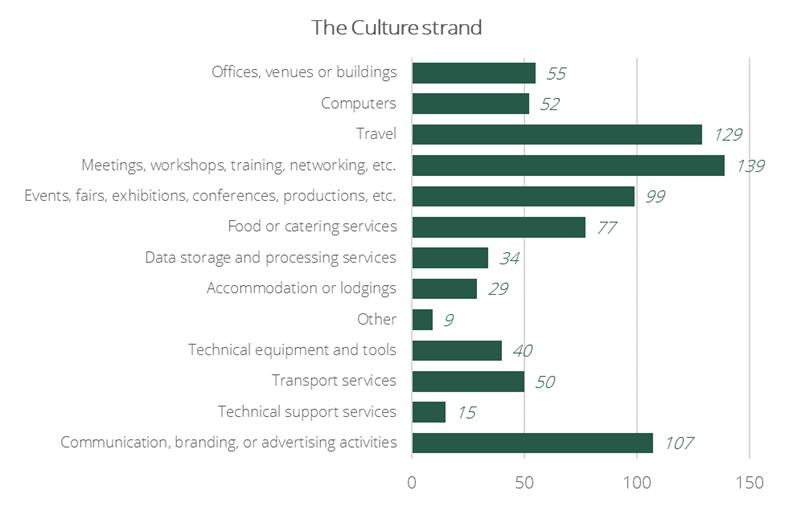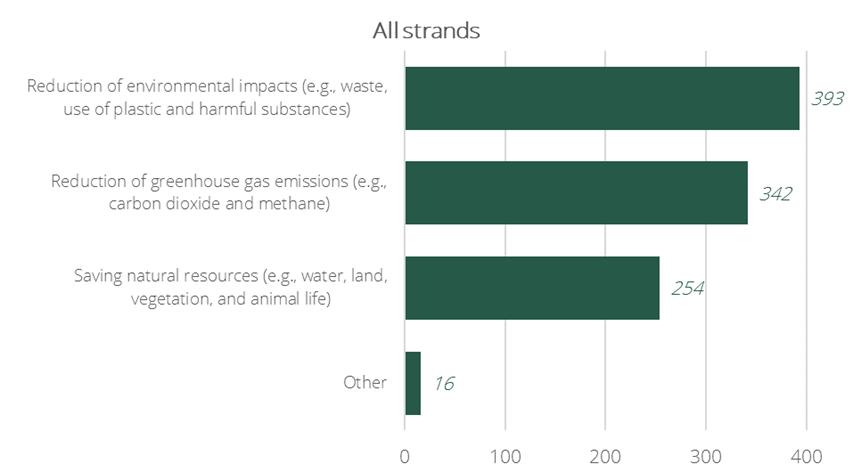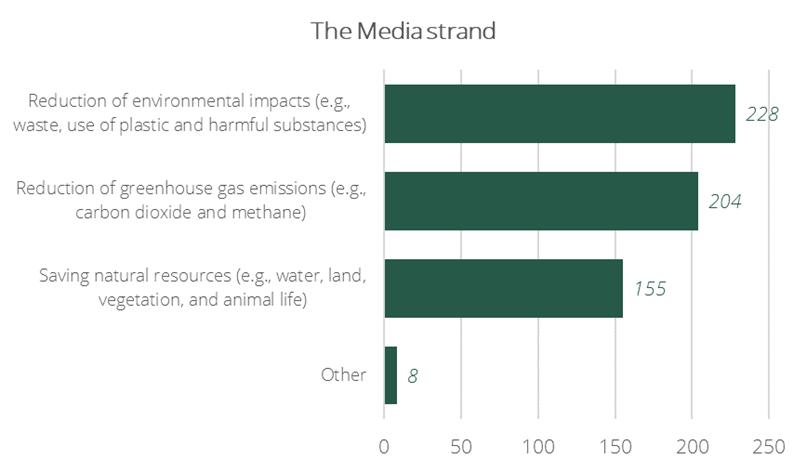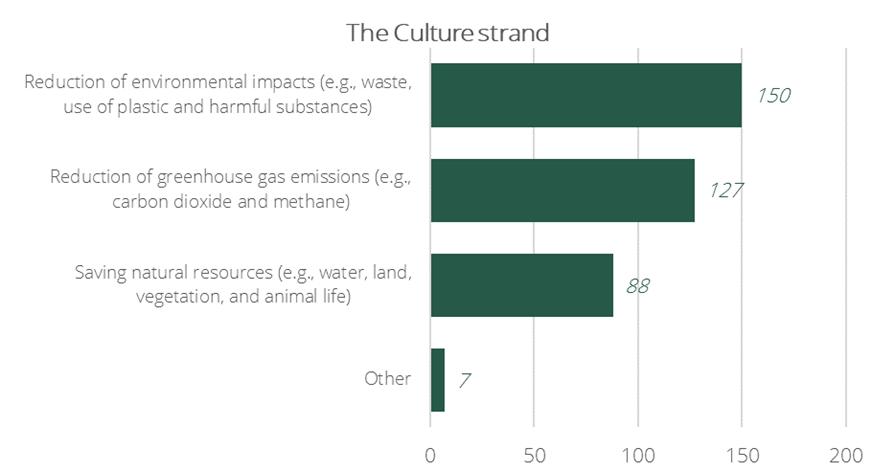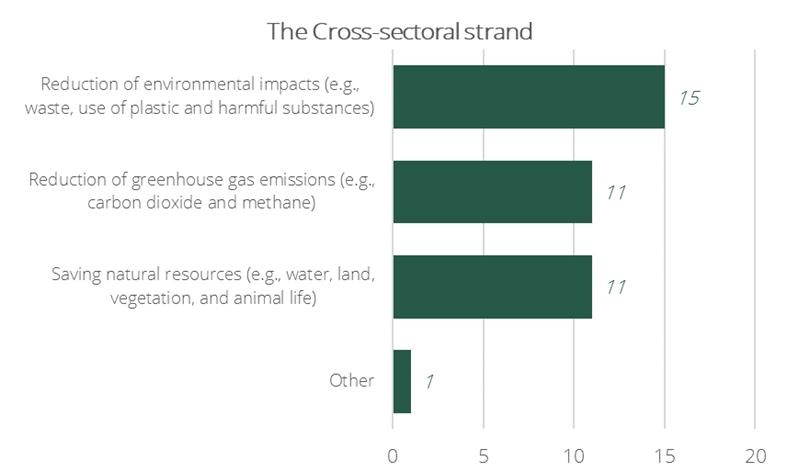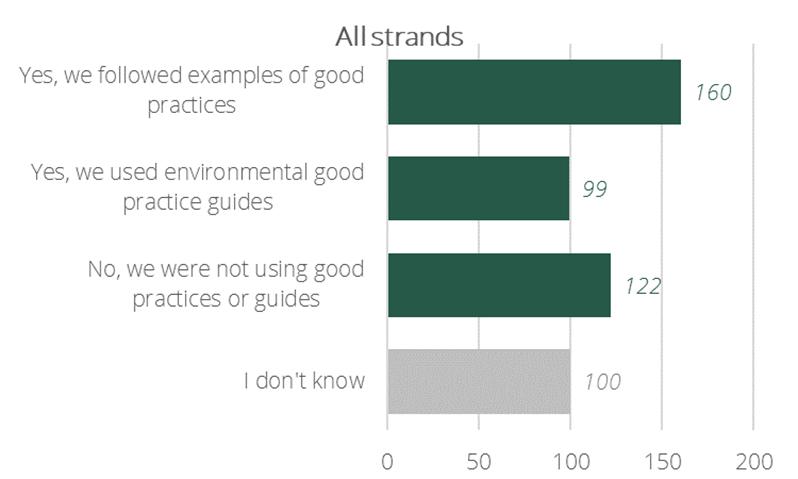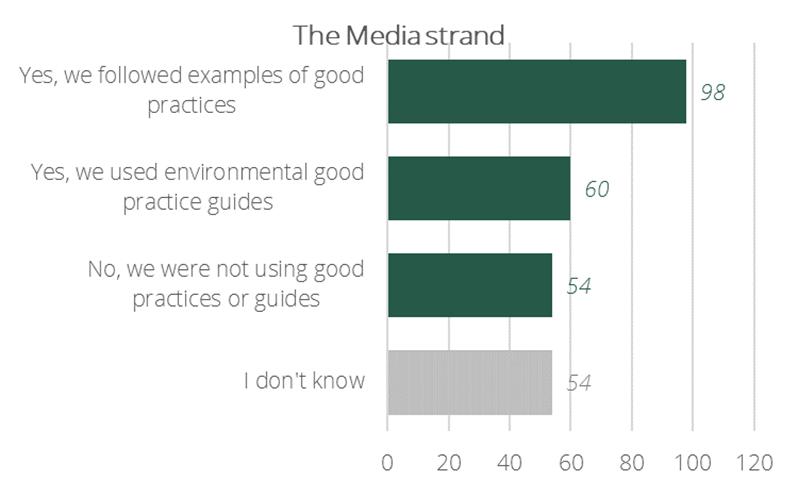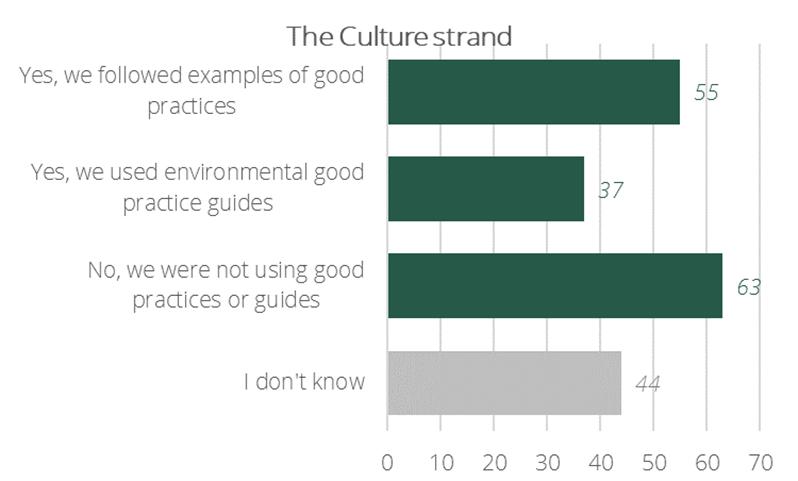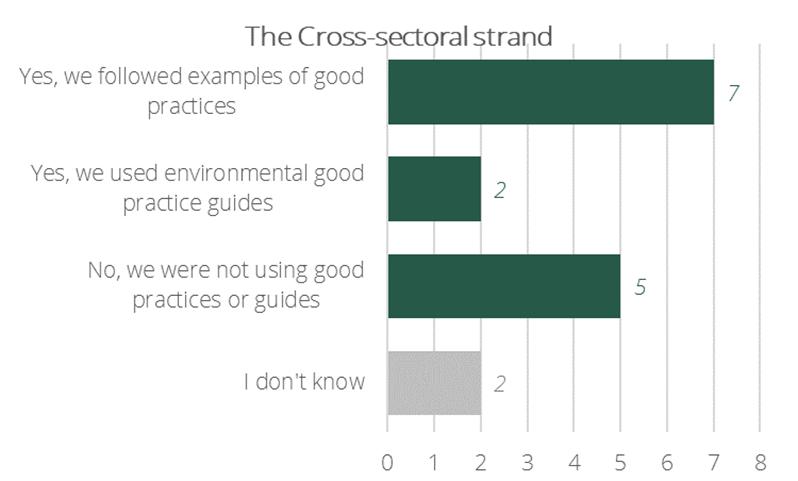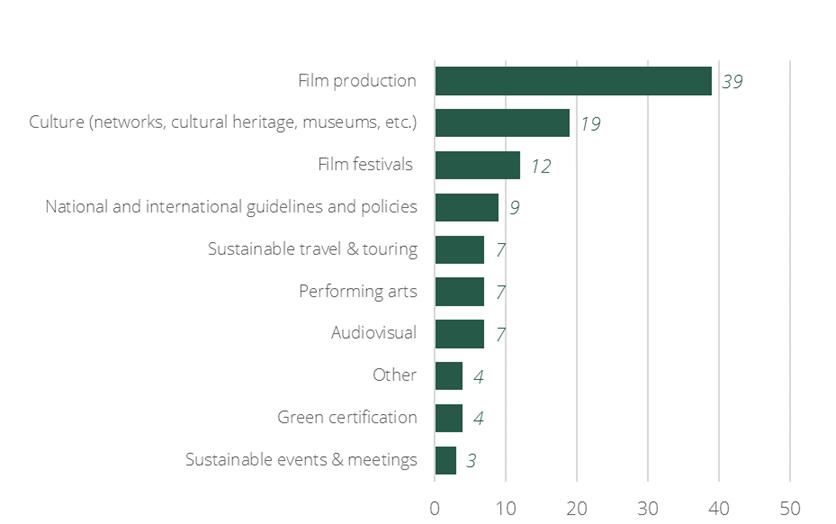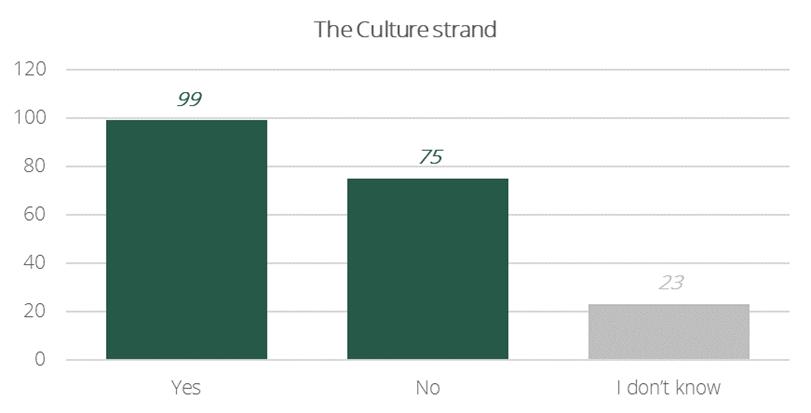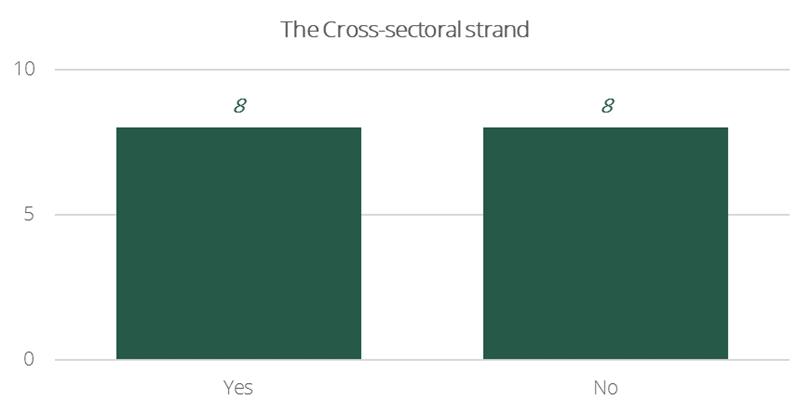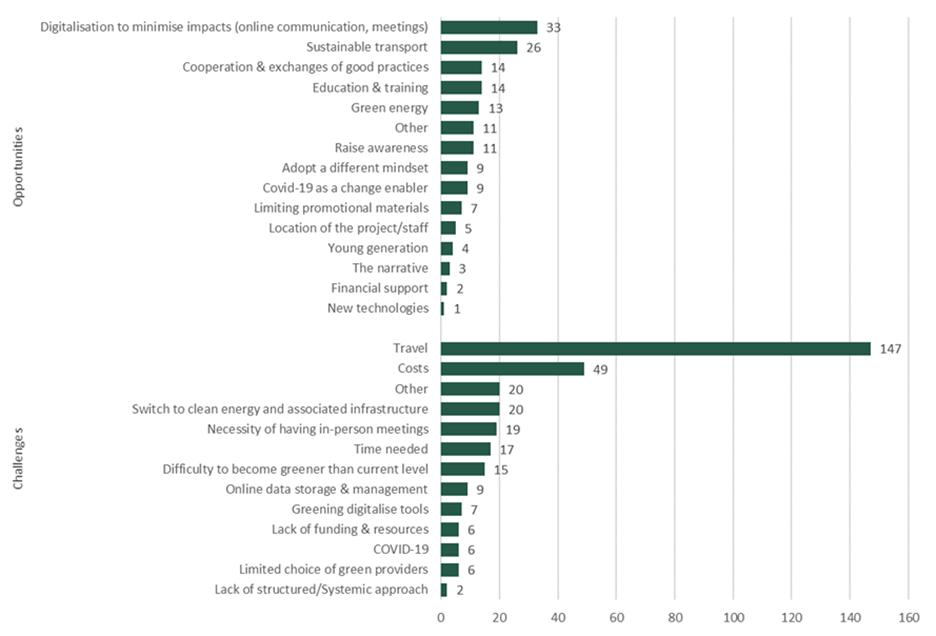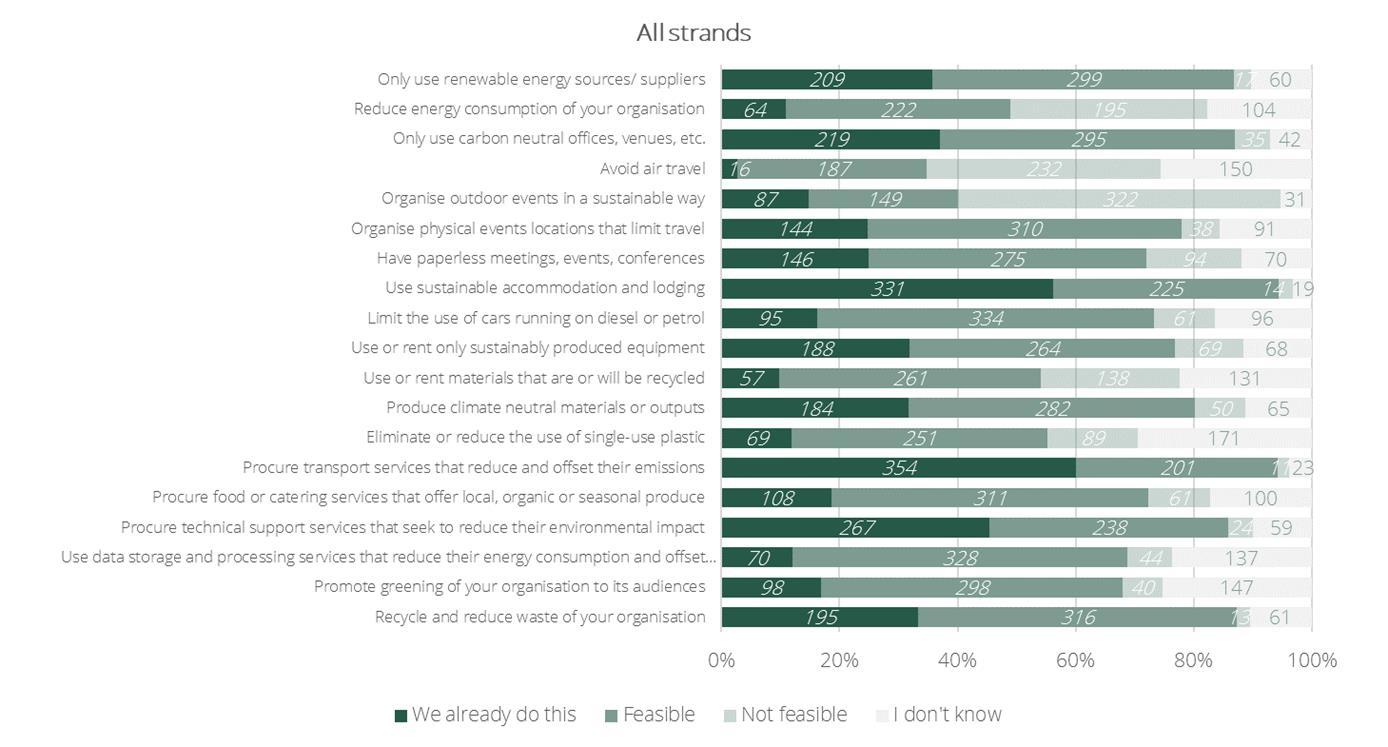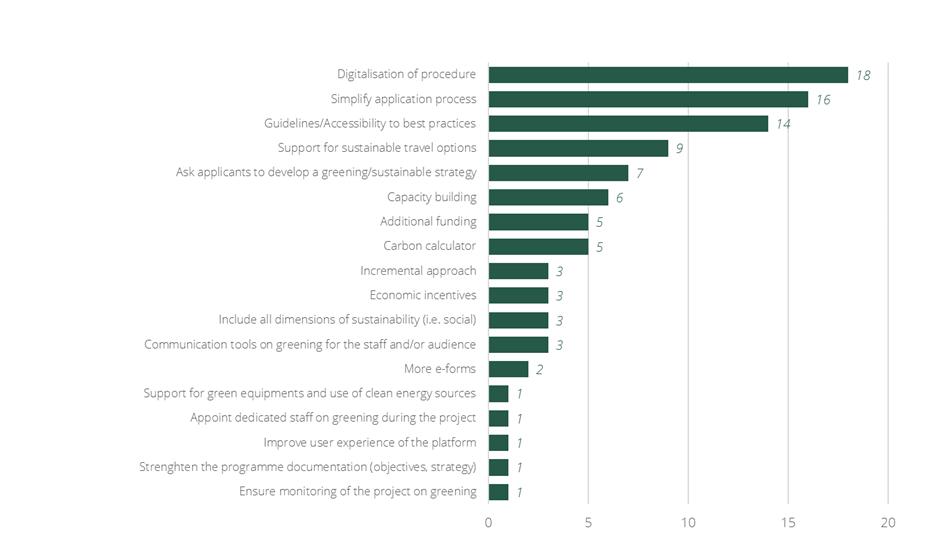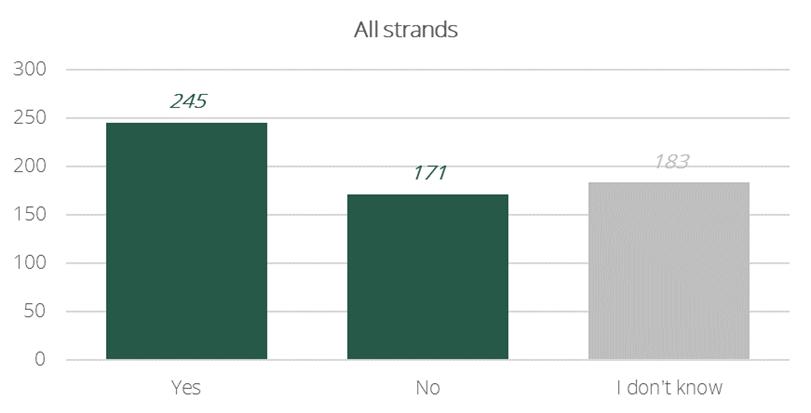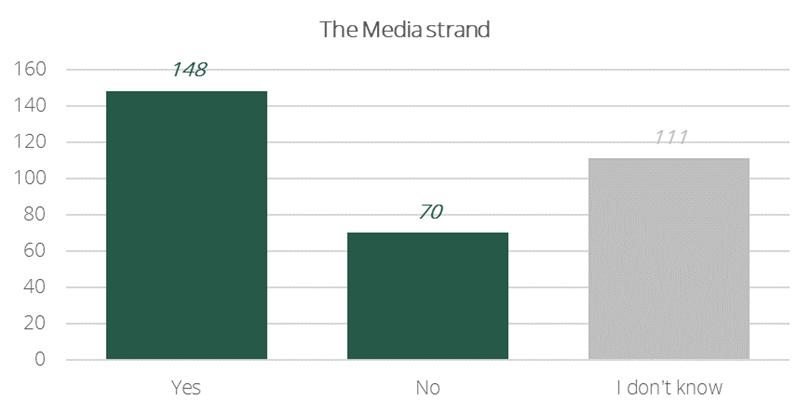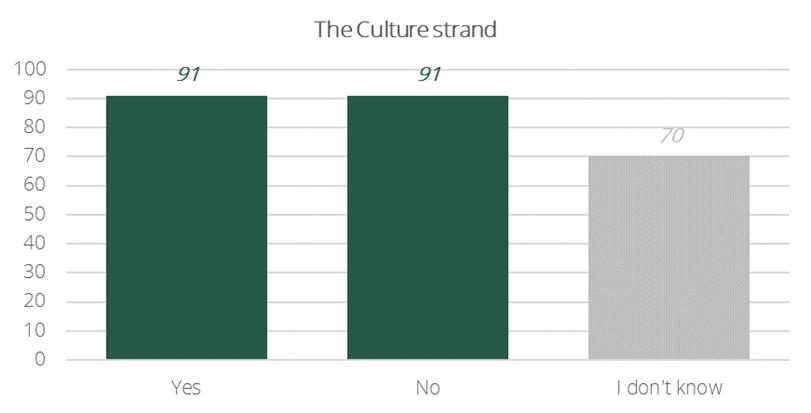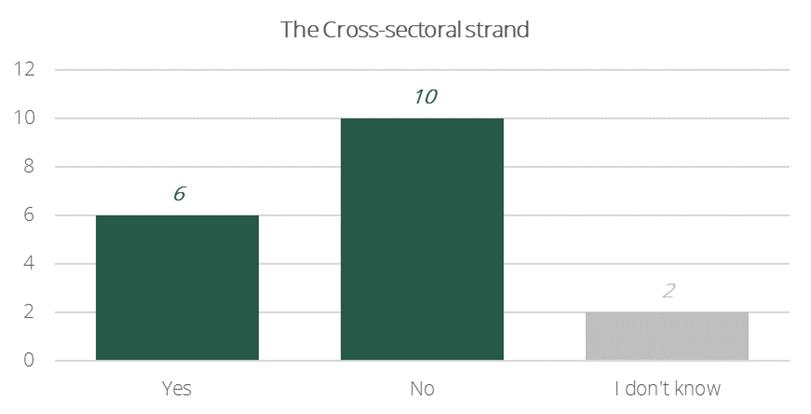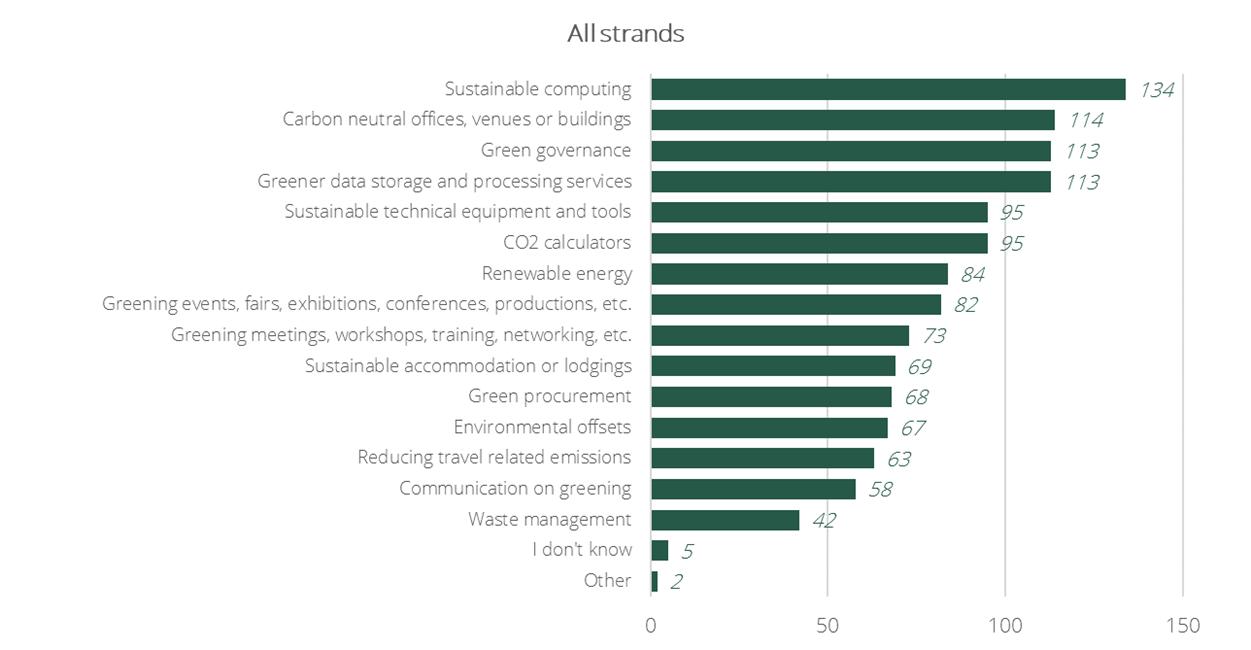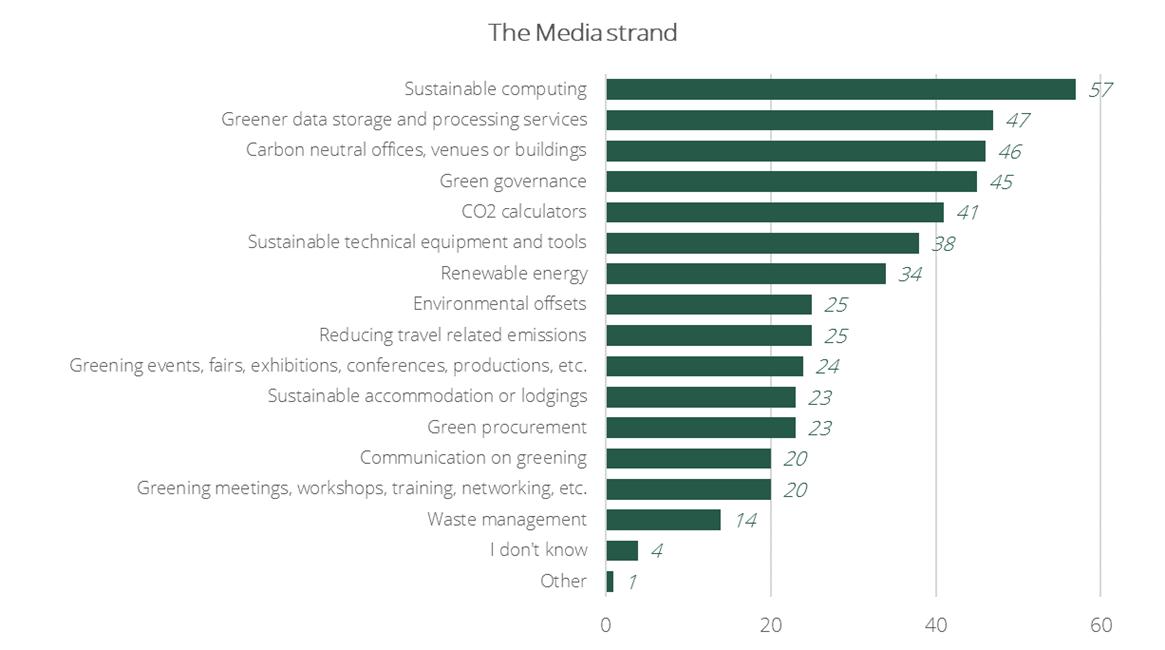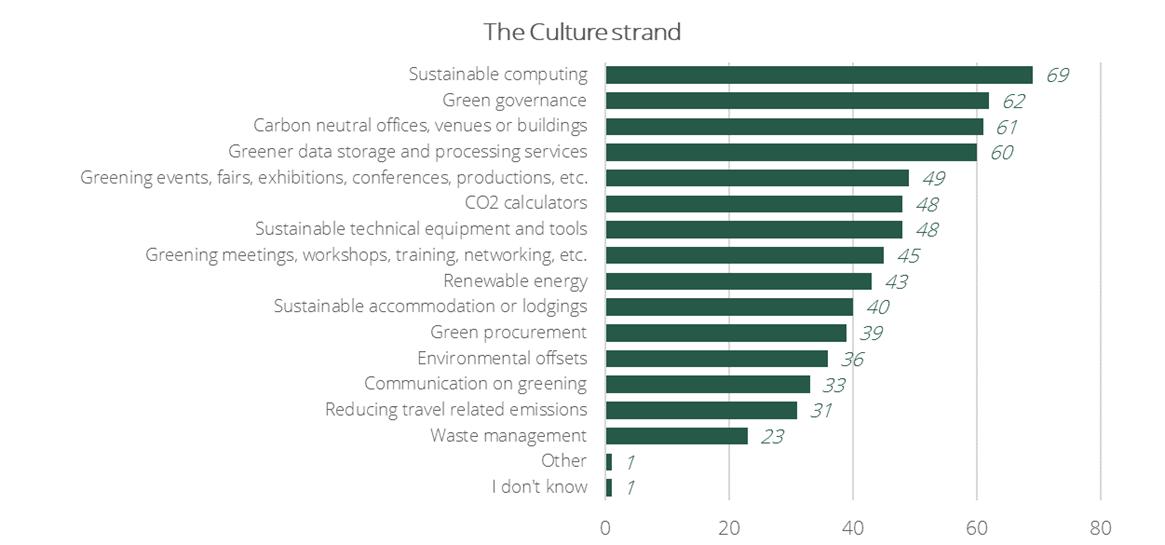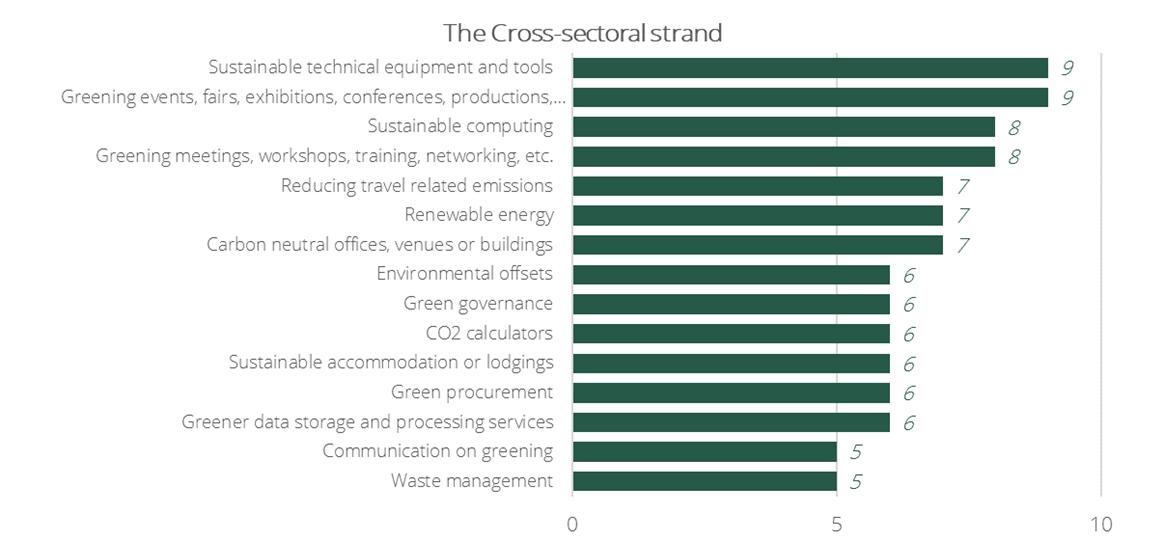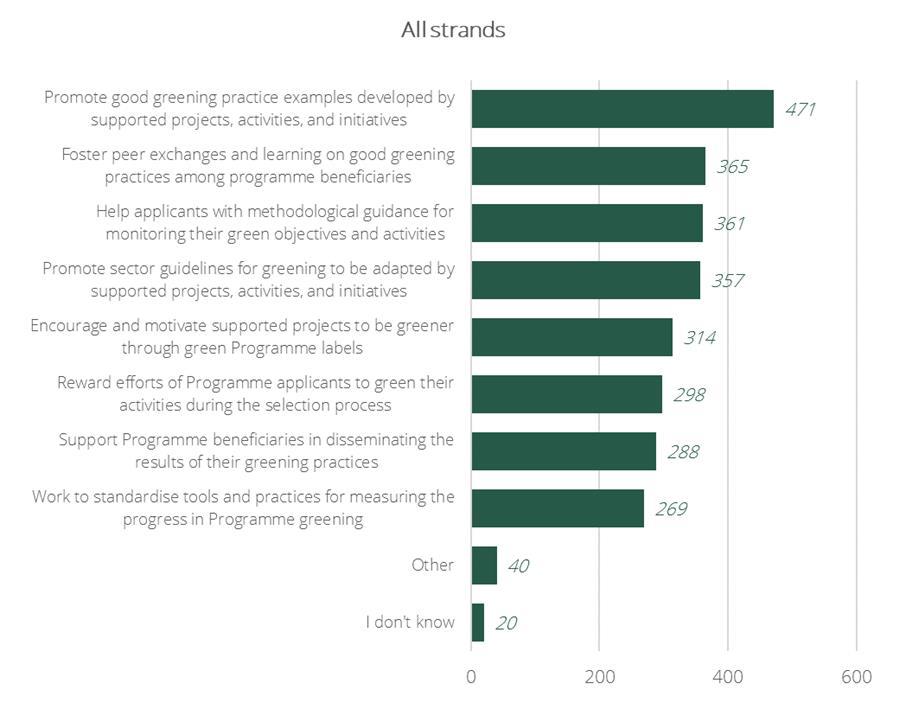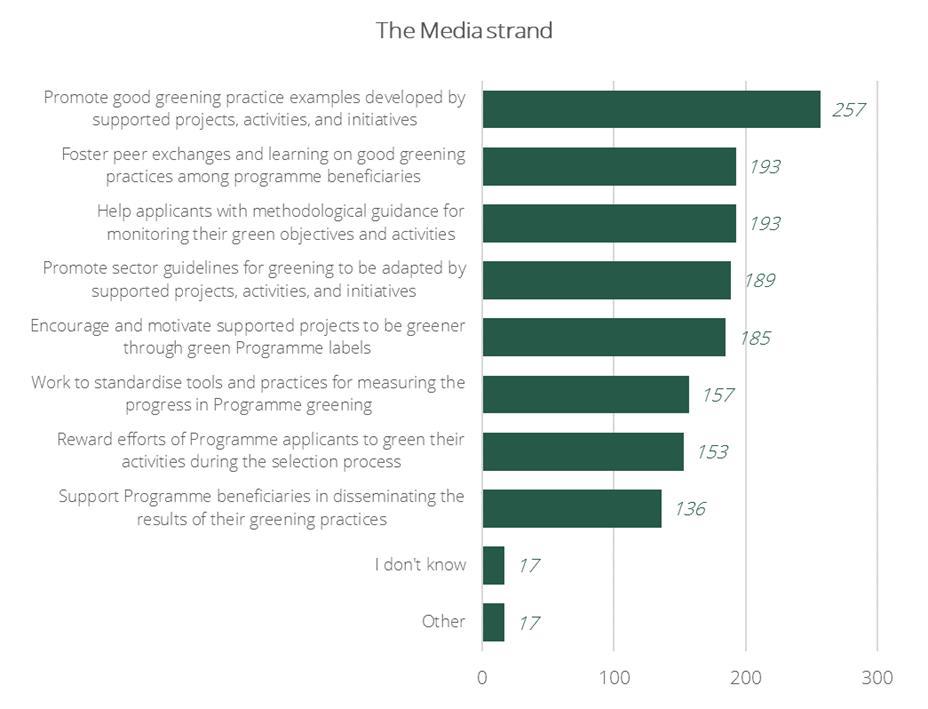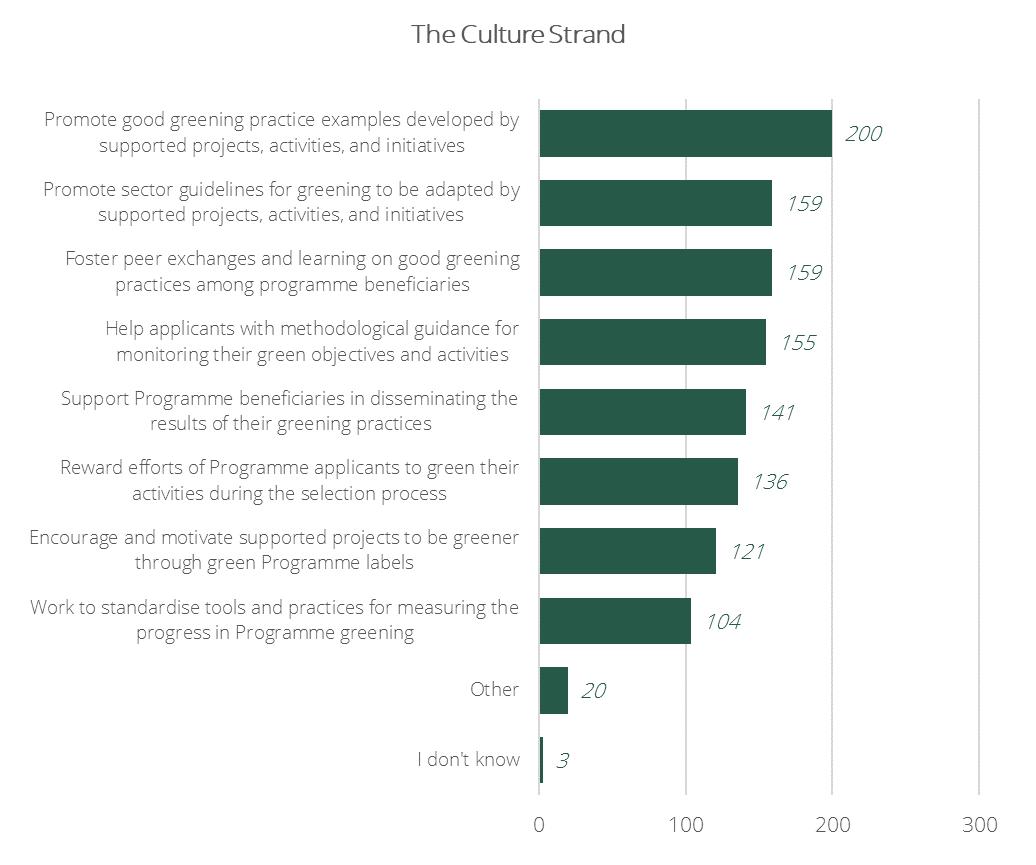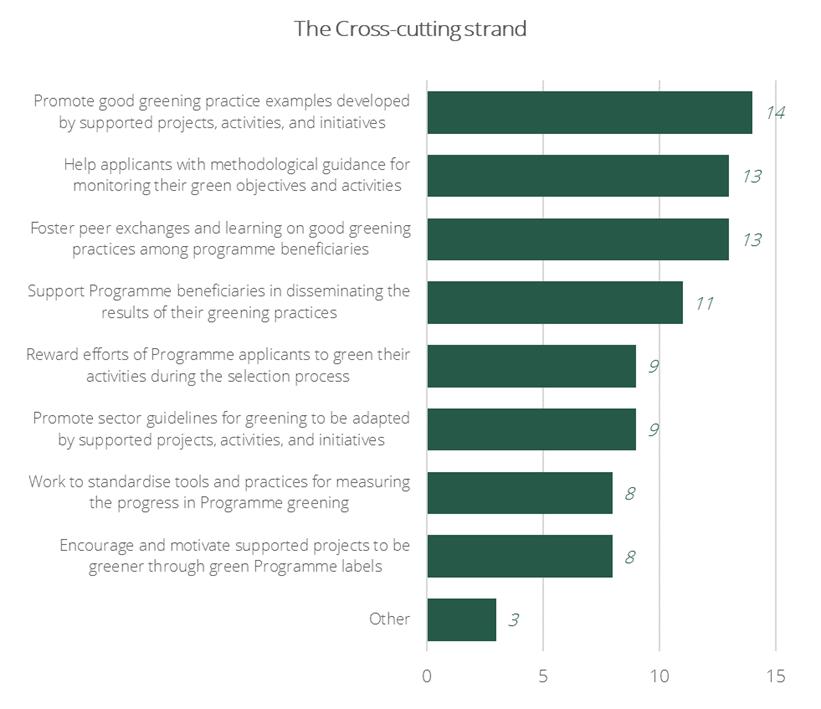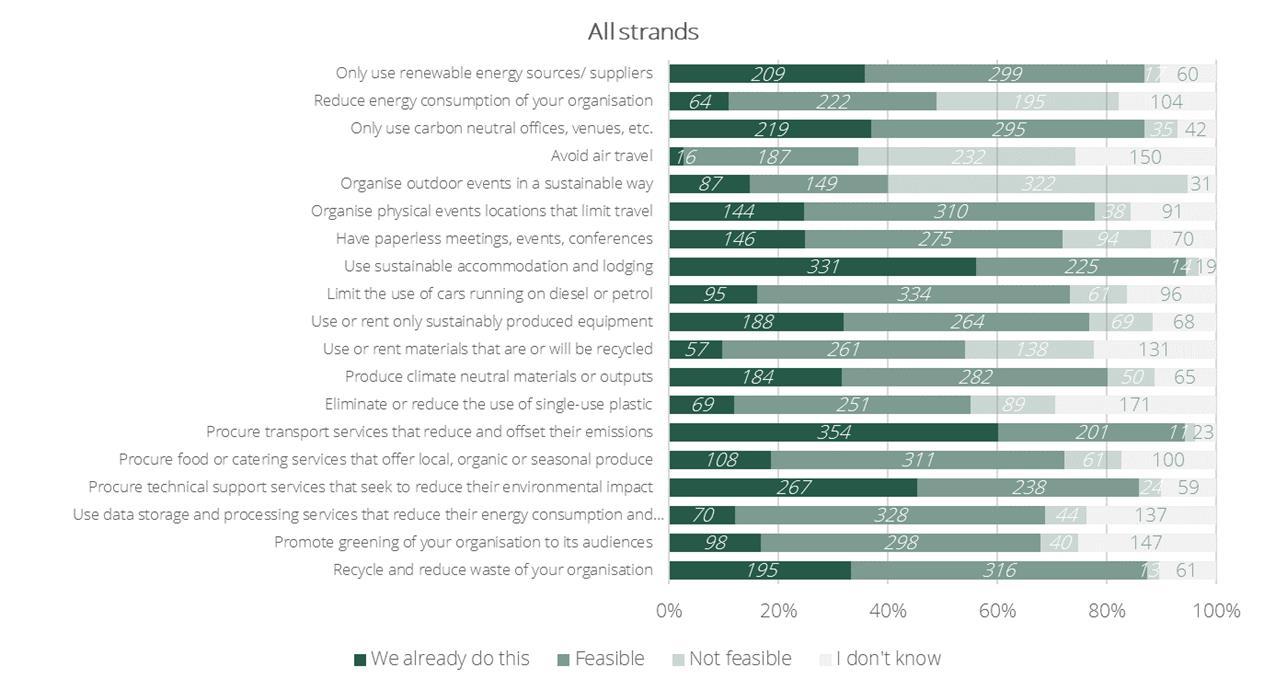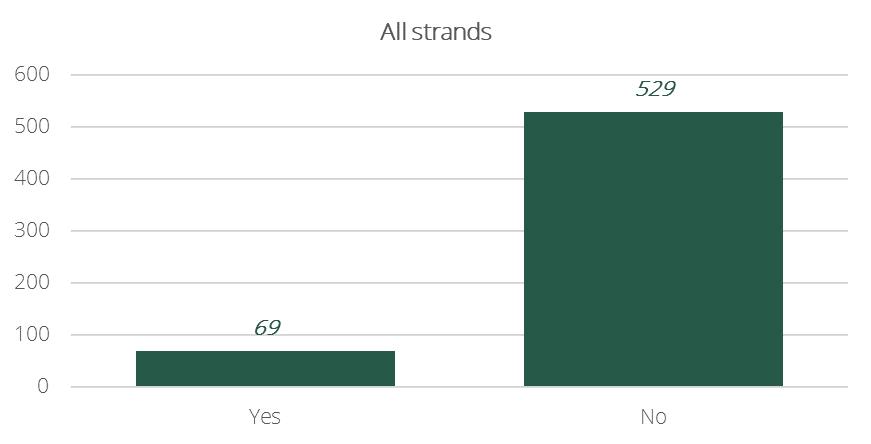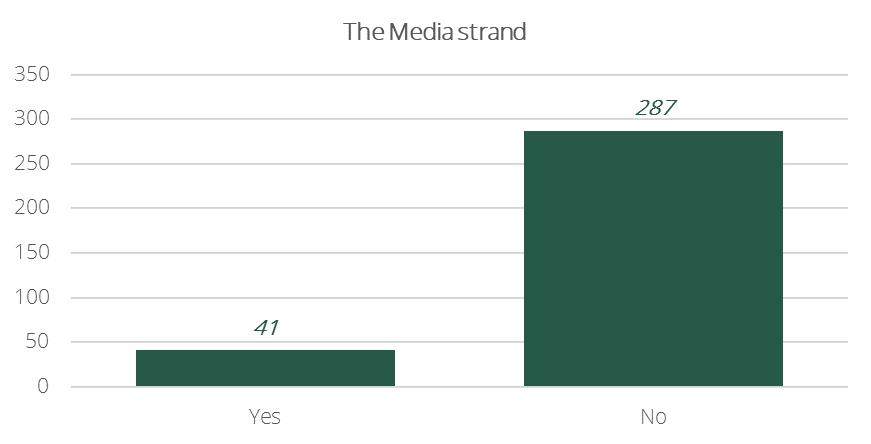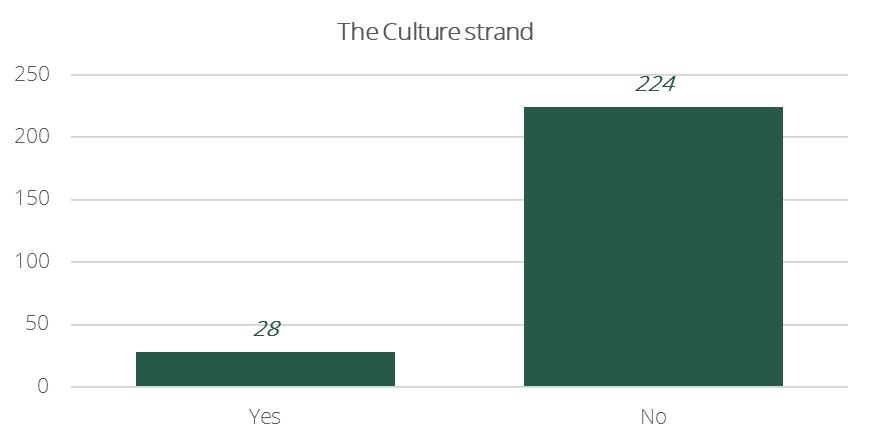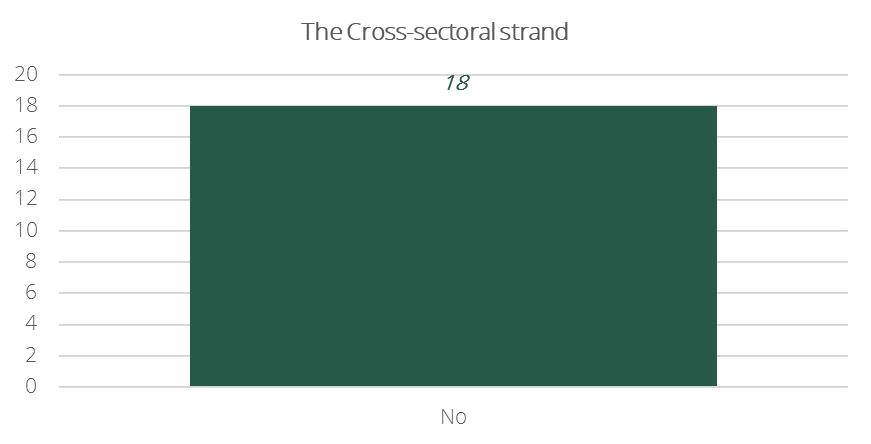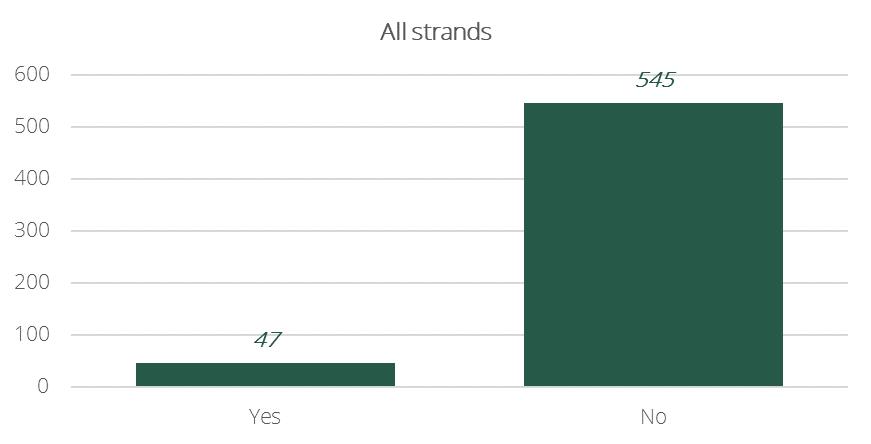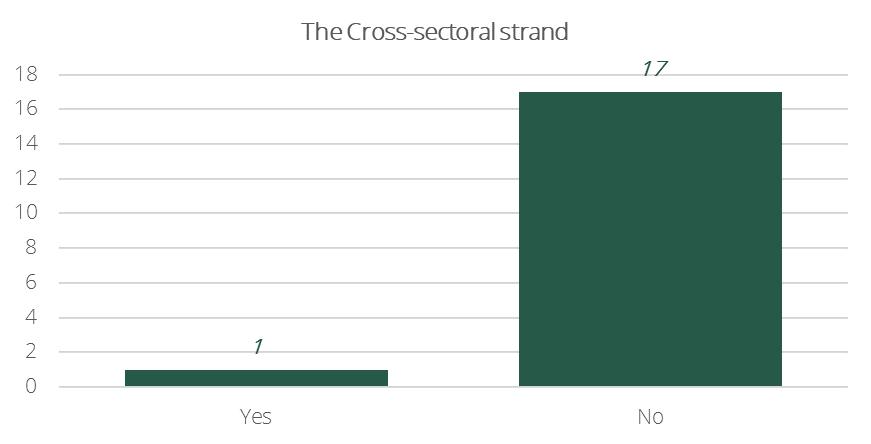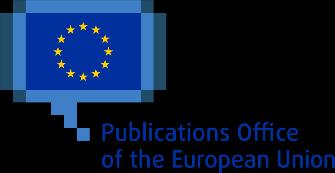
Greening the Creative Europe



EUROPEANCOMMISSION
Directorate-General for Education, Youth, Sport and Culture
Directorate D – Culture, Creativity and Sport Unit D2 – Creative Europe
E-mail: EAC-CREATIVE-EUROPE-GREENING-STUDY@ec.europa.eu
European Commission B-1049 Brussels
Edited by: Toms Feifs, Thomas Kruger, Adriana Rodriguez, Bert-Jan Buiskool, Veronika Muller and Alexandre Mohamedaly
GettingintouchwiththeEU
Europe Direct is a service that answers your questions about the European Union. You can contact this service:
• by freephone: 00 800 6 7 8 9 10 11 (certain operators may charge for these calls),
• at the following standard number: +32 22999696 or
• by email via:https://europa.eu/european-union/contact_en
Luxembourg: Publications Office of the European Union, 2023
© European Union, 2023
Reuse is authorised provided the source is acknowledged. The reuse policy of European Commission documents is regulated by Decision 2011/833/EU (OJ L 330, 14.12.2011, p. 39).
For any use or reproduction of photos or other material that is not under the EU copyright, permission must be sought directly from the copyright holders.
Image(s) © Triff, 2022. Source: shutterstock_177804692
Table of figures
Figure 1: Main research tasks, steps and deliverables ...............................................21
Figure 2: Development in share of programme budget awarded to green projects, by subprogramme/strand under the predecessor Creative Europe Programme 27
Figure 3: Number of ‘green’ projects per sub-programme and grant scheme supported by the predecessor Creative Europe Programme 28
Figure 4: Share of ‘green’ projects by type of general and specific green objectives addressed under the predecessor Creative Europe Programme 29
Figure 5: Number of respondents representing projects supported by the predecessor programme who indicated that they ‘greened’ the following project activities (multiple answers possible).................................................................................................33
Figure 6: Reasons provided by respondents representing projects supported by the predecessor programme for not minimising the impact of their project’s actions or initiatives on climate change and environment (multiple answers possible)..................34
Figure 7: Which aspects does your organisation need to learn more about to be able to green your projects, actions, or initiatives?..............................................................63
Figure 8: Share of beneficiaries reporting that they already monitor certain activities or environmental impacts 91
Figure 9: Coverage of different activities across five Media sector-specific CO2 calculators 92
Figure 10: Strength and weaknesses of as well as opportunities and threats for the greening of Creative Europe 105
Figure 11: Incremental stages towards a green Creative Europe Programme .............108
Figure 12: Waste Hierarchy 138
Figure 13: Recycling processes.............................................................................140
Tables
Table 1: Overview of number of ‘green’ projects and funding awarded to them, by subprogramme/strand under the predecessor Creative Europe Programme.......................25
Table 2: List of ‘greening’ initiatives carried out by consulted Creative Europe Desks ....50
Table 3: Opportunities for Creative Europe Programme to contribute to greening of CCS 55
Table 4: Overview of the current levels of greening for the grant schemes, actions and initiatives currently supported by the Creative Europe Programme 64
Table 5: A list of good practice examples and greening guidelines by sub-sector covered by the Creative Europe Programme 73
Table 6: Examples of mutual learning activities delivered by the projects supported by the Creative Europe Programme 81
Table 7: Single Market Programme – Sustainability indicators and measurement areas.88
Table 8: Horizon Europe programme - Sustainability indicators and measurement areas 89
Greening the Creative Europe Programme
Table 9: Recommended actions to establish environmental governance in organisations benefiting from Creative Europe Programme support or for projects supported by the Programme 124
Table 10: Examples of exchanges and mutual learning activities on sustainability within CCS..................................................................................................................145
Table 11: A list of available carbon calculators by sector identified during the Study on Greening Creative Europe....................................................................................148
Table 12: Stakeholder interviews 224
Table 13: Targeted consultations..........................................................................227
List of acronyms
CCS Cultural and creative sectors
CO2 Carbon dioxide
COSME EU programme for the Competitiveness of Enterprises and Small and Medium-sized Enterprises
CEP Expert Creative Europe programme Expert
DG
CNECT Directorate-General for Communications Networks, Content and Technology
DG EAC Directorate-General for Education, Youth, Sport and Culture
EACEA European Education and Culture Executive Agency
ECoC European Capital of Culture
GHG Greenhouse gas (emissions)
KhW Kilowatt-hour
MAAP Media and Audiovisual Action Plan
MEF Monitoring and Evaluation Framework
MME Music Moves Europe
OMC Open Method of Coordination
RQ Research question
SME Small- and medium sized enterprise
SMP Single Market Programme
WP (Annual) Work Programme
List of definitions
‘Greening’ in the context of this study refers to 1) supported projects voluntarily pursuing green objectives of promoting sustainability and fight against climate change either as their primary focus or alongside other objectives such as cultural or artistic creation, innovation, social inclusion etc. and 2) projects supported by the Creative Europe Programme making decisions and implementing corresponding activities to reduce their environmental impact, including the impact of the supported project activities on climate change.
‘External greening’ in the context of this study refers to supported projects pursuing green objectives of promoting sustainability and fight against climate change either as their primary focus or alongside other objectives such as cultural or artistic creation, innovation, social inclusion etc.
‘Internal greening’ in the context of this study refers to projects supported by the Creative Europe Programme making decisions and implementing corresponding management and project activities1 to reduce their environmental impact, including the impact of the supported project activities on climate change.
‘Green project’ in the context of this study is used to denote a project supported by Creative Europe that pursues or pursued ‘green objectives’ of promoting sustainability and fighting against climate change either as their primary objective or alongside other objectives.
‘Green requirements’ in the context of this study refers to requirements included in calls for proposals that applicants need to address at application stage or during project implementation, monitoring and reporting stages to progressively align supported projects with the European Green Deal objectives.
‘Green mobility’ in the context of this study is used to refer to modes of transport that seek to reduce their environmental impact and impact on climate change. Mobility can be considered green or greener when walking or using transportation modes including bicycles, electric bicycles or scooters2, public transport3, electric cars4, hydrogen cars5 , carpooling or car-sharing of low-emissions cars, etc.
‘Sustainability’ in the context of this study refers to the sectors seeking to adopt more environmentally sustainable practices and, by this, to minimise their environmental and climate change impacts to meet the European Green Deal objectives and international commitments on tackling climate change6 as well as concerns and needs of their audiences, seeking to prevent the depletion of natural or physical resources, and moving towards carbon neutral operations in the future.
1 Activities include establishing effective green governance structures, reducing and minimising travel and transportation, reduce energy usage and use renewable sources, recycle and reuse materials etc.
2 It is also important how the electricity that is used to power electric bicycles or scooters is produced. The share of green energy achieved will depend on the Member State.
3 including buses, trains, tams, trolleybuses, etc.
4 The efficiency of electric cars differs considerably. It is also important how the electricity that is used to power electric cars is produced. The share of green energy achieved will depend on the Member State.
5 The way hydrogen is produced is important. ‘Green hydrogen’ produced through electrolysis (splitting water into hydrogen and oxygen) using renewable energy is currently the only sustainable hydrogen option.
6 Pursuing the Union’s commitments to implement the Paris Agreement adopted under the United Nations Framework Convention on Climate Change and the UN Sustainable Development Goals.
Abstract
The European Green Deal aims to make the EU climate neutral by 2050, boost economy through green technology, create sustainable industry and transport, and cut pollution.7
The cultural and creative sectors (CCS) must not be left behind in the green transition
The Directorate General for Education, Youth, Sport and Culture (DG EAC) in partnership with Directorate General for Communications Networks, Content and Technology (DG CNECT) commissioned a study to inform and support the Commission’s effort to mainstream environmental protection, sustainability and fighting climate change objectives and actions into the Creative Europe Programme by:
▪ Researching what guidance should be provided to Programme applicants and beneficiaries,
▪ Developing recommendations for monitoring and evaluating green aspects of project proposals,
▪ Collecting good practices that support raising awareness on the need for a green transition in and supported by CCS,
▪ Documenting progress made under the predecessor Creative Europe Programme (2014-2020) in terms of projects supported that pursued sustainability objectives, produced green practices, ideas and tools).
7
Executive Summary
Aims, objectives and scope of the Study
This Final Report has been prepared by Ecorys in the context of the Request for Services titled: ‘Greening the Creative Europe Programme’ (EC/04/2021), commissioned by the Directorate General for Education, Youth, Sport and Culture (DG EAC) of the European Commission (the Commission) and produced in partnership with Directorate General for Communications Networks, Content and Technology (DG CNECT).
The study is a part of the Commission’s effort to mainstream climate actions into the Creative Europe programme without changing the fundamental character and objectives of the Programme. The study is also part of a response of the Commission to the Resolution of the European Parliament that calls for effective measures to ‘green’ Erasmus+, Creative Europe and the European Solidarity Corps.8
The aims of the assignment were to:
1. Research what guidance should be provided to Programme applicants and beneficiaries in the design and management of their cross-border projects to limit their impact on the environment and integrate green practices;
2. Develop recommendations for monitoring and evaluating green aspects of project proposals (alongside other project objectives of artistic creation, cultural or creative expression);
3. Collect good practices that support raising awareness on the need for a green transition (as supported by the Programme, the sectors covered by it and beyond); and,
4. document progress made during the previous and current Creative Europe Programme towards programme greening (by mapping the main green initiatives and projects supported, as well as green practices, their results and impacts).
More specifically, the study also aimed to:
▪ explore the potential of the Programme to encourage European citizens to act sustainably and promote initiatives to raise awareness, educate and promote environmental practices;
▪ deliver a mapping of projects with ‘green’ objectives and research greening practices implemented by projects, actions and other initiatives supported by the predecessor Creative Europe Programme;
▪ develop a problem statement, outlining the impact of the Cultural and Creative sectors (CCS) on climate change and environment, a sector specific greening strategy, and a good environmental practice guide for greening the Programme;
▪ propose environmental, climate and sustainability indicators, as well as targets, benchmarks and baselines for the Creative Europe Programme, including for measuring its greening expenditure; and,
8 https://www.europarl.europa.eu/doceo/document/TA-9-2020-0211_EN.pdf
▪ explore the possibilities to introduce a standardised approach for collecting data on CO2 emissions and other environmental indicators for the Creative Europe Programme by strand/sector covered.
This study covered the ‘greening’ of the previous Creative Europe Programme from 2014-2020 and the first two years of the current programme (2021 and 2022), its subprogrammes/strands, schemes, actions and projects. It looked at the Creative Europe Programme’s impact on ‘greening’ of the CCS, structuring ‘greening’ support to the European cultural and creative ecosystem, and raising awareness of programme stakeholders, including potential applicants and audiences about the need for a green transition. It did not cover the ‘greening’ of Europe’s CCS or cultural and creative ecosystem more generally.
This study and its recommendations are not the opinion of the European Commission, nor are they binding for the Commission. This study aims to support the ongoing efforts of Creative Europe Programme to become more sustainable in the light of the targets set by the European Green Deal.
Overview of the method
The methodology used to gather data for this Study included:
▪ Three scoping interviews with representatives from DG EAC, DG CNECT and EACEA.
▪ A comprehensive literature review that identified, collected and reviewed programme and project-level documentation, literature on current and good greening practices in the CCS, those supported by Creative Europe as well as ‘greening’ practices beyond the Programme.
▪ A desk-based mapping of green projects that consisted of two parts: (1) mapping of all green projects; (2) in-depth analysis of a sample of 62 projects.
▪ A beneficiary survey that assessed the extent projects supported by the predecessor Creative Europe programme greened their activities (internal greening) and contributed to mainstreaming climate actions (external greening) by pursuing green objectives and promoting sustainable practices among their specialist and non-specialist audiences.
▪ Consultations with 68 stakeholders via 29 individual and 13 group interviews as well as four written contributions (46 interviews in total). In addition, 20 targeted consultations were undertaken, collecting a total of 14 written and two oral contributions.
▪ A Policy Delphi to collect the views of an Expert Panel on the study recommendations, namely the Programme greening strategy, Good environmental practice guide and Programme greening monitoring guide.
▪ Three validation workshops to validate with CCS stakeholders the three annexes presenting the recommendations of this study.
Findings and conclusions of the Study
Enhancement of Creative Europe Programme contribution to climate and biodiversity mainstreaming
Predecessor Creative Europe Programme contribution to climate and biodiversity mainstreaming
Greening requirements
The Creative Europe Programme between 2014 and 2020 did not include greening requirements in its legal basis. Consequently, there were no formal greening requirements or criteria specified in the calls for proposals launched under the programme. Nevertheless, since its adoption at the end of 2019, the European Green Deal was mentioned in the description of some of the calls for proposals released in 2020.
External dimension of greening
The desk-based mapping identified a total of 162 ‘green’ projects in the previous programming period (3.4% of the total number of Creative Europe projects). The findings of the beneficiary survey among predecessor programme beneficiaries suggest a significantly higher share of projects that pursued green objectives. Around one third indicated that their projects increased awareness and promoted green practices within their sector, while 16% indicated that their project raised awareness and promoted green practices among their audiences.
The mapping showed that around one third (32%) of the projects defined greening as one of their core objectives, while in two thirds (68%) of the cases greening was addressed as a secondary objective. Moreover, almost half of the green projects supported under the predecessor Creative Europe Programme created awareness about climate change, followed by projects that created awareness about the beauty/ power of nature (43%), pollution (15%) and animal rights (4%).
Internal dimension of greening
Findings from the beneficiary survey and interviews showed that projects supported by the predecessor Creative Europe Programme took action to minimise the impact of their actions on climate change and the environment. This has particularly been the case in the last few years of the predecessor Programme, probably explained by the increasing attention on greening in policy and public debate.
However, no systematic information was available in documentation of projects supported by the predecessor Creative Europe Programme whether this delivered any activities to minimise impacts on the environment or climate. This was likely due to the absence of green requirements under predecessor programme for systematic monitoring and reporting on this supported project dimension.
Green methods
Findings from the beneficiary survey and the interviews with representatives of projects supported by Creative Europe pointed to activities aimed at minimising the impact of supported activities on climate change and environment. These included actions to reduce travel, green mobility options, reduce the use of energy and resources, waste
management, green procurement, compensation for CO2 emissions by planting trees and/or offsetting and development of green competences.
Dissemination of green practices
Survey and interview findings revealed that many beneficiaries of the predecessor programme have shared information on the activities they delivered to green their project, action or initiative with their audiences as well as within their sectors. Most of the time, dissemination concerned sharing of reports, handbooks or guidelines produced after the projects were finalised. In some cases, sharing of green practices was mainstreamed in the project design, especially within the Cooperation projects and European networks.
Contribution of the current programme to climate and biodiversity mainstreaming
Programme and the Green Deal objectives
While the European Green Deal does not cover the CCS explicitly, the Creative Europe Programme needs to address the societal challenges of climate change and environmental sustainability. This has three implications: 1) reducing the greenhouse gas emissions (GHG) of the CCS until 2050 proportionally to achieve net zero emissions, 2) ensuring that Creative Europe contributes to halting environmental degradation, mainstreaming climate actions and to the achievement of an overall target of 30 % of Union budget expenditure supporting climate objectives9 respecting the ‘do no harm’ principle, while 3) balancing these aims with the main objectives of the Creative Europe Programme. While the Programme has to identify mechanisms to address the second point directly, the Programme can only influence the GHG emissions in the CCS indirectly, setting ‘greening’ requirements and incentivising programme applicants and beneficiaries through strategic allocation of its funding towards the European Green Deal objectives and target.
Greening under the current programme
The Regulation10 establishing the 2021-2027 Creative Europe Programme states that the programme is to contribute to the mainstreaming climate actions and to the achievement of the overall 30% target for Union’s budget spent on supporting climate objectives. To support these objectives, concrete actions were set out in 2021 and 2022 under the three strands of the Creative Europe Programme that should accelerate programme greening. Moreover, initiatives and discussions took place to frame particular aspects of this greening, including the three Open Method of Coordination (OMC) working groups of Member States’ experts, the pilot projects to green mobility of artists and test more sustainable cross-border performing arts and the structured dialogue to support the recovery of the news media and audio-visual sectors and their green transition. The greening criteria introduced have remained specific to particular
9 Recital 36 of the Regulation 2018/0190 stated ‘Reflecting the importance of tackling climate change in line with the Union commitments to implement the Paris Agreement adopted under the United Nations framework Convention on Climate Change and to achieve the UN Sustainable Development Goals, the Programme is intended to contribute to mainstreaming climate actions and to the achievement of an overall target of 30 % of Union budget expenditure supporting climate objectives. In line with the European Green Deal as a blueprint for sustainable growth, the actions under this Regulation should respect the ‘do no harm’ principle. During the implementation of the Programme, relevant actions should be identified and put in place without changing the fundamental character of the Programme, and should be reassessed in the context of the relevant evaluations and review process’
10 Regulation (EU) 2021/818, available at: https://eur-lex.europa.eu/legal-content/EN/ALL/?uri=CELEX%3A32021R0818
Greening the Creative Europe Programme
programme schemes and strands, taking into account specific challenges of greening various (sub)sectors supported by the programme. There are no common, programme-wide greening criteria during this period.
Main challenges
Across the strands of the Programme, similar challenges to greening were identified and categorised under horizontal challenges, challenges for beneficiaries and challenges for programme managing authorities and desks. Horizontal challenges include recovery from the COVID-19 crisis, the need for the Creative Europe Programme to be reflective of the diversity of the cultural, regulatory and creative landscapes, as well as their different starting conditions.
The costs linked to greening create prohibitively high burdens for some parts of the CCS and the CCS generally lack relevant knowledge and expertise to green their activities. The main challenge for project beneficiaries was linked to the costs for ensuring greater sustainability on the one, and lack of sufficient funding for greening efforts on the other hand. For programme managing authorities and desks, lacking expertise, training, and capacity were the main challenges identified to green the Programme.
Main opportunities
Findings suggest that there are several opportunities for the Creative Europe Programme to enhance its contribution to climate and biodiversity mainstreaming. The main overarching opportunities include using creative and cultural content to change and drive change towards more environmentally responsible CCS and society, enhancing the role of Creative Europe Desks11 to raise awareness and disseminate information around green objectives, practices, and tools, enhancing the exchange and sharing good practices from Creative Europe projects and other CCS initiatives. In addition, evidence indicates that there are several sector-specific opportunities for the Creative Europe Programme to enhance the CCS’ sustainability and its contribution to the Green Deal. A large number of good greening practices, including innovative tools and actions, instruments and initiatives that could be transposed and/or adapted under the current or potential successor Creative Europe Programmes were identified.
Creative Europe Programme contribution to the Green Deal objectives
The main possible and feasible ways to green the Programme design to enhance its contribution to the Green Deal objectives
Greening call requirements of the Culture, MEDIA and Cross-sectoral strands
The Culture, MEDIA and Cross-sectoral strands included various greening requirements in their respective calls. In most MEDIA and Cross-sectoral calls participants were awarded five points for the quality of their application sections that described how they will manage and deliver the project activities in more sustainable and environmentally friendly way12. In the case of most Culture calls, applicants were also asked to present
‘adequate strategies13 to ensure sustainable and environmentally respectful activities in the project implementation’, however there were no points awarded for the quality of these descriptions14. For Culture Calls the requirements for greening under the overall relevance criterion were presented alongside other requirements such as relevance to the objectives and priorities of calls, presentation of strategies to ensure gender balance, inclusion, and diversity, in the project implementation, etc.
Greening projects, actions or initiatives
Evidence suggests that some Creative Europe projects have contributed or are contributing to the Green Deal objectives. Around 4% of supported projects under the predecessor Creative Europe Programme pursue(d) green objectives of promoting sustainability and fight against climate change. Moreover, half of the projects consulted were implementing green practices as part of their projects.
Methods for project ‘greening’ evaluation
Findings showed that for the first calls issued under the current Creative Europe Programme (in the period 2021 to first half of 2022), the ‘green’ aspects of project proposals were evaluated against two criteria: relevance and quality. Under the relevance criterion, applicants in their project proposals need to demonstrate how they have addressed the horizontal priorities of the Programme i.e., inclusion and diversity, reduction of environmental impact and gender equality. Applications responding to MEDIA strand calls can obtain up-to five points out of the total points for the relevance criteria by including strategies15 to ensure project activities will be delivered in a sustainable and environmentally respectful way. In the case of applications responding to Culture strand calls, project evaluators considered whether and how the project aims to contribute to the green horizonal priority and this cross-cutting issue was evaluated as part of the total relevance scoring. In the quality criterion, projects applications need to demonstrate how applicants will address the horizontal priorities listed under the relevance criteria with their project objectives and concrete activities.
Sharing of best practices and mutual learning of environmental-related initiatives
Existing and planned mutual learning activities on greening
Findings from the Stakeholder interviews and Literature review recognised that a limited number of mutual learning activities on greening are delivered with the support of the Creative Europe Programme. The results of interviews with programme managers indicate that most mutual learning activities were organised by Creative Europe desks, as well as European networks and Cooperation projects supported under the Culture strand of the programme that aim to build capacity and promote an exchange of practices in greening.
Potential focus and suggestions for ways to deliver on mutual learning activities on greening in the future
Only a handful of interviewees consulted made concrete suggestions on the potential focus and ways to deliver mutual learning activities under the programme in the future. According to these interviewees it will be mostly the role of European networks and platforms as well as, especially, Creative Europe desks to organise greening training and capacity-building activities during the current programme.
Sector and sub-sector strategies and good practices / good practice guides
Evidence collected indicated that there is an abundance of greening guides and good practice examples available. Survey respondents identified a multitude of different guidance documents and good practice examples they have relied on to inspire their greening efforts. This was confirmed in almost all interviews with representatives of European networks, as well as in interviews with the programme managing authorities and supported projects and participants of the validation workshops. Thus, the Good environmental practices guide for the Creative Europe Programme developed as part of the recommendations of this study provides an overview of existing good practice guides/documents and examples relevant to programme beneficiaries.
Targets and indicators to measure and monitor the contribution of the programme to the Green Deal objectives
Current indicators and areas of measurement
Evidence collected shows that EU programmes such as Erasmus+, COSME or Horizon Europe are working towards identifying green indicators and methods to quantify and assess their programmes’ contribution to the Green Deal objectives.
Good practices and existing methods in green monitoring
Findings showed that only a few programme beneficiaries monitor and measure their green activities and emissions, including a limited use of available carbon calculators. In contrast to the uptake among beneficiaries, a wide range of calculators are available to the CCS, which include several CCS and sub-sector specific calculators.
Potential options and suggestions for green monitoring
There are many tools available that projects can use to monitor their GHG emissions. While some of the calculators found online require registration, the use of the tools is usually free of charge. Many tools further allow a comparison of GHG emissions over time, enabling the users to track their GHG emissions over a longer period of time to identify progress made.
Recommendations
The recommendations of this study were prepared in the form of three separate documents: the Creative Europe Programme Greening Strategy, the Good Environmental Practices Guide for the Creative Europe Programme and the Creative Europe Monitoring Guide for Programme Greening.
The Creative Europe Programme Greening Strategy
The strategy identifies areas where actions are needed and put forward recommendations on what could be practically done to ‘green’ the Creative Europe
Programme in the foreseeable future. As such, the strategy aims to mainstream greening in the Programme itself by defining a problem statement, describing main greening challenges and opportunities, identifying the roles of the main programme stakeholders in programme greening, and providing a roadmap for this greening.
The Good Environmental Practices Guide for the Creative Europe Programme
This guide provides a comprehensive overview of existing good environmental practices that are recommended to actual and potential Creative Europe Programme beneficiaries when applying for and/or implementing their supported projects. This guide may also be useful as a manual and as a source of inspiration for Creative Europe programme managers tasked with greening the Creative Europe Programme.
The Creative Europe Monitoring Guide for Programme Greening
The monitoring guide includes a proposal for sustainability indicators (further ‘green indicators’) that could be used to measure the Creative Europe successor programmes’ progress and contribution towards the European Green Deal objectives during a period after 2027 as well as the recommended categories of eligible green costs.
1.0 Introduction
This Final Report has been prepared by Ecorys in the context of the Request for Services titled: ‘Greening the Creative Europe Programme’ (EC/04/2021), commissioned by Directorate General for Education, Youth, Sport and Culture (DG EAC) and produced in partnership with Directorate General for Communications Networks, Content and Technology (DG CNECT). The Report is a part of the European Commission’s effort to mainstream climate actions into the Creative Europe Programme without changing the fundamental character of the Programme and contribute to the objectives of the Green Deal and the overall Union budget supporting climate objectives.
Ecorys is pleased to submit this Final Report as a deliverable under the Request for Services titled: ‘Greening the Creative Europe Programme’ (EC/04/2021), released under the Framework Contract to provide expertise and support for European cooperation in education, training, youth, culture, sport, research and innovation (EAC02-2019). The report presents findings and conclusions of this study as well as the recommendations stemming from these conclusions.
The Final Report is structured as follows:
▪ Chapter 1: Introduction;
▪ Chapter 2: Objectives and scope of the study;
▪ Chapter 3: Overview of our methodology and limitations;
▪ Chapter 4: Findings and conclusions; and,
▪ Chapter 5: Recommendations including the Good greening practice guide, the Programme greening strategy and the Greening monitoring guide.
This report is accompanied by the following technical annexes:
▪ Annex 1: Creative Europe Programme Greening Strategy;
▪ Annex 2: Good environmental practices guide for the Creative Europe Programme;
▪ Annex 3: Creative Europe Programme Greening Strategy;
▪ Annex 4: Literature reviewed;
▪ Annex 5: Results of project mapping;
▪ Annex 6: Results of Beneficiary survey;
▪ Annex 7: Interviews and targeted consultations conducted, and;
▪ Annex 8: Notes of validation workshops
2.0 Objectives and scope of the study
This chapter defines the objectives and the scope of the study.
2.1 Objectives of the study
The European Green Deal aims to make Europe climate neutral by 2050, boost economy through green technology, create sustainable industry and transport, and cut pollution.16 The cultural and creative sectors (CCS) must not be left behind in the green transition. The aim of this assignment was to inform and support the Commission’s effort to mainstream environmental protection, sustainability and fighting climate change objectives and actions into the Creative Europe Programme by:
▪ Researching what guidance should be provided to Programme applicants and beneficiaries,
▪ Developing recommendations for monitoring and evaluating green aspects of project proposals (alongside other project objectives of artistic creation, cultural or creative expression),
▪ Collecting good practices that support raising awareness on the need for a green transition (as supported by the Programme, the sectors covered by it and beyond),
▪ Documenting progress made during the previous and current Creative Europe Programme (mapping the main green initiatives and projects supported, as well as green practices, their results and impacts).
More specifically, the study also aimed to:
▪ explore the potential of the Programme to encourage European citizens to act sustainably and promote initiatives to raise awareness, educate and promote environmental practices;
▪ deliver a mapping of projects with ‘green’ objectives and research greening practices implemented by projects, actions and other initiatives supported by the predecessor Creative Europe Programme;
▪ develop a problem statement, outlining the impact of the CCS on climate change and environment, a sector specific greening strategy, and a good environmental practice guide for greening the Programme;
▪ propose environmental, climate and sustainability indicators, as well as targets, benchmarks & baselines for the Creative Europe Programme, including for measuring its greening expenditure; and,
▪ explore the possibilities to introduce a standardised approach for collecting data on CO2 emissions and other environmental indicators for the Creative Europe Programme by strand/sector covered.
This study and its recommendations are not the opinion of the European Commission, nor are they binding for the Commission. This study aims to support the ongoing efforts of Creative Europe Programme to become more sustainable in the light of the targets set by the European Green Deal.
16
2.2 Scope of the study
The scope of this study, carried out between January and December 2022, covered the Creative Europe Programme of 2014-2020 and the first two years of the current programme (2021 and 2022), its sub-programmes/strands, schemes, actions and projects. It covered the Creative Europe Programme’s impact on ‘greening’ of the CCS, structuring ‘greening’ support to the European cultural and creative ecosystem, and raising awareness of programme stakeholders, including potential applicants and audiences about the need for a green transition.
It did not cover the ‘greening’ of Europe’s CCS or cultural and creative ecosystem more generally, beyond the scope of the influence of the current and predecessor Creative Europe programmes as defined by Regulation (EU) No 1295/201317 and Regulation (EU) 2021/81818 respectively. It also does not cover other EU programmes, instruments or initiatives beyond good practices that these may provide that could be relevant for the greening.
17 https://eur-lex.europa.eu/legal-content/EN/TXT/?uri=celex%3A32013R129
18 https://eur-lex.europa.eu/legal-content/EN/TXT/?uri=CELEX%3A32021R0818 and specifically Annex 1 of this Regulation that provides a description of actions to be supported by the programme.
3.0 Overview of our methodology
This chapter provides an overview of the methodology used to deliver this assignment.
The method proposed for this assignment was fully in line with the objectives of the study outlined in the technical specifications. Our methodology consisted of three main tasks (inception, interim and final phase) and a total of 16 steps, which included a variety of data collection and assessment methods. An overview of the project tasks, steps and main deliverables is presented in the figure below.
Figure 1: Main research tasks, steps and deliverables
Task 1: Inception phase
Main tasks:
Step 1: Kick-off meeting
Step 2: Initial desk research
Step 3: Scoping interviews
Step 4: Refinement of the method
Step 5: Inception report

Main deliverables
1. Kick-off meeting minutes
2. Inception report
3. Inception report meeting minutes


Task 2: Interim phase

Main tasks:
Step 6: Comprehensive literature review
Step 7: Mapping of ‘green’ projects
Step 8: Beneficiary survey
Step 9: Stakeholder interviews
Step 10: Interim report and meeting


Main deliverables
1. Interim report
2. Interim report meeting minutes
Task 3: Final phase

Main tasks:
Step 11: Sector-specific strategy and good environmental practice guide
Step 12: Development of greening indicators
Step 13: Policy Delphi with Expert Panel
Step 14: Validation workshops
Step 15: Triangulation and analysis
Step 16: Final Report and meeting


Main deliverables
1. Draft Final report
2. Draft Final report meeting minutes
3. Short summary report of validation workshops
4. Final report
5. Final meeting minutes
The key data collection tasks delivered during this study are briefly summarised below:
Three scoping interviews with representatives from DG EAC, DG CNECT and EACEA were carried out. The scoping interviews provided a better understanding of their expectations vis-à-vis this study, how their work on the greening of the Programme is coordinated, greening requirements introduced with the current programme, examples of schemes and projects with green objectives supported by the predecessor programme, and the availability of relevant programme and other documentation for this assignment. The scoping interviews also confirmed that there were no formal greening requirements under the predecessor programme.
1. A comprehensive literature review was undertaken to identify, collect and review programme and project-level documentation, literature on current and good greening practices in the CCS, those supported by Creative Europe as well as ‘greening’ practices beyond the Programme. This comprehensive review built from the initial desk review carried out during the inception phase of the study, during which the research team reviewed documents across five categories (Creative Europe Programme documentation, documentation on relevant projects supported by Creative Europe and other EU programmes, academic literature and industry studies). The same categories were used to guide the comprehensive literature review carried out during the interim phase of this study. Three main channels were used to receive and collect literature reviewed: documents provided by the client and the EACEA via email, sources identified during the stakeholder interviews and relevant literature identified during additional ad-hoc desk research. The literature reviewed is presented in Annex 4 of this report.
2. A mapping of green projects consisted of two parts: (1) mapping of all green projects of the previous programming period; (2) in-depth analysis of a sample of 62 projects19. For the first part the research team identified projects supported by the predecessor Creative Europe Programme with a visible contribution to environment and climate goals, based on the data available in the ‘Creative Europe Projects Overview’ database covering the period 2014-2020.20 Project descriptions in this database that contained references to any of the 75 selected keywords identified21 were shortlisted for further review of their project summary by the research team. The summaries of these projects were then manually screened by the research team that identified 162 projects supported by the predecessor programme that contributed to environment and climate goals. For the second part of this mapping, the research team performed an in-depth review of project documentation for a sample of 62 of the green projects.22 The sample of projects selected for in-depth review included was balanced to cover the widest possible
19 Our methodology foresaw an in-depth review of 50 projects. Our review completed and exceeded this number.
20 https://culture.ec.europa.eu/creative-europe/projects/search/compendium
21 Air, Animal, Agriculture, Battery, Benzine, bio, Carbon, Cars, Chemicals, Circular, Clean, Climate, CO2, Coal, Coast, Consumption, Cooling, Droughts, Earth, Eco(logy/system), Electric, Emission, Energy, Environment, Erosion, Fish, Flood, Food, Footprint, Forest, Fuel, Geophysical, Geothermic, Green(house), GHG, Hazards, Health, Hybrid, Lighting, Nature, Natura, Neutral, Nuclear, Oil, Paris declaration, Planet, Plastic, Plant, Pollution, Power, Renewable, Resource, Recycle, Resilien(ce), Reuse, SDG, Solar, Storm, Sustainable, Toxic, Vegan, Vegetarian, Waste, Warming,. Water, Wetland, Weather, Wind, Zero
22 During the implementation of the in-depth mapping it became clear that, due to GDPR, it was not possible to access and review the interim or final reports of the selected projects. Therefore, it was agreed with the client to review information available on the websites of the selected projects.
range of strands, sub-sectors and support schemes. The results of the project mapping exercises can be found in Annex 5 of this report23 .
3. A beneficiary survey was developed and carried out to assess the extent to which projects supported by the predecessor and current Creative Europe programmes greened their activities (internal greening) and contributed to mainstreaming climate actions (external greening) by pursuing green objectives and promoting sustainable practices among their specialist and non-specialist audiences. A total of 603 replies were received to the beneficiary survey. Among these 332 responses were received from beneficiaries of the Media strand, 253 responses from beneficiaries of the Culture strand and 18 responses from beneficiaries of the Cross-sectoral Strand. The anonymised results of the Beneficiary survey are enclosed in Annex 6 of this report.
4. A total of 68 interviewees were consulted in the framework of this study via 29 individual, 13 group interviews and 4 written contributions (46 interviews in total), far exceeding the number of interviews to be delivered. In addition, 20 targeted consultations were undertaken, collecting a total of 14 written and two oral contributions24. The semi-structured interviews were conducted with four types of Programme stakeholders as foreseen in the Inception report, namely 1) strand Programme managers, 2) Creative Europe Desks, 3) representatives of EU level networks, platforms and associations, as well as 4) representative of projects, actions and other initiatives supported by the programme. More information on the interviewees consulted is presented in Annex 7
5. A virtual Policy Delphi25 through an email-based mechanism was carried out to collect our Expert Panel’s views on Programme greening strategy (section 5.1), Good environmental practice guide (section 5.2) and Programme greening monitoring guide (section 5.3). The research team has reviewed experts’ input and updated the three documents in line with their valuable and relevant contributions.
6. Three validation workshops. Each workshop focussed on validating the content of a key recommendation document produced in the context of this study (see section 5) and followed the agenda enclosed in Annex 8. The workshops brought together 49, 50, and 42 participants, respectively, from both the three strands of the programme to discuss, collect experts’ inputs and ultimately validate the proposed key recommendations of this study. Notes from the three validation workshops can be found in Annex 8. Further feedback received from workshop participants via email was collected and incorporated into the Final report and recommendation annexes directly of the Creative Europe programme.
23 Annex 5 of this report can be accessed at: https://data.europa.eu/euodp/en/data/storage/f/2023-04-03T092704/Annex%205_Mapping_CreativeEurope_Projects.xlsx
24 Further exceeding the 10 targeted consultations envisioned at proposal/inception stage.
25 A policy delphi is a method to collect experts’ views and on study findings and recommendations. The process enabled the experts to reflect on the recommendations developed during the Final phase of the study with the objective of further informing and validating them in the form of the sector-specific greening strategy, the good environmental practices guide, and the monitoring guide for the successor Creative Europe programme. Hence, the Policy Delphi had a forward-looking element, checking the recommendations of the study against sector realities, building on the considerable experience of the external experts, and contributing to the feasibility of its recommendations for programme development.
4.0 Findings and conclusions
This chapter presents the findings and conclusions based on the research and analysis delivered. The findings and conclusions are presented following the two main research questions and five sub-questions.
4.1 Research question 1: How could the Creative Europe Programme enhance its contribution to climate and biodiversity mainstreaming?
To address Research question 1, this section provides our findings and conclusions in relation to the following sub-questions to be addressed by this study:
How did the predecessor Creative Europe Programme contribute to climate and biodiversity mainstreaming?
What could be done to enhance the contribution of the current programme to climate and biodiversity mainstreaming?
4.1.2 Sub-question 1.1: How did the predecessor Creative Europe Programme contribute to climate and biodiversity mainstreaming?
Greening requirements of the previous Programme
The Creative Europe Programme between 2014 and 2020 did not include greening requirements in its legal basis. Hence, greening requirements were largely absent from the Creative Europe Programme between 2014 and 2020. There were no formal greening requirements or criteria specified in the call documents for the previous programming period. This finding was confirmed during the interviews conducted with DG EAC, DG CNECT and EACEA. Greening26 was not covered the legal basis of the 20142020 Creative Europe Programme. Nevertheless, since the adoption of the European Green Deal at the end of 2019, Europe’s green strategy is mentioned in the description of some of the calls for proposals released during the last year of the predecessor programme.
Some calls in 2020 included green objectives and requirements in their documentation, for example:
▪ The call for Music Moves Europe (MME) Preparatory action aimed to support sustainability actions contributing to the green, digital and/or just and resilient recovery of the European music sector. The call notably targeted actions to increase the sector’s environmental sustainability and ecological awareness as well as startups offering innovative solutions to reduce the music sector’s online data storing environmental footprint.
▪ The Platform for the Cross-border Distribution of European Performing Arts Works 2020 call also specifies the necessity to mitigate the carbon footprint of the funded activities and suggests applicants to optimise the geographical area for networking and touring purposes as well as to consider more sustainable ways to organise transportation and re-use existing scenography.
▪ Calls focusing on Support for festivals or Support for the Development of Audiovisual Content mentioned sustainability as one of the assessment criteria. However, in these cases, the sustainability criterion was mixed with other criteria and did not specify the actions required by applicants.
The topic of greening was not addressed in the predecessor programme monitoring reports for the period 2014-2018. The 2019 and 2020 monitoring reports acknowledge the key challenge of greening CCS and demonstrate actions and past projects in environmental sustainability. The 2020 monitoring report suggests introducing greening requirements to the programme, e.g. to transpose the greening priority into future calls in the Media strand or to introduce the submission of sustainability strategies in response to calls for proposal applications.
Investigating measures to green the Erasmus+, European Solidarity Corps and Creative Europe programmes, an in-depth analysis conducted by the European Parliament in 2020 notes the lack of monitoring on the programme’s contribution to environmental goals. The study recommends the European Commission and implementing agencies to improve the indicators and tools to measure the environmental impact of the programme.27
External dimension of greening
A ‘green’ project is a project that pursues or pursued ‘green objectives’ of promoting sustainability and fighting against climate change either as their primary objective or alongside other project objectives.28 A total of 162 ‘green’ projects that promoted sustainability and fight against climate change either as primary or secondary project objectives were identified that were supported by Creative Europe during the previous programme period (3.4% of the total number of predecessor Creative Europe projects). This corresponded to an awarded budget of slightly over 41 million Euros (4.6% of the total budget awarded under the predecessor programme).29
The results of the mapping provide additional insights when seen on the level of programme strands, called sub-programmes under the predecessor Creative Europe Programme. As shown in the table below, the highest share of respective budget awarded to ‘green’ projects was through the Culture Sub-programme (6.9%), while the share of funds channelled to ‘green’ projects under the predecessor MEDIA Subprogramme was around 4 p.p. lower (2.6%). For the Cross sectorial strand only one project was identified as ‘green’, however representing 5.3% of the predecessor programme’s budget for this strand.
Table 1: Overview of number of ‘green’ projects and funding awarded to them, by subprogramme/strand under the predecessor Creative Europe Programme
27 https://www.europarl.europa.eu/doceo/document/TA-9-2020-0211_EN.pdf
28 Please note that pursuing green objectives does not make the projects climate neutral. These projects contribute to raising awareness of greening related topics, build green capacities, or develop green instruments or tools. The external dimension of greening does not focus on activities aimed to minimise projects’ own impact on the environment or climate.
For calculating the
of
Source: Data from the annual project overviews for Creative Europe. Own calculations, 2022.
The survey amongst predecessor programme beneficiaries reports a significant higher share of projects that pursue green objectives. Around one third (31.5% of respondents to the survey (n=603) indicate that their project increased awareness and promoted green practices within their sector, while 15.9% indicate that their project raised awareness and promoted green practices among their audiences. This higher percentage can partly be explained by the fact that respondents, who set greening as one of the objectives of their project were more inclined to answer the survey (and hence are overrepresented among the responses received). Furthermore, as respondents also referred to their project activities aimed to minimise the negative impact of their supported projects on the environment or climate as ‘green’ (hence, covering not only the external but internal dimension of greening) this also may have contributed to a higher share of green projects reported via the Beneficiary survey. Also, the project summaries in the project database do not provide all details on how projects pursue green objectives of promoting sustainability and fight against climate change, possibly leading to underreporting.
When observing the relative ‘green’ budget shares under the predecessor programme each year, a general decline for ‘green’ funding can be observed in the period between 2014 and 2018 (a drop from 5% in 2014, till 1% in 2018). From 2019 onwards there was a steep increase in the budget shares awarded to green projects (from 4% in 2019 to 8% in 2020), probably explained by the increasing attention for greening in policy (the European Green Deal was launched in the end of 2019) and public debate. This trend is mirrored in the number of green projects funded throughout the predecessor programme, with a drop in the number reported from 2014 (20 projects) till 2018 (11 projects), and a steep increase afterwards (with 31 ‘green’ projects supported in 2019 and 61 in 2020).
Figure 2: Development in share of programme budget awarded to green projects, by sub-programme/strand under the predecessor Creative Europe Programme
Source: Data from the annual project overviews for Creative Europe. Own calculations, 2022.
When examining the number of ‘green’ projects supported by scheme of the predecessor Culture and MEDIA sub-programmes (please see the figure below) the analysis of data shows that within the predecessor Culture Sub-programme most green projects were supported under the ‘Cooperation projects’ scheme, remotely followed by the ‘European networks’ and the ‘Literary translation scheme’ projects.30 Under the predecessor MEDIA Sub-programme, the largest number of ‘green’ projects was supported under the ‘TV programming support’ scheme, closely followed by the ‘Development Single Project Cinema/ Television/ Digital Platform’ scheme. A significant number of ‘green’ projects were also supported under the predecessor MEDIA ‘Video game development’, ‘Festivals’ and ‘Development Slate Funding’ schemes.
Figure 3: Number of ‘green’ projects per sub-programme and grant scheme supported by the predecessor Creative Europe Programme

Source: Data from the annual project overviews for Creative Europe. Own calculations, 2022.
Mapping and review of the objectives set for ‘green’ projects shows that around one third (32%) of the projects defined greening as core objective, while in two thirds (68%) of the cases greening was addressed as secondary objective. Further review, analyses and categorisation of ‘green’ project objectives by type indicated that all (100% of) green projects contributed to raising environmental awareness directly or indirectly, while almost one third (29%) of ‘green’ projects identified were aiming to build green capacities amongst staff and citizens.31 More than one fifth of all green projects reviewed, contributed to the development of ‘green’ tools and instruments, while less than on tenth (9%) of ‘green’ projects identified worked on a greener vision of Europe. Within these categories more specific objectives can be identified as illustrated by the figure below.
31
Figure 4: Share of ‘green’ projects by type of general and specific green objectives addressed under the predecessor Creative Europe Programme

Source: based on data from the annual project overviews for Creative Europe. Own analysis, 2022.
The figure above shows that almost half of the green projects supported under the predecessor Creative Europe Programme created awareness about climate change (49% of all ‘green’ projects identified), followed by projects that created awareness about the beauty/ power of nature (43%), pollution (15%) and animal rights (4%). These projects provided support to movies, documentaries or series that are promoting sustainability and fight against climate change either as their primary focus or alongside other objectives. A more detailed breakdown for each specific green objective per strand of the programme can be found in Annex 5 32
In a limited number of cases the several ‘green’ movies and documentaries33 supported by the predecessor programme were accompanied by an international communication campaign e.g. the documentary “Thank You For The Rain" aiming to build climate resilient communities, strengthen the movement for climate justice, and made push for policymakers to take steps to stop climate change and support frontline communities. Interviews point out that these campaigns, seeking to maximise the impact of green documentaries/ movies were not regular practice under the predecessor programme. Generally, no clear objectives were set beforehand for this outreach for the impact to be achieved with their audiences, and no KPIs were developed to monitor if the desired
32 Annex 5 of this report can be accessed at: https://data.europa.eu/euodp/en/data/storage/f/2023-04-03T092704/Annex%205_Mapping_CreativeEurope_Projects.xlsx
33 Examples over green movies are ‘Volare’, ‘Little yellow boot’, ‘Borneo case’, the series ‘Cosmic girl,’ and Ecological thrillers like The Swarm. Examples of documentaries are ‘Thorium’, ‘La face gâchée du nucléaire’, ‘Freightened’, ‘Volatile Earth’, ‘Jozi Gold’ as well as the documentary ‘We have to survive’.
Greening the Creative Europe Programme
impacts were produced. Other type of movies/ documentaries supported by the ‘green’ projects under the predecessor programme addressed the beauty of nature, generally raising awareness of the natural environment.34
Several film festivals were supported by the predecessor programme that focused on green films, e.g. Planet Doc that took place in Poland in 2014 and awarded the Green Cross Award for the best film on ecology, thereby promoting and increasing the outreach of films revolving around ecology. Another example supported was the Thessaloniki Film Festival that launched the Evia Film Project promoting an exchange of ideas and film market activities, focused on the environment, the climate crisis, and its disastrous repercussions. The predecessor Creative Europe Programme also supported the development of several video games played in various fictive worlds/ planets, in which players need to defend their natural resources from invaders, creating awareness of the importance to safeguard natural resources.35
Supported projects that contributed to green capacity building for the most part addressed the importance of saving resources e.g. water and electricity (17% of all ‘green’ projects identified), or were building capacity to address effects of climate change (7%), developed green skills for labour markets (6%), or contributed to capacity building of separating waste (2%). An example of a capacity building project was the project ‘Footprints’ that build a collaboration to reform the music sector by introducing the values of social, economic and environmental responsibility to its activities. The main objective of this project was to strengthen the capacity of the music sector and in particular young artists and their agents, but also venue and festival directors, by offering education, training, and mentoring programmes.
The predecessor programme also supported ‘green’ capacity building activities by:
▪ supported dialogue on the Clean Energy Package and architecture’s role in the uptake of energy efficiency measures in the framework of the European Sustainable Energy Week (‘Connecting Architects in Europe’ project);
▪ developing new skills and knowledge in the cultural sector on climate change adaptation (‘Cultural Adaptations’ project). The cultural organisations worked with local adaptation organisations to develop a methodology for local cultural managers to enable them to create and implement strategies for cultural Small Medium Sized enterprises to change the way they operate according to the likely impacts of climate change (‘EUCAN’ project);
▪ promoting circular economies amongst Material Designers in creative industries. This group of professionals is facilitated by a platform, a training programme, an award and an event series showcasing and demonstrating the positive impact Material Designers can have across all industry or the generation of an alternative creative industry aiming at circular economies (‘Materials Designers. Boosting Talent towards Circular Economies’ project); 34 Examples are ‘Empires of the vineyard’ and
▪ providing science based and easy-to-use environmental knowledge about opera sets footprint to technical departments of European opera houses, so that they can take more sustainable decisions in their design and construction (‘OSCaR’ project).
Also, the numerous video games supported raised awareness for green topics among players, such as the video game targeting children ‘Fiete’, which included 13 mini games in which players learn how to save the planet, supporting the development of green awareness on the impact of the pollution of the oceans, the destruction of the rainforest, air pollution from coal-fired power plants and the excessive consumption of water and electricity by humans.
‘Green’ projects that contribute to the development of green tools and instruments for the most part contributed to the identification of good practices (15% of all green projects identified), followed by the development of handbooks/ guides and toolkits (7%) and the development of monitoring tools (1%). Examples of these type of projects included:
▪ The ‘Artcycling’ project that organised several artistic showrooms in Spain, Hungary and Denmark to inspire other people and collectives to be more environmentally sustainable, with the edition of two manuals showing how to include upcycling art as a part of our life and with the creation of an on-line course to introduce children to this world.
▪ The ‘Universal SEA project’ that built a community of people who fostered and developed new technologies to solve water issues in the world as well as proposed solutions against the use of plastics’, including sharing of educational materials and promoting socially engaged artists performances in public and participatory events.
▪ The ‘Ocean Future Lab' project delivered a series of workshops to develop ideas and impulses for positive and sustainable future scenarios for seas and people and to strengthen civic engagement for a sustainable use of coasts, seas and oceans.
▪ ‘GEX aspiration’ project was the first European network of sustainable music festivals, fostering sustainability principles in music festivals and the whole cultural sector. One of the partners in this project provided a map of local and bio suppliers, farmers, etc. arguing for 100% traceability, local and organic food as well as providing 50% vegetarian options. All foods in Pohoda Festival (another partner of this project) were served on compostable food-ware, that was collected separately and processed in the ecological way.
▪ The ‘Greenshot’ project developed a monitoring tool in a form of an application for film producers to manage their workflow, timesheets, budget and carbon footprint. This tool allowed its users to collect the data on real time project carbon footprint, search for green suppliers, and provide a green ‘tip of the day’.
Green projects that contributed to a greener vision in Europe mostly focused on greener food supply/agriculture (3%), greener city planning (3%), and greener civil society (1%). An example in this category was the ‘Re-imagine Europe’ project that aimed to create a community of change-makers of artists who are able to respond to key critical, social and political challenges that are now facing Europe, including the climate change.
Most of the ‘green’ projects supported by the predecessor Creative Europe Programme were submitted by CCS operators based in the Western Europe. The largest share of these projects were led/coordinated by an organisation in France (14% of all green projects identified), Germany (12%), United Kingdom (9%), Denmark (7%), and Spain (7%). The Eastern European Member States benefited very little from ‘green’ projects supported by the predecessor Creative Europe Programme.
Internal dimension of greening36
No systematic information was available in documentation of projects supported by the predecessor Creative Europe Programme whether this deliver(ed) any activities aimed to minimise impact on the environment or climate. This was likely due to the absence of green requirements under the predecessor programme for systematic reporting on this supported project dimension. Also, the in-depth mapping of project websites undertaken did not provide much information on the internal dimension of green projects. Nevertheless, the interviews with projects and networks, pointed on several practices of beneficiary organisations, despite of the lack of requirements for the internal dimension of greening.
The majority (79.9%, n=603) of project beneficiaries surveyed indicated that they took action to minimise the impact of their project’s, action’s or initiative’s activities on climate change and environment. When asked what type of activities they focused on to reduce their environmental and climate impact, the project beneficiaries consulted mostly referred to actions related to reducing travel, meetings, food or catering services, as well as communication, branding or advertisement activities (see figure below).
36
Figure 5: Number of respondents representing projects supported by the predecessor programme who indicated that they ‘greened’ the following project activities (multiple answers possible)

Source: Beneficiary survey, 2022.
When respondents were asked why they did not ‘green’ their projects’ activities to minimise their impact on the environment and climate (see figure below), most indicate that they did not consider doing this (total 25 projects), followed by those saying that this was not a formal requirement of the predecessor programme (25 projects). Other respondents indicated that the impact of their project on the environment was negligible (24 projects), that additional costs of ‘greening’ were considered too high or that additional expertise was needed to pursue this goal (10 projects). Finally, a small number of respondents pointed out that minimising their projects environmental and climate impact would have changed the scope or content of their activities.
Figure 6: Reasons provided by respondents representing projects supported by the predecessor programme for not minimising the impact of their project’s actions or initiatives on climate change and environment (multiple answers possible)

Source: Beneficiary survey, 2022.
The interviews point towards a shift that has taken place in the last few years of the predecessor programme amongst cultural and media organisations, probably explained by the increasing attention for greening in policy (the European Green Deal was launched in the end of 2019) and public debate. As expressed by one of the interviewees: ‘In our current project we address the internal green dimension in greater detail. But this is a more cultural shift, it is now the norm. If I would ask artists in 2014 to travel by train, they were probably hesitating. Now we are taking less flights and we are now finally determined to measure our own material and carbon footprint in the future. First, we need to change the discussion and create awareness. Now. I think we are ready to say, ‘enough talking about it, we need to act’. Another project coordinator said that green requirements were not considered at time of applying for the predecessor programme. ‘However, currently we start developing a strategy to monitor and evaluate what our environmental impact is and make improvements to minimise CO2 footprint (concerning their equipment/ material, energy use, building but also mode of travel of artists)’.
Interviews point towards the challenge of defining ‘green’ standards at European level, since opportunities differ per country (depending on legislation; policies; as well as infrastructure in place). Interviewees also point that there is a trade of between different components of sustainability (ecology, human, economic, artistic, and social): ‘If you
focus on green, you might compromise on finance. The same counts for artistic sustainability bounded by environment and budgets’. Interviewees also point that the creative and media sector cannot do without travelling and transport, since it is fundamental to the industry, but at the same time report they increasingly consider green options (for traveling, use and transport of materials, accommodation, and catering).
This was illustrated by one of the interviewees saying that: ‘during the production we try to be as eco-friendly as possible, preferring electric/hybrid cars on the sets of productions as one of the demands on the local production fixers. The accommodation will be chosen based on the distance from the filming locations. We will eliminate using single-use plastic products and single-use batteries and we will reduce paper by printing only the most necessary documents. To all team members we provide our own bottle or cup for multiple uses. Unfortunately, all locations are in remote distances and the only possible way to travel with the film crew is using a plane (which is the main source of carbon emission in our project). Even though we cannot eliminate these emissions we will reduce them as much as possible by minimising the crew and the equipment needed. The rest will be hired and rented locally, like translators, drivers, production fixers and drone operators. We commissioned an eco-expert who extended our team and together we have prepared the draft of our environmental and sustainability strategy. We want to offset our whole carbon footprint (also catering, accommodation, vehicles) after the production.’37
Green methods and tools
The results of the Beneficiary survey and the Stakeholder interviews with representatives of projects supported by Creative Europe were used to identify the following activities aimed at minimising the environmental impact of supported activities on climate change and environment:
▪ Actions to reduce travel: by minimising travel, pivoting physical meetings and events to online video meetings and events, but also by supporting working at home and by efficient planning of meetings.
▪ Green mobility: by promoting travel by train instead of taking a flight, as well as car-pooling/ sharing cars, taking the bike, using public transport, and using green vehicles (cars, busses, scooters).
▪ Reduce the use of energy and resources: by using renewable electricity, lowenergy LED technologies, efficient heating and cooling systems, local products, carbon neutral shipping, energy-aware software engineering solutions (e.g. using climate responsible solutions that limit battery usage) and minimising printing, communication materials through the use of digital tools.
▪ Waste management: by using less paper (using digital material instead of posters), printing as little as possible, using recycled paper, using less plastic, using less materials and reusable materials, recycling of (stage) material, etc.
▪ Green procurement: of accommodation, transport, materials and catering (e.g. using local suppliers, products and offering seasonal or vegetarian menus).
Greening the Creative Europe Programme
▪ Compensation: by planting trees and compensating costs offsetting carbon emissions.
▪ Green competences: by appointing a green manager for internal environmental audits and developing green strategy and activities, training and informing staff members to promote greener production practices, follow a green protocol, as well as monitor and measure the ecological footprint.
Respondents to the Beneficiary survey referred to a myriad of good practice guides developed at national and sector level. They include a Theatre Greenbook, Green Charter Initiative of MIOB (Moving Images Open Borders) Network, ecological minimum standards - green motion - green shooting, Best Practice Guides of Film Fundings, Green Shooting guides, SHIFT environmental guidelines, Green Charter for Film Festivals initiative, ‘Austrian ecolabel’ for museums, the Green Rider scheme of EJN- Europe jazz network (not finalised yet), Danish Arts Foundations toolkit for sustainable behaviour, Green mobility guide for the performing arts sector, green manual of the Association of Czech Audiovisual Producers, Green film certification, Ökologische Mindeststandards für deutsche Kino-, TV- und Online-/VoD-Produktionen, EcoProd, EAVE Green Policy 2021, VAF guide for sustainable film production, Ecofilming guide, ALBERT Sustainable Production Certification, Ekosetti, Italian green film protocol, European Cultural Heritage Green Paper, and many more. These examples are included in the Good environmental practice guide presented as one of the recommendation of this Report (please see section 5.2).
Dissemination of green practices
Around half (49%) of the projects responding to the corresponding question of the Beneficiary survey (n=476) indicated that they have shared information on the activities they delivered to green their project, action or initiative with others. This could be done by sharing information with their audiences, as well as within their sector. There were no considerable differences in terms of responses to this question in the Beneficiary survey.
Most of the time dissemination concerns sharing of reports produced, handbook or guidelines after the project has been finalised. In some cases, sharing of green practices was mainstreamed in the project design, especially within the Cooperation projects and European networks. For example, the Creative Food Cycles project focused on the reduction of food waste in creative disciplines, design, architecture, and urban planning, and collected good practices among its partners across the various stages of the recycling scheme. It also delivered capacity building, prototyping and a range of dissemination activities (at city level and travelling exhibitions) during the project.
More than half of projects that responded to the corresponding question in the Beneficiary survey (n=481) indicated that they used examples of good practices (33%) or good practice guides (20%) to minimise the impact of their project on climate change and environment, while a quarter (25%) did not make use of good practices or guides.
Around one fifth of the respondents (21%) indicted that they did not know of their supported project followed any examples of good practices or use any environmental good practice guides.
The majority of project beneficiaries interviewed pointed out the fact that they did not attend mutual learning activities or have taken part in sharing of good ‘greening’ practices organised with the support of the Creative Europe Programme. At the same time several interviewees indicated the need for the current programme to facilitate more actively learning between projects in how they could reduce their ecological footprint, including through provision of tools and instruments for supported project greening.
4.1.3 Sub-question 1.2: What could be done to enhance the contribution of the current programme to climate and biodiversity mainstreaming?
Programme
and Green Deal objectives
The European Green Deal aims to transform Europe into the first climate neutral continent.38 It aims to reduce CO2 emissions in the European Union by 55% until 2030, and to become carbon neutral by 2050. The European Green Deal further calls for sustainable resource consumption and focusing investment on the development of green skills and technologies. Focusing primarily on eight policy areas39, the European Green Deal aims to achieve its goals by mainstreaming environmental protection, sustainability and the fight against climate change across all EU programmes and policies. Designed as systemic initiative, it therefore affects all aspects of life, including the CCS. To achieve the goals set for 2030 and 2055, 30% of the Multiannual Financial Framework need to be spent to support climate action.40
While the European Green Deal does not cover the CCS explicitly, the Creative Europe Programme needs to address the societal challenges of climate change and environmental sustainability. This has three implications: 1) reducing the GHG emissions of the CCS until 2050 proportionally to achieve net zero emissions, 2) ensuring that Creative Europe contributes to mainstreaming climate actions and to the achievement of an overall target of 30 % of Union budget expenditure supporting climate objectives41 respecting the ‘do no harm’ principle, while 3) balancing these aims with the main objectives of the Creative Europe Programme. While the Programme has to identify mechanisms to address the second point directly, the Programme can only influence the GHG emissions in the CCS indirectly, setting ‘greening’ requirements and incentivising programme applicants and beneficiaries through strategic allocation of its funding towards the European Green Deal objectives and target.
In order to support organisations to measure their GHG emissions, the European Commission published a Recommendation in December 2021 on the use of the Environmental Footprint methods to measure and communicate the life cycle
38https://ec.europa.eu/info/strategy/priorities-2019-2024/european-green-deal/delivering-european-greendeal_en#:~:text=On%20the%2014th%20of%20July,the%20carbon%20neutrality%20set...&text=On%2014%20July%202021%2C%20the,carbon%20neutrality%20set%2 0for%20205
39 Biodiversity, sustainable food systems, sustainable agriculture, clean energy, sustainable industry, building and renovating, sustainable mobility, eliminating pollution and climate action.
40 https://ec.europa.eu/commission/presscorner/detail/en/IP_21_3541
41 Recital 36 of the Regulation 2018/0190 stated ‘Reflecting the importance of tackling climate change in line with the Union commitments to implement the Paris Agreement adopted under the United Nations framework Convention on Climate Change and to achieve the UN Sustainable Development Goals, the Programme is intended to contribute to mainstreaming climate actions and to the achievement of an overall target of 30 % of Union budget expenditure supporting climate objectives. In line with the European Green Deal as a blueprint for sustainable growth, the actions under this Regulation should respect the ‘do no harm’ principle. During the implementation of the Programme, relevant actions should be identified and put in place without changing the fundamental character of the Programme, and should be reassessed in the context of the relevant evaluations and review process’
environmental performance of products and organisations. This Recommendation is addressed to ‘Member States and to private and public organisations that measure or intend to measure the life cycle environmental performance of their product or of their organisation, and/or communicate or intend to communicate life cycle environmental performance information to any private, public and civil society stakeholder in the EU’.42
Reducing the GHG emissions of the programme and the CCS
An overview or disaggregated data on the GHG emissions attributable to the CCS are not available. However, it is clear that cultural and creative activities add to GHG emissions. The recent Market Analysis of the Cultural and Creative Sectors in Europe identifies the audio-visual and multimedia sectors, visual as well as performing arts, architecture, and heritage, archives, and libraries as particularly relevant in this regard. For example, a recent study estimates that the audiovisual sector of France creates about 3 million tons of CO2 per year.43 Yet, also other areas of the CCS add to GHG emissions through certain practices such as production, energy consumption, and mobility. For example, a study performed for the Kulturstiftung des Bundes estimated the yearly carbon emissions of 19 cultural institutions to amount to some 20,000 tonnes of CO2.44
Currently there are not data on GHG emissions generated by the Creative Europe Programme funding across the participating countries nor a method to calculate it. The Media strand of the programme supports the development, production, and distribution of audio-visual products that for the most part are energy and resource intensive. Under the Culture strand, the Programme fosters exchanges and mobility of artists and actors across participating countries producing considerable GHG emissions due to transport and travel. Identifying or estimating the emissions linked to projects funded by the Programme are an important first step towards the greening of Creative Europe. Only a clear understanding of the emissions created allows a critical reflection on opportunities to reduce these emissions to ensure that the Programme contributes to the Green Deal targets. Potential opportunities to monitor and calculate the GHG emissions linked to projects benefitting from the Programme are further discussed in Sub-question 2.3 and in section 5.2.
The Creative Europe Programme, through requirements for its funding, can set an agenda for the wider CCS to reduce its GHG emissions and improve the sectors’ environmental practices, creating leverage that exceeds the Programme’s contribution to the sectors. 45 Despite the modest scale of EU funding on the sector, the Creative Europe funding together with other imperatives to prevent acceleration of climate change and depletion of natural resources can act as a catalyst for change.
42https://environment.ec.europa.eu/document/download/cb899bd7-bb06-491d-9989c856a401fcd0_en?filename=Commission%20Recommendation%20on%20the%20use%20of%20the%20Environmental%20Footprint%20methods_0.pdf
43 See https://projects2014-2020.interregeurope.eu/fileadmin/user_upload/tx_tevprojects/library/file_1606491498.pdf
44 As comparison, Eurostat estimates suggest that an individual person created 6.8 tonnes of CO2 emissions in 2019. The emissions of the 19 cultural institutions are therefore comparable to the emissions of a small town of 3,000 inhabitants.
45 According to the previous mid-team evaluation of the programme all three predecessor programmes combined only accounted for around 0,2% of all investment in CCS A recent study by EY on the CCS estimated the turnover of the sectors at EUR 643 billion in 2019, just before the begin of the COVID-19 crisis, see here: https://www.rebuilding-europe.eu/_files/ugd/4b2ba2_1ca8a0803d8b4ced9d2b 683db60c18ae.pdf
Contributing to
the
overall target of 30% of Union budget expenditure supporting climate action
Under the current (2021-2027) Multiannual Financial Framework, Creative Europe needs to contribute to the overall target of 30% of Union budget addressing climate change.46 In the annual work programme (WP) for 2022, the Creative Europe explicitly acknowledges this need to contribute to this target as a priority for the CCS.47 As climate mitigation and environmental protection are not listed among the objectives of the Creative Europe Programme in Article 3 of Regulation (EU) 2021/818, there are no common indicators specified in Annex II of the Regulation to monitor performance.48
There are opportunities for the Creative Europe Programme to contribute to the EU budgetary target for green spending. As highlighted above, applicants for grants need to specify a sustainability strategy under the new programming period from 2021 to 2027. This can be the starting point to calculate the contribution of the Programme towards climate action. Building on the Rio markers,49 the European Commission has developed a methodology to track climate spending, differentiating three levels of contribution of activities towards climate mitigation: 100% (substantial contribution), 40% (moderate contribution), and 0% (no contribution).50 The Programme greening monitoring guide (section 5.3) provides a set of considerations for the introduction of greening costs that are eligible for reimbursement under the programme.
Balancing the objectives of European Green Deal and Creative Europe
First and foremost, the Creative Europe Programme aims at safeguarding, developing and promoting European cultural and linguistic diversity and heritage and at supporting the competitiveness and economic potential of CCS in Europe, in particular the audiovisual sector. This is enshrined in the general objectives of both the current and predecessor programmes.51 The specific objectives of the programmes operationalise these general objectives further.52 Consequently, greening the Creative Europe Programme has to be aligned with these general and specific objectives as illustrated by the intervention logic for programme greening provided with the Inception report. Most of the actions of the Creative Europe Programme either imply transnational cooperation between organisations or the circulation of content, talents, and professionals across borders. This means transport and travelling, including into and between remote regions of the EU, which by default have an environmental impact
46 https://ec.europa.eu/clima/eu-action/funding-climate-action/supporting-climate-action-through-eu-budget_en
47 https://ecorys.sharepoint.com/sites/EACGreeningtheCreativeEuropeProgramme/Shared%20Documents/5.%20Delivery/2.%20Data%20collection%20phase/Literature%20review/Creative%20Europe%20programme %20docs/17_2022%20Annual%20Work%20Programme.pdf?CT=1655024291785&OR=ItemsView
48 Note, however, that the European Green Deal suggests that a new monitoring mechanism should be proposed by the European Commission, including dashboards, to ensure compliance and progress towards the targets specified, see https://eur-lex.europa.eu/resource.html?uri=cellar:b828d165-1c22-11ea-8c1f01aa75ed71a1.0002.02/DOC_1& format=PDF
49 The Rio markers are a set of policy markers to monitor and statistically report on the development finance flows targeting the themes of the Rio Conventions; see https://europa.eu/capacity4dev/public-environment-climate/wiki/short-guide-use-rio-markers
50 https://ec.europa.eu/info/strategy/eu-budget/performance-and-reporting/mainstreaming_en
51 In order to foster the shared area of cultural diversity for the peoples of Europe, it is important to promote the transnational circulation of artistic and cultural works, collections and products, thereby encouraging dialogue and cultural exchanges and the transnational mobility of artists and of cultural and creative professionals.
52 (a) to enhance artistic and cultural cooperation at the European level in order to support the creation of European works and strengthen the economic, social and external dimension of and innovation and mobility in Europe’s cultural and creative sectors; (b) to promote competitiveness, scalability, cooperation, innovation and sustainability, including through mobility, in the European audiovisual sector; (c) to promote policy cooperation and innovative actions supporting all strands of the Programme and to promote a diverse, independent and pluralistic media environment, and media literacy, thereby fostering freedom of artistic expression, intercultural dialogue and social inclusion.
There are four multiannual programme periods to be completed before 2050. Hence, the remainder of the current programming period, running up to 2027, will need to be used to operationalise the programme greening strategy as well as the requirements, processes and instruments/tools for greening the Creative Europe Programme, with immediate priority given to development and implementation of methodologies for calculating the green spending under the current programme. Given that the 30% budgetary target already applies to this programming period (though not specifically to the Creative Europe programme), this study presents ideas and suggestions on how green spendings could be calculated as part of the structure of the programme green indicators and monitoring systems (see section 5.3). Interviews with the authorities managing the Programme suggested that the first selection process of beneficiaries, which was finalised in Q2 of 2022 will provide important insights whether and how the requirement for applicants to report on their sustainability strategies is working.
Greening under the current programme
The Regulation53 establishing the Creative Europe Programme for the 2021-2027 period states that the programme is to contribute to the mainstreaming climate actions and to the achievement of the overall 30% target for Union’s budget spent on supporting climate objectives. To support these objectives, a number of initiatives were implemented under the three strands of the current Creative Europe Programme during its first two years of operations (2021 and 2022) to support discussions that can accelerate the greening of the current programme. The initiatives included three OMC working groups of Member States’ experts (on strengthening cultural heritage resilience for climate change, on a high-quality architecture and built environment and on the cultural dimension of sustainable development), the pilot projects to green mobility of artists and test more sustainable cross-border performing arts and the structured dialogue to support the recovery of the news media and audio-visual sectors and their green transition. The greening criteria introduced have remained specific to particular programme schemes and strands, taking into account specific challenges of greening various (sub)sectors supported by the programme. There are no common, programme-wide greening criteria during this period.
Compared to the predecessor programme, ‘greening’ under the current Creative Europe Programme is mentioned more frequently and explicitly. The Regulation54 establishing the Creative Europe Programme for the 2021-2027 period clearly states that the programme is to contribute to mainstreaming climate actions and to the achievement of the overall 30% target for Union’s budget expenditure supporting the European Green Deal objectives by 203055. Evidence collected suggest that the climate and biodiversity mainstreaming under the Creative Europe Programme is taking place at different levels (strands, schemes, and initiatives), while no common, programme-wide greening requirements and activities are yet taking place. Interviews conducted with strand managers suggested to further structure greening actions and requirements across the programme.
53 Regulation (EU) 2021/818, available at: https://eur-lex.europa.eu/legal-content/EN/ALL/?uri=CELEX%3A32021R0818
54 Regulation (EU) 2021/818, available at: https://eur-lex.europa.eu/legal-content/EN/ALL/?uri=CELEX%3A32021R0818
55 Please see Point 36 of the preamble of the Regulation (EU) 2021/818.
There are limited horizontal green requirements for the Creative Europe Programme, the 2021 and 2022 annual work programmes include the contribution to the European Green Deal as one of the priorities to be pursued by the actions funded. The annual work programme for 2021 sets out concrete actions that should accelerate the greening of the current programme, including the introduction of financial incentives for greener practices (in the form of requirement for supported projects to have green strategies and to reduce their air travel), the launch of a policy dialogue on greening under the Media strand, setting up a forum to share good greening practices with the audiovisual industry, film and audiovisual funds, agreeing on common tools and standards to green media production in the Member States, with the aim of creating a green label for productions and indicators for success in greening the audiovisual sector. First discussions already took place in 2021 through a technical working group as part of the policy dialogue and resulted in a first set of principles to develop common principles to establish a carbon calculator for the audiovisual sector (see section below on the structured dialogue to support the recovery of the news media and audiovisual sectors and their green transition).
The 2022 annual work programme ensures the continuation and follow-up of the measures adopted in 2021 through sharing of best practices and establishment of common tools and standards on green media applicable to all Member States. Following the adoption of the 2022 annual work programme, financial incentives for green practices across several schemes56 and requirements for beneficiaries to present greening strategies in their applications including ways to reduce air travel and strengthen the development of green skills and green innovation were introduced. In addition, specific green focus is noted for the support aimed at fostering European media talents and skills (development of skills relevant to the digital and green transitions), the support of innovative tools and business (tools for greening the industry) and in the area of policy exchanges and cooperation (exchanges among experts on green transition).
Greening priorities and requirements for the current programme strands
Recent initiatives and discussion are taking place and contribute to the greening of the current three programme strands. Relevant for the Media strand, the continuous dialogue launched with the audiovisual stakeholders contributes to make the sector greener and develop tools to assess the carbon impact of the sector’s activities. The work conducted under the OMC working group of Member States’ experts is developing recommendations to make the cultural sector more sustainable. Finally, projects on green mobility of artists and more sustainable cross-border performing arts contribute to the development of new schemes and incentives that can contribute to make the Cross-sectoral Strand greener.
Structured dialogue to support the recovery of the news media and audiovisual sectors and their green transition
As part of the European Media and Audiovisual Action Plan (MAAP) adopted to aid the recovery of the news media and audiovisual entertainment sectors from the COVID-19 pandemic, the European Commission launched in June 2021 a structured dialogue
Greening the Creative Europe Programme
gathering audiovisual professionals across the value chains and representatives from the public sector. The objective of this dialogue is to promote good practices and agree on common tools and standards to achieve a climate-neutral sector.
In September 2021, Creative Europe Media organised an event during the European Film Forum ‘The Transformation of the European Audiovisual Ecosystem: Towards a more Sustainable and Digital Industry’. Discussions from the panel showed that there was a consensus on the urgency to make the audiovisual sector greener but divergences emerged on the timeline and the degree of requirements asked to the sector57. The event also highlighted that the audiovisual platforms and financing actors ‘are moving fast in the direction of imposing sustainability requirements’. A study published by the European Commission in June 2021 identifies the challenges and develops suggestions for solutions to green the European audiovisual industry.58
A technical working group on carbon emissions measurement in the audiovisual sector was launched in 2021 and three meetings were held at the end of 2021 to develop a proposal aiming at aligning and coordinating existing carbon calculation systems. The objective this working group is to develop a user-friendly online tool accessible to professionals, allowing for comparisons without replacing existing initiatives. In February 2022, the members of the working group took part in an online workshop ‘Towards a climate-neutral audiovisual sector’ co-organised with the European Film Market at the Berlinale. Discussions held during this event confirmed the critical need to collect and measure data on the environmental and climate impacts of the audiovisual industry, the importance of changing mindsets and use greening as a platform for innovation and recovery. Participants also indicated the need to consider the environmental and climate impacts of audiovisual distribution and streaming activities alongside those of audiovisual production.
The workshop was also the opportunity for the working group to present the first outcomes of their work, outlining the basic principles they have agreed on for the CO2 calculator to be developed:
▪ A simple and basic European CO2 calculator that is easy to use and is used to collect comparable data;
▪ Use identical CO2 emission factors for the main international parameters;
▪ Apply specific CO2 factors for each country for national parameters (e.g. electricity59);
▪ Make the tool available as a stand-alone tool […] or for implementation in existing calculator as a ‘European CO2 Calculator Profile’.
The working group suggested to focus efforts on the activities of audiovisual development, production and distribution that have the highest impacts, including
57 Some panellists advocated for a rapid greening of the sector through mandatory green certification while others proposed a more gradual approach to ensure the full compliance of the industry. Discussions held during the event also raised issues on the scope of the green requirements needed. While some participants raised the necessity to measure the carbon impacts of projects, others suggested to also consider the environmental and social footprint of the activities undertaken.
58 https://digital-strategy.ec.europa.eu/en/library/greening-european-audiovisual-industry
59 CO2 emission factors have to be determined to assess the CO2 emissions attributed to electricity consumption in each country.
accommodation, transport, energy, generators, catering and set construction in some productions.
Shortly after the event, a group of nine organisations gathering academics, consultants and experts agreed to work together to develop a unified measurement methodology of CO2 emissions with the support of the European Commission. This initiative, endorsed by nine organisations and experts (Albert, Ecoprod, Eureca, KU Leuven, MFG, Philip Gassmann, Pro Malaga, Workflowers and the European Audiovisual Observatory) will contribute to establish a common methodology for the sector to reduce its carbon impact and complement the work conducted by the working group.
The New European Bauhaus initiative
The New European Bauhaus initiative was officially launched in September 2021. Guided by three core values – sustainability, aesthetics, inclusion – the initiative creates new synergies with of the Creative Europe programme. Thus, projects funded under the Culture strand have now the possibility to contribute - among other objectives – to this initiative by ‘co-creating, adopting and disseminating more environment-friendly practices’. The annual sector-specific priorities set for 2022 notably foresees funding for the integration of the New European Bauhaus principles in the practices of the fashion and design and the architecture sectors through the European Cooperation projects and the European Networks of Cultural and Creative organisations.
Open Method of Coordination working groups
Three OMC working groups of Member States’ experts (on strengthening cultural heritage resilience for climate change, on a high-quality architecture and built environment and on the cultural dimension of sustainable development) are touching upon the environmental sustainability dimension of the CCS. Outcomes of their work can provide valuable inputs for greening of the current programme strands.
The Council Work Plan for Culture 2019-202260 defines sustainability in cultural heritage as one of the six priorities for the EU Member States and foresees the establishment of an OMC working group working on cultural heritage adaptation to climate change. The group gathered experts from ministries of culture, cultural institutions and research bodies in regular meetings to exchange good practices, to produce policy manuals and toolkits. The group held a series of three meetings in 2021 to discuss ways to strengthen cultural heritage resilience to climate change and provide guidance to reduce CO2 emissions of the cultural heritage sector. The work of this OMC group will result in policy recommendations to avoid or reduce the climate impact on cultural heritage 61 compiled in a final report due to be published in early 2023.
Under the cohesion and well-being priority of the Council Work Plan for Culture 20192022, an OMC working group of Member State experts was established to work on a high-quality architecture and built environment. Meetings held in 2020 and 2021 contributed to the drafting of the report ‘Towards a shared culture of architecture’ in
60 Council of the European Union (2018). Council conclusions on the Work Plan for Culture 2019-2022. Available at: https://eur-lex.europa.eu/legalcontent/EN/TXT/?uri=CELEX%3A52018XG1221%2801%29
61 Based on a mapping of public policies for strengthening resilience of cultural heritage to climate change in the Member States, case studies and identification of good practices.
Greening the Creative Europe Programme
2021. The report stresses the potential of the Creative Europe Programme to provide more opportunities for cooperation, knowledge-sharing, capacity building and peerlearning, as already highlighted in the Europa Nostra European Cultural Heritage Green Paper
An OMC working group on the cultural dimension of sustainable development was also set up in 2020 to share knowledge and best practices among Member States. The main objectives set for the working group are to enhance the integration of cultural policies into Member States’ sustainable development strategies, support and enable discussion on the manners CCS can contribute to sustainable development. Their conclusions were published in September 2022 in the report ‘Story times – Nature and humans; cultural courage for change: 11 messages for and from Europe’ The group was also tasked to seek synergies with the work conducted under other relevant OMC groups working in the cultural field i.e., the High-quality architecture and built environment OMC working group. The new EU Work Plan for Culture 2023-2026 (adopted as a Resolution by the Council in November 2022) includes a priority action to stimulate the green transition of the cultural and creative sectors, with a specific focus on the energy crisis. Work has started in early 2023, involving the Commission and the Member States, to implement the different steps under this action, which will mainly focus on exchanging experiences and identifying transferable best practices in the CCS (especially in performing arts, music, museums, film production) and on supporting CCS efforts to adapt to the green transition.
Pilot projects to green mobility of artists and test more sustainable crossborder performing arts
The European Commission provided funding for a mobility scheme for artists & culture professionals (i-Portunus). Between 2019 and 2022, three pilot projects were launched to test and explore mobility opportunities for artists and creators and cultural professionals. Policy recommendations resulting from the pilot phase suggested developing and implementing a permanent and sustainable mobility support scheme for artists as part of the Creative Europe Programme 2021-2027. Recommendations suggested the scheme to provide incentives to greener mobility62 as well as to promote hybrid mobility using the potential of digital technologies. They notably suggested limiting multiple destinations travels to exceptional cases after alternatives (e.g. hybrid) mobilities are considered. Finally, recommendations suggest including an environmental compensation fund to offset CO2 emissions caused by the mobility funded. The Culture Moves Europe mobility scheme, launched in 2022 following the i-Portunus pilot project, took these recommendations in consideration, by asking participants to use specific types of travel modes depending on the distance between their place of departure and arrival.
Another EU-funded project ‘Perform Europe’ was launched in December 2020 aiming to test new forms of international touring. Based on applications received 19 partnerships were selected in 2021 to test innovative and more sustainable performing arts touring and distribution models. These projects will use slow travel, reduce carbon-intensive practices and promote ecological initiatives. As part of the project, a digital platform
was launched to help applicants to network and share best practices. The Perform Europe project will ultimately develop recommendations for a support scheme promoting sustainable and inclusive performing arts touring and distribution to be integrated in the Creative Europe Programme 2021-2027.
Greening requirements for specific schemes of the current programme strands
Overall, a number of schemes supported by the three strands of the current programme have requirements for supported projects to demonstrate how they contribute to climate and biodiversity mainstreaming.
Greening requirements for schemes of the Culture strand
In line with the 2021 and 2022 annual work programmes, greening requirements were included into Creative Europe calls since the start of the programme. Within the Culture strand, they were included for example in the call for Circulation of European literary works, the call for European Platforms for the promotion of emerging artists, the call for European Networks of Cultural and Creative Organisations, the call for European Cooperation projects, as well as the call for Pan-European cultural entities where the European Green Deal is consistently referenced as policy framework and the role of the CCS in the green transition and the fight against climate change is emphasised. Similarly, the 2022 call to support the implementation of the European Heritage Label includes as one of its cross-cutting priorities the contribution to the green transition.
In addition, specific requirements for project applications to mainstream environmental sustainability and climate change mitigation were included in most of the Culture strand calls. For example, project applications had to demonstrate ‘a capacity to propose and develop practices that contribute to the European Green Deal’ (European Platforms for the promotion of emerging artists-call), encourage ‘the European cultural and creative sectors to co-create, adopt and disseminate more environment-friendly practices, as well as to raise awareness on sustainable development through their cultural activities’ (European Cooperation projects-call) and include ‘awareness and/or capacity building activities that effectively help cultural operators to adopt and promote greener practices’ (European Networks of Cultural and Creative Organisations call).
While applicants can choose whether to pursue greening requirements for the European Cooperation projects, Circulation of European Literary Works, Pan-European cultural entities, European Networks and European Platforms schemes, they are required to detail how environmental impacts of their projects will be mitigated in the case these do not address the sustainability priority.63 In their proposals, applicants to the European Capital of Culture (ECoC) initiative64 need to consider city development aspects, and more and more frequently include sustainable considerations in their bidding documents, such as promotion of greener cultural practices, organisation of sustainable tourism activities, organisation of green events, etc.65 As these greening elements are in line with the overall Green Deal objectives of the EU, they may be given greater prominence in the future and be taken on board in the overall revision of the
Greening the Creative Europe Programme
legal basis66 of the ECoC action that will be prepared by the Commission and then negotiated with the European Parliament and the Council for adoption in 202467 . However, the 2020 ex-post evaluation of the 2019 68 shows that sustainability remains a minor emphasis of cultural activities delivered during the title-years. Currently there are no green indicators included in the ECoC bidding and monitoring processes, reflecting the fact that sustainability as such is not a measurable objective of the ECoC69 . Greening requirements for schemes of the MEDIA and the Cross-sectorial Strand.
Greening requirements are also included in the 2021 and 2022 calls under most of the Media and Cross-sectorial strands’ schemes. The objectives of these requirements are to foster a structural change across the CCS value chain and encourage applicants to adopt greening efforts that are scored as award criteria with points ranging from 0 to 5 or 1 to 10. The scope of the requirements was intentionally left broad to allow the maximum number of applicants to declare greening efforts on their future programme supported actions.
Under the Media strand, for the Innovative tools and business models and MEDIA 360° calls, activities to be funded should ‘contribute to increase the competitiveness and greening of the European audiovisual industry’. Applications were evaluated on the ‘adequacy of the strategies presented to ensure more sustainable and more environmentally respectful activities’ with 5 points. Fostering European media talents and skills calls for applicants to apply with initiatives that reinforce the creative and commercial potential of CCS including ‘greening of the industry, including training of green consultants to increase the know-how in the sector’. The calls for Fostering European media talents and skills, Markets and Networking, European Slate Development, the European VOD Networks and Operators, the Networks of European Festivals, and Films on the Move require a focus of applications (among many other things) on fostering the ‘greening of the industry’. The relevance of proposals greening strategies was evaluated with 5 points. Similarly, the calls for TV and online content also invited applicants to give special attention to strategies for a ‘more sustainable and environmentally-respectful industry, in particular through the use of greening consultants allowing to reduce the environmental impact of productions and shootings’. Additionally, the Networks of European Cinemas support innovative projects among small scale networks of cinemas and evaluate applications from 1 to 10 on the environmental benefits brought by the supported projects.
Under the Cross-sectoral Strand there is for example a requirement for projects under the Innovation Lab-call to specifically cover themes related to ‘greening across the creative and cultural sectors as well as innovative education tools using creativity and creative sectors to tackle relevant societal topics such as disinformation’. The 2022 Innovation Lab call put greater emphasis on greening and included it as one of the
66 DECISION (EU) 2020/2229 establishing ECOC for the years 2020 to 2033 currently does not include any mention of Green Deal objectives or targets, not any other environmental, climate or sustainability objectives.
67 Interview with DG EAC
68 European Commission, Directorate-General for Education, Youth, Sport and Culture, Ex-post evaluation of the 2019 European capitals of culture: final report, Pavlova, A.(editor), Mobilio, L.(editor), Goffredo, S.(editor), Fox, T.(editor), Publications Office, 2020, https://data.europa.eu/doi/10.2766/30822
69 Interview with DG EAC and ECOC
evaluation criteria with corresponding 10 award points maximum. Projects can focus on greening of the value chains across the CCS, including actions that contribute to the New European Bauhaus. In addition, Creative Europe Desks calls include as one of their crosscutting priorities the contribution of applicants in addressing environmental challenges. The Journalist Partnerships 2022 call asks that ‘all Partnerships to consider the ecological footprint of their activities’ but do not link such efforts to any scoring system. The desk review suggests that other calls (grants and tender) launched under the Cross-sectoral Strand did not include any greening requirements.
Main challenges in greening
Actors across sectors and authorities agree that the Programme and the activities of the CCS require action to enhance their sustainability. Interviewees stress the efforts the sectors already make to green their activities, and the desk research suggests that there are already many initiatives to move forward. They welcome the initiative to strengthen the greening aspects in the Creative Europe Programme. However, there appear to be several challenges that need to be considered to strengthen the greening of the Creative Europe Programme further.
Across the Media and Culture strands, interviewees identify similar challenges to greening. In addition, there are some challenges that appear to be more relevant or specific for either the Media or Culture strand. An additional relevant dimension are challenges identified by the programme managing authorities (DG EAC, DG CNECT, and EACEA).
Horizontal challenges
Recovery from the COVID-19 crisis remains among the core challenges for the CCS. For most of 2020 and 2021, large parts of the cultural and creative activities across Europe came to a halt, and the CCS were among the sectors affected most by the pandemic.70 While activities re-commence, the pandemic undermined the economic situation of many actors throughout the many fields of the CCS71. COVID-19 was still referenced in many interviews as a key challenge towards greening the Creative Europe Programme as well as the activities of the CCS, as the crisis a) shifted the attention and prioritisation of actors towards economic recovery and consolidation and b) undermined the economic capacity of actors to invest in and commit to more sustainable approaches.
A majority of interviewees were concerned that any efforts to green the Creative Europe Programme need to be reflective of the diversity of the cultural and creative landscape, as well as their different starting conditions. Several stakeholders suggested that the feasibility of implementing more sustainable practices can be easier achieved in some countries than others. Interviewees also pointed towards geographic conditions as a differentiating factor (in smaller countries, actors may find it easier to opt against travel by plane). However, others also associated differences with cultural and economic aspects – as in some countries infrastructure (e.g. low-emissions/public transport and
70 See for example https://culturalfoundation.eu/stories/future-of-culture-and-creative-sectors-in-post-covid-19-europe/ and also https://www.europarl.europa.eu/RegData/etudes/STUD/2021/652242/IPOL_STU(2021)652242_EN.pdf
71 See for example https://www.europanostra.org/wp-content/uploads/2020/10/20201014_COVID19_Consultation-Paper_EN.pdf for heritage, https://www.theransomnote.com/art-culture/reviews-art-culture/the-future-of-uk-festivals-5-critical-challenges-facing-the-industry-in-a-post-covid-world/ for festivals, or https://www.europarl.europa.eu/RegData/etudes/STUD/2021/652242/IPOL_STU(2021)652242_EN.pdf for a more encompassing overview across sectors.
renewable energy) might not be available to facilitate greener activities or sustainability is not as prominently discussed as in other countries. Also, legal requirements differ across countries. Stricter national regulation may advantage Programme applicants or beneficiaries from some countries, as it might be easier for them to comply with potential greening requirements of the Programme once they have met the stricter national requirements. However, as discussed at the Validation workshop, it is important to ensure that the programme greening remains inclusive, considering not only the few countries that swiftly advance their greening requirements, but also the large majority of other programme participating countries that may not have these.
Interviewees as well as a few respondents to the targeted survey further highlighted that the costs linked to greening create prohibitively high burdens for some parts of the CCSs. They noted that most of the applicants and beneficiaries of the Creative Europe Programme are micro, small or medium enterprises.72 For them, additional sustainability requirements in the Programme would create insuperable hurdles, for applications. Jointly with the two other aspects cited above, this challenge might be particularly relevant for cultural or creative actors in greatest need of financial support.
There were also concerns that the CCS generally lack relevant knowledge and expertise to green their activities. While many initiatives have been launched and there are many actors actively reflecting on their environmental impacts, stakeholders explain that oftentimes clear guidance and good practice examples and experts trained on the topic are missing. Actors do not have the capacity nor the resources – in terms of time, staff, or budget – to fully reflect on and integrate sustainable practices in their day-to-day businesses by training their own staff or by sourcing and then hiring an expert to support them in their organisation.73 An example cited in the interviews with networks are digital meetings. While there is a general assumption that digital meetings are less polluting than physical meetings, interviewees shared concerns that this might not be necessarily the case, as digital and cloud services consume energy. However, recent research in the wake of the COVID-19 crisis suggests that virtual meetings and events are indeed more sustainable than physical events.74
Challenges for beneficiaries
These challenges are partly confirmed by the input from project beneficiaries interviewed and who responded to the survey. Yet, beneficiaries place more emphasis on operational challenges. A key concern raised are the costs linked to greater sustainability on the one, and lack of sufficient funding for greening efforts on the other side. Beneficiaries stress that while sustainable solutions are available for most of the activities they implement, these oftentimes require greater involvement of staff or experts, require longer timelines, or lead to greater costs immediately, such as for example organic or sustainable catering, the use of sustainable materials, or avoiding
72 According to the mid-term evaluation of the Creative Europe Programme, more than 90% of the beneficiaries of the Programme were micro-, small, or medium-sized organisations. See https://ecorys.sharepoint.com/sites/EACGreeningtheCreativeEuropeProgramme/Shared%20Documents/5.%20Delivery/2.%20Data%20collection%20phase/Literature%20review/Creative%20Europe%20programme %20docs/24_interim%20evaluation%20creative%20europe.pdf?CT=1655378272142&OR=ItemsView
73 See for example also https://on-the-move.org/resources/library/moving-arts-managing-carbon-impacts-our-touring
74 See for example recent studies published in Nature Sustainability and Nature Communications from teams of researchers from the University of Texas, Austin (https://www.sciencedaily.com/releases/2021/12/211209201706.htm), and another team lead by researchers from Cornell University (https://www.nature.com/articles/s41467-021-27251-2).
air travel. On this latter, beneficiaries identify their travel activities as a particular challenge in their greening process. They notably point out the impossibility to avoid some in-person meetings or stress the difficulties to use more sustainable transport means due to geographic or cost constraints. While there is an increased demand for greater sustainability, beneficiaries are concerned that funding opportunities do not sufficiently accommodate these higher costs, leaving the burden with the beneficiaries to find ways to finance their projects while aiming at greater sustainability. Beneficiaries point out that additional financing opportunities could raise incentives to transition towards greater sustainability.
According to respondents to the Beneficiary Survey, it appears to be further difficult for beneficiaries to minimise their energy and resource usage as well as to raise sufficient awareness for sustainability-related topics among their partners and suppliers. They stress while they would like to strengthen their efforts to green their activities, partners and suppliers lack sufficient understanding or do not see an immediate need to act. It therefore becomes burdensome for beneficiaries to negotiate with their partners, while changing suppliers might delay the project implementation and/ or lead to higher costs.
Finally, beneficiaries interviewed raise concerns that further greening efforts on the side of the Programme could lead to an increased complexity of the application process. Beneficiaries, networks, but also managing authorities and desks stressed that the current application processes for many grant calls is complex already, creating burden for projects when applying for funding under the Creative Europe Programme. Additional requirements, e.g. to enhance the sustainability of project activities, could create a deterring effect on projects which lack sufficient expertise and capacity to fill the application forms in.
Challenges for programme managing authorities and desks
Managing authorities (DG EAC, DG CNECT, EACEA) and Desks identify lacking expertise, training, and staff capacity as main challenges in the greening the programme. Similar to actors from the CCS, they suggest that there are great uncertainties about what constitutes sustainable practices and behaviour. They suggest that without specific training or support from experts, they will be unable to provide the support to applicants and beneficiaries needed to enhance the greening of the Programme. The Creative Europe Desks noted that sustainability has been a key topic in recent years. However, as they lack relevant knowledge themselves, they can only provide general guidance and ideas to applicants.
Main opportunities in greening
Findings show there are several opportunities for the Creative Europe Programme to enhance its contribution to climate and biodiversity mainstreaming. Opportunities have been divided into three categories: programme-level, sector-level and opportunities from ongoing good greening practices funded by Creative Europe and other EU programmes.
Based on the evidence collected and reviewed, eight overarching opportunities for the Creative Europe Programme to continue enhancing its contribution to reach the EU’s environmental targets were identified. Main opportunities include:
1. Enhance the role of Europe Creative Desks to raise awareness and disseminate information around green objectives, practices, and tools. The majority of consulted Creative Europe desks have developed greening toolboxes and/or guidance documents to identify and promote best practices on greening among programme applicants. As mentioned in the Programme Greening strategy (please see section 5.1) Creative Europe desks have a central role to play in supporting and promoting the green transition of the Creative Europe programme. The table below provides a list of initiatives carried out by the consulted Creative Europe Desks to raise awareness and disseminate information around green objectives, practices, and tools.
Table 2: List of ‘greening’ initiatives carried out by consulted Creative Europe Desks
Creative Europe Desks List of ‘greening’ initiatives
Spanish Creative Europe Desk
German Creative Europe Desk
Norwegian Creative Europe Desk
Portuguese Creative Europe Desk
Organises information sessions for applicants to showcase good practice examples on greening and on other cross cutting priorities of the programme. Currently trying to identify the most adequate green indicators for supported project activities.
Plans to organise a joint session among all German Culture and Media desks to exchange and create synergies on greening. This session will also be open for applicants and beneficiaries.
Cooperates on greening with the desk in Czechia. Took part in the meeting of the Nordic- and Baltic desks in Copenhagen in June 2022, that focused on greening of the CCS.
Created an area on their website called ‘Arts and sustainability’ that provides information on greening possibilities to potential applicants, including simulators, green charter for festivals, rating system for sustainable event production, etc. The area on the website is promoted through Desk’s newsletter and social media channels. Prepared a workshop in May with a group of green consultants.
Organising an international conference online in September 2022 on sustainable environment and social inclusion.
French Creative Europe Desk
Newsletter that covers the EU Green Deal, greening strategies and best practices.
Organises shows on YouTube covering EU policies of relevance to CCS. The first show of 2022 was on the European Green deal.
Romanian Creative Europe Desk
Swedish Creative Europe Desk
Collects good practices to develop guidance on sustainability e.g. open air museums, campaigns on bicycles and other creative solutions.
In close contact with a green consultant in Sweden from whom they are learning on greening.
Source: Own analysis, 2022
2. Without limiting the artistic freedom of CCS organisations, creative and cultural content has the potential to drive change towards more environmentally responsible CCS and society.75 More than half of interviewees mentioned that cultural and creative work that includes awareness raising and dissemination activities of important environmental concerns can contribute to changing mentalities and encourage change towards greener practices. 12% of survey respondents (70 out of 603 that provided a response on the question about opportunities to green their project, action, or initiative) also mentioned that it is important to raise awareness through culture and creative activities, among audience and CCS stakeholders, around the need to change towards a more environmental society and how this change can be achieved (e.g. promoting existing eco-friendly practices and tools). Moreover, a few survey respondents mentioned the fact that younger generations are more responsive to creative and culture work around greening and that collaborations between CCS organisations and climate-focus organisations (e.g. Greenpeace) could contribute to a quicker change towards more environmentally responsible CCS and society. Most of the consulted networks and associations have been working on raising awareness and disseminating good greening practices to drive change using the following tools:
3. Awareness raising events including large conferences (e.g. the Conference on climate change and heritage), festivals (e.g. We Love Green), educational and participatory events (e.g. the site-event on educating for the built environment: lifelong and ‘life-wide’ learning in arts, architecture and engineering at New European Bauhaus Collective)76, etc.
4. Working groups to share good greening practices and activities among members. Several networks supported by Creative Europe have carried out research or participated in working groups aiming to capture green opportunities for the sectors they represent. For example, Culture Action Europe, Europa Cinemas, the International Union of Cinemas (UNIC) and the Mies Van Rohe Foundation have working groups to discuss new greening opportunities (e.g. experience in finding local providers) and research (e.g. on what types of constructions can be produced out of the woods in Southern Europe)
5. Competitions/awards. Fab Lab has a competition for organisations to come up with sustainable material for culture and industrial product design. The Distributed Design Market Platform awards organisations that propose innovative production of
Greening the Creative Europe Programme
audio-visual productions, including a sustainable criterion e.g. the use of sustainable material.
6. Labs. TorinoFilmLab together with Trentino Film Commission and EAVE are working on a film lab, for which film professionals, sustainability trainees and sustainability managers need to apply to participate. In this lab, questions about green film production are tackled.
7. Publications. These include studies, position papers, guidance documents. For example, ENCATC is working on two position papers on the New European Bauhaus and on culture and sustainability. Another example is the publication of the European Cultural Heritage Green Paper: ‘Putting Europe’s shared heritage at the heart of the European Green Deal’ by Europa Nostra in collaboration with ICOMOS and the Climate Heritage Network.
8. Advocacy work towards EU institutions to raise awareness among policy makers of the different needs of CCS and contribute to legislative processes. The Architects’ Council of Europe (ACE) reacted to a legislative proposal related to the construction policies to explain the role of in energy efficiency of new and renewed construction sites.
9. Enhance the exchange and sharing good practices from Creative Europe projects and other CCS initiatives. Several stakeholders mentioned it would be appreciated if Creative Europe would facilitate more exchanges between creative and culture stakeholders on greening practices and sharing of best practices at events. A few stakeholders specified that some of the exchanges should also be cross-sectoral as many lessons would be relevant across various fields of the CCS. Sharing of good practices in the CCS would make operators more aware of the negative environmental impacts of their cultural or creative activities. Less than 7% of survey respondents (39 out of 603 that provided a response on the question about opportunities to green their project, action, or initiative) mentioned the importance of exchanging and sharing good greening practices.
A good example of exchange and sharing of good practices is the ‘Universal Sea’ project. It started in 2017 to build a global network to share unique skills and ideas to tackle the issue of water pollution. In this network participant exchanged: new and creative forms of communication; tangible lifestyle alternatives and examples of sustainable future scenarios for seas and people to strengthen civic engagement for a sustainable use of coasts, seas, and oceans.
Another example of showcasing an ongoing Creative Europe project is the ‘Re-Building to Last’ project77 led by Trans Europe Halles. This project aims to ‘build the capacity of grassroots and community-led cultural organisations to understand and address the sustainable future of their buildings, and to make the case that cutting edge environmental innovation, low-cost circular design practices, or access to green real estate investment can contribute to a more sustainable future for culture’. 78
77 https://teh.net/project/re-building-to-last/#:~:text=Led%20by%20Trans%20Europe%20Halles,%2C%20audiences%2C%20communities%20and%20cities.
78 https://www.facebook.com/events/3213001078943317
10.Fill in the information gaps to allow organisations to find available green providers. According to a third of interviewees, around half of CCS organisations they work with have environmental strategies in place to promote green practices and green their internal activities, however they have limited information on green suppliers. Around 2% of survey respondents (14 out of 603 that provided a response on the question about opportunities to green their project, action, or initiative) mentioned they struggle to find green providers as the choice is limited. For example, five interviewees emphasised that renting costumes or finding recycled materials for theatre plays, operas and films is quite challenging and suggested to work on a platform where organisations can find the right suppliers.
11.Build on the current willingness of many CCS stakeholders, including current programme beneficiaries, to reduce the negative environmental impact of their activities. The majority of interviewees recognised their day-today activities have a considerable negative impact on the environment and are taking action to understand what steps they should take to improve the environmental performance of their activities. Interest and willingness on reducing their environmental footprint translate into CCS stakeholders participating in creative and culture networks and platforms purely dedicated to green a specific cultural or creative sector. Moreover, under the current programming period, applicants and beneficiaries have showed interest and ask for more guidance to include and address environmental considerations as part of their projects.
12.Support the mainstreaming of the existing training offer on sustainability practices, continue funding training, including more specific training for greening supported project practices. A quarter of interviewees highlighted that there is a need to improve understanding of what constitutes greening through training and exchange of good practices. It is important to research what competencies and skills are needed to enhance the environmental sustainability of programme supported projects i.e., within the beneficiary organisations that would like to green their activities towards the Green Deal targets. According to a quarter of interviewees, networks and projects in some CCS are already developing and delivering trainings79 but this existing training offer does not fully address the needs of programme beneficiaries for greening their projects.
13.Assess how existing greening tools could be used to green the projects supported by the Programme, encourage the use of those tools that help the supported projects to operate more sustainably. There are several tools and innovative methods being used by creative and cultural organisations to measure, monitor and implement more sustainable practices (e.g. Green Film is a Rating System, Food Interactions Catalogue, EURECA carbon calculator). While each supported project is free to find its own tools and methods to green its activities, taking into account their specific national and sectorial contexts for advancing towards the Green Deal objectives, the Programme needs to provide common basis for this process that is inclusive to all participating countries, sectors and
beneficiaries. A third of interviewees mentioned recognition and support of existing tools could contribute to the strengthening greening across the Creative Europe programme.
14.Provide additional incentives for greening with the programme funding and specify which greening costs (including for travel) are covered by the programme. There are different ways to incentive CCS stakeholders to contribute to and work towards the Green Deal objectives, most of them are financial incentives that can be applied through different approaches. Some of the approaches include:
▪ Inform current and potential grantees that they can have more time and budget if they are able (i.e., have available train or cycling routes) and chose to use sustainable means of transport. More than a quarter of interviewees mentioned that more support to fund sustainable travel should be considered and 10% (56 out of 603 that provided a response on the question about opportunities to green their project, action, or initiative) stated that sustainable transport is timeconsuming and costly. Additional budget could also be provided to projects in which other more costly yet more environmentally friendly options are chosen in e.g. film production or projection, sourcing of material, green energy investments. Section 5.2 provides a list of potential types of greening costs that could be considered by Creative Europe programme.
▪ Bonus points in the project evaluation criteria for organisations that are willing to buy or rent more energy-efficient equipment, or generally carry out environmentally friendly activities were also considered by a few interviewees to be an adequate incentive. Most MEDIA actions already encourage more sustainable project practices though additional points awarded to ‘greener’ applications during the project selection process.
▪ Compulsory offsetting of activities with a heavy-carbon footprint. Making this practice mandatory might encourage applicants not to implement activities that have a heavy carbon-print. Only 6 interviewees and 2 survey respondents mentioned that funding for offsetting CO2 emissions of journeys, that cannot be avoided, or no other sustainable options are available, should be considered.
▪ Schemes that match private investment in greening (capped to a certain amount). A handful of interviewees mentioned that green subsidies to CCS organisations could match private funding for delivering a plan to reduce their carbon footprint.
▪ Recognition of existing green labels and certifications by the Programme. There are several green labels and certifications, mainly for the audiovisual sectors, that are recognised at national level. According to 20% of interviewees, many organisations in the CCS are working to obtain these certifications/labels. First, programme funding could be provided to help potential programme beneficiaries to obtain a green label/certification, helping them to put in place greening strategies and implement green practices that would reduce the environmental impact of future supported projects. In the future, funding could be provided increasingly only to CCS organisations what have green labels or certificates.
On top of the opportunities mentioned above, a few survey respondents also mentioned COVID-19 as an opportunity for the Programme to continue encouraging online and hybrid meetings and events. Many organisations were forced to move most of their meetings and events online, some of these meetings and events could continue to happen online as long as they do not harm the culture and creative ambitions of projects.
In addition to the programme-level opportunities mentioned above, evidence indicates that there are several sector-specific opportunities for Creative Europe Programme to enhance the CCS sustainability and contribution to the Green Deal objectives presented in Table 3.
Table 3: Opportunities for Creative Europe Programme to contribute to greening of CCS
Sector
Audiovisual (incl. film, television, video games, multimedia)
Cinema
Festivals
Music
Publishingand books
80 Interviews with audio-visual projects
81 Idem
82 Idem
Opportunities(incl.contributionstogreening)
▪ Promote and/or finance the use of materials that are designed to be reusable or recyclable i.e., design for an assembly of a set, regeneration of fabrics for costumes, etc.80
▪ Strategically schedule to carry out most environmentally damaging activities at once or when renewable energy is available, instead of carrying them out at different times of the day to a greater detriment to the environment (e.g. use generators during the night rather than throughout the day and solar energy during the daylight hours).81
▪ Raise awareness about the need to balance creative ambitions when developing a script with the limited natural resources. For example, kissing scenes in the rain require trucks of water.82
▪ Collaborate with the working group on green cinema, examining sector activities and how to green them, including catering, use of local producers, etc.
▪ Consider the promotion and/or use of eco-labels for the process of film production, for example see Green Links Austria.83
▪ Continue to collaborate with festival networks working on greening of festivals including the development of a CO2 calculator for this sub-sector to provide for a common standard.
▪ Take the opportunity to contribute to the public narrative on positive environmental change at festivals, after the pandemic has acted as an accelerator of experimentation and structural changes.84
▪ Support organisations that are actively building awareness and developing guides to decrease the environmental footprint of the music industry.85
▪ Raise awareness about the Music Climate Pack86 and support its use/dissemination.
▪ Provide examples of sustainable transport plans for tour planning, including slow tours, greener venues and ways to access these venues.
▪ Encourage the use of recycled paper.
▪ Better management of print run and stocks.
▪ Support new techniques to produce sustainable inks.
83 https://www.lafc.at/greenguide/tools.php?ggid=1&aid=25&cp=2
84 Interviews with festival projects
85 https://www.musicdeclares.net/assets/documents/pdfs/MDE-MUSIC-INDUSTRY-CLIMATE-PACK.pdf
86 The Music Climate Pact is a global platform initiated as a response to COP26 and the urgent call for collective action to combat the climate crisis.
Culturalheritage (tangible e.g. museums / intangible)
Designand fashionsectors (includingfashion design)
▪ Collaborate with cultural institutions and platforms as vehicles for engaging citizens in the decarbonisation challenge.
▪ Support new techniques in conservation of art pieces that are less energy-intensive and new ideas and approaches of conservation that find the beauty in imperfection do not require restoration of pieces to perfection for display87 .
▪ Collaborate with and promote the work of green fashion producers and sustainable material suppliers88
Architecture ▪ Collaborate and consult architects and urban designers who have a holistic view, combining user, culture and environmental as well as engineering perspectives.89
▪ Support research on what types of constructions can be produced out of the woods to address the need for local sourcing of wood to minimise environmental impacts and reduce the use of illegal woods90
Performingarts (incl. theatre, opera and dance)
▪ Support environmental education through performing arts that can act as a vector to increase awareness around greening and sustainable approach for the CCS.
▪ Support competitions/prizes in the opera sector that support innovative production, including for sustainability criteria e.g. ecofriendliness, sustainable use of materials, etc.
▪ Raise awareness, disseminate and encourage the use of available green guidelines for more sustainable theatre production, including calculators91
▪ Support networks’ funding and grants for transformative projects with strong focus on sustainability. Opera houses could apply for project to decrease their carbon footprint.
▪ Support the repurposing of materials i.e., design for assembly of set design, regeneration of fabrics for costumes, etc.
Source: Own analysis, 2022
Evidence also suggests there are several good greening practices, including innovative tools and actions, supported by the programme and by other EU programmes, instruments and initiatives that could be transposed and/or adapted under the current or future iterations of the Creative Europe programme. Some of these good practice examples are described below, and a comprehensive examination and categorisation of these practices is included as part of the good environmental practices guide (section 5.2).
Culture strand
▪ CreativeFoodCycles aims at supporting the integration of regional food systems as a cultural vehicle of identity, innovation, and social integration. In this project, two prototypes were developed, a modular and movable unfolding table covered by a raised cultivating bed in which culinary or wild herbs can grow and a myco-scape –a modular system which supports the growth of edible mushrooms in the urban environment (public space/facades/rooftops), producing both food and construction
87 Interviews with Creative Europe networks.
88https://www.mckinsey.com/~/media/mckinsey/industries/retail/our%20insights/fashions%20new%20must%20have%20sustainable%20sourcing%20at%20scale/fashions -new-must-have-sustainable-sourcing-at-scale-vf.pdf
89 Interviewees working in the architecture/urban design sector.
90 https://wwf.panda.org/wwf_news/?141581/Too-much-illegal-wood-in-EU-markets-WWF
91 https://theatregreenbook.com/sustainableproductions-toolkit/carbon-calculators/
materials. These and other similar prototypes are a few products that could be commercialised.92
▪ Makeworks platform allows organisations to find local and sustainable fabricators, material suppliers and workshop facilities. It uses data, photography and film to make local production easier to find. It can be used by designers, artists and architects around the world. The Creative Europe Programme could consider funding further this type of platforms so they can increase their geographical reach and number of suppliers.
MEDIA strand
▪ The European Audiovisual Entrepreneurs (EAVE) is organising green policy workshops to explain and negotiate with providers/suppliers on audio-visual sector needs towards greening their activities. At these workshops, EAVE discusses with providers/suppliers how to: 1) avoid plastic and other single-use products, 2) setup effective recycling systems, 3) stop and replace printed workshop materials with digital versions, 4) ship only necessary materials and equipment from the office to the workshop location and 5) consider borrowing or renting supplies/materials.
▪ Moving Images Open Borders (MIOB) developed a Green Charter for Film Festivals that organisers can sign. The principle of the charter is to leave the choices of greening methods up to each festival organiser, but to commit to greening that is possible in their contexts by a) signing the charter and b) by using a calculator to record their festival’s food and energy consumption as well as travel and waste each year. According to one interviewee, MIOB provides tips on how to measure festivals resources consumptions and invites the signatories of the charter to exchange their experiences during fora.
▪ GreenShoot app enables film producers to gather and analyse project and individual carbon footprint as well as provides information on green suppliers per category and geography across various areas of greening e.g. energy supply, catering, transport, etc.
Other EU programmes have funded potential good greening practices that could be transposed and/or adapted for the current or future Creative Europe programmes include:
▪ SHIFT an Erasmus+ partnership project, examined how cultural networks, organisations, leaders and professionals can embed environmental sustainability into practices and collaborations. This project produced several outputs. According to a few interviewees, the most important of these outputs are the green certification93 and carbon calculator comparison factsheets.94
▪ EURopean Environmental Calculator (EURECA), a project co-funded by the European Regional Development Fund, is an instrument to be used in for any audio-visual
92 Creative Europe can support further development and dissemination of ‘green’ project results as a part of project grants.
93 http://shift-culture.eu/wp-content/uploads/2021/07/SHIFT_Fact-Sheet_Green-Certification_Environmental-Sustainability.pdf
94 http://shift-culture.eu/wp-content/uploads/2021/07/SHIFT_Fact-Sheet_Carbon-Calculator_Environmental-Sustainability.pdf
Greening the Creative Europe Programme
productions. It allows organisations to calculate the environmental impacts of their productions to develop and implement effective green strategies.
The Intelligent City Challenge, funded by the Single Market Programme, supports 136 cities in using technologies to support green and socially responsible recovery. The project is part of a wider EU support system that recognises the importance of delivering on the promises made by the European Green Deal. 23 cities of the network have been selected for the EU Mission for 100 climate-neutral and smart cities by 2030.
4.2 Research Question 2:
Programme contribute to the
How can the Creative
Green Deal objectives?
Europe
To address Research question 2, this section provides our findings and conclusions in relation to the following sub-questions to be addressed by this study:
▪ What are the main possible and feasible ways to green the Programme design to enhance its contribution to the Green Deal objectives?
▪ How can the Programme ensure the sharing of best practices and mutual learning of environmental-related initiatives in a cross-sectoral perspective? and,
▪ What targets and indicators can be formulated to measure and monitor the contribution of the programme to the Green Deal objectives?
4.2.1. Sub-question 2.1: What are the main possible and feasible ways to green the Programme design to enhance its contribution to the Green Deal objectives?
Greening call requirements
As mentioned in Section 4.1.2, there are greening requirements and criteria under the Creative Europe Programme at different levels (strands, schemes, and initiatives), but no common, programme-wide greening requirements. The Culture, Media and Crosssectoral strands include greening requirements in their calls. In most Media and Crosssectoral strand calls participants are awarded five points for the adequacy of their strategies95 for delivering project activities in a more sustainable and environmentally way. In most of the Media calls reviewed, five out of the 30/35 points in the relevance criteria are obtained if adequate strategies/plans are included to ensure sustainable and environmentally friendly practices and/or awareness raising on this topic. In the case of Culture strand calls, applications are also asked to present ‘adequate strategies96 to ensure sustainable and environmentally respectful activities in the project implementation’, however there are no concrete points assigned to this requirement. For Culture Calls the requirements for greening under the overall relevance criterion were presented alongside other requirements such as relevance to the objectives and priorities of calls, presentation of strategies to ensure gender balance, inclusion, and diversity, in the project implementation, etc. According to most programme managers,
the calls were designed to not be too restrictive and allow applicants to focus on their creative objectives while also considering environmental sustainability.
Several stakeholders consulted were considering whether grant schemes of the Creative Europe Programme should encourage organisations applying for funding to adopt more environmentally sustainable practices through a compliance-based approach. In this approach, Creative Europe funding to CCS operators would be dependent on environmentally sustainable practices being embedded in the project design, delivery and management97. In a couple of countries eligible for programme support e.g., France98 and Germany99, funding for creative and cultural activities is already linked to organisations having put in place sustainability or greening strategies.
Desk research highlights that at the moment there are very few programmes that go further and specify greening requirements as eligibility criteria for supported projects. However, it is clear that requirements for green procurement, green project streams or climate neutral project methodologies100 will be necessary if the current programme is to contribute to overall Union target of 30% green spending. Currently, the literature review undertaken has highlighted only one example (Touring Green – Professional Performing Artists) from Goethe Institute of a project that included green eligibility criteria for accessing funding (only supporting projects that can be implemented without air travel)101
Evidence shows there were mixed views on whether including stricter greening requirements in the Creative Europe calls is the right way forward. A quarter of interviewees argued that having an open and unrestrictive approach which allows applicants to come up with their own greening objectives and activities may work well. Applicants for the current Creative Europe Culture calls are already required to explain how their project will tackle environmental challenges. According to the interviewees, this already implies a paradigm shift and will over the next six years prompt cultural operators to gradually embody the need to think more about the impact of their projects on environment and climate. A handful of stakeholders believe that the current voluntary approach could be further improved, encouraging programme applicants to consider greening in their projects design (i.e. at application stage) in a more structural way.
Furthermore, the following suggestions were highlighted by a few programme and sector stakeholders interviewed:
▪ Two interviewees as well as one respondent to the targeted survey proposed to include a standard text in all Creative Europe calls on what greening means as a
97 Julie's Bicycle cooperates with the Arts Council England that invests public money to support arts and culture. As of 2012, the Council has included resource-saving production and sustainable action in its funding guidelines. This idea was also adopted by the Goethe-Institute, which now also makes sustainability a criterion for international funding: https://www.artsmanagement.net/Articles/Sustainability-in-the-international-cultural-sector-A-look-beyond-the-horizon,4267
98 http://www.ifcic.fr/ifcic/prix-ifcic.html
99https://www.bundesregierung.de/breg-de/bundesregierung/bundeskanzleramt/staatsministerin-fuer-kultur-und-medien/kultur/konsequentes-handeln-fuer-umwelt-undklimaschutz-1962680
100 From more to less feasible options – reporting on green procurement or green project streams would not be needed if the whole project is designed to be climate neutral (and hence the whole EU budget share of this project can be ‘assigned’ as green spending). Until climate neutrality is possible for Creative Europe supported projects, reporting on green procurement or green project streams could be more feasible options.
101 The call: ‘The pilot project ‘Touring Green – Sustainable Music Projects in Europe’ supports professional artists in developing concepts for sustainable travel in music and implementing them within the framework of a resource-efficient music journey’. This call includes two ‘green’ eligibility criteria: 1) Only projects that can be realised without air travel will be funded, and 2) the focus of the journey should be sustainability and musical exchange with local collaborators.
priority for EU citizens102 and by extension to the Programme and the CCS benefiting from its support, including a list of opportunities and constraints. According to the interviewees, greening requirements in Creative Europe calls could be used as an evaluation criterion or as a quality criterion for applications that needs to be addressed to obtain programme funding.
▪ According to the same two interviewees and one respondent to the targeted survey, there should also be a difference between selection requirements for greening (i.e., award criteria) and reporting requirements on greening for projects that are selected. For example, organisations applying for programme support should be able to demonstrate that they have green strategies at the proposal stage, while projects that receive programme support should be required to deliver and report on what (internal/external) greening activities they delivered under their project management work package to contribute to the Green Deal objectives. What greening aspects need to be tackled at selection stage and what during implementation should be explained in calls’ requirements.
▪ A few interviewees as well as a dozen of respondents to the targeted survey further noted that the standard text in calls could be accompanied by a set of tools aimed to support and facilitate applicants’ understanding of how to integrate sustainable practices in their project design at the application stage. This could include e.g. green strategy templates, guidance documents on use of renewable energy and circular use of materials, guides for sustainable touring and travel, or other tools to calculate and report on projects’ environmental footprint in a standardised and centralised way.
▪ Another way to tackle the greening of the Creative Europe Programme, according to a few interviewees and target consultation stakeholders is to have specific ‘green calls’. These calls could cover several sub-sectors or focus on a particular sub-sector that are more advanced or better placed in terms of addressing green objectives (i.e., external dimension of greening in urban design and architecture) or have a potential to contribute to the Green Deal objectives (i.e., internal dimension in terms of more sustainable travel or more circular production or distribution methods).103
▪ A quarter of interviewees indicated that green costs should be eligible for all Creative Europe calls that include greening objectives. Around one fifth of interviewees further highlighted the need to have green eligible costs already listed as a part of call requirements. Having eligible green costs, e.g. co-contributions to offset GHG emissions of travel, supplements for lower-carbon routes and services, etc. as well as data on volume of green procurement could be collected via project reports to aggregate data on green programme spending.
▪ Three interviewees suggested that green requirements could be included in Creative Europe calls using a modular approach. Depending on the relative size of amount of programme funding that CCS operators receive they would have varying levels of greening commitments and reporting requirements. For example, calls that fund projects over EUR 150 000 could ask organisations to include concrete green
102 In her ‘A Union that strives for more: My agenda for Europe’ the Commission’s President has outlined that she sees ‘living in a natural and healthy continent’ as one of the EU priorities for its citizens. Please see: https://ec.europa.eu/info/sites/default/files/political-guidelines-next-commission_en_0.pdf
103 A few interviewees highlighted the gender calls under Horizon Europe, as an example of how the Creative Europe calls could target greening through specific green calls: https://ec.europa.eu/info/funding-tenders/opportunities/portal/screen/opportunities/topic-details/horizon-cl2-2022-transformations-01-05
objectives as part of their applications and explain how these will be delivered and monitored with relevant indicators. While calls funding projects below EUR 50 000 would require their beneficiaries to consider greening to the extent possible without any specific requirements.
Findings suggests that the application process is adequately green, however around 12% of survey respondents and a few interviewees mentioned that the application could be further simplified to contribute to a more sustainable cultural ecosystem in the EU. A few survey respondents mentioned that application and reporting process is document and web-link heavy and recommended the use of easy read formats that are more accessible and require less screen time.
Greening projects, actions or initiatives
Evidence suggests that some Creative Europe projects have contributed or are contributing to the Green Deal objectives. As mentioned in Section 4.1.2, a total of 162 projects or around 4% of supported projects under the predecessor Creative Europe Programme pursue(d) green objectives of promoting sustainability and fight against climate change. Furthermore, around 80% of survey respondents indicated that they took action to minimise the impact of their projects, actions or initiatives on environment and climate change. Additionally, most of the 15 projects representatives interviewed mentioned directly and indirectly how their projects were or are contributing to the Green Deal objectives and the objectives of the New European Bauhaus. Most of the projects for which representatives were interviewed are working on promoting green practices and raising awareness around climate change.
Around a half of the projects consulted during this study suggested that they implemented their projects more sustainably. These green practices relate to five of the eight Green Deal priorities: eliminating pollution and climate action, biodiversity, sustainable food systems, building and renovating as well as sustainable mobility. For example, most of the projects interviewed tried to keep travel to a minimum and considered the most sustainable travel options whenever they needed to travel. They also tried to use local catering companies for their events, management meetings, etc. The OSCaR project, for example, was working on helping technical departments of European opera houses to reduce their environmental impact through more sustainable design and construction of opera houses, thus directly contributing to the Green Deal priority of building and renovating in an energy and resource efficient way.
According to a few interviewees and targeted consultations, Creative Europe projects could become greener if their implementing organisations considered an eco-friendly project design from their start, incorporating green practices in all their facets already at the application stage. According to these interviewees programme applicants and current beneficiaries should be encouraged to have an environmental-friendly approach when designing and delivering their project, which should allow everyone involved in the project to discuss and learn about environmental and climate issues, reflecting about what can be done at different levels of each project to help lead organisations, partners and participants come up with greener ways of delivering project activities.
When asked what areas of ‘greening’ would be feasible in relation to their future projects, actions and initiatives, more than 80% of Beneficiary survey respondents (n=592)104 reported that they are already working on the following areas, or these areas are the most feasible for greening their future projects include:
▪ Use sustainable accommodation and logging (90%)
▪ Procure transport services that reduce and offset their emissions (90%)
▪ Recycle and reduce waste of your organisations (87%)
▪ Use renewable energy sources and suppliers (85%)
▪ Procure technical support services that seek to reduce their environmental impact (84%)
▪ Produce climate neutral materials (80%)
▪ Use carbon neutral offices, venues etc. (80%)
A majority of interviewees highlighted similar opportunities for further greening projects supported by Creative Europe. They highlighted the need to use more sustainable transport options, recycle and reduce waste (e.g. using recycled costumes, performance and movie sets) and the use of local providers, including catering companies. For example, Cuba's Wild Revolution project teamed up with a local production company in Cuba to reduce transport and moved to Cuba one year and half while they were producing the documentary. Cuba's Wild Revolution project also worked with a local NGO to repurpose their filmed material, some of the videos are now being used to explain the topic of conservation in Cuban schools and by biologists for further promotion.
The Beneficiary survey respondents were also asked to mention which aspects would their organisations need to learn more about to be able to green their projects, actions, or initiatives. As illustrated by Figure 7, sustainable computing, carbon neutral offices/venues or buildings, green governance and green data storage and processing services were the main areas of organisational learning in relation to the organisations supported by the predecessor Creative Europe programme.
Figure 7: Which aspects does your organisation need to learn more about to be able to green your projects, actions, or initiatives?

Source: Beneficiary survey, 2022
Most of the schemes under the Culture, MEDIA and Cross-Sectoral strands include green requirements - except for the European Capitals of Culture, European Heritage Label, EU prizes and Creative Europe Desks. Evidence suggests that funded projects and initiatives under the different schemes are considering green objectives and practices. For EU prizes, no evidence was found that internal or external greening was taking place. While for European Heritage Label, European Capitals of Culture a few examples of internal and external greening were found. Creative Europe Desks have no specific greening requirements included in their calls, however evidence suggest they have contributed to raising awareness of the Green Deal objectives and good greening practices, and a few have started to green their own internal activities. The table below provides an overview of the current levels of greening for the grant schemes, actions and initiatives currently supported by the Creative Europe Programme, including their green requirements and practices.
Greening the Creative Europe Programme
Table 4: Overview of the current levels of greening for the grant schemes, actions and initiatives currently supported by the Creative Europe Programme
Strand Scheme Green requirements Green objectives (external greening)
Culture Cooperation projects Yes
Networks Yes
Platforms Yes
PanEuropean Cultural entities Yes
Literary translation Yes
Projects have been working on several green objectives, including: 1) green awareness raising events to disseminate environmental green deal objectives and good greening practices, 2) green capacity building activities such as workshops/trainings, 3) green vision of Europe and 4) development of tools/instruments /publications including position papers/green guidance document documents.
Greening practices (internal greening)
Projects implemented a number of green practices, including:
▪ Use more sustainable transport options when available
▪ Use localproviders forservices, materials, foodand catering
▪ Design/repurpose cultural buildings (e.g. opera houses) to be more sustainable
▪ Use recycled paper for brochures, catalogues, and other project materials.
▪ Hire storage to stock sets and costumes, to avoid throwing away and buying new ones.
Greening of Literary translation projects practices include:
▪ Use of ecological FSC certified paper
▪ Reduction of waste of paper by making the proofreading in pdf format.
Printingbooks insmallerprint-runs toavoidbuildingof large stockpiles and unnecessary environmental impact of storage services.
Greening the Creative Europe Programme
European Capitals of Culture Indirectly, not part of the legal basis
For the most part ECoCs’ work on greening was about raising awareness around the Green Deal objectives and what needs to be done to achieve these.
Some examples of greening and sustainable practices delivered by former and current ECoCs include:
▪ 2020ECoCs – RijekaandGalway-includedprojects that explored themes of conservation, climate change and sustainability. For example, Studio Drop showed locals how innovative artistic and architectural experience can fit with the landscape and be created sustainably.
▪ The Austrian city of Bad Ischl (ECoC 2024) is working on combatting mass tourism and raising awareness around sustainable tourism.
▪ The Estonian city of Tartu (ECoC 2024) team together with the City Administration of Tartu and the County authorities developed Guidelines for Organising Environmentally Friendly Events for all cultural activities in the city and region.105 The guidelines cover seven categories: materials and purchases; catering and the use of water; transportation; energy and resource efficiency; surroundings and community; waste management; and communication.
European Heritage Label To an extent, including in some of the new calls
A few of the heritage label sites promote green practices (e.g. Residencia de Estudiantes - a Spanish heritage label grantee is working on ways to improve waste management)
Afewheritagesitesincludegoodgreenpractices(e.g., tree planting as part of regeneration and recreational projects).
EU prizes To an extent, there are no prizes related to greening of the CCS
MEDIA Content cluster grants
Yes, specific requirements to have a green strategy
Business cluster grants Yes, specific requirements to have a green strategy
Audience cluster grants Yes, specific requirements to have a green strategy
No evidence that prize grantees are promoting or raising awareness of the Green Deal objectives.
Projects have been working on several green objectives, including: 1) green awareness raising events to disseminate environmental green deal objectives and good greening practices, 2) green capacity building activities such as workshops/trainings, 3) green vision of Europe and 4)
No evidence prize grantees or the companies that organisetheseprizesareworkingtogreentheirproject practices.
Projects in the sub-sectors covered by Media have implemented a number of green practices, including:
▪ Set-up media green production plans
▪ CO2 calculations using available tools (e.g. GreenShot app)
▪ Use more sustainable transport option when available
▪ Reduce energy consumption using green providers and green generators when available
▪ Use reusable and recyclable materials
▪ Repurpose their audio-visual content for other use (schools environmental education programmes)
Greening the Creative Europe Programme
development of tools/instruments /publications including position papers/green guidance document documents.
▪ Reading scripts on e-readers e.g. Kindle or iPads.
Pilot projects to green mobility of artists and test more sustainable crossborder performing arts
Crosssectoral Creative Innovation Lab
Yes ‘Perform Europe’ was launched in December 2020 aiming to test new forms of international touring.
Green mobility of artists which includes cross-border touring and digital distribution of the performing arts in Creative Europe countries
Yes – specific requirement
No evidence that Creative Innovation Lab contributed to raising awareness of Green Deal objectives or sustainable practices.
Some of the green internal practices include:
▪ Use of more sustainable transport options when available
▪ Introduction of more sustainable practices in organising live events
▪ Limit production of promotional materials/gadgets and applying more sustainable practices in their procurement.
Creative Europe Desks Yes – desk project applications are assessed against how they intend to address environmental issues.
Source: Own analysis, 2022
Most of the Creative Europe desks interviewed were already contributing to raising awareness of the Green Deal objectives and good greening practices.
Greening the Creative Europe Programme
A few Creative Europe desks have started to green their own internal activities by recycling of promotional materials, using more sustainable promotional materials, finding green suppliers, etc.
Evidence suggests that the Creative Europe Programme can enhance its contribution to the Green Deal objectives by focusing on areas that organisations need to learn more about to be able to green their projects, actions, or initiatives. A bit more than one fifth (22%) of Beneficiary survey respondents answering this question (n=171) mentioned they would like to learn more about sustainable computing, other popular topics include carbon neutral offices venues or buildings, green governance and greener data storage and processing services (18% of survey respondents mentioned these aspects). A few interviewees mentioned carbon neutral offices and green governance as aspects the Creative Europe projects should focus more in the future.
At supported scheme and action level, the evidence collected points to the following greening gaps and needs to be addressed under the current programme to enhance its contribution to the Green Deal objectives.
▪ European Capitals of Culture. There are no greening and sustainability requirements included in the legal basis establishing the action106 . According to interviewees, the legal basis will be reviewed in 2024, and will also include concrete greening requirements. Moreover, according to two interviewees consulted and desk research on this action, several ECoCs have included green practices in their activities (see the table above).
▪ Union cultural prizes. A few interviewees highlighted that the cultural prizes funded by Creative Europe could include green practices or have a specific prize on greening.
▪ Media grants. The majority of Media stakeholders interviewed mentioned the need for the Creative Europe to recognise green labels and certificates in programme funding decisions.
▪ Literary translation/publishing grants. A few interviews and survey respondents highlighted the need to carry out research on sustainable ink solutions.
▪ New greening calls under the Cross-sectoral Strand. Around 10% of interviewees mentioned the Cross-sectoral Strand as the best mechanism to promote green objectives and practices that need further thinking and work by CCS stakeholders (e.g. design and development of green promotional activities for theatre plays, concerts, films, etc.).
Methods for project ‘greening’ evaluation
Findings suggest that for the first calls issued under the current Creative Europe Programme (in the period 2021 to first half of 2022), the ‘green’ aspects of project proposals were evaluated against two criteria: relevance and quality.
Under the relevance criterion, applicants in their project proposals need to demonstrate how they have addressed the horizontal priorities of the Programme i.e., inclusion and diversity, reduction of environmental impact and gender equality. Applications responding to MEDIA strand calls can obtain up-to five points out of the total points for the relevance criteria by including strategies107 to ensure project activities will be
106 https://eur-lex.europa.eu/legal-content/EN/TXT/PDF/?uri=CELEX:32014D0445&from=EN 107
delivered in a sustainable and environmentally respectful way. In the case of applications responding to Culture strand calls, project evaluators considered whether and how the project aims to contribute to the horizonal priority of greening (e.g. through awareness-raising, learning, communication and in the sharing of knowledge and good practices and has the potential to develop innovative ways of tackling environmental challenges and to minimalize the impact on environment) and this cross-cutting issue was evaluated as part of the total relevance scoring. Hence, potential impact of supported projects on the environment is assessed as one of the horizontal priorities among several other relevance criteria.
In relation to the assessment of application quality, projects applications need to demonstrate how applicants will address the horizontal priorities listed under the relevance criteria with their project objectives and concrete activities. A few target consultation stakeholders mentioned that proposals under the Culture strand of the Creative Europe Programme, project proposals that included green objectives or activities did not necessarily obtain better scoring compared to other proposals that did not. However, applicants for Creative Europe Media strand funding were given additional points if specific green objectives or activities (e.g. development of green strategy) were covered by their proposals.
During the target consultation delivered in the scope of this study, Creative Europe project evaluators mentioned several potential areas where the approach to evaluation of green aspects in proposals for Creative Europe funded projects could be improved:
A few project evaluators mentioned that the approach on how to evaluate greening against the relevance and quality criteria in Creative Europe grant calls was not yet fully clear and requires better explanation in future programme calls, and that the proposal evaluation guidance in this area is required.
First, a clear distinction is required in Creative Europe calls in terms of articulation of greening as a ‘horizontal priority’108 under the relevance criteria and a ‘cross-cutting issue’ to be addressed under quality assessment in relation to each main project activity. In the relevance section greening needs to be assessed ‘separately’ and not interchangeably with other horizontal priorities of the programme to be tackled by supported projects. Under quality, greening needs to permeate all key activities to be delivered by supported projects, where appropriate giving credit to innovative ways to green cultural and creative activities and green-themed creative interventions.
Second, the approach to green assessment needs to be better defined. There needs to be a clear distinction between assessment of the extent project applications address the horizontal priority of greening under the relevance criteria and greening as a ‘crosscutting issue’ for the quality of project methodologies. It should be clearer for applicants and project evaluators that these dimensions will / need to be assessed separately. For example, it would be enough for an applicant to address greening as a ‘horizontal priority’ in their project proposal, it would also need to be integrated as a cross-cutting
concern for all main activities to be delivered by a supported project (for a proposal evaluator to consider them addressed109).
▪ A few respondents to the targeted consultation proposed to incorporate (inclusive) criteria for assessing green objectives and / or green practices110 in project applications that consider different contexts of applicants. According to the stakeholders consulted, these (inclusive) criteria could be:
o measures taken at the level of participating organisations to reduce/mitigate the environmental impact of their activities or enhance sustainability of their practices (e.g. move to carbon neutrality, zero plastic, renewable resources, circular practices, etc.)111;
o contributions made to wider sectoral knowledge and practices suitable for further dissemination (e.g. innovations in greening festivals; sustainable museum practices; collective attention to shared supply chains, etc.)112;
o communication, dissemination and awareness raising and leadership at a societal level (e.g. contributions to broader cultural or societal development around green futures)113 .
▪ The stakeholders consulted also invited to strengthen the project assessment under the Creative Europe Programme against greening as a ‘cross-cutting’ issue in project quality assessment. They emphasised that this should be a stand-alone assessment criterion under the quality criteria, rather than addressed in combination with other cross-cutting issues.
▪ A few stakeholders consulted also indicated that there is a need for more guidance in terms of what sustainability criteria should be covered by Creative Europe calls and hence to be addressed by selected projects in relation to the New European Bauhaus initiative, specifying more concretely how this initiative links to the Creative Europe funded projects.114
A majority of interviewees and experts consulted via targeted consultations mentioned that costs to green projects activities (e.g. more sustainable procurement, travel and choice of materials) can be high for culture and creative organisations, particularly for small organisations and organisations based in countries in which sustainable practices
109 And consequently, if an applicant has addressed the horizontal priority of greening under relevance, but not foreseen to minimise the environmental and climate impacts of their main project activities under quality criteria that would not be enough to consider the greening as the cross-cutting issue addressed.
110 As specified above the green practices would need to be considered by all projects under proposals quality criteria. However not all proposals would be expected to have green objectives. The focus of project should be entirely up to applicants in line with the principles of artistic, creative and editorial freedom enshrined in the Programme Regulation.
111 With time, practice benchmarks and possible targets could be developed based on the examples of organisations from particular countries that have benefited from programme support under a particular scheme the past. New applicants could learn from their peers and consider similar measures to those they implemented by previous or current programme beneficiaries. If necessary, potential benchmarks and targets could need to be scheme and country specific to ensure that future beneficiaries learn from past and current beneficiaries from the same sub-sector and country context.
112 Where projects develop greening practices for others, it would be important to ensure that the beneficiaries themselves follow their proposed practices. In other words, a supported project cannot be ‘green’ just by recommending others to improve their environmental practices but would equally need to address greening as a ‘horizontal priority’ and a ‘cross-cutting issue’ in its own design and delivery.
113 The same caveat applies as for the previous point. Please see the footnote just above.
114 The New European Bauhaus is an environmental, economic and cultural project, aiming to combine design, sustainability, accessibility, affordability and investment in order to help deliver the European Green Deal. At the moment, cultural sectors like design and architecture are well covered by the New European Bauhaus visual arts, however other sections (audio-visual sectors, cultural heritage, performing arts, music, museums, festivals etc.). are not directly covered.
are less common or not an option115. Around 6% of survey respondents echoed costs associated to greening their activities are high. Thus, around half of the interviewees and experts consulted via target consultations indicated that greening costs either need to be presented as separate greening budget lines or as ‘greening’ costs eligible for reimbursement. These could include, for example, costs of offsetting CO2 emissions for travel that could not be avoided.
Only a few of interviewees and experts consulted via targeted consultations mentioned how environmental aspects could be included in project evaluation to promote green thinking in project design and / or implementation116. An expert who contributed to the targeted consultations suggested that a competition among supported projects could be organised to identify best greening practices developed or implemented under the Creative Europe Programme. Another expert consulted via targeted consultations indicated that the application process could be structured to build on the green lessons and practices of predecessor projects to identify changes and improvements to green methodologies, as well as to celebrate and reward achievements and innovation’. Furthermore, mutual learning activities on greening should encourage organisations to discuss their challenges, failures and lessons learnt around greening as many programme beneficiaries will be facing similar questions and decisions.
4.2.2 Sub-question 2.2: How can the Programme ensure the sharing of best practices and mutual learning of environmental-related initiatives in a cross-sectoral perspective?
Sector and sub-sector strategies and good practices / good practice guides
The use of good practice examples and guidelines appears to be fairly widespread among beneficiaries of the Creative Europe Programme, especially within the audiovisual sector. More than a half of the survey respondents (56%) who indicated that they took or take actions to green their activities (n=481) indicated that they relied on good practice examples or greening guidelines. A third of respondents (160) indicated that they relied or rely on good practice examples, while another 20% (99) indicated reliance on greening guidelines. Compared to beneficiaries under the Culture strand, larger shares of beneficiaries under the MEDIA strand responding to the Beneficiary survey indicated that they used or continue to use good practice examples (37% compared to 28%) and greening guidelines (23% compared to 19%).
Evidence collected indicates that there is an abundance of greening guides and good practice examples available. In their replies to the Beneficiary survey, respondents identify a multitude of different guidance documents and good practice examples they have relied on to inspire their greening efforts. This was confirmed in almost all interviews with representatives of European networks, as well as in interviews with the programme managing authorities and supported projects and participants of the validation workshops. Several interviewees and workshop participants shared further
115
116
information on existing guidelines or described their own efforts to provide these guidelines and examples to their respective sectors, e.g. through collective emails or newsletters sent to network members or through dissemination on the website. For example, the European Music Council developed a Sustainability Policy for themselves and their members, and provide a dedicated page on their website compiling good practice examples as well as guidelines developed by their member organisations. Building on those mentioned by the interviewees and survey respondents, the desk research yielded additional examples of greening guidelines and examples. Given the number of guidelines – partly also in national languages – available, the table below can only provide an overview, highlighting some of the guidelines that have been identified by interviewees, via the Beneficiary survey, or desk research so far during this study. The full list of greening guidelines that we have identified is available in the Good environmental practices guide (section 5.2).
Table 5: A list of good practice examples and greening guidelines by sub-sector covered by the Creative Europe Programme117
Sectorandsub-sector Goodpracticeexamplesandgreeningguidelines
Architecture
Libraries,archives
▪ European framework for sustainable buildings (Level(s)) to assess and report the sustainability performance of buildings that can be used by architects, designers and engineers
▪ Key performance indicators and label with the upcoming New European Bauhaus Lab and new funding opportunities linked to the creative sector
▪ Report of the EU Member Sate Expert GroupTowardsasharedcultureofArchitecture – Investing in a high-quality living environment for everyone
▪ For affordable & quality housing statement that presentshowtoachieveagreaterqualityofhousing in Europe including sustainable design with lower C02 emissions.
▪ Identificationofbest practicestogreenlibrariesand demonstrate how they can show ethical leaderships (The Green Library)
▪ Toolkit developed by the International Committee for Museums and Collections of Modern Art, capturing museums and archives
Museums
▪ Tools and practical tips to address emissions and climate change developed by Museums for Climate Action
Artisticcrafts
Audiovisual (incl. film, television, video games, multimedia)
▪ Toolkit developed by the International Committee for Museums and Collections of Modern Art, capturing museums and archives
▪ Guidelines by the British Museum Association, capturing all three aspects of sustainability (economic, environmental, and social)118
▪ Development of a set of guiding principles for rethinking museum policy and practice with the aim of minimising museums’ carbon footprint, e.g. by the Bizot Group (the International Group of OrganizersofLarge-scaleExhibitions,comprisesthe directors of the world's leading museums and galleries)
▪ Large scale events for museum operators, professional researchers and associations to exchange knowledge and best practices (i.e., MuseumNext virtual event series, conferences and summits)
▪ The Austrian Ecolabel certifying sustainable museum focusing on the ecology and trying to limit their resource use.
▪ Community of practices toenable the craft sector to contributetogreenactionswithinScotland’scultural industries (The Green crafts initiative)
▪ Provision of toolkits and practical guides, trainings and consulting services to companies active in the TV/Film production and editorial industry.
▪ Analysis of the biggest impacts of the European Audiovisual Industry and presentation of green solutions for the sector (Greening the European Audiovisual industry report)
▪ Provision of guidelines to reduce the carbon footprint of the video games stakeholders (The GreenGamesGuide)andofcinemas(GreenCinema Toolkit)
▪ List of best practices within film commissions (e.g. green production toolkits, carbon calculators, handbooks)notablyincludingthefollowinggreening initiatives: Green Shooting (DE), Green Film (IT),
Cultural heritage (tangible/intangible)
the Sardinia film commission green protocol (IT), the Greenfilming platform (CZ) and EcoProd (FR).
▪ Guides and resources presented on the website of the European Broadcasting Union
▪ The European Film Commissions Network compiled an overview of relevant greening guidelines by country
▪ Green paper providing policy recommendations for heritage operators, professionals, scientists and policy markers
▪ Good practice examples and lessons learned from stakeholders (Cultural Heritage and Sustainability practical guide)
▪ Recommendations to create a European tourism offer based on cultural heritage as a competitive factor to attract new forms of sustainable tourism (OMC report)
Design (including fashion)
▪ Sustainability in design has become a discipline on its own, also spanning across education and research. Stainable development integrating various economic sectors and levels, is the focus of a recent publication on Design for Sustainability.
▪ Clear EU framework for design (i.e. the Ecodesign Directive)119 that aims at lowering the resource consumption and environmental impact of products producedorsoldintheEU.ThisDirectivecoverskey value chains of electronics, ICT and textiles, furniture and others) and applies to all Member States via product-specific regulations and harmonised standards.
▪ Dedicated calls for proposals for sustainable and circular fashion, as under the 2019 COSME programme, where four projects are funded to launch technical and financial support activities and capacity building to enable start-ups and SMEs in the scaling-up of innovative applications, products, processes, or ideas for sustainable and circular fashion
▪ The report on Mapping Sustainable Fashion Opportunities for SMEs from 2019 outlines the 119
Festivals
Music
challenges and opportunities SMEs in the fashion industry face to adopt to more environmentally sustainable business models that are also economically sound, providing case studies of good practices and recommendations for a way forward.
▪ The European Commission adopted the EU Strategy for Sustainable and Circular Textiles in 2022, containing a set of actions to enhance the sustainability of the textile industry with the aim that by 2030 all ‘textile products placed on the EU market are durable, repairable and recyclable’.120
▪ GreenFestivals, a Canadian website providing practice-oriented ideas, tips and tricks to make festivals more sustainable
▪ The Green Events Toolkit by Green Events Nederlands provides guidance to festivals to reduce and minimise waste
▪ The Green Charter for Film Festival initiative aiming to create a platform on sustainable solutions for the organisation of more sustainable festivals
▪ Julie’s Bicycle green guide on festivals provides an guidanceonhowtoplanagreenevent/festivalfrom design to implementation of activities121
▪ Development of guides (Green touring, Green music) for musicians, agents, tour managers, promoters, venues, and booking agencies to green practices in the sector
▪ DiscussionsbetweenScotland’smajororchestra and development of a guide to green classic music activities
▪ TheEuropeanMusicCouncilprovidesanoverviewof additional sub-sector specific guidelines (e.g. from the European Choral Association, the European Jazz Net, and others).
▪ Julie’s Bicycle green guides on music and orchestras122
120 https://ec.europa.eu/info/law/better-regulation/have-your-say/initiatives/12822-EU-strategy-for-sustainable-textiles_en
121 This
122 This example was mentioned by interviewees as a good practice example. Please note that
Europe predecessor programme implemented during the period from 2014 to 2020, this example has been
for inspiration, yet are invited to be mindful of any implications of Brexit.
Performing arts (incl. theatre and dance)
Literature, books and publishing
▪ The Theatre Green Book, split into three sections (sustainable productions, sustainable buildings, and sustainable operations).
▪ Workshops to exchange good practices and examples for green transformation in performing arts (e.g. like those organised by IETM).
▪ Development of green mobility guides for performingartsorganisations,likethatdevelopedin 2012 by Julie’s Bicycle with practical tips to touring companies, venue operators, membership and funding organisations. In these, practitioners are explained the environmental impacts of their activities, possible commitments to make to reduce these and ways to communicate these impacts/improvements.
▪ Julie’s Bicycle green guides on theatres and dance.123
▪ Panel discussion to green the book sector exploring options tomake the supplychain of the sectormore sustainable
▪ LIFE project to improve the environmental performance of publications (books and magazines)
Radio
Visualarts
Source: Own compilation, 2022.
▪ Development of environmental strategies, like that of CBC/Radio-Canada ‘Greening Our Story’ (20212026), demonstrating the understanding of the environmental impacts of the radio industry and pointing out ways to reduce waste and carbon emissions from production workflows
▪ Guides and resources presented on the website of the European Broadcasting Union
▪ Development of practical guides to point to energy efficiency and other greening measures and raise awareness within the visual arts sector (e.g. for the London visual arts sector).
▪ Julie’s Bicycle green guide on visual arts.124
While the list presented above illustrates the variety of guidance available, many guidelines cover similar sets of activities or greening challenges, while also providing sector- or sub-sector specific recommendations. Almost all guidelines revised cover typical activities that projects across the strands of the Programme implement. This encompasses namely travel or mobility, as well as energy consumption and the format of meetings, which are also activities that programme stakeholders pointed out as particularly challenging or impactful in terms of their environmental dimension during interviews. Guidelines also regularly cover waste, water management, and – to a slightly lesser extent – production and transport. In addition, many guides provide additional sub-sector specific recommendations to green their activities.
The following examples illustrate the scope of guidelines that have been mentioned particularly often by stakeholders and which cover the sub-sectors addressed by the two programme strands:
• The study on Greening the European Audiovisual Industry, commissioned by the European Commission, analyses the audiovisual sector in light of its main activities and their contribution towards GHG emissions, providing a breakdown across the different sub-sectors of the industry. Building on these insights, the report develops a set of recommendations and guidelines for the sector. As the study looked at the audiovisual industry overall, the guidelines are particularly exhaustive in terms of coverage of activities, capturing energy consumption, the use of office and studio premises, mobility and transportation, accommodation, the use of equipment, catering, and material use (lighting, set construction, and costumes).
• Another guidelines particularly relevant to networks, rather than individual beneficiaries, are the SHIFT eco-guidelines. Co-funded by Erasmus+, the guidelines have been developed by a number of networks from the cultural sectors, and provide partially binding and partially optional guidance to signatories. These guidelines were developed to serve as a basis for a certification scheme. Networks interviewed in the context of this study praised the SHIFT guidelines as particularly helpful in transitioning towards greater sustainability in their activities. The guidelines are structured around five chapters, each clustering a number of key activities of networks around common themes: management and policy, communication and awareness raising, travel, events, and (home) office.
• Julie’s Bicycle, a network of more than 200 organisations from the arts and Culture Sub-sectors, has developed an extensive set of guidelines and good practice examples, covering a range of the different sub-sectors also covered by the Creative Europe Programme.125 The guides the organisation has developed encompass different Culture Sub-sectors and activities. In particular, Julie’s Bicycle offers guides for museums and heritage, music (including festivals and outdoor events), theatre, orchestra, festivals (focusing on energy consumption),
visual arts, and dance. All of these guides provide tailored advice on how main activities in each of the sub-sector can be greened and how carbon emissions can be reduced. Usually, the guidelines include actions to green activities that are relevant across sub-sectors (e.g. use of office space, energy consumption, travel and mobility, water and waste management) and then offer more specific suggestions, depending on the sub-sector. In addition to these guides, Julie’s bicycle also provides an extensive list of activity-related guidelines, notably covering food and catering, plastic use, printing, event organisation, energy consumption, waste management, water management, mobility, production and material use, sustainable procurement, packaging, and transport.
Despite the fact that guidelines and good practice examples are available for virtually all sub-sectors of the CCS covered by the programme, evidence collected indicates that their uptake among programme beneficiaries could be higher. A majority (60%) of the respondents who benefited from MEDIA support, and almost half (46%) of the respondents of who represented Culture beneficiaries indicated that they took efforts to green their activities using good greening examples or guidelines. One possible explanation for the somewhat low use of greening good practices and guidelines is the absence of green non-binding requirements under the predecessor programme126. It is also possible that supported projects were simply not yet reflecting on opportunities for greening their activities127 or not aware of the greening guidelines available for their sub-sector.
The findings indicate that there may be a duplication of work on greening guidelines across sectors. As suggested by the list of guidelines presented above, a number of actors across the sectors and sub-sectors covered by the programme have developed good practice examples and guidelines. While the guidelines oftentimes contribute additional angles or aspects, they often cover recommendations for the same types of activities. These overlaps suggest that there is a limited need for sector and sub-sector level guidelines, while the uptake of these resources could be further promoted128 and increased among programme beneficiaries (for translating their recommendations into actions).
The findings suggest that that instead of drafting a new environmental practice guide, this project should use the secondary data available in the development of the good environmental practices guide. As mentioned above, the identified guides so far capture the different sector and sub-sector as well as general and sub-sector specific activities that have the potential to be greened. The good environmental practice guide developed in the context of this study provides an overview of existing key guidelines and good
126
Results of the Beneficiary survey suggest that respondents are actively trying to disseminate their good practices: 234 of the 481 projects that made efforts to green their activities indicated that they also shared information on their greening efforts with others (within the same sector or beyond).
129
practice examples with the particular focus on greening the projects supported by the Creative Europe Programme (section 5.2).
Existing and planned mutual learning activities on greening
Findings from the Stakeholder interviews and Literature review show a limited number of mutual learning activities on greening delivered with the support of the Creative Europe Programme. The results of interviews with programme managers indicate that most mutual learning activities were organised by Creative Europe desks, as well as European networks and Cooperation projects supported under the Culture stand of the programme that aim to build capacity and promote an exchange of practices in greening. For ECoC, a consortium of organisations, funded under Creative Europe, was selected on the basis of a call for tenders for providing training and capacity building during the implementation process to the benefiting cities on a variety of issues from audience development to conflict resolution, change management and legal issues. Several capacity-building activities also covered sustainability and greening practices130 . However, this capacity-building scheme, which started in October 2019, came to an end in May 2022.
The seven Culture/Media desks that were interviewed noted that mutual learning activities in the area of greening are sometimes organised collaboratively by several desks and are particularly relevant for the sharing good practice examples. Out of the 25 European networks and platforms for which representatives were interviewed/consulted, 14 mentioned that they organised mutual learning activities on greening for their members as a part of their core activities. Within the networks, members mostly get to decide which greening topic to discuss precisely. The representatives of supported Cooperation projects interviewed also reported that they involve external experts from other sections (e.g. technical experts on construction or Greenpeace advocates) to share their good (including innovative and daring) practices with the partners of the project and other stakeholders within the industry. Others reported that learning events were organised to present and disseminate recently finalised greening strategies/charters launched within the respective network.
The project interviewees also noted that mutual learning activities need to be accessible free of charge and training content on greening needs to be translated in local languages to be accessible to its users and also to promote potential participants interest to take part in this training.
The table below presents several examples of mutual learning activities focusing on greening delivered by Creative Europe supported European networks and platforms for their members:
Greening the Creative Europe Programme
Table 6: Examples of mutual learning activities delivered by the projects supported by the Creative Europe Programme
Format
Green Film Lab training programme
Sectorandsubsector
Organiser
Audiovisual - Film production Torino Film Lab, Trentino Film Commission and European Audiovisual Entrepreneurs (EAVE)
Example
Green Film Lab is a new training programme that promotes a more sustainable approach to film production in the audiovisual industry. It is directed towards strengthening environmental awareness, fostering a change of mindset and a change of habits regarding environmental protection in the field. Through a practical, project-based and hands-on approach, participants learn how to apply current best practices in terms of energy saving, transport, accommodation, catering, set decoration, waste management, recycling and communication.
Bootcamp Culture - Design Distributed Design Platform (DDP)
Bootcamps are organised within the larger Fab Lab ecosystem and give selected designers the possibility to discuss how to interact with the market and other cultural sectors. Together with the help of experts from the Fab Lab ecosystem, participants design business strategies and develop their projects in a more sustainable and circular manner. The events organised by Fab Lab promote emerging design talents and local creative and cultural initiatives.
Pilot Cities programme exchanges Culture – Across sectors Culture Action Europe
TEH Camp meetings Culture – Across sectors Trans Europe Halles
The programme includes exchanges, peer-learning and capacity-building among cities concerned with culture and sustainable development. For examples hosting cities can organise “peer-to-peer” visits and exchanges, participatory meetings with civil society representatives at large to allow for exchange with citizens.
TEH Camps take place on a yearly basis and are organised by TEH in collaboration with a
European Conference of Cultural and CreativeSpaces
Next Stage Forums CulturePerforming Arts/ Opera
Greening the Creative Europe Programme
local cultural centre. Topics vary, e.g. the 2020 edition (online) focussed on culture as a way to bring communities together, the 2021 edition focussed on culture as a driver to restore trust into democracy/institutions. The 2022 edition covered cocreation, communityengagement and sustainability, especially in the context of the rural. There, over 250 cultural workers from across Europe came together to exchange on methods of sustainable working, bringing back the knowledge to their countries. The event was co-organised by the Swedish cultural organisation ‘Not Quite’ that has 20 years of experience in sustainable development in rural areas.
The annual conference of TEH brings together artists, policymakers, researchers, and other professionals from the CCS to discuss burning topics relevant for the CCS. Organised in collaboration with a local cultural centre, it invites participants to explore and cocreate through a programme offering keynote speeches, workshops, debates and knowledge exchange, especially between policy-makers and creative practitioners. The last 2022 version focussed on the theme of ‘Cultivation’ where a cultural centre was imagined to function as a garden. Discussions focussed on sustainability in the cultural sector and its role in the ecosystem.
The Next Stage Initiative aims at triggering change and recovery in the opera and dance sector. Besides providing financial support and skills development to boost innovation through sustainability, inclusivity, and digital transformation, the initiative also organises Next Stage Forums. At these
Public Conference on Climate Change and Built Heritage
Culture –Architecture/ Heritage
Architects’ Council of Europe (ACE)
meetings, professional development and trainings are given to the management and artistic teams of Opera houses to boost knowledge sharing and peer-learning in the field of sustainability and other topics.
In anticipation of COP26 in 2021 in Glasgow, ACE organised a public conference to discuss the solutions that a high-quality architecture can offer to mitigate climate change and help society adapt to its effects. Discussions focused on the attitude and approaches required to plan and design low-carbon and climate resilient buildings, public spaces and cities. It also gave an opportunity to stakeholders to discuss ongoing EU policy initiatives (EU Climate Law, Renovation Wave strategy, New European Bauhaus), and exchange best practices from city and landscape planning, mobility, circular economy, and re-use of the heritage.
Green Distribution Workshop
Audiovisual - Film distribution Europa Distribution
Digital Brainstorming Meeting and Dialogue Meeting on challenges and opportunities of SDGsinCulture
Culture – Policy and practitioners/civil society
Voices of Culture
Green Distribution Workshops are designed to bring together stakeholders from the film distribution industry to share their best green practices in the distribution sector. The discussion is structured along three clusters, namely: office work, business strategies and markets and travel arrangements. The aim of the workshops is to create an everevolving toolbox containing the best solutions (plus some good alternatives) to make European distribution greener.
The Digital Brainstorming Meeting brought together 47 cultural organisations that together prepared a brainstorming report on the role of culture in conjunction with the United Nations Sustainable Development Goals (SDGs). Focussing on five key discussion
The Art of Music Education Conference Culture – Concert halls European Concert Hall Organisation (ECHO)
Greening the Creative Europe Programme
areas (Education, Growth and employment, Sustainable communities, Climate actions, and Freedom of expression), the organisations developed ten key recommendations for the European Commission, which were presented at the Structure Dialogue for further consideration.
ECHO brings together 23 concert halls across Europe to promote professional exchange and share experiences and reflections in the operation of concert halls. Every two years the network hosts the Art of Music Education Conference (so far seven volumes) in collaboration with members of ECHO. In these conferences, participants explore the role of classical music in society, education and the environment and investigate how collaborative partnerships can support the role of concert halls in multi-diverse urban societies. The 2022 edition focused on current challenges for artistic organisation in the face of social upheavals, the pandemic and climate change. Concretely, participant explored the flexibility and adaptability of the concert business within the ever more urgent issues of sustainability.
CICAE Arthouse Cinema Training andMentoring
AudiovisualCinemas International Confederation of Arthouse cinemas (CICAE)
CICAE runs a 6-month training and mentoring programmes to arthouse exhibitors that want to learn exchange on green practices, amongst other topics (e.g. audience diversification and innovative business models).
Young arthouse exhibitors, cinema operators and film professions interested in broadening the understanding of cinema management can sign up for the programme and participate in a one-week intensive course and in-depth workshop covering topics like green cinema and technological
UNIC Circular Economy Retail Groupmeeting
AudiovisualCinemas International Union of Cinemas (UNIC)
evolution in cinema exhibition. A specific green strand of the AprilSeptember 2022 programme focused on supporting participants in reviewing their operations and activities in view of developing green practices and improving the sustainability of their venues.
The UNIC Circular Economy Retail Group was launched in November 2019 to elaborate tangible next steps needed in order to create a sustainability roadmap for cinema exhibition in Europe. Up to the release of the report, it has brought together dozens of European cinema operators (in person and online) to discern tangible next steps needed in order to create a sustainability roadmap for cinema exhibition in Europe. The group initially focused on cinema retail and waste management in particular but has increasingly broadened its focus also on energy and local raw materials. The idea of the group is to exchange best practices and understand the challenges and opportunities related to greening the business.
ENCATC Academy2022
Source: Own analysis, 2022
Culture – Cultural management European network on cultural management and policy
The ENCATC Academy is a series of lectures, seminars, and specialised discussions with academics, cultural operators, and policy makers aimed at tackling common challenges and creating new and innovative approaches. The 2022 Academy focused on sustainability in the cultural sector, covering specific lectures on e.g. cultural policy and climate change, sustainable cultural tourism, and cultural heritage and climate neutrality as well as audio podcasts with leaders in culture focussing on culture as a changemaker for a sustainable future.
Potential focus and suggestions for ways to deliver on mutual learning activities on greening in the future
Only a handful of interviewees consulted made concrete suggestions on the potential focus and ways to deliver mutual learning activities under the programme in the future. According to these interviewees, it should be mostly the role of European networks and platforms as well as, especially, Creative Europe desks to organise greening training and capacity-building activities during the current programme. Of the 20 project coordinators interviewed, 13 indicated explicitly that they would be interested in joining future mutual learning activities on greening. The main areas that green training and capacity building could focus on (see also ‘Main opportunities in greening’ under Subquestion 1.2) include:
▪ Specific aspects of greening, including green mobility, green film production, green exhibitions, renewable energy consumption, sustainable renovation, etc.;
▪ Good greening practices as well as practices that should be avoided could be presented at national or regional workshops, tailored to the specific needs of the audience;
▪ Different tools for greening including carbon calculators as well as their relative advantages and disadvantages for programme (i.e., supported project) monitoring and reporting;
▪ Development of greening skills for supported project monitoring and reporting as well as presentation and exchange of good practices in this area;
▪ Managerial aspects, for example, development of green strategies, attaining green certification, communication on green approaches and use of ‘greening’ consultants for training.
According to twelve interviewees, it is important to ensure that mutual learning activities on greening do not focus only on those already engaged in sustainable work as this would widen the gap between those advanced in their greening approaches and those in the beginning of this process or not interested in it. To reach stakeholders who are not (yet) engaged, the interviewees recommended to integrate mutual learning activities on greening into broader and already existing events. Furthermore, including of experts from other industries (e.g. transport, construction, etc.) could broaden the horizon of greening activities and support the intersectional approach of artistic and cultural projects.
Several interviewees emphasised the need for international exchanges across Europe for the exchange of experiences, lessons and good practices, as some Member States or programme countries outside the EU are already more advanced than others in promoting greening via their public funding. Equally important is the need to also cater to Member States or programme countries that are less advanced in their greening practices and, hence, need to implement more basic and fundamental organisational changes. Individual interviewees consulted voiced ideas to establish a ‘European hub of research on greening creative media’ to exchange scientifically proven approaches to programme and supported project greening, a ‘European Educational programme for green culture’ to train the next generation of artists or a ‘European observatory of sustainable tools’ to share more hands-on experiences on greening tools. A collaborative
platform to share good greening practices was also mentioned at one of the validation workshops as a way to combine all the already existing collections of good practices.
A few coordinators of supported projects invited the Creative Europe Programme to take a more active role in stimulating bottom-up learning approaches on greening as well as in facilitating mutual learning activities and bottom-up exchanges from programme stakeholders by promoting networking events. This exchange and learning could start at the application stage during which applicants could receive good practice examples on greening via preparatory workshops. Because small projects do not have much capacity or contacts to identify or organise learning activities on greening during the project implementation stage, Creative Europe could offer to project promoters to attend learning activities offered by its networks, platforms or desks131.
Several interviewees noted that online training and capacity building would be the preferred options for delivering future mutual learning activities on Creative Europe project greening. Firstly, online solutions would reduce the environmental impact of training and make it more easily accessible to larger number of potential beneficiaries. As mentioned, Creative Europe desks, European platforms and networks were seen as the most likely vehicles to deliver the mutual learning activities on greening as these programme stakeholders have the most extensive reach both vertically, through their members132, and horizontally through connections to other organisations and experts that can provide expertise and good practice examples, including national and European policy makers as well as national and regional film and culture funds.
4.2.3 Sub-question 2.3: What targets and indicators can be formulated to measure and monitor the contribution of the programme to the Green Deal objectives?
Current indicators and areas of measurement
Evidence collected shows that EU programmes such as Erasmus +, COSME and Horizon Europe are working towards identifying green indicators and methods to quantify and assess their programmes’ contribution to the Green Deal objectives.
Erasmus+ Programme
The 2021-2027 Erasmus+ Regulation includes two indicators for measuring the programme contribution to climate change: 1) the share of activities addressing climate objectives under a key action: learning mobility of individuals; and, 2) the share of activities addressing climate objectives under key action: cooperation for innovation and exchange of good practices.133
Erasmus+ offers young people to join trainings and field projects on environment, energy and climate change. This support can cover a wide range of activities, ‘from training youth workers and young people, to connecting citizens in discussions of topics related to climate change. Erasmus+ also supports capacity building projects and Sector
133 https://erasmus-plus.ec.europa.eu/sites/default/files/2021-09/2021-erasmus-annual-work-programme-c2021-1939_1.pdf
Greening the Creative Europe Programme
Skills Alliances for implementing ‘new strategic approaches’ in agricultural sustainability, management of natural resources and climate action’.134
According to an expert who contributed to the targeted consultations, the Commission is currently working on the preparation of the monitoring and evaluation framework (MEF) for the Erasmus+ programme, in line with Article 23(2) of 2021-2027 Erasmus+ Regulation. According to the expert, the objective of the MEF is to define methods to allow evaluation of the programme and ensure an effective assessment of the progress achieved towards its objectives, including the climate objectives.
According to the results of the targeted consultations the Erasmus + programme will have a dedicated green travel budget. Its use will be monitored through the MEF. Erasmus + participants who opt for green travel options will receive a higher allowance for the travel support and/or up to four days of additional individual support to cover travel days for a return trip.
COSME programme
Promoting sustainability and circularity are included among several specific goals under the general objective of enhancing the competitiveness of European SMEs under COSME programme. The programme includes several actions that focus specifically on green objectives, for example: studies that contributed to revision of the legislative framework for greening the construction sector, actions to encourage cities to develop local green deals and projects for encouraging sustainable practices in tourism and textiles.
According to an expert who responded to one of the targeted consultations delivered in the contact of this study, COSME is in very early stages of ‘green mainstreaming’. In early 2022, DG GROW carried out an internal analysis of the Single Market Programme (SMP) actions to identify current measures related to sustainability and / or the green transition. The analysis concluded that for many SMP actions it was not possible to single out budgets allocated to sustainability and the green transition, nor to measure their outputs, results and impacts.
It was agreed that for DG GROW actions specifically focused on green and sustainable objectives this service will internally develop and include one green indicator in the annual work programme per action. These will be included in the respective project calls to measure and monitor the contribution of these actions to the Green Deal objectives. The table below provides an overview of the current ‘green’ indicators and measurement areas used for the SMP actions that focus on green and sustainable objectives.
Table 7: Single Market Programme – Sustainability indicators and measurement areas
SMP/SMEactions
Enterprise Europe Network (EEN) (WP 2021+ Multiannual 2021-2024)
Renewal of the 100 Intelligent Cities Challenge initiative (WP 2022 - Action 3.10)
Sustainabilityindicatorsandmeasurementareas
Number of SMEs aware of sustainability challenges and integrating them into their business processes
▪ Number of green initiatives reflected in regional development strategies
Social Economy and local green deals supporting SMEs to become more resilient (WP 2021)
▪
Affordable Housing Initiative (WP 2021, Annex 2)
Number of new grassroots actions supported at local level and their impact in employment, social resilience and environmental sustainability
▪ Number of green transition initiatives reflected in national, regional and local recovery plans.
▪ Number of new grassroots actions supported at local level and their impact on employment, social resilience and environmental sustainability
▪ Number of green initiatives reflected in regional development strategies
▪ Number of green transition initiatives reflected in national, regional and local recovery plans.
▪ SMEs producing advanced Green Service technologies adaptable for social/affordable housing sector applications, for example improving accessibility.
Source: DG GROW work programmes for 2021 and 2022
Horizon Europe programme
Climate is a transversal priority under Horizon Europe. Cluster 5 ‘Climate, energy and mobility’ in particular aims at fighting climate change by better understanding its causes, evolution, risks, impacts and opportunities, and by making the energy and transport sectors more climate and environment friendly.135 Projects funded under this Cluster contribute directly to the objective of 30% of the Horizon Europe expenditure being directed to support Europe’s climate objectives.
DG RTD 2021-2022 work programme includes indicators and measurement areas used for the Cluster 5 calls to assess project contributions to international and Europe’s climate objectives. Selected examples of these indicators and measurement areas are presented in the table below.
Table 8: Horizon Europe programme - Sustainability indicators and measurement areas
HorizonEuropecalls Sustainability indicators and measurementareas
HORIZON-CL5-2021-D3-02-11: Reinforcing digitalisation related know how of local energy ecosystems
Increased autonomy of local ecosystems to participate in the decentralisation of energy systems and energy transition
135 https://ec.europa.eu/info/funding-tenders/opportunities/docs/2021-2027/horizon/wp-call/2021-2022/wp-8-climate-energy-and-mobility_horizon-2021-2022_en.pdf
HORIZON-CL5-2021-D2-01-07: Support for establishment of R&I ecosystem, developing strategic forward-looking orientations to ensure future skills development, knowledge and technological leadership for accelerated disruptive technology exploration and uptake (Batteries Partnership)
HORIZON-CL5-2021-D4-02-02: Cost-effective, sustainable multi-functional and/or prefabricated holistic renovation packages, integrating RES and including re-used and recycled materials (Built4People)
Greening the Creative Europe Programme
Establish and continuously update Key performance indicator (KPI's) values for current state-of-art battery technology, as collected from stakeholders across the battery value chain correlated and communicated via SET Plan progress monitoring.
Demonstrated reduction of embodied energy and CO2 of renovation, and emission of air pollutants over the life cycle.
Source: Horizon Europe, Work Programme 2021-2022 - Climate, Energy and Mobility
A majority of interviewees indicated that they are not using green indicators or data collection methods to collect information on the greening objectives and practices. Only a few projects consulted collated data for the energy consumption (kwh used), water usage (litres), distance travelled by project participants (km), travel means used (e.g. train, car, plane), etc. to calculate their projects or organisations’ CO2 emissions using available CO2 calculators (e.g. Green Film, EURECA, ALBERT). For example, Volatile Earth project used ALBERT to calculate the CO2 emissions associated with their production activities. Around 6% of Beneficiary survey respondents providing a response to the corresponding question (n=598) reported having used CO2 calculators and tools to offset their CO2 emissions.
Only a handful of interviewees highlighted some assessment areas that organisations could cover when collecting information on their green practices and objectives. There are listed in sub-section ‘Methods for project ‘greening’ evaluation’ as (inclusive) criteria for assessing green objectives and / or green practices. There were no interviewees, experts or respondents that proposed concrete indicators that would be relevant for measuring greening under their respective schemes, actions or initiatives supported by the Creative Europe programme.
Good practices and existing methods in green monitoring
Results from the Beneficiary Survey show that a small share of beneficiaries was already monitoring the environmental impacts of at least some of their activities.136 From the respondents who provided answers to this question (598 out of the 603 responses overall), 15% reported that they already monitor their green procurement of food and catering, followed by 12% of respondents who indicated that they already monitoring the volume of waste produced or reduced. As one of the key challenges identified by beneficiaries (see Sub-question 1.2), one in ten respondents to this question indicated that they already monitor carbon emissions linked to travelling. Overall, this share of beneficiaries monitoring their activities in light of greening considerations appears to be low.137 especially considering the likely over-reporting due to self-selection among respondents to the Beneficiary Survey.
Figure 8: Share of beneficiaries reporting that they already monitor certain activities or environmental impacts
Green procurement - food and catering
Tons of waste produced or reduced
Communication on green objectives/ activities
Carbon emissions due to travel
Energy consumption for buildings
Carbon emissions for transportation
Green procurement - transport
Green procurement – accommodation
Green procurement - equipment and tools
Green procurement - support services
Carbon emissions for buildings
Green procurement - data storage/ processing
Source: Beneficiary Survey, 2022, n=598
The use of CO2 calculators to monitor GHG emissions does not seem to be very widespread among beneficiaries of the (predecessor) programme. About 13% of the respondents to the Beneficiary survey indicated that they have used CO2 calculators for their projects. Due to self-selection, the respondents to the Beneficiary Survey are likely to be more aware of and advanced in greening their activities that the beneficiaries of the predecessor programme on average. Hence, this share may be an overestimation. The uptake of calculators does not differ notably between the projects benefitting from the Media or Culture strands of the predecessor programme. The calculators mentioned most frequently by respondents were the Greenshooting calculator, the Albert calculator, Julie’s bicycle, and the calculator developed by the Flemish Audiovisual Fund (VAF).
In contrast to the uptake among beneficiaries, a wide range of calculators appears to be available to the CCS. Apart from general carbon calculators that aim at capturing wide ranges of economic activities and sectors, there is a number of CCS-specific calculators, including the ones identified by respondents to the Beneficiary Survey. In the following, some of the most important calculators are briefly presented.
MEDIA strand
There is already a wide set of emission calculators available for the audiovisual sectors. However, their uptake appears to remain below their potential, as illustrated by the response patters to the Beneficiary Survey presented above. 41 of the 332 beneficiaries under the MEDIA strand responding to the Beneficiary Survey indicated that they have used a carbon calculator for their project. The Greenshooting CO2 Rechner developed for the Medien- and Filmgesellschaft Baden-Württemberg in Germany offers film producers with an opportunity to calculate and monitor their CO2 emissions linked to film productions. The calculator offers the opportunity to calculate the CO2 emissions linked to energy, transport, accommodation, catering, and other activities during preproduction, production, and post-production, also to identify opportunities to reduce
Greening the Creative Europe Programme
emissions in future. The tool allows its users to get in contact with consultants to receive support in using the calculator and reducing the environmental footprint of film productions.
Green Film Shooting, a platform dedicated to strengthening the sustainability of media production, provided a comparative analysis of CO2 calculators for film producers, including the three mentioned above, as well as two additional ones – PEARL, which is mostly used in the United States, and CarbonClap, a calculator used in France that has also been mentioned by three respondents to the Beneficiary survey.138
Another CO2 calculator specifically designed for film production that also offers certification is the Carbon Calculator ALBERT, developed by BAFTA and the BBC139,140 . The use of this calculator is mandatory for producers working with a number of important British broadcasting services, including the BBC, ITV, but also Netflix. The calculator developed by the Flemish Audiovisual Fund (E-Mission) is yet another calculator tailored to the needs of the audio-visual sector. It pays particular attention to mobility, catering, and accommodation.
The analysis highlights the coverage of different activities (e.g. energy consumption, travel, accommodation, or catering) across the five calculators, highlighting their respective strengths and gaps, as visualised in the figure below.
Figure 9: Coverage of different activities across five Media sector-specific CO2 calculators
Coverage of different activities across five Media sector-specific CO2 calculators




Source: Green Film Shooting, 2020.141

Another calculator that was not mentioned by the respondents to the Beneficiary survey but by an interviewee, is developed by MIOB (Moving Images Open Borders), a network of film festivals across the EU funded by the Creative Europe Programme. The member organisations of the network agreed on a Green Charter for Film Festivals. In this charter, signatories commit to reduce the environmental impact of their activities and
138 https://greenfilmshooting.net/blog/en/2020/11/08/potentials-and-limitations-of-carbon-calculators/
139 Albert is maintained by BAFTA Media Technology, which is the development arm of BAFTA, the
140 This example was listed by interviewees as a good practice example. Please note that the UK left the EU on 1 of February
inspiration, yet are invited to be mindful of any implications of Brexit.
141 https://greenfilmshooting.net/blog/en/2020/11/08/potentials-and-limitations-of-carbon-calculators/.
to raise awareness for sustainability among their audiences and partners.142 Linked to the Charter, the network developed a monitoring tool to which any film festival can register to store information on their environmental impact (namely in relation to energy, waste, food and transportation) and track their impact over time.
Additional calculators for the audiovisual sector have also been compiled by the organisation Sustainable Arts, namely the carbon calculator of the Lower Austrian Film Commission, providing emission estimates for films and TV productions, as well as Eureca, the European Environmental Calculator, a pilot project funded by Interreg that aims at providing comparable data for the full audiovisual sector.143
Culture strand
Similar to the calculators for the audiovisual sector, there are also several calculators tailored to the needs of the Culture strand. Myclimate provides a calculation tool for events. The calculator captures mobility, accommodation, catering, energy consumption, material usage, transport and waste, and offers an opportunity to offset their emissions.
The Creative Green Tool, developed by Julie’s Bicycle144, targets arts and cultural industries generally, and is therefore more relevant for the Culture strand of the Creative Europe Programme. It is suitable for a number of sectors, ranging from archives, dance, and libraries to music, sport, and theatre. The tool allows users to capture CO2 emissions linked to energy consumption, waste production, transport, water usage, and the production of material. It offers an online tool to compare and track CO2 emissions over time. Users can also agree to share their environmental impact data publicly.
The Quick Carbon Management Calculator145 developed by Creative Carbon Scotland provides users with a downloadable excel document that offers the opportunity to calculate emissions on a very disaggregated level. While broadly capturing, energy, waste, travel, and water, users can also calculate the emissions stemming of office equipment, including computers, printers, etc. Creative Carbon Scotland aims at incentivising users to plan their emissions ahead, and also offers a tool to calculate the steps and timeframe needed to reduce net emissions to zero.
In addition to the more horizontal calculators above, there are also some sub-sectorspecific calculators. The carbon calculator developed by the Gallery Climate Coalition caters to the needs of art galleries specifically. Apart from GHG emissions stemming from travel and energy consumption, which most of the other calculators capture as well, this tool also enables users to capture GHG emissions linked to shipping, packaging, and printing.
StiCH, Sustainability Tools in Cultural Heritage, takes a different approach to the carbon calculator, as the calculator allows a comparison of the emissions linked to production
142 https://greencharterforfilmfestivals.org/up/CharterGCFFF.pdf
143 In the scope of this Interreg project, a study was commissioned comparing a select number of carbon calculators in greater detail. The findings can be found via https://projects20142020.interregeurope.eu/fileadmin/user_upload/tx_tevprojects/library/file_1606491498.pdf
144 This example was listed by the interviewees as a good practice example. Please note that the UK left the EU on 1 of
2020. As the scope of this study covered the Creative Europe predecessor programme implemented during the period from 2014 to 2020, this example has been included in this
Future Creative Europe beneficiaries can still use this example for inspiration, yet are invited to be mindful of any implications of Brexit.
145 This example was listed by the interviewees as a good practice example. Please note that the UK left the EU on 1 of February 2020. As the scope of this study covered the Creative Europe predecessor programme implemented during the period from 2014 to 2020, this example has been included in this report. Future Creative Europe beneficiaries can still use this example for inspiration, yet are invited to be mindful of any implications of Brexit.
Greening the Creative Europe Programme
materials usually used in cultural environments. The IMPALA Carbon Calculator captures emissions of the recorded music industry, covering main activities such as energy, and water use, waste production, travel, production, and distribution.
These lists of calculators are not exhaustive and focus on calculators specifically designed for the CCS only. In addition, there are many more calculators that allow organisations and individuals to assess their GHG emissions, oftentimes in relation to travel, but also beyond in other areas of their activity. Further recommendations on the use of CO2 calculators and other tools is provided in the Programme greening strategy (section 5.1), Good environmental practice guide (section 5.2) and Programme greening monitoring guide (section 5.3).
Potential options and suggestions for green monitoring
The presentation of a diverse set of emission calculators suggests that there is a large number of tools available projects can use to monitor their GHG emissions. While some of the calculators available online require registration on their websites, the use of the tools is usually free of charge. Many tools further allow a comparison of GHG emissions over time, enabling the users to track their GHG emissions over a longer period of time to identify progress made. Therefore, these tools ensure accessibility for a wide range of users, creating relatively low obstacles for projects to use them.
The calculators presented above are specifically designed for the CCS. They allow projects to store information and calculate the GHG emissions linked to activities that have been identified as main emission-causing activities throughout the interviews and through the Beneficiary survey, including mobility (travel), energy consumption, waste production, material productions, food and catering, etc.
Based on the evidence collected and reviewed, beneficiaries of the Creative Europe Programme could be asked to calculate the GHG emissions linked to their project and to report these estimates as part of the reporting requirements of their respective grant schemes or actions. This information could be collated to gain a better understanding of the GHG emissions of the projects funded by the Programme overall. Generally, this monitoring system could take two forms:
1. Programme beneficiaries are asked to use the same GHG emission calculator. This option has the advantage that data are more comparable across projects. As for example research by the SHIFT project points out, the emissions attributed to the same activity vary across calculators.146 At the same time, however, main activities vary across strands, schemes, and individual projects, which makes it difficult to identify one calculator that could be easily used by all projects. As a minimum, such a calculator would need to cover:
▪ Mobility/ travel;
▪ Energy consumption;
▪ Waste and water management;
▪ Use of materials; and
146 See http://shift-culture.eu/wp-content/uploads/2021/07/SHIFT_Fact-Sheet_Carbon-Calculator_Environmental-Sustainability.pdf
▪ Shipping.
Still, a differentiation by strand appears necessary, given the different activities dominating in the audiovisual sectors on the one, and the cultural sectors on the other side.
2. Beneficiaries are free to choose the GHG emission calculator most suitable to their needs. This option fully draws on the diverse landscape of CCS-related calculators. While estimates will vary depending on the calculator used, the calculated GHG emissions might be more accurate, since beneficiaries are able to use the calculator most suitable for the activities delivered by their respective projects. Here, it could be possible to provide beneficiaries with a list of recommended calculators – by strand or groups / clusters of schemes – identifying for each calculator what activities are captured and how the information needs to be provided. As a minimum, the recommended calculators should capture the whole production value chain147, some strand-specific elements as well as:
▪ Mobility/ travel;
▪ Energy consumption;
▪ Waste and water management;
Consolidating the information provided by beneficiaries, DG EAC could report on annual GHG emissions of the projects funded in the annual monitoring reports for the Creative Europe Programme. Providing data for several years in these reports would facilitate the monitoring of trends. For the main indicators, beneficiaries could also be asked to provide GHG emission estimates in a disaggregated form, to allow conclusions of main areas of improvement over time.
5.0 Recommendations
The recommendations of this study are presented in the following three sections: the Creative Europe Programme Greening Strategy (Section 5.1), the Good Environmental Practices Guide for the Creative Europe Programme (Section 5.2) and the Creative Europe Monitoring Guide for Programme Greening (Section 5.3).
5.1 Creative Europe Programme greening strategy
Mission statement: Towards a green Creative Europe Programme
Fighting against, mitigating and adapting to climate change and protecting the environment are some of our times' defining challenges. To achieve a liveable and sustainable future, societal actors have to work hand in hand across borders to address the challenges of climate change and environmental degradation.
The European Green Deal is the European Union's response to these challenges. It sets out a vision and strategy for a climate-neutral and sustainable future and has the ambition to transform Europe into the first climate-neutral continent. It aims to reduce CO2 emissions in the European Union by 55% by 2030 and to become carbon neutral by 2050. To achieve the goals by 2030 and 2050, 30% of the current Multiannual Financial Framework (MFF) needs to be spent to support climate action. The European Green Deal further calls for sustainable resource consumption, focusing investment in green skills and technologies. As a systemic strategy, the European Green Deal aims to mainstream environmental protection, sustainability and the fight against climate change and biodiversity loss across all EU programmes and policies148 .
Achieving the objectives of the European Green Deal requires actions across all sectors in the EU. This includes the cultural and creative sectors (CCS). A recent Market Analysis of the Cultural and Creative Sectors in Europe149 estimates the CCS to contribute about EUR 413 billion (equivalent to about 5.5%) in terms of value-added and to employ roughly nine million people in the EU. Apart from contributing to the economies, the CCS enrich society by producing meaning and well-being and enhance our quality of life with their cultural, creative, and artistic offer. Notwithstanding the unique value the CCS bring to society, their activities also have an environmental impact. Where many actors actively strive to enhance the sustainability of the CCS, further significant efforts will be needed to achieve the ambitious goals of the European Green Deal.
With data on the greenhouse gas emissions attributable to the CCS mostly missing, only point estimates and anecdotal evidence of the impact of the sector on the environment are available. The cited market analysis identifies the audiovisual and multimedia sectors, visual and performing arts, architecture, heritage, archives, and libraries as particularly relevant in this regard. For example, a recent study estimates that the audiovisual sector of France creates about 3 million tons of CO2 per year. Yet, other cultural and creative sectors also add to greenhouse gases (GHG) emissions through, e.g. production, energy consumption, and mobility. For example, a study performed for
148 To measure the reduction of environmental impacts, the European Commission put forward Recommendation on the use of Environmental Footprint methods and updated them in 2021: https://environment.ec.europa.eu/publications/recommendation-use-environmental-footprint-methods_en.
149 See https://keanet.eu/wp-content/uploads/ccs-market-analysis-europe-012021_EIF-KEA.pdf
the Kulturstiftung des Bundes (Germany) estimated the yearly carbon emissions of 19 cultural institutions to amount to some 20,000 tonnes of CO2, equivalent to the yearly emissions caused by 3,000 EU citizens.150
The Creative Europe Programme of the European Commission (further ‘the Commission’) can help the CCS to set a roadmap and lead by example to reduce greenhouse gas (GHG) emissions and improve the sectors' environmental practices. Despite the modest scale of EU funding in the sector151 , the Creative Europe Programme can act as a catalyst for change. In concrete terms, this means that the Creative Europe Programme can contribute towards achieving the budgetary target of 30 % of Union budget expenditure supporting climate objectives by 2030 and net-zero emissions and mainstreaming environmental awareness within and beyond the Creative Europe Programme by 2050. At the same time, the impact the CCS can have goes well beyond their sectors. Culture and media inspire millions of people and have the potential to raise awareness of the importance of fighting against, mitigating and adapting to climate change and biodiversity preservation and restoration.
Any actions to green the Creative Europe Programme must be aligned with the Programme's overall objectives: to safeguard, develop and promote European cultural and linguistic diversity and heritage; and to increase the competitiveness and economic potential of the cultural and creative sectors, in particular the audiovisual sector. Efforts to reduce the Programme's environmental impact will always need to be considered alongside these overall objectives152, as Creative Europe inherently fosters cross-border cooperation and exchange to promote diversity, competitiveness, and collaboration.
Vision
The vision of this Creative Europe – Programme Greening Strategy is, without limiting the creative, artistic and editorial freedoms of operators in the cultural and creative sectors, to mainstream environmentally friendly practices and to achieve net zero emissions across the Programme and supported projects, initiatives, and actions, gradually enhancing efforts, stepping up ambitions and reducing environmental impacts of the Programme over time. In doing so, the Programme and the funded projects will serve as Green Deal advocates and lighthouses for the CCS. The Programme will actively raise awareness of the environmental impact of cultural and creative activities, while themselves progressively transitioning to ever greener practices. The actions taken to green the Creative Europe Programme need to accompany and support the main objectives of the programme to safeguard, develop and promote European cultural and linguistic diversity and heritage; and to increase the competitiveness and economic potential of the CCS.
150 See https://ec.europa.eu/eurostat/statistics-explained/index.php?title=Greenhouse_gas_emission_statistics__carbon_footprints#Carbon_dioxide_emissions_associated_with_EU_consumption for the average CO2 emissions per person in the EU
151 According to the previous mid-team evaluation of the programme all three predecessor programmes combined only accounted for around 0,2% of all investment in CCS. A recent study by EY on the CCS estimated the turnover of the sectors at EUR 643 billion in 2019, just before the begin of the COVID-19 crisis, see here: https://www.rebuildingeurope.eu/_files/ugd/4b2ba2_1ca8a0803d8b4ced9d2b 683db60c18ae.pdf
152 There is an inherent narrative that climate objectives compete or need to be balanced with creative and artistic objectives. Further research is needed to demonstrate the extent greening CCS actually ‘conflicts’ or ‘competes’ rather than helps to promote creative and artistic aspirations. In the absence of this cost and benefits evidence for the CCS, it may be more helpful to see programme greening imperative simply alongside i.e., as a parallel dimension of its overall objectives.
Objectives of this strategy
The objective of this strategy is to identify areas where actions are needed and to identify recommendations on what could be practically done to ‘green’ the Creative Europe Programme in the foreseeable future.153 As such, this strategy aims to mainstream greening in the Programme itself by defining a problem statement, describing main greening challenges and opportunities, identifying the roles of the main programme stakeholders in programme greening, and providing a roadmap for this greening. This roadmap encompasses recommendations to strengthen and monitor the Programme's contribution toward the European Green Deal objectives and budget targets for EU spending on climate objectives. The strategy suggests how the Programme can support beneficiaries in their efforts to reflect on these paradigmatic shifts and to green their activities in relation to nature and wildlife in general. The strategy also sets out opportunities to disseminate the information and raise awareness for the green transition in the CCS and beyond.
Scope of the strategy
The scope of this strategy covers the greening of the Creative Europe Programme. Therefore, it covers the CCS only as far as the projects, initiatives, and actions funded by the Programme may have a wider impact on their respective sectors as well as their European and global audiences. While this is not a strategy for greening the CCS overall, it will likely contribute to the greening of the CCS to the extent the Creative Europe Programme influences developments in these sectors, including through exchange of good greening practices and leading the way in structuring the EU support for greening the CCS (again not was a programme objective, but as a modality of programme implementation). While this was not the focus of this strategy, it may also include actions that can be used beyond the Programme e.g. by offering insights for greening other EU programmes, funds and instruments as well as other sectors.
Target groups of the strategy
This strategy and its recommendations aim to steer the discussion among those interested in, responsible for, and affected by the greening of the Creative Europe Programme. Notably, the strategy differentiates roles and responsibilities for:
• The Commission, namely DG EAC, DG CNECT, and EACEA, which are overall responsible for the Programme design, its implementation and greening as well as monitoring and evaluation. The Commission will need to define progressively ambitious greening requirements for the Programme and propel the implementation and monitoring of greening supported projects in line with its climate priorities and environmental commitments154
• Programme beneficiaries that receive funding from the Creative Europe Programme are responsible for greening their respective organisations’ practices and procurement as well as their projects supported by the Programme while pursuing the artistic, creative and editorial freedoms within the confines defined
by Creative Europe calls, procurement specifications and policy coordination activities.
• Creative Europe Desks play a double role as Programme beneficiaries and intermediaries that support Creative Europe applicants as well as promote the programme and its results in their respective countries. The Desks are encouraged to reflect on how to green their own organisations and ways of working as beneficiaries of the Programme and also to steer Creative Europe applicants in development of projects that deliver their activities, products and services in an increasingly sustainable way.
Structure of the strategy
This strategy is structured as follows: The starting point for this strategy is to acknowledge what has been done already and the efforts undertaken currently by programme managers to green the programme requirements and by beneficiaries to green their own activities, raise awareness for the green transition among their audiences and monitoring their progress with this internal and external greening. Based on this inventory155, the main current strengths, weaknesses, opportunities and threats for the greening of the Creative Europe Programme are assessed to derive the problem statement and identify main areas for action. Based on the SWOT analysis and the main areas for action identified, this strategy then outlines the proposed next steps in greening of the Creative Europe Programme structured around four distinct stages of increasing ambition. The strategy then presents a number of steps that programme stakeholders can take towards greening of the Programme during these four distinctive stages156 .
Progress to date: Current efforts and initiatives
Programme greening can draw on achievements of the predecessor Creative Europe Programme (2014-2020). The results of the study on Greening the Creative Europe Programme (further the Greening study) indicate that the predecessor programme supported some 160 projects that promoted sustainability, climate change and environmental objectives. These awareness-raising activities spanned the MEDIA, Culture, and Cross-sectoral strands. Four out of five predecessor programme beneficiaries surveyed for the Greening study indicated that they tried to green their own activities, most notably by selecting more sustainable means of transportation, reducing the environmental impact of meetings and workshops, and opting for more sustainable materials and catering options. As the predecessor Creative Europe Programme did not have formal greening requirements, these findings attest to the willingness and readiness of CCS actors supported by the Programme to green their activities, reduce their environmental footprint, and share their greening experiences with their respective sectors.
Greening efforts are further stepped up under the current programme (2021-2027). While no common, programme-wide greening requirements currently exist, greening has been established as a cross-cutting priority in the 2021 and 2022 annual work programmes, and greening requirements have been introduced for a number of actions supported by the current programme. In addition, the current MEDIA schemes include an award criterion for addressing this horizontal greening priority.
Green award criteria157 were introduced as part of the selection process for applications when answering a call under the MEDIA strand. Yet, findings from the study suggest that greening requirements are not consistently applied under the Programme, which causes challenges to monitoring this Programme area. The issue of specific indicators and reporting requirements on greening for projects selected under the current programme has been addressed by a Monitoring Guide for Programme Greening developed in the context of the Greening study.
The current programme also supports green projects, for example i the mobility scheme for artists and culture professionals (Culture Moves Europe)158, supporting sustainability actions that contribute to recovery of the European Music Ecosystem (Musicaire), and 'Perform Europe', which aims to test new forms of more sustainable international touring. It is further integral part of the Commission’s Action Plan to Support Recovery and Transformation for the European Media and Audiovisual sectors.
Greening progress has been driven by bottom-up initiatives supported by the Commission. The Open Method of Coordination working group on strengthening the resilience of cultural heritage for climate change developed recommendations to strengthen the resilience of cultural heritage for climate change, notably reflecting upon greening considerations for cultural heritage. In September 2021, Creative Europe MEDIA organised an event during the European Film Forum, 'The Transformation of the European Audiovisual Ecosystem: Towards a more Sustainable and Digital Industry'. A technical working group on carbon emissions measurement in the audiovisual sector launched its work in 2021. In February 2022, the working group members participated in an online workshop, 'Towards a climate-neutral audiovisual sector,' co-organised with the European Film Market. The New European Bauhaus initiative connects the European Green Deal to our daily lives and living spaces and aims to inspire a movement to facilitate and steer the transformation of our societies guided by considerations of sustainability, climate goals, circularity, zero pollution, and biodiversity. The initiative's principles create synergies with the bottom-up efforts to green CCS supported by the Creative Europe Programme. The annual sector-specific priorities set for 2022 notably foresee integrating the New European Bauhaus principles in the practices of the fashion, design, and architecture sectors through the European Cooperation projects and the European Networks of Cultural and Creative organisations. In addition, a Commission report on the cultural dimension of sustainable development in EU actions has been published on 9 December 2022159, identifying the most important programmes, policies and initiatives across all sectors where culture is at the heart of sustainability. The report
gives an overview of ongoing and upcoming projects and actions focusing on environmental sustainability and climate, civil protection, space and industry, research and innovation policies that leverage the potential of CCS to contribute to sustainable development. This work was complemented by the OMC report and recommendations on the role of culture as a driver for sustainability published in September 2022160 . Peer learning on greening facilitates the exchange among the sectors and collective learning. As highlighted by the Good Environmental Practice Guide produced in the context of the Greening study, a plethora of initiatives, working groups, workshops, conferences, and other ongoing actions aim to improve the environmental impact of virtually all CCS. Creative Europe Desks and European networks and Cooperation projects offer mutual learning activities and capacity building. The exchange of good practices is fairly widespread among beneficiaries and supported by the Desks and the Commission. Culture and MEDIA Desks already actively cooperate to create opportunities to green the Programme. However, the solutions available to date mostly focus on individual sectors or subsectors, promoting particular perspectives or approaches to raising awareness about climate change and environment as well as sector or subsector specific tools and guides, with no approach (including a combination of elements) that would meet the main needs of the various Creative Europe Programme stakeholders.
Problem statement: Challenges and opportunities in greening
The research that underpins this strategy has helped to identify a number of strengths and opportunities, shaping a solid basis on which efforts to green the Creative Europe Programme can be further built. Yet, several challenges and threats remain. Identifying these beneficial and adverse aspects is essential for shaping actions and recommendations for greening the Creative Europe Programme.
Strengths
There is a strong willingness and readiness among policymakers and practitioners alike to green their programme and its supported activities. With the European Green Deal, the European Union set a wide array of policy and legislative initiatives in motion. Many of these affect the CCS directly, such as the Circular Economy Action Plan or the EU Strategy for Textiles. These initiatives reflect the societal demand for greater sustainability, which the CCS take up. The results of the Greening study show that the sectors supported by the Programme already actively engage in bottom-up initiatives and projects that aim to reduce their environmental footprint and promote more sustainable practices.
Attention placed on sustainability has led to the creation of a large number of greening initiatives and actions. Numerous resources and greening guidelines have been developed over the past years, encompassing (almost) all sectors of the CCS. These can serve as an essential input to the greening of the Programme. Please see the Good Environmental Practice Guide developed as one of the final outputs of the Greening
study that makes sense of how these numerous initiatives, resources and guides can be practically useful for programme beneficiaries and applicants.
As an interface between the Commission and the Creative Europe beneficiaries the Desks have a unique role to play in the green transition of the Programme. They represent a network of intermediaries, supporting applicants and beneficiaries of the Programme alike. They are highly familiar with both the needs of the CCS actors in their countries and the EU policies supporting the Culture and Audiovisual sectors, and hence can play a central role in translating Programme greening requirements to applicants and their support needs to the Commission. They are embedded in their national discourses and contexts, and thus ideally placed to assess national greening needs and challenges.
Weaknesses
The choice of sustainability can still be costly. Reducing CO2 emissions by selecting alternative means of transport, procuring more sustainable materials, or acquiring and training staff to enhance their knowledge and skills can create additional financial burdens or (costly) delays for beneficiaries. During consultations delivered in the context of the Greening study, Desks and programme beneficiaries alike pointed out that less sustainable options are often chosen to reduce project costs. They flagged that further reflection is needed on eligible greening costs under the Creative Europe Programme to facilitate transition towards a greener Programme161 .
Uncertainties and a lack of technical knowledge limit further progress. There is a common concern among Programme stakeholders consulted that they lack knowledge, training and capacity to identify the most sustainable options or how to implement them. Beneficiaries report that they struggle to develop sustainability strategies, and Desks are not trained to advise applicants and beneficiaries sufficiently. Similarly, the managing authorities report that they struggle to critically assess the sustainability strategies of applicants or provide guidance to beneficiaries on actions they can take to reduce their environmental impact.
A lack of overarching coordination weakens greening efforts. There is a multitude of ongoing initiatives within the Programme and beyond. Many actors are involved in several of them, and there is a risk of duplication of work and a lack of systematic exchange that could enhance the efficiency of efforts to green the Programme. The recommendations of the Greening study, provided in three annexes to the Final report, including this Programme Greening Strategy, Good Environmental Practice Guide and Monitoring Guide for Programme Greening constitute a comprehensive framework for delivering Creative Europe Programme greening.
A lack of data undermines the capacity of the Programme to monitor progress in the medium to long term. Currently, beneficiaries are not required to report on their greening efforts systematically. Consequently, the managing authorities of the Programme have to rely on indirect, imperfect and anecdotal information about the state of play in the greening of the Programme. While the Greening study underlying this
strategy provides more precise information, it can only offer a snapshot in time. The Monitoring Guide for Programme Greening developed in the context of the Greening study offers a list of feasible indicators and data collection methods for closing this data gap.
Lack of consistent steering for greening across the programme has so far weakened the coherence and effectiveness of the Programme’s greening approach. While programme applicants are required to illustrate what their project will do to address the horizontal greening priority162, there are no harmonised requirements for supported projects to monitor and report on how they greened their supported project. This situation leads to a lack of steering of the Programme overall towards greater sustainability. According to the evidence collected by the Greening study there is a need to require and assess whether project applications address the horizontal greening priority and include efforts to green supported projects more explicitly and systematically.
Opportunities
Policy currently favours and supports the green transition. The strategies put in place at the EU level through the European Green Deal and related policies provide a robust framework, including European Climate Law163, for the transition. These policies incentivise, favour and demand efforts to green EU programmes. Also at national level, governments take action to strengthen the green transition. The geopolitical circumstances that the EU is facing today further underline our dependency on burning fossil fuels and the need for sustainable solutions. The Programme can serve as a lighthouse, promoting good practices beyond its scope and across the CCS.
There is a strong societal drive towards greater sustainability.164 This implies that, over time, it will become easier and cheaper to choose from sustainable options. As societies and technologies will become greener, the environmental impact of the Creative Europe Programme will likely decrease over time, while the audiences of programme beneficiaries will demand and favour greener ideas, creative services, and products.
CCS operators want to achieve the transition towards sustainability. Great efforts are already made by CCS actors to offer more sustainable cultural and creative services, performances, and products. These efforts stem from the intrinsic motivation of CCS operators that realise that societal action is needed to reduce our environmental footprint, as well as a growing demand among the audiences who are also increasingly aware of the impact human activity can have on the environment.
Besides its harm, the COVID crisis initiated development. Restrictions and lockdowns accelerated the development, uptake, and acceptance of digital tools and remote formats of delivery and performance. Not all of these new ways of working are ideal, especially for the CCS, and they create environmental externalities as well. Yet,
162Applicants can received 5 award points for this part of the MEDIA application Process.
163 https://climate.ec.europa.eu/eu-action/european-green-deal/european-climate-law_en and https://eur-lex.europa.eu/legal-content/EN/TXT/?uri=CELEX:32021R1119
164 Open Method of Coordination expert group on the cultural dimension of sustainable development started developing its conclusions in early 2022. Available at: https://op.europa.eu/en/publication-detail/-/publication/0380f31c-37c9-11ed-9c68-01aa75ed71a1
their disruptive power opens up opportunities for CCS operators to test and establish new practices and ideas.
Threats
The COVID-19 pandemic has impacted the CCS severely. As recognised in the Updated 2020 New Industrial Strategy, the COVID-19 pandemic has affected European industries deeply. The CCS suffered in particular, as the creative and cultural sectors were highly affected by social distancing restrictions and the weakened economic situation of citizens. The pandemic's lasting impacts have shifted actors' prioritisation towards recovery, which risks undermining their efforts and interest in investing in more sustainable solutions (which may be aiding the economic recovery).
Economies remain on the brink of recession with energy prices skyrocketing. Supply chains are under pressure, weakening the economies in times of high inflation, driven partially by rising energy costs, increasing uncertainties even further. These developments risk leading to an economic downturn that reduces the momentum for the green transition as societies focus on safeguarding their standard of living.
Heightened geopolitical tensions shift the attention of society. With the Russian war of aggression against Ukraine in early 2022, public debate and policy efforts focus on security policy, strengthening the defensive capacities of the EU, and support to Ukraine. While these debates are needed to ensure the safety and well-being of European citizens, geopolitical tensions and uncertainties deviate attention from the challenges that climate change and environmental destruction poses to societies across the world.
Greening the Creative Europe Programme
Figure 10: Strength and weaknesses of as well as opportunities and threats for the greening of Creative Europe

What next: Towards a green Creative Europe Programme
The assessment of the strengths illustrates a lot of potential, while the weaknesses point to some of the main areas of further action for all stakeholders involved. Opportunities and threats hint at the wider context the greening efforts will take place in in the following years. Building on these considerations, this section sets out the overall strategy for the greening of the Creative Europe Programme. It develops several recommended actions to operationalise and implement this strategy.
Several key principles guide the development of this strategy:
• The underlying concept for this strategy is to make gradual progress that is feasible and realistic. It should be driven by all programme stakeholders, considering their national, sectorial, and competitive contexts, and the resources available to them.
• Recognising beneficiaries' past and current internal and external greening efforts is the starting point. This includes the initiatives, good practice examples and achievements within the CCS that link to the Creative Europe Programme.
• In addition, any strategy to green the Creative Europe Programme needs to be consistent with the current objectives of the Programme. It needs to complement and support these Programme objectives.
More specifically the greening of the Creative Europe Programme should follow:
• A gradual progression. The green transition of the Creative Europe Programme needs to be gradual, following a step-by-step approach with ambitions increasing over time to ensure that milestones are achievable and no actors, sectors or participating countries are left behind.
• A progression of different speeds. Some stakeholders have already advanced further in their greening efforts, and some activities will be easier for the CCS to green than others. National and sectoral specificities similarly set the context in which the efforts of the stakeholders will take place, leading to a progression where the stakeholders will advance at different paces. Efforts to green the Creative Europe Programme need to acknowledge these differences.
• An inclusive approach. The green transition of the Create Europe Programme cannot be achieved without the buy-in, expertise and voices of the CCS operators, and more specifically the Creative Europe Programme beneficiaries and applicants. Continuous monitoring and research into progress with Creative Europe Programme greening will be important to ensure that the programme greening takes place at a pace that is feasible and driven by the needs of CCS.
• A holistic approach. The Creative Europe Programme supports a range of culture and media sub-sectors. Many of the challenges are similar across the sectors and Programme strands. While acknowledging differences that are sector- or strand-specific, this strategy builds on the common challenges of the CCS.
• A combined bottom-up and top-down approach. Green transition of the programme needs to be driven by all its main stakeholders, bottom-up by Creative Europe beneficiaries with top-down by Programme managers. Therefore, this strategy builds on a bottom-up initiative incentivised, strengthened, and coordinated by the Programme management.
• Achieving an organic transition. There is no need to reinvent the wheel. There are already many initiatives across the Strands to green activities, and the CCS are actively engaging in discussions and actions to become more sustainable. This strategy acknowledges that and builds on these efforts to draw on existing initiatives, tools and good practices.
The strategy to achieve the greening of the Creative Europe Programme revolves over four incremental stages. Each stage leads to gradually increasing ambitions for the Commission, Desks, applicants and beneficiaries of the Programme. The figure below visualises the main aspects of each stage. Implementing these stages requires active participation and cooperation among all stakeholders involved. Considering the size of the programme165 bringing about this change will also require time.
The dynamics of the transition towards a green Creative Europe Programme will partly rely on the development of the threats and opportunities described above and partly determined by the seven-year programming cycle of the Programme itself.
The proposed four stages of programme greening do not necessarily need to correspond to the four multi-annual planning periods leading up to 2050. Projects and sub-sectors supported by Creative Europe, its schemes, actions, and programme strands could undergo the four stages of greening at different and overlapping paces. As the new programming cycle commenced in 2021, there is time for gradual and voluntary greening over this and the following programming periods.
As the starting points for greening will vary depending on the national and regional context, sector, and subsector, as well as the type of CCS operator, also the various actions and operators supported by the Programme are likely to go through the greening stages at various paces and speeds. Generally, larger CCS operators will find it easier to adjust to the green transition due to specialisation as well as the availability of skills and other resources, while the transition for micro, small and medium sized operators will take more time.
While CCS operators supported by the Programme will have various points of departure, lengths and complexities of their green journeys, it is imperative that the green transition of Creative Europe is inclusive to all (with policy measures considering the lowest common denominator) with the same objective of achieving climate neutrality by 2050. The greening of the Creative Europe Programme is embedded in the wider societal and technological green transition. Through efforts across economic sectors to reduce the environmental impact of their actions, over time, it will be easier for projects to ensure that their activities are sustainable and climate neutral166
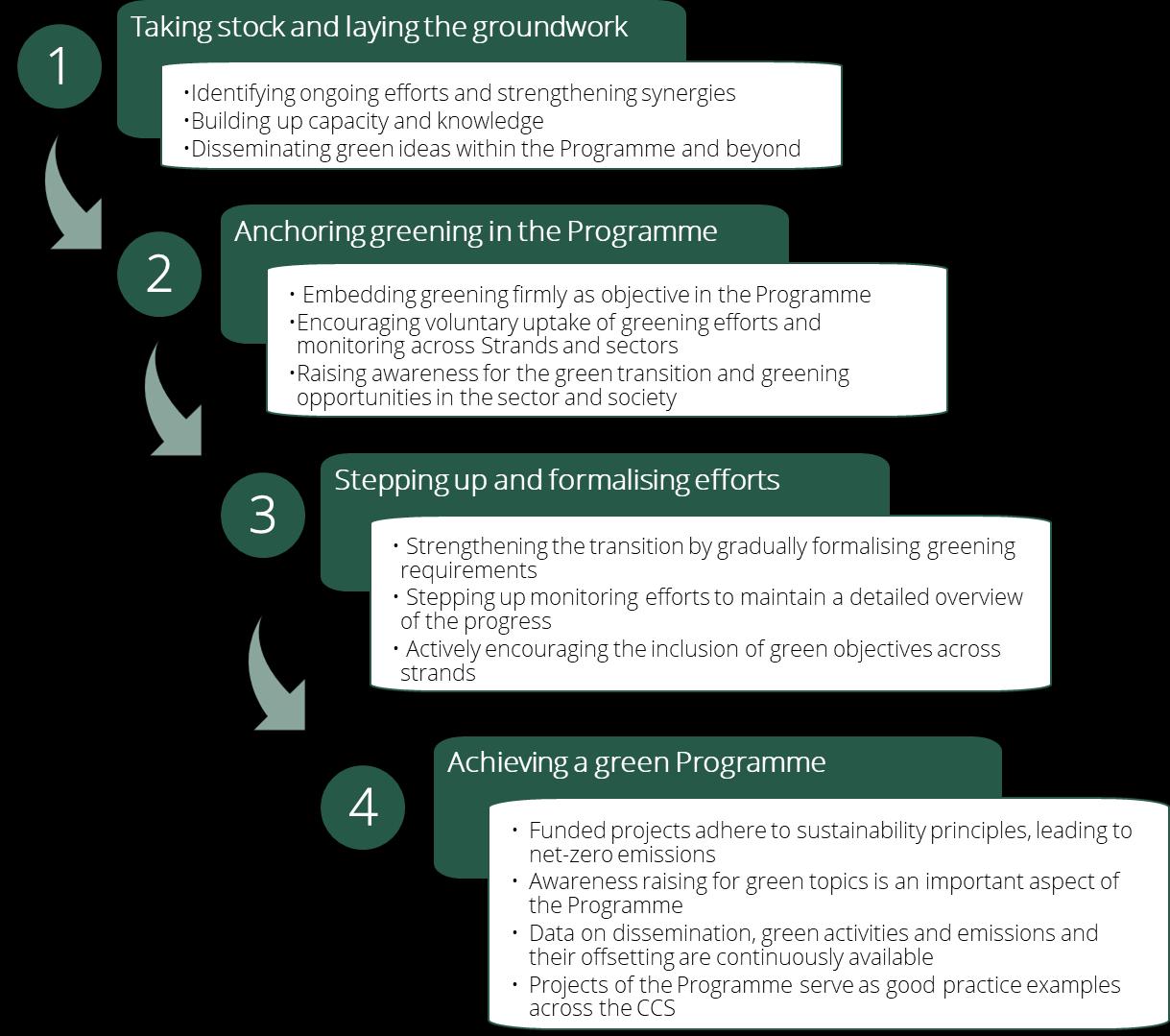
The following section sketches this transition out in a stylised and idealised form, showcasing how the different stages feed into and build on one another.
Taking stock and laying the groundwork
Timeframe: Past and current programming period
The first stage of the strategy focuses on an in-depth understanding of the extent of current greening of the Creative Europe Programme, identifying ongoing activities and initiatives that can be built on and used as starting point for future efforts. According to the findings of the Greening study, Four out of five predecessor programme beneficiaries green their activities already or pursue green objectives within and beyond the CCS. To a lesser extent, they also already monitor their environmental impact and calculate their CO2 emissions. The study has also identified many ongoing efforts on the side of the Commission, the Desks, and across CCS, driving and coordinating efforts to achieve greater sector sustainability.
Therefore, the first stage of the strategy is already well underway and can be further strengthened during the current programming period. The Commission can encourage beneficiaries to continue and increase their greening efforts. The Commission can coordinate and – to the extent possible – provide resources to Desks and beneficiaries to enhance their capacity and knowledge base for greening all types of projects and actions supported by the Programme. Building on voluntary greening initiatives and mainstreaming activities already delivered by Programme beneficiaries, the Commission can facilitate peer learning and good practice exchange that can further step up the already existing greening efforts.
Using the Programme funding as additional incentive for the greening that is already delivered bottom-up by programme beneficiaries, during this first stage the Commission can recognise, valorise and promote sustainable practices, green creative ideas and mainstreaming of sustainable practices that are already delivered and proposed by supported projects. It can also start applying and testing green indicators and monitoring methodologies proposed in the Monitoring Guide for Programme Greening delivered with the Final report of the Greening study.
Finally, the Commission could also pilot new schemes (as suggested by the recommendations presented below), most notably to build up capacity among Desks to support Programme applicants and beneficiaries in greening the methodologies of their projects as well as to foster exchange and peer-learning among supported projects that would help them to further green their activities. As suggested in the Monitoring Guide for Programme Greening these new actions, monitoring and reporting requirements could be already piloted during the current programming period.
Anchoring greening in the programme
Timeframe: current and upcoming programming period
The second stage builds on the stock-taking, testing and validation efforts of the first phase and seeks to anchor successful greening practices in the programme design. During this phase, post 2027, Greening could be introduced as a Programme wide horizonal priority under the Regulation for a potential Creative Europe successor programme, with minimum requirements for supported projects to address this priority. Embedding greening firmly as a transversal objective will signal its importance to applicants, beneficiaries, Desks, as well as programme managers. By the beginning of this phase the green key performance indicators (KPIs), monitoring practices and approach to eligible greening costs, put forward in the Monitoring Guide for Programme Greening, should be thoroughly tested in time for solid monitoring data on programme greening and contribution to climate objectives to be available by 2030.
During this phase the programme managing authorities will continue to promote mutual learning and exchange of experience on good greening practices within and beyond the programme, detailing these in the annual monitoring reports and mainstreaming these via Programme Desks and dedicated schemes for development of green skills and competences among programme beneficiaries, supporting them in greening their supported projects. Dedicated greening schemes (recommended below) will help programme beneficiaries to green their activities and to continuously build on each
other’s achievements in promoting sustainability objectives, mainstreaming greening within programme design and delivery.
Stepping up and formalising efforts
Timeframe: future programmes starting 2035 and 2043
During the third greening stage, efforts of the Programme beneficiaries, Desks, and programme managers to promote sustainability of Creative Europe supported actions will be formalised and gradually stepped up to align with the 2050 climate neutrality target. During this stage the green transition of the programme sustainability concerns will become a natural part of projects benefitting from Creative Europe support. Projects will not only be asked to report on their efforts to green their Programme-supported activities, but also provide concrete and solid evidence of the results and impacts of their project greening as well as their climate and environmental mainstreaming activities (in terms of number of people reached and engaged, learning outcomes and behavioural changes achieved).
During this phase programme beneficiaries will also be required to start to systematically monitor and report on their CO2 emissions. The green monitoring data collected via these increasingly widespread programme practices will allow programme managers to come up with initial estimates of the environmental impact of successor Creative Europe Programme overall as well as to assess where further action and support are needed to improve the sustainability of the possible successor programme. Competition (for programme funds) will drive Programme beneficiaries to select the most effective CO2 calculators for monitoring and reporting purposes167
It is anticipated that by the end of this phase actions supporting programme greening and sustainability mainstreaming among beneficiaries’ audiences have become an integrated part of the programme. Desks are regularly trained in green developments in their respective programme sectors and feel comfortable guiding applicants and project beneficiaries in enhancing the sustainability of their projects and can signpost these to relevant green consultancy, advisory and technical services. It is also anticipated that by the end of this phase programme managers, beneficiaries and Desks have acquired the necessary technical know-how and experience in conceiving projects that aspire to be climate neutral.
Achieving a fully green Creative Europe Programme
Timeframe: towards 2050, earlier where possible
With the fourth and last stage, the transition towards a fully green Creative Europe Programme will be completed. In their applications, projects clearly describe their strategy to ensure a sustainable and climate-neutral implementation. As a norm, applicants will choose environmentally friendly activities for their projects, minimising the potential environmental impact of their Programme supported projects. With their
activities, many will promote more sustainable practices among European audiences or mitigate with activities foreseen in their greening strategies.
It is anticipated that during this stage programme beneficiaries have become proficient in addressing the programme requirements for green reporting. Where they are in doubt, they can turn to the Creative Europe Desks for advice and support in developing an application for a project that is climate neural. During this phase beneficiaries have come to use the most effective CO2 calculators (or services / tools that produce the calculations for them) for their specific sector or subsector. Programme contributions to the Green Deal objectives and EU spending on climate objectives are calculated via a centralised system for all EU grant programmes.
As the green transition encompasses society at large, it is foreseen that green alternatives to products, services, and production processes will have become cheaper and more widely available. Where this is not the case, the Creative Europe Programme will provide financial support in line with its objectives. Reports on emissions of CO2 for potential successor Creative Europe Programme are produced annually, providing a breakdown by strand and action. The Programme is seen as a role model for greening CCS and other EU grant programmes.
Recommended actions
Several actions are recommended to enable and accompany the green transition of the Creative Europe Programme, building on strengths and opportunities and considering the weaknesses and threats to the current greening efforts identified above. In general, this strategy differentiates the following type of recommended actions:
• Voluntary and bottom-up actions that are mostly driven by the beneficiaries of the Programme;
• Formalisation of current greening efforts that aim at acknowledging and perpetuating efforts;
• Mainstreaming systematic assessment against the greening priority in project evaluation;
• New green budget lines that provide resources and incentives for applicants and beneficiaries;
• Adjusting actions to promote greening and to enhance greening knowledge, skills and competencies; and,
• Adjustment of reporting requirements that improve the monitoring of greening efforts.
Voluntary and bottom-up actions
The actions captured under this heading can help draw on and expand the many bottomup and beneficiary-driven initiatives identified by the Greening study. Acknowledging their role and giving beneficiaries sufficient space to drive the process will be key to a successful green transition. The recommended actions include:
• Continue to coordinate beneficiaries' efforts: Building on their strong relations with Desks and the beneficiaries, provide further coordination support to link different greening initiatives and foster exchange on them within and across strands to realise synergies and avoid overlaps. The Commission is in an ideal position to foster these types of exchanges that are aligned with Programme's objective to strengthen cross-border cooperation.
• Foster peer learning and good practice exchange: The best way for programme beneficiaries to develop and enhance their capabilities is to learn from example. The Greening study has identified peer-learning initiatives that can be promoted further. In addition, the Good environmental practice guide provides a compilation of sector-specific guidelines and good practice examples that can help applicants and beneficiaries alike.
• Showcase green projects: Consider defining green programme labels that motivate projects to green their objectives and activities further or help them promote their efforts more widely. Examples of possible labels could include: 'considerable progress in greening project activities', 'project of relevance to the European Green Deal objectives', or 'project includes green innovation'. With the labels assigned during project evaluation recognise and reward projects with good and innovative green ideas while respecting applicants’ creative, artistic and editorial freedoms. The labels assigned during project evaluation can then be further used in monitoring Programme greening as detailed in the Monitoring Guide for Programme Greening.
• Establish and promote frontrunners. Acknowledge the different starting points and paces of CCS actors and projects that benefit from Creative Europe support by identifying and promoting those that are particularly advanced or interested in greening their activities. Develop a format (e.g. through peer learning) via which frontrunners can act as ambassadors, promoting their ideas and successes to other actors in their sector or beyond. Consider also fostering connections between networks and initiatives to realise spill-over effects and showcase similarities in the challenges and possible solutions across sectors and strands. The efforts of frontrunners can be particularly important in the first two stages of the transition.
• Consider setting up an online platform as a one stop shop for projects, desks, and the wider CCS: Building on the material collected for this study and especially the Good Environmental Practice Guide, the managing authorities could consider creating an online platform to facilitate the exchange and capacity building across the CCS. The platform could feature examples from across the Strands and schemes and feature cases as well as general good practice examples and guidelines to inspire projects further. Providing continuous updates and an opportunity for projects, desks, and other stakeholders to contribute and share their good practices will ensure that the content of the page remains topical and develops dynamically in parallel to the greening efforts of the Programme. The managing authorities could consider if this online platform should be created as stand-alone website or integrated into the existing infrastructure, for example
under https://culture.ec.europa.eu/creative-europe, to maximise the visibility of this platform. The platform will also be an ideal format to report on the ongoing efforts of the Programme to green its activities and could feature dynamic charts and visuals that report the data collected as specified in the Monitoring Guide for Programme Greening.
Formalising current greening efforts
This type of actions aims at providing the right basis on which the green transition of the Creative Europe Programme is based. The actions should aim at acknowledging and formalising current efforts, providing the Commission, Desks, and projects with sufficient certainty on the greening aims and a shared understanding of what greening actions from all key programme stakeholders. The recommended actions include:
• Introduce greening as formal horizonal priority for the programme: In the legislation for the next programming period, include an explicit mention of a programme-wide i.e., transversal and horizontal greening priority168. It would need to be explicitly mentioned as a horizontal priority in the body of the Programme Regulation. This would allow Programme managers to introduce and justify minimum requirements for supported projects to address this priority. Including greening as a horizontal priority for the whole programme will also create necessary visibility for the greening imperative, allow stepping up its ambition and help to harmonise approach to programme greening across its strands.
• Create green programme monitoring and evaluation categories: Building on the mapping of the internal and external dimensions of green projects provided by the Greening study, a categorisation of supported projects could be developed by the type of greening objectives and the area of project greening. For the greening objectives, the study identified 'green awareness raising', 'green capacity building', 'development of green tools or instruments', and 'greener vision for Europe' as the main categories. For internal project greening, these monitoring and evaluation categories as well as their corresponding indicators have been established by the Greening study169. In following programming periods, these categories could be used by evaluators during the application stage to assess the extent of internal project greening. The green labels and monitoring indicators, detailed in the Monitoring Guide for Programme Greening, can also help to increase the visibility of different greening efforts through green reporting and promotion of greening progress achieved. They will also be instrumental in monitoring the pace of green transition, in calculating Programme spending on climate objectives, recognising and showcasing projects making a swift progress with greening their activities, promoting environmental preservation, climate neutrality as well as green innovation and experimentation in CCS.
Mainstreaming greening in the project evaluation
The below recommendations will help to anchor and streamline greening requirements firmly in the project evaluation. As the artistic, creative and editorial freedoms prohibit evaluation of projects’ applications in terms of mainstreaming climate actions (i.e., the external dimension of greening), the evaluation needs to focus on the internal dimension i.e., assessing if and how projects that have applied to receive programme support intend to limit the environmental impacts of their activities. This entails the following actions:
• Provide systematic assessment of applications against the horizontal greening priority. The results of the Greening study show that under relevance criterion the extent project applicants address the horizonal greening priority is assessed in combination and often interchangeably with other horizontal priorities e.g. digitalisation, inclusion and diversity. The extent project applications address the horizontal greening priority under the relevance assessment needs to be evaluated separately from the other horizontal priorities.
• Introduce greening as a stand-alone and universal quality criterion in programme calls170: To reflect the ambition of greening the Programme in the project evaluation adequately, consider treating greening as a stand-alone element of the evaluation under quality evaluation criterion. The findings of the Greening study suggest that many schemes across the three strands already award points if applicants can provide a greening (sustainability) strategy for their project to be supported or for their organisation as a whole. This requirement needs to be included consistently across all strands and schemes.
• Harmonise the approach to green quality criterion across all strands and schemes: The interpretation and application of existing greening criteria differ across strands and sometimes even within schemes. Further efforts are needed to harmonise sustainability assessment criteria. All applicants should be required to demonstrate how they intend to reduce the climate and environmental impact of their project’s activities during the application stage. However, the applicants that have a comprehensive greening / sustainability strategy for their project to be supported or for their organisation as a whole (and where relevant for their partners’ organisations) could simply tick a box and upload these strategies for evaluators to review (and forego the need to describe how they intend to address the horizontal greening priority during their proposed project).
• Apply greater evaluation scrutiny and increasing demands for sustainability over time. In line with the four-phase approach proposed in this strategy, and the respective focus during each of these stages, it is anticipated that requirements for internal greening of supported project activities will increase in line with growing opportunities and abilities of project applicants to deliver more climate neutral projects. Hence, scrutiny and demands for applicants to address sustainability of their projects as one of the criteria against which their project applications will be assessed will also need to be increased. Call documents could
specify minimum requirements applicants need to comply with to gain points on this award criterion. Increasing overall consistency and clarity on what the award requirements entail will enhance the objectivity of the assessment and make it easier for Desks to provide advice. The starting point in this process of increasing demands for quality of project greening could be the guiding principles for the ‘Do no significant harm’ principle developed under the Recovery and Resilience Facility (RRF).171
• Train the evaluators of project applications in the new sustainability assessment, in what constitutes more sustainable project practices and greening good practices. The findings of the Greening study suggest that currently, experts EACEA engages for the assessment of project applications lack guidance and training as well as clear instructions for assessing sustainability of projects to be potentially supported by Creative Europe a in a harmonised manner. In addition to the recommendations above, training could be provided to application evaluators on how to assess the relevance and quality of project greening proposals, including instructions on how to review projects’ methodologies or strategies for reducing their climate and environmental impacts as well as guidelines identifying more or less sustainable modes of travel, procurement, energy sources, etc. The RRF guidelines mentioned above and the Good environmental practices guide for Creative Europe Programme developed in the context of the Greening study could serve as starting point for this guidance.
Promoting green costs, capacity and procurement
The recommendations listed below aim to enhance the support available to programme beneficiaries in greening their supported projects. Results of the Greening study suggest that currently green alternatives to activities, products, services, etc. chosen are available yet are perceived to be too expensive or might lead to cost-intense delays or changes to what was initially planned by supported projects. Therefore, to set the right incentives for beneficiaries to enhance their greening efforts and to minimise potential barriers for smaller and less affluent applicants and project initiators, the Creative Europe Programme could explore opportunities to supporting Programme greening under the current actions and administrative provisions. Based on the findings and conclusions of the Greening study actions providing support for the greening of supported projects could take the following forms:
• Invite supported projects to use more sustainable travel, subsistence and green procurement: Many beneficiaries express concerns that currently, not all costs for more sustainable options are eligible and thus reimbursed under the Creative Europe Programme. However, managing authorities stress that more sustainable options are already eligible. To overcome this lack of common understanding, projects could receive more and more targeted information that provides them with a better understanding of the eligible greening costs (e.g. for travel arrangements or the procurement of greener resources, materials or utilities). The Monitoring Guide for Programme Greening also includes a list of
171 https://ec.europa.eu/info/sites/default/files/2021_02_18_epc_do_not_significant_harm_-technical_guidance_by_the_commission.pdf and https://ec.europa.eu/info/sites/default/files/c2021_1054_en.pdf
Greening the Creative Europe Programme
recommended eligible greening costs that could be covered under future programmes.172
• Support the development of green expertise and green capacity building within the programme: As proposed in the Monitoring Guide for Programme Greening, consider funding efforts of projects to enhance their knowledge and skills on sustainability and the sustainable implementation of projects via eligible greening costs. For projects that can demonstrate how training (also on how to obtain green certification) or other green capacity building measures will help them to green their supported project, the costs related to the use of these green services could be covered by eligible greening costs. This type of capacity building and training could be particularly relevant for Desks that often are the first contact point for projects seeking information on how to green their activities.
• Incentivise procurement of greener goods and services than supported project would typically use: Programme applicants and beneficiaries may struggle to develop sustainability strategies or to green their project activities without professional advice or support. They may require input from greening consultants or other advisory services. As proposed in the Monitoring Guide for Programme Greening partners of supported projects should consider procuring goods and services of providers that can also demonstrate their environmental commitments or provide evidence that attest that their services are (or aim to be) climate neutral. The procurement of these more sustainable goods and services could be covered as eligible greening costs under the Creative Europe Programme to enhance the robustness of the supported projects greening strategies and to promote more sustainable support services solutions. Due to the nature of the Programme, only costs acquired during project implementation should be eligible for reimbursement. This includes, for example, costs to measure the ecological footprint of supported projects (see adjustment of reporting requirements below), as well as costs of green consultants, evaluation or auditing services that are climate neutral.
Developing actions to promote and integrate greening
The recommendations outlined below aim to anchor Programme greening within its strands and actions. Actions to promote greening can be integrated into existing Creative Europe schemes or take the form of public procurement:
• Support for knowledge exchange and peer learning among beneficiaries: As the Greening study highlights, lack of knowledge and capacity is often a key barrier to further greening of supported projects. At the same time, the study also suggests that many efforts are already made to build capacity, share knowledge, and disseminate good greening practices. Knowledge exchange and peer learning among programme beneficiaries could take place within the existing schemes (e.g. networks, platforms, festivals, cooperation and co-production
172
projects) as well as via dedicated green procurement calls focused on promoting knowledge exchange and peer learning under the Cross-sectoral strand.
• Consider further strengthening the capacity building among Desks: As the study suggests, Creative Europe Desks receive many enquiries from applicants and beneficiaries interested in greening their applications or supported project activities. Currently, many Desks do not have the required knowledge and capacity to advise these projects. Therefore, consider using the Cross-sectoral strand to address Desks training needs for providing guidance on Creative Europe application and project greening. Building up the green capacity among Desks can potentially have a significant multiplier effect. Green capacity building for Creative Europe Desks could entail training activities, peer learning, and other modes of capacity building (e.g. guides, factsheets173, good practices).
• Consider providing supported projects with green consultancy services aimed at greening their project practices: Explore a possibility to provide green consultancy services to supported projects via other supported projects (e.g. networks or platforms) or via a dedicated technical assistance project selected via a competitive procedure to build on beneficiaries' on-going efforts to green their project, support their greening efforts and direct them towards effective green strategies and solutions. The availability of these services may have a strong signalling effect across the Programme, even for beneficiaries that do not chose to take part in them (suggesting that their peers are receiving greening support and guidance that may also benefit their project).
• Set up new green prizes for excellence in programme greening. Consider launching an annual award of prize that acknowledges the efforts made by programme beneficiaries in greening their supported project activities, mainstreaming climate actions among their audiences and driving the greening across the programme e.g. with creative ideas, effective practices, or prominent greening activities. Following the two dimensions identified by the Greening study, there could be a prize for a project that shows excellence in internal greening of any of its supported project activities (from methodologies to implementation, monitoring and reporting), as well as a prize for a project that shows outstanding achievements in raising awareness for sustainability and environmental issues. In addition, to recognise the efforts of programme managers and Desks, there could also be a prize for the initiative that had most impact on greening the programme as a whole that particular year. Projects, programme managers and Desks would be invited to apply for the prizes. The process would help to identify frontrunners across the programme, and incentivise winning projects and individuals with recognition, but also others to step up and promote their work on programme greening.
Adjusting of reporting requirements on greening
The recommendations presented below aim to enhance the knowledge base on the state of the green transition and to increase the accountability of all actors involved in the
Creative Europe Programme greening. Currently, neither beneficiaries nor the Commission is required to report on the greening efforts under the Creative Europe Programme, which makes it difficult to assess the current state of play and to measure any greening progress made over time. The following actions can help to improve this situation (please note that the Monitoring Guide for Programme Greening contains a more comprehensive overview of recommendations in this area):
• Cover supported projects greening efforts in their reporting: The reporting requirements for beneficiaries provide the ideal channel through which information on greening efforts can be looped back to the Commission. The evidence collected during the Greening study suggests that currently, only a few projects explicitly report on their greening efforts, and the way beneficiaries report on their efforts differs substantially. To start with, the Commission could require beneficiaries across all strands and schemes to report if they have put in place a genuine greening strategy for their supported project or organisation or alternatively systematically ask them to describe the actions they will take to address the horizonal greening priority of the Programme. In addition, programme beneficiaries would need to provide information to substantiate the reimbursement of their eligible greening costs.
• Report on the share and value of supported projects pursuing green objectives: The Monitoring Guide for Programme Greening proposes four indicators for assessing the nature and volume of Creative Europe supported projects that promote fight against climate change, environmental and sustainability objectives. With the information collected by external researchers against these indicators the Commission can report the extent Programme contributes to mainstreaming climate actions to the European Parliament and the Council of the European Union as well as the interested public at large at interim and ex-post evaluation stages of the programme implementation. The Monitoring Guide for Programme Greening also includes five indicators for assessing the Programme contribution towards the European Green Deal objectives for this this institutional accountability.
5.2 Good environmental practices guide for Creative Europe programme
How to use this good practice guide?
This guide is a tool targeting for current and future beneficiaries of the Creative Europe Programme that wish to reduce climate and environmental impacts of their organisation and/or supported projects, or to contribute to environmental and climate awareness.
• Chapter 1 of this guide provides an overview of good environmental practices that programme beneficiaries could consider. This chapter includes:
• Ideas on how to set up and enhance the environmental governance of an organisation in Section 1.1;
• Ways to reduce environmental and climate impact of travel related to supported project work in Section 1.2;
• List of good practices that can be deployed to reduce energy consumption of programme beneficiaries in Section 1.3;
• Good practice examples for waste management presented in Section 1.4, following the steps of the European Waste Framework Directive; and,
• Good practices beneficiaries of Creative Europe can follow to procure goods and services in a more sustainable way in Section 1.5.
• Chapter 2 presents several ways current and future programme beneficiaries can choose to promote sustainability objectives and fight against climate change with the view of attaining the Green Deal targets, including through awareness raising presented in Section 2.1 and building green capacities, covered by Section 2.2
• Chapter 3 provides a list of activities that have worked well in exchange of information and mutual learning on green practices in the cultural and creative sectors (CCS) that could be considered by current and future programme beneficiaries.
• Chapter 4 explains the steps organisations need to consider before using available tools to measure their organisations or supported projects’ environmental footprint and lists the tools available.
• Annex 1 provides a list with links to all the good practices that have been collected during the study ‘Greening the Creative Europe Programme’ and
• Annex 2 provides concrete examples of good practices across the various areas covered by this guide.
Five quick wins
There are five important considerations that current and future Creative Europe beneficiaries should consider, if they wish to reduce climate and environmental impacts of their organisation and/or supported projects.
Develop a (short) environmental policy/strategy that includes your organisation’s (and/or supported project’s) environmental commitments, preferably based on an (initial) assessment of your organisation environmental footprint, covering all planned greening activities and governance structures for guiding, overseeing, and communicating on the sustainability commitments.
2
3 4 5
Accompanying the environmental policy/strategy, develop an action plan that lists specific and actionable activities that will be implemented to pursue the commitments outlined in the greening / sustainability strategy. This plan should be a living document considering the changing needs of organisation working in the CCS. Action plans tend to be reviewed on a yearly basis.
Combine communication of your organisations or project’s environmental policy with raising awareness activities to promote the environmental and climate change. These communication and dissemination activities can be done internally, for example via cooperate emails, or externally via social media posts, newsletters, events etc.
Participate in events to exchange information about greening practices and share mutual learnings. Organisations with sufficient resources could also consider co-organising some of these exchanges and mutual learning activities with organisation that have experience doing this.
Invest in building the green capacity of staff working or that want to work in Creative Europe projects. There are many trainings opportunities available that are free, for example information sessions organised by Creative Europe Desks to showcase good greening practices.
Introduction
The effects of climate change are visible in every corner of the world, and the scope and speed of this global challenge is increasingly evident and alarming. In response to this global challenge, the European Union launched the European Green Deal in 2019, which aims to limit the temperature rise at 1.5°C and reach carbon neutrality for Europe by 2050.
To support the European Green Deal objectives, stakeholders across different sectors have been examining what are the effects of climate change on their activities and how their activities could contribute directly and/or indirectly to climate change mitigation and adaptation measures. In the cultural and creative sectors (CCS)174, stakeholders have been working on understanding how their sectors are contributing to climate change (i.e., environmental footprint of their activities) and which of their activities are most polluting so they can work towards more sustainable practices that might reduce their activities’ contribution to climate change.
Cultural and media organisations have been quite active in the development of guidance documents, tools and other resources175 to inform their members, partners, beneficiaries and other relevant sector stakeholders about good environmental practices on environmental governance, travel, energy, etc. The good practices documents that are available are wide-ranging – some more general covering several sectors (e.g. the guide on Smart Energy for Festivals and Events) while others are sector specific (e.g. Toolkit on Environmental Sustainability in the Museum Practice).
Most guidance documents currently available tend to cover horizontal challenges e.g. green travel, more sustainable energy sources, green procurement, etc. that are relevant for many organisations working in the CCS. Following these examples and based on the findings of the Study on Greening Creative Europe that confirmed the shared sustainability challenges faced by CCS operators benefiting from Creative Europe support, this document is also structured across horizontal and cross-cutting issues that most cultural and creative organisations will need to consider in their greening journey.
This environmental good practice guide is one of the three annexes of the Study on Greening Creative Europe Programme providing its recommendations. It is intended to be read in combination with the other two annexes produced in the context of this study: 1) Creative Europe Programme greening strategy and the 2) Creative Europe Programme greening monitoring guide. This guide provides a snapshot of the good environmental practices that were found as part of the Study on Greening Creative Europe Programme, which covered the period of December 2021 to December 2022.176
174 Including the news and media sector
175 There is a myriad of good practice guides developed at European national and sector level, including: Theatre Greenbook, Green Charter Initiative of MIOB (Moving Images, Open Borders) Network, ecological minimum standards - green motion - green shooting, Best Practice Guides of Film Fundings, Green Shooting guides, SHIFT environmental guidelines, Green Charter for Film Festivals initiative, ‘Austrian ecolabel’ for museums, the Green Rider scheme of EJN- Europe jazz network (not finalised yet), Danish Arts Foundations toolkit for sustainable behaviour, Green mobility guide for the performing arts sector, green manual of the Association of Czech Audiovisual Producers, Green film certification, Ökologische Mindeststandards für deutsche Kino-, TV- und Online-/VoD-Produktionen, EcoProd, EAVE Green Policy 2021, VAF guide for sustainable film production, Ecofilming guide, Ekosetti, Italian green film protocol, European Cultural Heritage Green Paper, and many more.
176 Validation workshop participants suggested to have this guide as living document that is updated on a regular basis.
Purpose of the guide
The aim of this guide is to provide a comprehensive overview of existing good environmental practices that actual and potential Creative Programme beneficiaries can consider when applying and/or implementing their projects.177 This guide may also be useful as a manual and as a source of inspiration for Creative Europe Programme managers tasked with greening the Creative Europe Programme. It offers a review of literature collected during the Study on Greening Creative Europe on good environmental practices that may be useful for Creative Europe stakeholders in their shared work towards a more sustainable programme in the future.
This guide does not have any direct connection with receiving Creative Europe funding, its only purpose is to provide an overview of existing good practices that Creative Programme beneficiaries can consider when applying and/or implementing their projects
Structure of this guide
This Good environmental practice guide document is structured in four main chapters:
• Chapter 1 covers good environmental practices related to internal practices of organisations, including project work. The internal greening178 practices that are covered in this guide related to 1) environmental governance, 2) travel and transportation, 3) energy usage, 4) waste management and 5) procurement.
• Chapter 2 presents good environmental practices in promote sustainability and fight against climate change more generally within and beyond organisations participating the programme (external dimension), as well as good practices to enhance green capacities among CCS professionals and their audiences.
• Chapter 3 focuses on approaches for cultural and creative organisations to exchange information about greening practices and share mutual learnings.
• Chapter 4 presents monitoring and measuring tools that culture and creative organisations could use to calculate their environmental footprint.
Annex 1 to this guide provides a list of literature used to prepare this publication. This list was produced via data collection and consultations delivered in the context of the Study on Greening Creative Europe Programme. The resources in Annex 1 contain more detailed information and examples at sector and activity levels.
Annex 2 to this guide provides examples of good environmental practices covering: organisations’ internal practices related to environmental governance, travel and transportation, energy usage, waste management and procurement and promotion of sustainability and fight against climate change within and beyond organisations participating the programme i.e., external dimension of greening.
Please note the two annexes to this guide are included in Annex 2 of this report.
Good greening practices: internal dimension
This section consists of information about good environmental practices, as well as concrete examples, that Creative Programme beneficiaries could consider in their internal greening process i.e. in greening their Creative Europe project or in greening their own organisation. This section is divided into five subsections covering 1) environmental governance, 2) travel/transportation, 3) energy usage, 4) waste and 5) green procurement.
Environmental governance
Actual and potential beneficiaries of Creative Europe will want to consider creating a green and environmentally friendly culture within their organisations or for their projects supported by the Programme. The development of this culture that promotes sustainability is usually based on establishing effective green governance structures in their organisations or Creative Europe supported projects, development of internal greening policies, guides and action plans, and implementation of operations that help to reduce the negative environmental footprint of their organisations or projects. There are a wide range of activities practices that beneficiaries of the Creative Europe Programme could implement and practices that they can adapt to manage and reduce their environmental footprint, as well as to build awareness of environmentally friendly practices among their colleagues and project partners. These activities would require time and resources to be fully embedded into their organisations or Creative Europe supported projects. The table below presents how key environmental activities and practices can be adopted progressively179 by Creative Europe beneficiaries within their organisations or programme-supported projects.
Table 9: Recommended actions to establish environmental governance in organisations benefiting from Creative Europe Programme support or for projects supported by the Programme
Key activities/ practices
Calculating your environmental footprint180
• Create a list of the main activities that an organisation / supported project carries out that produce most CO2 emissions.
• Calculate the emissions from these activities using available information (e.g. number of tonnes of CO2 emissions due to project travel each year) and available CO2 conversion factors and other environmental impacts such as waste, recycling rates etc.181
• The environmental footprint calculations should be revised on a yearly basis, and data from primary sources should be collected to the extent possible limiting the number of assumptions and estimates in the calculations.
• A monitoring tool could be set up to collate relevant environmental data on specific activities to measure the environmental footprint on a yearly basis and assess progress towards the established environmental objectives (see environmental policy below).
• Environmental footprint calculations are reviewed on a yearly basis by green team (see below) and disseminated to relevant stakeholders with the organisation / project and to programme managers via project interim and final reporting (please see Section 4 for more information on good practices for monitoring and measure environmental footprint).
practices
Environmental policy/strategy
• The initial calculations tend to have assumptions and estimates, these will need to be explained in the environmental footprint calculations.
• The environmental footprint calculations will allow organisations to identify their most polluting activities and design policies to reduce these negative impacts.
• Develop environmental policy that is articulated in a greening / sustainability strategy and includes the beneficiary organisation’s (or supported project’s) environmental commitments, covering all planned greening activities and governance
• The policy includes or is accompanied with a separate set of guidelines for project activities (e.g. green procurement checklist) that have the most negative environmental impact in the context of a supported project, for example travel, organisation of events182, production of
• The environmental policy is completely embedded into beneficiary organisations or supported projects design, delivery, monitoring and reporting.
• Sustainability objectives are well-known and pursued by all staff in beneficiary
practices
structures for guiding, overseeing and communicating on the sustainability commitments.
• The policy is signed by management / Creative Europe supported project coordinator, provided with the Creative Europe project application (for all project partners), published on the organisation’s or project’s website and will be reviewed once a year.
cultural and creative works, building/office spaces, etc.
• (Senior) staff (including members of the management board or supported project managers) are required to ensure that in any activities that they undertake in the context of their Creative Europe supported projects comply with the greening policy.
• Programme beneficiaries / supported projects could potentially have a separate team / team members who are (among other things) responsible for the greening policy/strategy implementation.
• A dedicated budget is set aside to implement environmental policy/strategy i.e., activities that would reduce the environmental impact of a supported project
organisations or supported projects.
• CO2 emissions of activities supported by the Creative Europe Programme are monitored and reported in supported projects Interim and Final reports.
practices
Environmental action plan
• An action plan is developed that lists activities that will be implemented to pursue the commitments outlined in the greening / sustainability strategy, including who will be responsible for delivering particular activities, establishing current situation / baseline values and setting sustainability targets and deadlines relevant for the beneficiary organisation or project supported by the Programme.
Green team/working group
• Establish a ‘green’ team (in your organisation or supported project183) that is responsible for the coordination, communication and
• The green team follow the action plan and has regular meetings to ensure progress on the planned activities is being made.
• SMART indicators and related medium-team targets are put in place in the action plan (e.g. reducing the beneficiary organisations emissions by 2030 or supported projects emissions by interim report deadline).
• Action plan is updated on a yearly basis for beneficiary organisations and during the interim reporting for Creative Europe supported projects.
• The green team size, meetings and activities will depend on the type and size of your organisation and / or supported project.
• Progress made is well documented and new actions included on a regular basis to ensure that the long-term sustainability / climate neutrality objectives are achieved.
• Action plan is systematically updated on a yearly basis for beneficiary organisations or when preparing the next application for Creative Europe funding.
• The green team meets regularly, develops/reviews the greening action plan and ensures that the monitoring, measurement and evaluation of the
practices
implementation of the greening / sustainability strategy (and the activities that this strategy includes articulated in a greening action plan).
• The role and activities of the green team should be clearly stated in the greening / sustainability strategy for your organisation or supported project184 .
• Member(s) of the green team should lead on sharing their knowledge and experience in good greening practices within their organisation, with its supported project partners and other Creative Europe beneficiaries.
• They will also coordinate and support the implementation of the sustainability policy for their organisation / Creative Europe supported project.
sustainability policies against the objectives articulated in their greening / sustainability strategy.
• The green team works to increase the sustainability goals/ambitions of their supported organisation / project progressively and systematically over time.
Training
• The organisation / supported project has a training inhouse on good environmental practices
• All members of the green team attend environmental training/s and promote good greening practices in training their
• Environmental training is institutionalised and attended by all staff of beneficiary organisations /
practices
and/or offers employees to attend external environmental trainings (offered in the context of the Creative Europe Programme and beyond185).
• Trainings on organisations or supported project’s environmental policy (e.g. among beneficiary or its partners staff), use of carbon calculators, environmental certification, etc. could be tested and adopted.
colleagues or sharing their knowledge and experience with project partners or other Beneficiaries of the Creative Europe Programme.
• Training on actions to mitigate climate change by choice of most sustainable project activities alternatives, green procurement of products and services as well as the most effective CO2 calculation methodologies is followed by most programme beneficiaries.
projects supported by Creative Europe.
• There is a continuous and growing community of practice of CCS specialists who are aware of the environmental and climate impacts of their projects and actively seek to eliminate these (through their choice of activities and green procurement).
Communication & awareness
• Development of a communication plan that accompanies the policy and action plan (including newsletter, presentations, quizzes,
• At least twice a year, the environmental policy, action plan and activities/progress made is communicated to organisation’s own staff (see section 2 of external dimension).
• The green team regularly communicates to colleagues, programme management and project audiences on the progress achieved towards the
practices
Environmental certifications/ecolabels
social media activities etc.).
• At this stage the main objective of communication is to introduce the new greening / sustainability strategy to organisation / project staff and generate a shared understanding of the shared commitment to sustainability.
• Develop a risk and opportunities assessment of the environmental aspects that affect your organisation or supported project.
• In chase of strategies developed specifically for supported projects progress towards environmental commitments are reviewed at interim and final reporting stages and communicated programme managers and project audiences.
sustainability / climate neutrality objectives.
• Considering the multiplier effect of some Creative Europe beneficiaries, raising awareness of environmental sustainability issues at conferences, webinars, trainings has become a part of regular practices (see section 2 of external dimension)
• Align all your environmental management documentation to the requirements of the certification/label186,187 that your organisation or supported project is considering applying for.
• Apply for the certification/label to your organisation / supported project and assign a person in your organisation / project who will be responsible for the maintenance of this certification/label.
Greening the Creative Europe Programme
activities/ practices
Assessing and reporting
• Organisations need to consider how they will report on activities included in their environmental policy and plan, and how to assess their results.
• It will be important that organisations make sure that learnings and adjustments from assessing and reporting on activities are interjected and brought back in with a positive feedback loop structure to the organisation’s resources.
• In the long-run, organisations could ensure that their reporting practices together with its overall environmental governance structures are adequate to the international standards by seeking certifications.
(Source: Own creation inspired by SHIFT culture project documentation and Ecorys journey to become a carbon neutral organisation by 2030)
Good environmental governance practices identified during the Study on Greening Creative Europe are included in Annex 2 of this guide.
Travel and transportation (including touring)
Travel is important as it contributes to the development of European culture and identity. It allows European citizens to visit other countries, learn, familiarise and fall in love with other cultures. Travel enriches the European societies, shapes European identity, contributes to diversity in Europe, alongside promoting tolerance and inclusion. Mobility of artists and creative professionals is crucial to enhance artistic and cultural cooperation in the EU. However, travel and transportation of participants, artists, crews, infrastructure, etc. is one of the largest sources of carbon emissions of any creative activity188 Programme beneficiaries only exercise partial control over their travelling practices. They can only encourage particular modes of travel among their staff, have limited influence over greening of transport industries or ability to change cities’ green mobility plans. As traveling is still fundamental to the CCS and projects supported by Creative Europe, there are steps beneficiary organisations can take to support greener travel choices for their staff, audiences, visitors (including artists/freelancers) as well as their equipment, stages and decors.
Regarding transportation – deliveries and touring – beneficiary organisations can choose sustainable options to minimise their carbon footprint and include these practices as part of their greening / sustainability strategies and action plans or even have a separate guide on green travel/transportation options.
In all instances, the key to reducing travel emissions is to189:
1. Reduce the number of journeys where possible;
2. Identify more sustainable travel options and facilitate their use; and,
3. Promote greener travel choices, for example by educating project staff and audiences about environmental impact of particular modes of travel (e.g. use of cars and flights), informing them of alternatives, and incentivising these more sustainable alternatives.
There are several ways how beneficiary organisations can support (and promote) greener travel options:
1. Where possible replace air travel with rail travel for international destinations (air travel is the most carbon intensive form of travel, emitting six times more CO2 than equivalent passenger journey when taking the train190).
2. Make cycling or walking to the place of work or your creative event as stressfree and attractive as possible (e.g. share information on local cycling routes,
188 Travel represents a category of Scope 3 emissions. The GHG Protocol Corporate Standard classifies a company’s GHG emissions into three ‘scopes’. Scope 1 emissions are direct emissions from owned or controlled sources. Scope 2 emissions are indirect emissions from the generation of purchased energy. Scope 3 emissions are all indirect emissions (not included in scope 2) that occur in the value chain of the reporting company, including both upstream and downstream emissions https://ghgprotocol.org/sites/default/files/standards_supporting/FAQ.pdf
189 The Theatre Green Book. Part 3: Sustainable Operations. Available at: https://theatregreenbook.com/ 190 Time. Why Flying Carbon Class to COP26 Is More Expensive Than Taking the Train. Available at: https://time.com/6108578/why-flying-is-more-expensive-than-takingthe-train/
organise group rides or walks, provide on-site cycle maintenance services or workshops, have information about public transport and timetables on organisations’ website).
3. Provide adequate facilities for cyclists (including cloakrooms, secure bike storage for staff and audiences, charging points for electric bikes, etc.). Marketing and website information can inform audiences and visitors of the facilities your organisation/venue offers.
4. Work with local authorities to ensure signage for pedestrians is effective to point pedestrians to your venue, as well as well-signed and marked cycle routes to your event are available. In some places it may be possible to partner with a local citybased bike scheme.
5. Incorporate charging point/s at your premises or choose venues that have charging points as well as promote taxi companies with electric vehicles in organisations or events’ website.
6. Partner with public transport providers to offer free or reduced transport tickets, and (for larger events) increase capacity and/or running times to enable audiences to opt for public transport.
7. Limit car travel and encourage car sharing (e.g., if possible, reduce the availability of parking spaces, use a car-sharing platform for people to find others to carpool with and/or make parking more expensive).
8. Create a transport plan by mapping areas where contractors, goods or equipment are coming from or going. Consider also asking contractors whether they can share loads and about their own investments and sustainable practices (e.g. fuel-efficient driver training, electric vehicles, etc.).
9. Hire or buy local equipment, production materials and food to minimise transport delivery distances.
10. Consider collecting qualitative and quantitative data on audience travel to improve event/s travel plan. For example, ask people where they travelled from, how they travelled, what would help them to use public transport.
11. Consider the rental of electric and low-consumption vehicles. Organisations should aim to hire vehicles that are energy-efficient and/or electric and encourage individuals working on artistic pieces (e.g. actors and artists) to set example by also renting energy-efficient and/or electric vehicles.
On top of the options mentioned above, programme beneficiaries could consider the following strategies to reduce and/or use green travel options for audiences, staff, visitors, deliveries and touring.
•
Audiences Staff Visitors Deliveries
• A slight reduction of ticket costs for use of public transport, which can be promoted through ticket sales.
• Reducing car parking provision over time.
• Flexible working, to reduce commuting.
• Video conference calls191 to reduce travel to meetings.
• Time management to reduce the numbers of long-distance journeys (e.g. a single journey can be planned to serve multiple meetings).
• Reducing single journeys in taxis.
• Sustainable travel options can be promoted and incentivised by: Signing up to the cycle-to-work scheme to subsidise bicycle purchases and providing more secure bike storage (and tools for bike repair).
• Providing shower facilities for cycle commuters.
• Subsidising local transport passes.
• Timing meetings to help staff avoid rush hours.
• Use local contractors if possible or contractors that have their own greening / sustainability strategies / commitments.
• For visiting artists, provide temporary accommodation close to rehearsal spaces and venues. Try to create longer residencies for out of-town artists. For journeys to work or rehearsals, promote
• sustainable travel options.
• Adopt videoconferencing where possible.
• Consider where visiting artists and freelancers are based. It may be possible to employ freelancers based nearby.
• Planning ahead to avoid multiple deliveries from the same suppliers.
• Ensuring production and storage facilities are in close proximity.
• Sourcing materials and staff (e.g. production teams) locally.
• To ensure deliveries are as sustainable as possible:
• Consider replacing your own transport with an electric van.
• Seek out suppliers who offer sustainable deliveries.
Touring
• Reduce the number of people and the amount of props you tour with.
• Reduce the number and length of journeys.
• Choose sustainable transport wherever possible.
Source: The Theatre Green Book – Sustainable Operations192, European Audiovisual Entrepreneurs (EAVE) Green Policy 2021193, Distributed Design Platform (DDP)194 and Ecorys internal practices
191 Important to note that video conferences/calls do also have a carbon footprint from network data transfer and from computer use.
192 https://theatregreenbook.com/book-three-sustainable-operations/
193 https://eave.org/about/eave-green-policy-2021
194 https://distributeddesign.eu/resources/
Examples of good environmental travel/transportation practices identified during the Study on Greening Creative Europe are included in Annex 2.
Energy usage
Energy is needed for most of the activities we carry out in our daily lives, and it is another main driver of climate change in the world as a lot of the energy is still being generated by burning fossil fuels. In the case of CCS, energy is needed to power buildings (offices or venues where cultural events take place), production and distribution of creative works (e.g. films, radio shows, video games, etc.), outdoors cultural events (e.g. generators needed to power events) and other activities.
Beneficiary organisations and projects supported by the Creative Europe Programme can reduce their indirect production of CO2 emissions and nuclear waste resulting from energy usage by reducing energy use through effective management, use of more energy efficient office buildings and by switching to utilities contracts with suppliers that use renewable energy sources, where they are available and affordable. It is important to note renewable energy options vary per country and region across the EU, thus not all Creative Europe current and future beneficiaries might not have renewable energy options available to them.
The section of this guide presented below includes a list of good practices that organisations can deploy to reduce their environmental footprint from their energy usage per type of activity.
Buildings/venues
There are several ways to reduce energy consumption of buildings and venues used for the management and / or performance of cultural and creative activities (e.g. museums and exhibition halls, operas and theatres, music and other performing arts venues, including circus arts, puppetry and dance venues, etc.), if the option to move to a more energy-efficient or net-zero building/venue is not an option. Some suggestions on how Creative Europe beneficiaries could reduce energy consumption of the buildings and venues they use for their activities are listed below:
• Supply your building/venue with renewable electricity195, if available in your area.
• Consider options for more energy efficient equipment or technology e.g., LED festoon lighting, photocell distros and generator load monitoring.
• Unplug equipment/s when it is not being used.
• Consider investing in efficient heating and cooling systems, which allows energy savings up to 50 % and more in buildings and offices. Better insulation and heating systems will reduce the CO2 emissions and the energy costs by a minimum of 30 to 40 % compared to traditional buildings with poor insulation196 .
195 Is
196 https://bishopshvac.com/the-most-efficient-heating-and-cooling-systems/
• Consider investing energy-aware software engineering solutions (e.g., using climate responsible solutions that limit battery usage).
• Consider using renewable energy technologies, like solar photovoltaic panels or heat pumps197
Production, development, and distribution of creative works (e.g. films, TV series, documentaries, advertisements, etc) and digital activities
The good environmental practices when it comes to energy efficiency for the production, development and distribution of audio-visual productions and digital activities (e.g. social media marketing and promotion of creative events, online meetings) include:
• Using local supply if sufficiently powerful and reliable to power the necessary electronic equipment.
• Consider the lifecycle and ecological footprint of the equipment you procure for your supported project (pre, during and postproduction equipment) and whether more energy-efficient equipment could be used.
• If using generators, turn them off at night and during assembly as well as during lunch or stoppages of more than 30 minutes198. If possible, hire environmentally friendly generators that limit energy consumption, reduce noise and petrol consumption.
• Preferably use renewable energy sources (e.g., renewable energy suppliers, autonomous solar kits for recharging batteries, etc.).
• Incentivise the use renewable energy generators, including generators running on hybrid, electric or hydrogen renewable energy sources.
• Use natural light as much as possible and use LED lighting equipment and/or fluorescent lamps.
Cultural events/festivals (outdoors)
Julies Bicycle199 has developed a guide called ‘powerful thinking’ that describes how best to plan and manage a successful outdoor event in an energy efficient way.200,201 It includes six steps:
1. Make a plan and assign some members of staff to manage the process202. The plan should include targets linked to energy efficiency e.g. energy demand, new contract with power suppliers, measurement of load and fuel use for generators, etc. This plan should be aligned with the organisation’s environmental policy and action plan if already developed.
2. Liaise with power suppliers. Meet with power supplier/s early on and engage endusers to plan and understand event energy requirements, estimate how much power will be needed where and when, and ensure power provision is matched to actual requirements. Key aspects organisations should include:
• Agree fuel use (or reduction) targets.
197 While renewable energy sources will be hundreds of times ‘cleaner’ in terms of CO2 emissions than traditional energy sources that produce energy by burning fossil fuel or biomass, please also keep in mind that no energy source is completely clean and that it is also important to check, if possible, how your provider sources and recycles materials used to generate renewable energy that you would like to use.
198 https://www.screen.brussels/sites/default/files/screen.brussels-environmentallyfriendlyfilming-en-web.pdf
199 https://juliesbicycle.com/
200 https://juliesbicycle.com/wp-content/uploads/2022/01/PowerfulThinkingGuideMarch2017v1_UK.pdf
201 This example was listed by interviewees as a good practice example. Please note that the UK left the EU on 1 of February 2020. As the scope of this study covered the Creative Europe predecessor programme implemented during the period from 2014 to 2020, this example has been included in this report. Future Creative Europe beneficiaries can still use this example for inspiration, yet are invited to be mindful of any implications of Brexit.
202 This plan or a general plan for cultural outdoor events can be part of your organisation’s greening / sustainability strategy.
• Set clear responsibilities for how generators and other power will be monitored, how energy is recorded and by whom.
• Request a detailed post-event report on energy management. In case several organisations are involved in the organisation of an event/festival, the main organiser and/or organisation contracting the power for the event should be responsible for requesting the post-event report to the energy supplier.
• Agree responsibility for contacting all end-users of power for their accurate requirements and a timeline to achieve this. This includes all concessions, artists’ management (e.g. tour buses), outside broadcasting, production and contractors.
• Consider energy efficiency options described above (under buildings/venues).
3. Communicate. Organisations should share how they plan to reduce energy within their organisations and external stakeholders together with any other useful information about the event. There are a few factsheets203 available on how to communicate the use of renewable energy and the use of more energy saving practices in events.
4. Measure and monitor on site. Organisations should try to capture data on their energy consumption on a yearly basis to monitor and measure their performance over time and calculate the CO2 emissions due to their events (please see Section 4), including of ad-hoc outdoors events for which additional energy sources (e.g. generators) are needed.
5. Review and set new targets. Organisations should try to review energy data from past events to feed into making the next event more energy efficient. Setting some new targets, either for an event (i.e., activity level) or organisation level should help to monitor, measure and evaluate performance over time (see Section 4), which is crucial for reducing CO2 emissions.
6. Share experiences. Organisations that have successes or learning points should share them with the growing community of event organisers, allowing them to make the necessary changes to become more sustainable by offering a case study of their experience (see Section 2 – external dimension).
Examples of organisations seeking and sharing more efficient energy usage practices identified during the Study on Greening Creative Europe are included in Annex 2.
Waste management
The European Waste Framework Directive204 lays down some basic waste management principles. It considers the impact of different waste management options on climate change, air and water quality, and resource depletion, and provides a framework for
203 Communicating Green Energy at Events available at: https://www.powerful-thinking.org.uk/factsheet/communicating-green-energy/, Roles at a Glance available at: https://www.powerful-thinking.org.uk/factsheet/making-change-happen-roles-at-a-glance/ and Getting Smart with Energy for Stakeholders available at https://www.powerful-thinking.org.uk/factsheet/getting-smart-energy-stakeholders/ 204 https://environment.ec.europa.eu/topics/waste-and-recycling/waste-framework-directive_en
managing waste responsibly and minimising environmental impacts. It should be used as a structure to help organisations prioritise their actions that include more prevention measures than waste disposal plans.
The framework includes five steps illustrated in the figure below, from most desirable step (refuse) to least desirable (recycle).
Prevent
Avoiding or reducing waste being created by using less material in design and manufacture, designing things so they last longer, keeping things for longer, and by re-using (e.g., selling or buying used items). Purchaise more sustinable and circular products
Re-use/repurpose
Making materials last longer by using them again & again...
Recycle
Reprocessing waste into a new substance, materials, or products that can either be used in the same way as the original, or into something new. (Other) Recovery
Includes anaerobic digestion, combustion/burning/incine ration with energy recovery (as long as it meets certain effciency standards), and other processes that can produce energy (fuel, heat, power) from waste
Disposal
Anything that isn’t recovery, e.g. landfill and incineration without enery recovery.
Prevent
The offer of socially and environmentally responsible products in Europe is quite wide, and when possible, organisations should try to purchase more sustainably produced and more circular products. Ki Culture published a book205 that includes ‘green’ products ideas that cultural and creative organisations could consider when purchasing new products and thinking about their waste management (i.e., is the product recyclable). Presented below are some of the ‘green’ products that could be considered:
• Bubble wrap is used for equipment transportation (e.g., furniture for a film), storage (e.g. in museums) and other purposes. Bubble isn’t typically recyclable but there are few alternatives: recycled content bubble wrap (up to 90%) is offered by some manufacturers, a take back program for bubble wrap206, or
205 https://kibooks.s3.us-east-2.amazonaws.com/2021/january/Waste+and+Materials+Ki+Book+-+KiCulture.pdf
206 https://www.sealedair.com/company/media-center/press-releases/sealed-air-salutes-innovation-bubble-wrap-appreciation-day1
switching plastic for paper by using shredded cardboard or heavy paper to cushion your objects while in transit.
• Gloves are a necessity among many culture and creative sector practitioners (e.g. set designers). Nitrile and latex gloves are typically thrown away and end up in landfills, incinerated, or worse- as pollutants in our environment. There are some greener alternatives: 1) cotton gloves that can be used many times as they can be washed regularly when dirty and are biodegradable at end-of-life cycle; 2) bamboo viscose gloves have similar benefits than cotton gloves plus bamboo does not require chemicals, pesticides, or fertilizer to grow; and, 3) other less sustainable alternatives include nitrile coated nylon and Polylactic acid (PLA) gloves.
• Packing tape tapes typically comprise either polyester or polypropylene backing with pressure sensitive adhesive (typically acrylic) which are not easily recyclable207. There are alternative tapes like natural paper backing and biodegradable adhesives to reduce synthetic packing tape waste.
Reuse and repurpose
• Many of the products (e.g. costumes, sets, electronic equipment) as well as artistic work can be reused and repurposed, and there are several tips, listed below, that beneficiary organisations in the CCS can consider.
• Try to rent/borrow material/equipment that your organisation does not use regularly. For example, in Hamburg (Germany) there is an organisation called Hanseatische Materialverwaltung208that has an online catalogue of stage sets and decorations that can be rented for a desired period of time.
• Use reusable materials (e.g. cups, plates, tents) at events that attendees can either take home or can be reused at future events.
• Repurpose sets of films, festivals, and other events for future events. Cultural and creative organisations working nearby might want to consider renting a common space to store props for future use.
• Try to reuse banners/signage by not dating them or including information specific to particular events (that can be added to the signs as needed).
• Repurpose cultural and creative audio-visual content for other purposes (e.g. school learning).
• Encourage integration of sustainable thinking and working into relevant university degrees (e.g., studies of stage and costume design).
• Donations to charities and academies: the first might repurpose material for other uses, the second might use it for education purposes e.g. donating a set design construction piece to a local theatre academy for students to repurpose it and in the process learning how this piece were designed, constructed, and assembled.
Recycle
207
208 https://www.hanseatische-materialverwaltung.de/
When purchasing new products organisations should consider if these can be later recycled (as a part of waste prevention practices that a beneficiary organisation could implement, please see above), as well as put in place effective recycling practices so that all members of staff understand what, how and where they should recycle. The figure below provides an overview of the processes that organisations could put in place to ensure effective recycling practices.
Figure 13: Recycling processes
WHAT? All organisations, to the extent possible should think about the types of waste they know they are likely to generate with their activities and speak to waste contractor or research the types of waste treatment facilities available in the area. Some of the waste categories include: 1) putrescible (organic waste), 2) paper, 3) cardboard, 4) composite, 5) textile, 6) sanitary textiles, 7) plastic bottles, 8) plastic pots, tubs and trays, 9) plastic film, 10) glass, 11) ferrous metal, 12) non-ferrous metal, 13) non-combustible, 14) combustibles, 15) special waste (e.g. electronic equipment waste regulated by the WEEE Directive209), 16) wood, etc.
HOW? Develop a waste management plan (which could be part of organisations’ overall sustainability strategy) that includes an overview which waste your organisation will be recycling, who should be involved in the planning and management of effective recycling practices, where to find the bins for recycling and any monitoring and measuring of waste that the organisation is using.
WHERE? There are two main types of waste collection for recycling: singlebin, where different types of recyclable materials are collected together, or multi-bin, where different types of materials are collected separately (source-segregated). In both cases another bin will be required for everything else that can’t be recycled.
Source: Practical Guide: Waste Management in Buildings, Julie’s Bicycle 2015210 (Other) Recovery
An alternative way to manage waste that cannot be repurposed, reused, and recycled, is to send waste to energy recovery211 facilities that are able to transform waste into energy and send it to industrial composting when it comes to single use compostable materials.
Disposal
Lastly, waste that cannot be repurposed, reused, recycled or transformed into energy will need to be disposed into landfill.
Examples of good environmental practices for waste management identified during the Study on Greening Creative Europe are included in Annex 2.
Green procurement
Goods and services used by cultural and creative organisations have ‘hidden’ carbon footprints and other environmental impacts from extraction of raw materials to manufacture and production as well as transport and travel for goods and services. Organisations can help support a greener economy by introducing minimum sourcing standards.
There are a number of good practices beneficiaries / projects supported by Creative Europe can follow to procure goods and services (e.g. food, catering, accommodation, etc., but also audit, bookkeeping, and evaluation services) in a more sustainable way. Some general good practices include:
• Demand from suppliers to share their environmental commitments, policies and credentials, including credentials that show how suppliers meet the EU directives in eco-design212 .
• Engage with local suppliers and encourage them to consider investing in greener products if they are not already offering locally sourced and green products.
• Set minimum sourcing standards in different areas. These include certifications or accreditations on how the product was grown (e.g., organic), harvested, processed/manufactured, considering social and environmental claims; human rights (e.g., Fairtrade); release of chemicals to the environment; forest sustainability (e.g. FSC certified), etc.
• Give preference to hired, reused, reclaimed, and recycled materials and products.
• Always ask suppliers for evidence to verify their sustainability and/or ‘green’ (i.e., bio, locally sourced or produced) products claims.
For food and catering, organisations should:
• Consider serving vegetarian or vegan menus at events, as the highest food related greenhouse gases (GHG) emissions come from animal products.
• Develop an events food policy that includes a ratio of vegetarian to meat-based dishes to be provided by vendors – as a minimum, indicate that suppliers must serve at least one equivalent vegetarian option in the same price range.
• Avoid unseasonal produce, foods grown in greenhouses or airfreighted produce.
212 https://ec.europa.eu/commission/presscorner/detail/en/QANDA_19_5889 and EPR https://ec.europa.eu/environment/pdf/waste/target_review/Guidance%20on%20EPR%20-%20Final%20Report.pdf
• Sourcing food as locally as possible will reduce emissions from transporting food and boost the local economy213
• Supporting heritage varieties of vegetable and fruit produce can also help support biodiversity and the resilience of global food systems.
• Support local initiatives and existing campaigns (e.g. local cooperatives or grower’s associations, permaculture projects, food redistribution charities, etc.)
• Consider serving only certified food at events (e.g. fairtrade, Marine Stewardship Council certified fish, etc.).
For accommodation214, as highlighted in Julie’s bicycle touring guide215, organisations should:
• Choose hotels and accommodation providers with commitments to environmental sustainability or that have environmental certification or awards.
• Consider the chosen accommodation’s proximity to your venue to minimise local transport impacts on environment.
• Encourage crew, staff and performers to stay with friends and family where possible when travelling or touring and offer financial benefits for it (equivalent to their ‘usual’ accommodation costs).
• Rent flats for longer stays that tend to be more energy-efficient (and cost-effective) than staying in hotels or B&Bs.
Examples of good environmental practices for green procurement identified during the Study on Greening Creative Europe are included in Annex 2.
Good greening practices: external dimension
This section presents information about good environmental practices, as well as concrete examples and case studies, that Creative Programme beneficiaries are using and/or could use when promoting environmental sustainability and fight against climate change outside of their organisations or beyond their supported projects. There are several ways beneficiary organisations can promote sustainability objectives and fight against climate change with the view of attaining the Green Deal targets, including through raising awareness activities (covered in Section 2.1) and building green capacities (see Section 2.2).
Raising environmental and climate awareness
Cultural creative and cultural content can be a key driver of change towards more environmentally responsible CCS and society. Raising awareness of environmental concerns and risks due to climate change through various cultural and creative activities, works and services can contribute to changing mentalities and encourage change towards greener practices within the sectors Creative Europe beneficiaries operate as well as their audiences. There are several instruments that organisations supported by the Programme and future beneficiaries can use for this purpose, including:
213 However, food miles are less important than how food is grown when it comes to the carbon footprint of food – for example, food grown locally in a greenhouse may have a higher carbon footprint than the same produce grown in open fields but transported a longer distance.
214 https://juliesbicycle.com/wp-content/uploads/2022/01/Touring_guide_2015.pdf
• Organisation and/or participation at awareness raising events including large conferences that tackle environmental and climate challenges (e.g., the Conference on climate change and heritage), festivals (e.g. We Love Green216), educational and participatory events (e.g. the site-event on educating for the built environment: life-long and ‘life-wide’ learning in arts, architecture and engineering at the New European Bauhaus Collective)217, etc.
• Participate in working groups to share good greening practices and activities organised by cultural and creative networks and associations (including those supported by Creative Europe). For example, working groups could be organised to discuss new greening opportunities promoted by these networks and associations as well as their members on approaches promoting sustainability, greening tools and ‘green’ research needs.
• Participation and/or creation of competitions/awards promoting sustainable practices in CCS. For example, Fab Lab218 has a competition for organisations to come up with sustainable material for culture and industrial product design and the Distributed Design Market Platform awards organisations that propose innovative production of audio-visual works, including a sustainability criterion e.g. the use of sustainable materials219 .
• Participation and/or creation of labs that address particular sustainability challenges faced by CCS operators. For example, TorinoFilmLab together with Trentino Film Commission and EAVE are working on a film lab, for which film professionals, sustainability trainees and sustainability managers need to apply to participate220. In this lab, questions about green film production are tackled.
• Support and/or lead advocacy work towards EU institutions to raise awareness among policy makers of the different sustainability needs of CCS and contribute to legislative processes. Projects supported by Creative Europe can raise awareness of regulatory needs and best ways to tackle sustainability in their specific sector via ongoing dialogue that they have with the Commission. The programme also supports initiatives that focus specifically on advocacy, addressing sustainability of CCS in the EU among other issues.
• Production and/or contribution to ‘green’ publications aiming to promote sustainable practices in their sector. Publications produced by supported projects could include studies on how to increase sustainability of their sector, position papers on how to best achieve sustainability, and guidance documents on greening. For example, ENCATC221 is working on two position papers on the New European Bauhaus and on culture and sustainability, while Europa Nostra in collaboration with ICOMOS222 and the Climate Heritage Network have published a European Cultural Heritage Green Paper on ‘Putting Europe’s shared heritage at the heart of the European Green Deal’223 .
• Develop storytelling and narratives that explain different ways and approaches to work towards an ecological transition and climate change prevention. Current and future programme beneficiaries, particularly small organisations, play an important role in influencing and informing audiences about
216 https://www.welovegreen.fr/?lang=en
217 The New European Bauhaus collective (NEBC) is a grouping of several pan-European organisations representing architects, spatial planners, landscape architects, interior architects, engineers, designers, artists, educators and researchers of the built environment, and more broadly the cultural and creative sectors. The networks part of NEBC funded by Creative Europe include Architects’ Council of Europe (ACE), Culture Action Europe (CAE), Europa Nostra, Trans Europe Halles (TEH), Future Architecture, LINA, European Council of Interior Architect (ECIA), European Council of Spatial Planners (ECTP-CEU) and ELIA. More information available at: https://www.ace-cae.eu/activities/neweuropean-bauhaus-collective-nebc/
218 https://fabfoundation.org/getting-started/
219 https://distributeddesign.eu/distributed-design-awards-2022/
220 http://www.torinofilmlab.it/green-film-lab
221 Encatc is a European network of over 153 educational and training centres focusing on cultural management and policy.
222 ICOMOS is a professional association that pursues conservation and protection of cultural heritage places around the world.
223 https://www.europanostra.org/putting-europes-shared-heritage-at-the-heart-of-the-european-green-deal/
the climate change and environmentally friendly practices, sometimes even more than working on reducing their own carbon emissions224 .
• Environmental campaigns can be organised and delivered as part of cultural and creative work. Film and performance premieres as well as openings of exhibitions provide opportunities for discussing sustainability. Premieres and openings can be themselves the events drawing attention to sustainability issues, or they can benefit from the exposure provided by larger communication campaigns that attract media attention in promoting public’s awareness of environmental and climate urgencies. For example, some nature and climate-change focussed documentaries have been recently accompanied by international communication campaigns aiming to promote more sustainable practices, environmental impact on the planet, as well as promote more sustainable and responsible policies to stop climate change and support communities.
Examples of good environmental practices for raising environmental and climate awareness identified during the Study on Greening Creative Europe are included in Annex 2.
Building green capacities among professionals and citizens
There are several activities that beneficiaries of the Creative Europe could consider for building ‘green capacities’ of the professionals working in their organisation as well as among their audiences. These include:
• Work with (external) environmental and / or sustainability expert/s to train their staff on how to improve the sustainability of their operations, activities and practices as well as the best tools (i.e., sustainability strategies, plans, CO2 calculators, etc.) that they can use to support their greening.
• Attend trainings on good greening practices for the CCS. Many European and national platforms active in the CCS offer trainings on how to develop a greening strategy, setting up and implementing environmental governance systems, use a monitoring tool to collect data on environmental and climate impacts, etc. Also, organisations that have developed carbon calculators (see Section 3) offer trainings on how to use them.
• Attend information sessions to showcase good greening practices. Several Creative Europe Desks are already offering information sessions to showcase good practice examples on greening and on other cross cutting priorities (i.e., gender equality) of the programme. The recommendations of the Study on Greening Creative Europe further recommend stepping up the sustainability training for desks to build their capacity for this type of service. Moreover, desks could use this guide for their information sessions and other activities and consider organising practical sessions where Desks teach organisations how to use the guide and gather additional information from local and regional organisations to complement and align the guide also to regional and local needs of the organisations including vendors, suppliers, donors of Creative Europe grant beneficiaries.
• Promote and disseminate their good green practice examples and research (see Section 1.2.). As concluded by the Study on Greening Creative Europe, many cultural and creative organisations supported by the Programme already implement good greening practices or carry out research that can be used to strengthen the capacity of CCS in designing and delivering more sustainable projects. It is important that good practices and research delivered with the support of Creative Europe are disseminated to enhance the sustainability of the Programme and CCS in general. For 224
example, Creative Carbon Scotland has a database225,226 (see Annex 2) of case studies demonstrating the benefits of collaborating with artists to achieve environmental sustainability outcomes that could be considered by current and future Creative Europe beneficiaries.
• Collaborate with organisations/individuals to strengthen sectoral capacity to operate more sustainably. Supported beneficiaries or projects could collaborate with local specialists or organisations to develop methodologies that their managers can use to create and implement greening strategies in their creative organisation, enterprise or project, changing the way they operate to reduce their impacts on environment and climate change.
• Support dialogue via existing green initiatives (e.g., Green Arts Initiative227) and/or via events, showcasing good greening practices or planned greening activities (e.g., Clean Energy Package and architecture’s role in the uptake of energy efficiency measures in the framework of the European Sustainable Energy Week).
Examples of good practices in capacity building for more sustainable CCS operations identified during the Study on Greening Creative Europe are included in Annex 2.
Good greening practices: exchange and mutual learning
There are various ways for cultural and creative organisations to exchange information about greening practices and share mutual learnings. The table below provides a list of activities that have worked well228 in promoting exchange of information and mutual learning on sustainable practices in CCS.
Table 10: Examples of exchanges and mutual learning activities on sustainability within CCS
Type of mutual learning activity Examples
Conferences
European Concert Hall Organisation (ECHO) hosts the Art of Music Education Conference (so far six volumes) in collaboration with members of ECHO. In these conferences, participants explore the role of classical music in society, education and the environment and investigate how collaborative partnerships can support the role of concert halls in multi-diverse urban societies. The 2022 edition of the Conference focused on current challenges faced by the sector due to the pandemic and climate change, exploring the flexibility and adaptability of the concert business within the context of climate and environmental urgencies. 229
225 https://www.creativecarbonscotland.com/resources/library/
226 This example was listed by interviewees as a good practice example. Please note that the UK left the EU on 1 of February 2020. As the scope of this study covered the Creative Europe predecessor programme implemented during the period from 2014 to 2020, this example has been included in this report. Future Creative Europe beneficiaries can still use this example for inspiration, yet are invited to be mindful of any implications of Brexit.
227 https://www.creativecarbonscotland.com/green-arts-initiative/
228 According to research findings of the Greening the Creative Europe programme
229 https://www.music-education.hamburg/?lang=en
Workshops
Bootcamps
Training programmes
Green Distribution Workshops, organised by Europa Distribution, are designed to bring together stakeholders from the film distribution industry to share their best green practices in the distribution sector. The discussion is structured along three clusters, namely: office work, business strategies and markets and travel arrangements. The aim of the workshops was to share good practice solutions in making European distribution more sustainable.230
Bootcamps are organised within the larger Fab Lab ecosystem and give selected designers the possibility to discuss how to interact with the market and other cultural sectors. Together with the help of experts from the Fab Lab ecosystem, participants design business strategies and develop their projects in a more sustainable and circular manner. The events organised by Fab Lab promote emerging design talents and local cultural and creative initiatives.231
Green Film Lab is a new training programme that promotes a more sustainable approach to film production. It trains film professionals on how to apply a green protocol and get a certification. This training is directed towards strengthening environmental awareness, fostering a change of mindset and a change of habits regarding environmental protection in the field. Through a practical, project-based and hands-on approach, participants learn how to apply current best practices in terms of energy saving, transport, accommodation, catering, set decoration, waste management, recycling and communication. 232
Forums
The Next Stage Initiative organises Next Stage Forums. At these meetings, professional development opportunities and trainings are offered to management and artistic teams of Opera houses to boost knowledge sharing and peer-learning in the field of sustainability, among other topics.233
230 https://www.europa-distribution.org/post-topic/workshop-green-distribution/
231 https://distributeddesign.eu/event/open-call-for-the-maker-to-market-bootcamp/
232 http://www.torinofilmlab.it/green-film-lab
233 https://www.fedora-platform.com/funding-programmes/next-stage
Brainstorming/reflection meetings
The Digital Brainstorming Meeting, organised by Voices of Culture, brought together 47 cultural organisations that together prepared a Brainstorming Report on the role of culture in conjunction with the United Nations Sustainable Development Goals (SDGs)234. Focussing on five key discussion areas (Education, Growth and employment, Sustainable communities, Climate actions, and Freedom of expression), the participating organisations developed ten key recommendations235 for the European Commission, which were presented at the Structured Dialogue for further consideration.
Camps Trans Europe Halles (TEH) Camps take place on a yearly basis and are organised by TEH in collaboration with a local cultural centre. The upcoming 2022 edition of TEH Camp will focus on co-creation, communityengagement and sustainability, especially focused on the rural dimension. Over 250 cultural workers from across Europe will come together to exchange on methods of sustainable working, bringing back the knowledge to their countries. The event will be coorganised by the Swedish cultural organisation ‘Not Quite’ that has 20 years of experience in sustainable development in rural areas.236
Source: Ecorys analysis for the Study on Greening the Creative Europe Programme, 2022
Good greening practices: measurement and monitoring
Measuring and monitoring the environmental footprint of activities is fundamental for any organisation seeking to make a contribution towards the Green Deal objectives. There are many tools available, particularly C02 calculators, to support culture and creative organisations in calculating their environmental footprint. The tools identified during the Study on Greening Creative Europe are presented in the table below.
Before using any of the available tools to measure their organisation’s or project’s environmental footprint at a concrete moment in time, organisations need to consider:
• Data availability. To use any of the available carbon calculators organisations need to have, or discuss with their providers to receive data on their environmental and climate impacts. For example, a supported beneficiary could request from their energy supplier data on the number of kilowatt-hours (KhW) that it consumes each year to power its buildings, venues, or events, or tonnes of waste it is sending to recycle and/or dispose from the transport supplier, or milage travelled by its employees using various means of travel, etc.
• Set long-term and short-term environmental objectives to assess progress These objectives should be part of the above mentioned greening / sustainability
234https://voicesofculture.eu/2021/02/26/brainstorming-report-culture-and-the-sustainable-development-goals-challenges-and-opportunities/
235 https://voicesofculture.eu/wp-content/uploads/2021/02/VoC-Brainstorming-Report-Culture-and-SDGs.pdf
236 https://teh.net/trans-europe-halles-hosts-side-event-within-new-european-bauhaus-festival/
strategy, see Section 1.1. In their strategies, beneficiary organisations could set longterm and short-term targets (at project or organisation level) for their environmental sustainability and / or climate neutrality that would be evaluated at pre-set periods of time (e.g. by 2030). Examples of indicators for which supported organisations could define targets include reduction of electricity use, reliance on fossil fuels, reduction of CO2 due to international travel, decrease in the number of kilometres travelled by cars, increase in the number of staff commuting to work by public transport or cycling, etc.
• Develop and use monitoring practices. To evaluate progress towards their defined sustainability objectives, beneficiary organisations could develop their own monitoring tool (using Excel or other software) to collate yearly (quarterly and/or monthly) data on their environmental / climate impacts. The Commission adopted a Recommendation on the use of Environmental Footprint methods that could help current and future beneficiaries to calculate their environmental performance based on reliable, verifiable, and comparable information.237
• Calculate CO2 emissions. As illustrated by the table below, a number of CO2 calculators are currently available for supported organisations or projects to calculate their GHG emissions and to monitoring their progress towards a range of other climate and environmental targets.238
▪ Reporting. After calculating their CO2 emissions and / or other impact on environment (e.g. water footprint, social inclusion index, transparency index) due to beneficiary organisation’s or supported project’s activities, projects receiving Creative Europe funds could report their greening achievements in their progress and final reports.
Table 11: A list of available carbon calculators by sector identified during the Study on Greening Creative Europe Calculator
Media
Greenshooting
CO2 Rechner
Film producers (Germanspeaking)
This tool offers film producers with an opportunity to calculate and monitor their CO2 emissions (due to energy, transport, accommodation, catering, and other activities during pre-production, production, and post-production), enabling users to identify ways to reduce their emissions in the future.
Free (with registration)
Calculator name Key target group (users)
Production Environmental Accounting Report (PEAR)
Film producers
Description
The PEAR tool can be used to measure the environmental impact of film production based on the energy used in offices and on stages, the fuel used in vehicles and generators, and the emissions from air travel and accommodations. PEAR can also report on waste, donations, as well as procurement of water bottles, plywood, and paper.
Costs (if available)
Free
CarbonClap Audiovisual production (Frenchspeaking)
MIOB monitoring tool
Film festival organisers
CarbonClap is a calculator developed by EcoProd, used mostly for audiovisual productions in France. According to the developer’s tests, the software is simple and quick to use, and enables producers to understand the main emission items of a production and to start the process of continuous green monitoring and improvement.
Members of the MIOB network agreed on a Green Charter for Film Festivals. In this charter, signatories commit to reduce their environmental impact and to raise awareness for sustainability among their audiences and partners. Linked to the Charter, the network developed a monitoring tool that upon registration can be used by any film festival to store
Free
Free (with registration)
Calculator name Key target group (users)
Description
information on their environmental impact i.e., energy use, waste generated, food and transport procured, as well as tracking these environmental impacts over time for improved sustainability.
Costs (if available)
Carbon calculator of the Lower Austrian Film (LAFC)
Film producers (Germanspeaking)
European Environmental Calculator (Eureca)
239 https://www.eurecafilm.eu/
Film producers (across Europe)
The LAFC was developed to measure ecological footprint of film and TV production in Austria. It allows the recording and calculations of CO2 emissions caused by electricity consumption and heat generated, mobility and overnight stays of production teams, catering and equipment, set design and scenery construction, among other things. The data collected can then be displayed in a report allowing comparisons between project plans and actual performance upon completion.
Eureca239 is an instrument that helps the audiovisual industry to better understand and evaluate the environmental impact of their filming as well as to make their production processes more sustainable. Developed in close partnership with producers, scientists and sustainability experts, Eureca instrument
Free (with registration)
Free
Calculator name Key target group (users)
The Greenshot Film producers (global)
Description
can be used by any type of audiovisual production company in Europe.
The ‘Greenshot’ project developed a monitoring tool in a form of an application for film producers to manage their workflow, timesheets, budget and carbon footprint. It is of use to film producers, film crew members, and sustainability advisors seeking to reduce the cost and carbon footprint of productions. The tool allows its users to collect data in real time on their project’s carbon footprint, allows search for green suppliers and sustainability advisors, and provides a green ‘tip of the day’.
Costs (if available)
Culture
Myclimate Cultural events
Carbon Calculator by the Gallery Climate Coalition
Myclimate provides a CO2 calculator for events. The calculator can be used to capture emissions data due to mobility, accommodation, catering, energy consumption, material usage, transport and waste.
Art galleries Apart from GHG emissions stemming from travel and energy consumption, which most of the other calculators capture as well, this tool also allows users to capture GHG
Paid
Free
Free
Calculator name Key target group (users)
Sustainability Tools in Cultural Heritage (StiCH)
Description
emissions linked to shipping, packaging, and printing.
Cultural Heritage StiCH allows a comparison of emissions linked to production materials (e.g. chemicals, fabric, foams, tapes, woods, etc.) usually used in CCS, making it easy for culture and creative organisations to make educated choices and thus decreasing the environmental impact of their procurement choices.
IMPALA Carbon Calculator Music industry
Auto Diagnostic Tool for Environmental Responsibility Events (ADERE)
Events (Frenchspeaking)
IMPALA Carbon Calculator can be used to capture emissions of the recorded music industry, covering main activities of this sector – energy consumption, water use, waste production, travel, production, and distribution.
ADERE is a three-stage tool for analysing the environmental impacts of events. The tool has been developed in cooperation with organisers of cultural, sporting and professional events, non-government organisations involved in environmental protection, and ADEME, the French Agency for Environment and Energy Management. The tool prompts a series of questions divided into six themes: food, advocacy, transportation,
Costs (if available)
Free
Free (with registration)
Free (with registration)
Calculator name Key target group (users)
Description
accommodation, places, equipment, decoration, and communication. Reporting takes place before, during and after the event. The tool can be used to identify the main environmental impacts of events, and to obtain tips to reduce them.
Costs (if available)
OSCaR/ EDEOS tool Opera
Creative Green Tool Arts and cultural industries (in general, including archives, dance, and libraries, music, sport, and theatre)
The EDEOS tool emerged from the OSCaR programme, an initiative of Opera Lyon to calculate CO2 consumption of a stage set from its planning to disposal. The tool is still in its testing and trial phase, but with inputs from other European opera houses, it should soon be available to operas for calculating environmental footprints of their stage sets.
240
Developed by Julie’s Bicycle, this tool allows users to capture CO2 emissions linked to energy consumption, waste production, transport, water usage, and the production of material. It offers an online tool to compare and track CO2 emissions over time. Users can also agree to share their environmental impact data publicly.
240https://ecoscenography.com/2020/11/24/opera-production-the-circular-economy-interview-with-thierry-leonardi-lyon-opera/
Free (at the moment is an excel tool that can be shared with other Opera houses if they contact the Lyon Opera)
Free (with registration)
Calculator name Key target group (users)
Quick Carbon Management Calculator Cultural organisations
Description
Developed by Creative Carbon Scotland, this calculator provides users with a downloadable Excel document that can be used to calculate emissions on a very disaggregated level. While broadly capturing, energy, waste, travel, and water, users can also calculate the emissions due to use of office equipment, including computers, printers, etc.
Costs (if available)
Free
Both (Media and Culture)
EcoTransIT World General
Inventory of Carbon and Embodied Database (ICE database) Culture/Media producers (building aspect)
By entering journey distance and intended travel mode this free calculator will compare the GHG emissions across different travel modes (car, rail, bus/coach and airplane).
The University of Bath has developed this ICE database that enables users to calculate the embodied energy and carbon emissions that are associated with different materials used for building and creating stage sets. To use the database, users will need to know the type and quantity of materials used in their sets.
Free (without registration)
Free (with registration)
Source: Ecorys analysis for the Study on Greening the Creative Europe Programme, 2022
5.3 Creative Europe Programme greening monitoring guide
Introduction
The Creative Europe Programme of the European Commission (the Commission) has the potential to mainstream environmental climate and biodiversity actions within and beyond the Creative Europe Programme, reduce greenhouse gases (GHG) emissions coming from the cultural and creative sectors (CCS) as well as to contribute towards achieving the short-term budgetary target of 30% of Union budget expenditure supporting the New Green Deal objectives by 2030 as well as the EU’s and the Creative Europe Programme’s climate neutrality in the longer-term, by 2050241
This Monitoring guide was prepared as one of the final deliverables of the study ‘Greening the Creative Europe Programme’ (further ‘Greening study’) delivered by ECORYS for Directorate-General for Education, Youth, Sport and Culture (DG EAC) of the European Commission (the Commission). It should be read alongside the Final report of this study and its two other annexes (the Programme greening strategy and the Environmental good practices guide) that together with this Guide outline the key recommendations of this study.
The recommendations presented in this Monitoring guide are targeted at the Commission managers responsible for the development of Creative Europe monitoring provisions242. The recommendations included in this Guide extend the existing monitoring exercises, processes and procedures to include monitoring against a limited number of feasible key performance indicators (KPIs) for measuring Creative Europe Programme’s contribution to the European Green Deal. The monitoring methodologies proposed in this guide are built on current Programme’s monitoring and administration provisions.
241
242
Objectives of the guide
In line with the Technical specifications for the Greening the Creative Europe Programme study, this guide includes a proposal for ‘green indicators’ that could be used to measure the Creative Europe successor programmes’ progress and contribution towards the European Green Deal objectives during a period after 2027. Where relevant and possible at this stage, it is also used to define indicative targets and baselines for measuring, monitoring and evaluating successor programme’s progress towards these objectives.
The recommendations included in this guide have been developed based on the consultations with the programme stakeholders delivered in the context of the 2022 study on Greening the Creative Europe Programme, including a Validation workshop.243 The specifications of this study stipulate that the recommendations included in this monitoring guide should apply for period after the current Creative Europe Programme (2021-2027). However, a number of recommendations proposed to some extent may be feasible and tested already during the current (2021-2027) programme period.
The guide presents a number of considerations that were stipulated by the requirements of the Technical specifications as well as by the DG EAC client and have framed the recommendations for monitoring programme greening included in this guide. Where relevant, this guide builds on the methodologies proposed in the Programme greening strategy for the identification and tagging of programme supported activities that contribute to the Green Deal objectives, which constitute the basis for the approaches recommended for estimating the Programme’s contribution to climate objectives.
Finally, the guide puts forward recommendations for the main principles that should be considered in definition of green eligible costs under the successor Creative Europe programme, types of costs that could be supported as well as methods to quantify and report on this green expenditure.
Underlying considerations
This guide follows the underlying considerations detailed in the Programme greening strategy that recommends a gradual and organic ‘greening’ of the Creative Europe programme. Hence, this guide recommends a pragmatic transition towards more sustainable programme that is inclusive of all its main stakeholders, a transition that takes into account the main challenges and opportunities of greening the programme and its three main strands that is driven by grassroots initiatives of its beneficiaries and coordinated towards the Green Deal targets and objectives by programme managers.
The recommendations presented in this guide are in line with the requirements of the Technical specifications to ensure that any proposals made are in line with the Programme objectives244, respect the creative, editorial and artistic freedoms of programme beneficiaries, and seek to minimise market distortions due to the intervention. The recommendations are built on the current monitoring roles, practices and rules of the Creative Europe Programme, hence seeking to minimise the administrative burden of ‘green’ monitoring and reporting for programme beneficiaries and programme managers alike245
Proposed monitoring approach
In line with the recommendations presented in the Programme greening strategy, monitoring of programme greening could be organised towards a number of successive programme’s greening stages that first take stock, recognise and disseminate green practices already delivered by supported projects246, monitor developments, follow debates and innovative green practices, and anchor what is relevant from these practices within the programme through testing and progressively more demanding greening requirements247, and then go on standardise and formalise effective greening practices to achieve a climate neutral programme by 2050248 .
The bulk of recommendations presented in this Programme Greening guide are focused on the first stages of this successive programme greening process, corresponding to the scope of this exercise as defined by the Technical specifications for the Greening study249. Considering the present geopolitical situation, the pace of development of digital and green technologies over the last decades as well as the European Parliament elections and the change of Commission in 2024, this approach would need to be complemented by future research exercises to:
• Ensure that the monitoring approach for Creative Europe programme greening remains aligned with the Commission’s and Member States’ political priorities (as well as the wider EU climate and environmental commitments);
• Progressively, systematically and incrementally step up the greening requirements in line with bottom-up developments in the CCS as well as the respective aims of the programme greening stages outlined in the Greening strategy250;
• In short-term251, develop252, pilot and test the proposed KPIs (please see below) and factor in particular milestones on the way to the 2050 climate neutrality target e.g. the EU budgetary target for expenditure supporting climate objectives253;
• In longer-term, gradually change the focus of the greening KPIs, linked to the programme greening requirements, from descriptive to prescriptive to mandatory across the five programme periods254 to be delivered by 2050;
246 Please see the ECORYS Greening study on the extent and nature of the current Programme greening.
247 In line with the findings and conclusions of the Greening study this work should focus on singling out the horizontal greening priority and what supported projects plan to do voluntarily to improve the sustainability of their practices during project assessment.
248 The four project greening stages outlined in the Programme greening strategy do not necessarily need to correspond the four (or five, if counting the current) Creative Europe successor programme periods up to 2050, as it could be envisaged that projects and sub-sectors supported by Creative Europe, its schemes and actions as well as programme strands undergo the four stages of greening at different and overlapping paces. Moving back and forward between programme greening stages could also be envisaged when particular greening requirements are tested, implemented, but then need to be revised and re-tested again as they fully did not meet the expectations of programme stakeholders.
249 I.e., to produce recommendations for monitoring the greening of the potential Creative Europe successor programme to be delivered after the end of the current programme period (2021-2027).
250 There are no programme-wide greening requirements under the current (2021-2017) Creative Europe Programme. The Culture, Media and Cross-sectoral strands include individual greening requirements in their calls – some more specific and stricter than others. In some Media calls250 applicants are evaluated on their greening strategies with 5 points while for some Culture calls250 applicants need to propose awareness-raising and capacity building activities without point scoring. There are also differences in how 2021/2022 calls for Creative Europe schemes were designed to include greening requirements.
251 I.e. the remaining five years of the current Creative Europe programme (from 2023 to 2027), putting monitoring practices in place for the period of the first three years of the possible Creative Europe successor programme (2028-2030) leading to 2030 benchmark year that has associated climate targets: https://climate.ec.europa.eu/euaction/european-green-deal/2030-climate-target-plan_en
252 In line with the recommendations of this note first and feasible universal requirements (and related monitoring provisions) for greening the Creative Europe programme need to be developed and put in place as soon as possible to build on the current momentum of the greening transition (as highlighted by the Greening study, as well as dictated by the current geopolitical and economic situation of the EU).
253 In short term, greening KPIs could also be adjusted to account for changing sub-sector and programme priorities, changing focus of the programme on particular stages of CC works and services lifecycle due to technological advances or changing consumption patterns as well as the support for internationalisation of CCS provided (or lacking) by programme participating countries or regions.
254 Current programme period (2021-2027), followed by four other multiannual programme periods (2028-2034, 2035-2042, 2043-2049 and 2050-2057).
• Ensure that green reporting requirements are adapted and changed with evolving greening culture in CCS, data availability on sustainability of projects supported by the programme as well as ‘standardisation’ of green monitoring methods and tools used by programme beneficiaries due to market forces255 , technological change and the evolution of knowledge.
Proposed greening KPIs
The proposed KPIs, monitoring goals, data sources, data collection methods and monitoring frequency for programme greening are presented in table below256. To facilitate the work of the Programme managers the proposed KPIs have been organised to highlight those to be addressed by supported projects i.e., programme beneficiaries (two KPIs in total), those to be addressed by future studies on greening the programme linked to mid-term and ex-post evaluations (four KPIs in total) and those to be calculated by the programme managers257 (three KPIs).
The recommended KPIs have been further organised in categories of KPIs recommended for measuring progress towards internal programme greening (via greening of activities delivered by projects supported by the programme), external dimension of greening258 (i.e., voluntary and bottom-up greening of supported project objectives259) and KPIs for measuring programme’s contribution to EU climate objectives (for example, towards the achievement of an overall target of 30% of Union budget expenditure supporting climate objectives260).
All the recommended KPIs are feasible for the programme stakeholders or will be feasible at later, possible iterations of Creative Europe programmes. The ambition of the proposed KPIs cover a range from what is already possible for programme stakeholders based on the results of the Greening study to KPIs that will be required for reporting on a climate neutral programme by 2050. In line with the Technical specifications for this study, the main focus on the KPIs proposed is on measuring the greening of the potential Creative Europe successor programme to be delivered after 2027.
This period (2028-2034) of the potential successor programme has been highlighted in yellow in the table below. As outlined by the Programme greening strategy, this period will be followed by three more consecutive multi-annul programme periods until 2050 (demarked as periods 3, 4 and 5 in the table below). It is preceded by the current programme period (2021-2027) that is on-going261 and has been highlighted in light yellow. Three pictograms have been further used to facilitate an overview of what KPIs are expected to be feasible during the five consecutive muti-annual programme periods:
255 E.g. best carbon calculators on the market as well as the competition for Creative Europe, national and regional funds available to CCS operators.
256 Where relevant and possible the targets and benchmarks for these KPIs are also established in the Final report of the Greening study.
257 While the Commission will be the overall responsible for reporting on these calculations, it is anticipated that they will be prepared in coordination with the EACEA Media and Culture units.
258 The European Parliament emphasised the importance of this external greening dimension of the Creative Europe programme by emphasising the enormous potential of the cultural and creative sectors in encouraging citizens to act more sustainably (please see Article 38 of the European Parliament resolution of 15 September 2020 on effective measures to ‘green’ Erasmus+, Creative Europe and the European Solidarity Corps (2019/2195(INI))
259 In line with the approach presented in the Programme greening strategy and the requirements of the Technical specifications for the Greening study, objectives of projects supported by the programme are subject to editorial, creative and artistic freedoms and hence external dimension of greening cannot be incentivised or otherwise influenced. This external dimension of greening can be, however, promoted by promoting voluntary and bottom-up initiatives taken by supported projects to green their respective sectors and audiences.
260 As specified by point 36 in the recital of the Regulation (EU) 2021/818 establishing the Creative Europe Programme (2021 to 2027).
261 At the end of the Greening study i.e., end of 2022, the current programme was two years into its seven year multi-annual programme period.

• denotes the proposed KPIs for measuring programme greening that could be operationalised, piloted and tested already during the current programme period;
• marks262 the more ambitious greening KPIs that should be feasible only during later muti-annual Creative Europe successor programme periods; and,
• is used to highlight the KPIs that should be feasible for programme stakeholders during particular muti-annual programme periods.
It needs to be, however, noted that any planning of what greening KPIs will be possible for Creative Europe stakeholders in the future can only be indicative, as political263 , sector and sub-sector priorities may change with technological advances and changing consumer behaviour. For the same reasons it is also possible that climate objectives may be advanced or pursued at different speeds by various sub-sectors targeted by the Creative Europe programme. Hence, the table below can only highlight general trends in anticipated approach to monitoring the greening of future Creative Europe programme iterations.
In line with the ‘general considerations’ outlined above, it is recommended that monitoring against programme greening KPIs is descriptive at first during the ‘taking stock’ and ‘anchoring’ stages of the green programme transition264. Once green practices have been internalised and exchanges of good practices in project greening are producing their desired results in terms of testing and mainstreaming of programme greening practices, greening KPIs should progressively become more prescriptive and eventually mandatory during later programme iterations nearing the 2050 climate neutrality ambition.
Datasource Area of measurement
Programme beneficiaries Internal greening
Programme beneficiaries Internal greening
Number and share of supported projects that reporthavingagreening strategy265266267268269
Total and share of supported projects that report that they are carbonneutral270271
Quantifies the number and illustrates the share of supported projects (including the lead coordinator and project partners) that tick having a greening strategy in their applications
Quantifies the number and illustrates the share of supported projects that can provide evidence272 that they are carbon neutral
Application data Upon application
Programme managers Internal greening
Researchers andevaluators
External greening274
Total and share of supported projects that report that they are carbon neutral by programme action, strand as well as programmeasawhole
Totalnumberandshare of supported projects that promoted fight againstclimatechange, environmental and sustainabilityobjectives
Aggregates the number and illustrates the share of supported projects that can provide evidence that they are carbon neutral for each action supported by the programme as well as for its stands and programme as a whole
Quantifies the number and illustrates the share of supported projects that carried out at least one activity aimed to promote fight against climate change, environmental and sustainability objectives during a programme period
265 This can be on the level of the supported project or on the level of beneficiary organisation (and its partners, if any).
266 Benchmarks for this indicator are provided by the Final report of the Greening study.
267 What constitutes a genuine sustainability / greening strategy is outlined in the Environmental god practice guide provided by the Greening study.
Project reports273 Project final reports, annual
Project reports Annual (based on project reports)
Beneficiary surveys Mid-team and ex-post evaluation
268 Greening strategies will need to include data on emissions produced by the supported project activities and ways to calculate these emissions using the available carbon calculators. As one Validation workshop participant noted, Creative Europe Desks will need to be trained in guiding applicants on how to undertake these measurements starting with the next multi-annual programme period. The desks would also need to be trained to recognise a genuine greening strategy based on the criteria listed in the Good environmental practice guide provided by the Greening study.
269 One participant of the Validation workshop suggested that smaller operators benefiting from Creative Europe support would find it more difficult to develop a greening strategy. This comment has been accommodated by the fact that the requirement for these strategies is recommended only to be tested during the current programme period and to be introduced with the next multi-annual programme period.
270 Progressively ambitious targets for this KPI will need to be established under future multi-annual programme periods. While the testing of the feasibility of this KPI can already start under the future iterations of the Creative Europe programme, this KPI is only recommended for the two programme periods preceding 2050.
271 One participant of the validation workshop advised being mindful of the other sources of finding and sponsorship for the supported projects to avoid situations where supported projects receive funds from organisations that are perceived to be major polluters.
272 This evidence would need to consist as a minimum of a genuine greening strategy, including assessment of the main areas of climate and environmental impact as well actions taken to reduce this impact the impacts that cannot be eliminated.
273 Lead project partner would be responsible for reporting this data to the EACEA in their interim and final reports.
274 Baselines for all proposed KPIs related to the external dimension of programme greening were established by the Greening study.
Researchers andevaluators External greening
Number and share of supported projects that promoted climate, environmental and sustainability objectives,byscheme/ action and programme strand
Quantifies the number and illustrates the share of supported projects that carried out at least one activity towards climate, environmental and sustainability objectives during a programme period
Beneficiary surveys Mid-team and ex-post evaluation
Researchers andevaluators External greening275
Researchers andevaluators External greening277
Sum of EU grants (in EUR) awarded to supported projects that promoted climate, environmental and sustainabilityobjectives byprogrammestrand276
Share of budget allocated to supported projects that promoted climate, environmental and sustainability objectives (of the total standbudget)278
Demonstrates the volume of grants provided to projects that carried out at least one activity towards climate change, environmental and sustainability objectives during a programme period under a particular programme strand
Illustrates the share of funding allocated to projects that carried out at least one activity towards climate change, environmental and sustainability objectives during a programme period under a particular programme strand
Beneficiary surveys Mid-team and ex-post evaluation
Beneficiary surveys Mid-team and ex-post evaluation
Programme managers Budget contribution to climate objectives
Sum of EU grants (in EUR) awarded to supported projects that have been assigned
Quantifies annual and total programme spending on projects that promote green objectives and implement green practices
Programme data Annual
275 This indicator provides an indication of programme spending on projects that voluntarily promote green objectives. It does not provide an indication of programme spending on projects that are climate neutral, and hence cannot be used to estimate Programme expenditure supporting the New Green Deal objectives.
276 Benchmarks for this indicator are provided by the Final report of the Greening study.
277 This indicator provides an indication of programme spending on projects that voluntarily promote green objectives. It does not provide an indication of programme spending on projects that are climate neutral, and hence cannot be used to estimate Programme expenditure supporting the New Green Deal objectives.
278 Benchmarks for this indicator are provided by the Final report of the Greening study.
particulartypesofgreen labels279280
Programme managers Budget contribution to climate objectives Total aggregated volumeofgreeneligible costs refunded by type of green direct and indirecteligiblecost
Source: Ecorys analysis, 2022
Quantifies programme spending on green eligible costs, by type of direct and indirect eligible cost e.g. more sustainable travel, subsistence, materials, goods and services Programme data Annual
Monitoring Guide for Programme Greening
279 Please see the Programme Greening Strategy for examples of labels recommended. Please note that the purpose of these project labels should be initially to recognise greening efforts implemented under the programme. During later iterations of the programme labels could also be assigned to project that have achieved climate neutrality.
280 Following a suggestion received during the Validation workshop, successful applicants should be informed about the green label assigned to their project upon its approval to recognise their progress in this area, but to also raise awareness how these green labels will be used to track and calculate the overall programme contribution to climate objectives to illustrate how their work fits into the larger picture of greening the Creative Europe programme.
The deployment and operationalisation of programme greening KPIs for Creative Europe needs to take into consideration the following dimensions:
• Programme greening is predominantly achieved through greening activities of its supported projects (i.e., the internal dimension of programme greening)281. This is the area where greening can be incentivised, rewarded and guided by programme managers. It is also the area that should be the main focus of measurement of programme greening in the future and where programme can have compulsory greening requirements during future programme iterations as these are justified by European climate law as well as required by the EU budget targets and Green Deal objectives.
• As highlighted by the European Parliament and recognised by the Commission282 actions supported by Creative Europe also have the potential to ‘contribute to mainstreaming climate actions’ among European audiences and more specifically the audiences of projects supported by the programme (i.e., the external dimension of programme greening). Work in this area is subject to editorial, creative and artistic freedoms of programme beneficiaries and hence, not subject to external intervention. However, programme beneficiaries’ achievements in this area can and should be recognised and promoted by programme managers.
• A further distinction needs to be made between the ‘general’ and universally (across the Creative Europe programme) applicable KPIs for programme greening presented in the table above and KPIs that supported projects should develop to measure the outputs, results and impact of their communication activities that promote fight against climate change, environmental and sustainability objectives, should they chose to promote these ‘green’ objectives in the context of their project supported by the programme.
The programme greening KPIs recommended in this guide already account for the above considerations, placing the burden of monitoring data collection in relation to the internal dimension of programme greening predominantly with Creative Europe supported project beneficiaries, while the responsibility for aggregating data on voluntary and bottom-up activities of supported projects that relate to the external dimension of programme greening is mostly placed in the hands of the programme managers. As concluded by the Greening study, programme beneficiaries that intend to pursue green communication objectives with their supported projects will need to set their own ambitious, relevant and effective KPIs283 .
As detailed in the table above data to inform the proposed programme greening KPIs will come from a number of sources, most of which are already used by the respective programme stakeholders (e.g. application data, programme monitoring data, project evaluation data, project reports, research and evaluation reports, etc.). Supported projects will need to use CO2 calculators to estimate their emissions to be addressed by their greening strategies. During the initial stages of programme greening, it is recommended that the use of calculators is voluntary284 .
During the current and the next programming periods programme beneficiaries can test and learn how to use calculators that they judge the best suited for their emissions
281 One participant of the Validation workshop for this Guide emphasised the need for the Commission to lead by example in greening its own operations alongside progressively introducing requirements for Creative Europe beneficiaries to green their organisations and supported projects. The Commission would do well to present and promote what it does to take steps towards having a climate neutral Commission during initiatives that promote exchanges and learning on greening among programme beneficiaries.
282 Please see point 36 of the recitals of the Regulation establishing the current Creative Europe programme.
283 Where and if necessary, involving professional communication monitoring and evaluation specialists.
284 Project applicants could use any carbon calculator that they prefer, one that has been designed for their specific sector or subsector (either by market operators or commissioned by programme managers). During the initial phases of programme greening, the main purpose should be to allow supported projects to learn how to use carbon calculators in general before their use becomes mandatory under future iterations of Creative Europe Programme.
monitoring needs. The Commission intends to provide a common European emissions calculator that could be adapted by programme beneficiaries in the future.285 The framework for this common methodology is to be provided by the Commission Recommendation C/2021/9332 of 16 December 2021 on the use of the Environmental Footprint methods to measure and communicate the life cycle environmental performance of products and organisations.286
In line with the suggestions of the CCS and greening experts who reviewed this guide, the feasibility, ambition and relevance of the KPIs and related monitoring methodologies proposed in this document would need to be continuously and regularly monitored, evaluated and adjusted to ensure that these fully meet the CCS realities and data required to report against the Green Deal targets. It is envisaged that this continuous and regular monitoring will be operationalised through the annual monitoring cycle of the Programme as well as a potential follow up study on this aspect of the programme delivery linked to the ex-post evaluation of the current Creative Europe Programme.
Green Deal contributions
In line with the recommendations included in the Programme greening strategy, it is recommended to identify, categorise and aggregate Programme contributions to the European Green Deal objectives against green project labels287 assigned during grant application evaluation process288. In addition, it is proposed to aggregate data on green programme spending on reimbursement of green eligible direct and indirect costs listed below (please also see the corresponding KPI for the green eligible costs in the table above).
It needs to be noted that the Programme Greening strategy recommends using the existing actions of the Creative Europe programme to promote exchanges, mutual learning and sharing of good practices in project greening as well as to support project greening with technical expertise. It is envisaged that these mutual learning and exchanges will build on and complement sharing and learning on greening that already takes place under the current Programme schemes.
It is recommended that mutual learning and good practice exchanges supported under the existing programme schemes have their own pre-defined green KPIs that will be activity specific289 rather than span the programme as a whole. These ‘greening activity’ specific indicators will not be directly contributing to the Green Deal targets, but they can be seen (and counted) as Programme spending on mutual learning and green capacity building among supported projects.
Eligible greening costs
It is recommended that any approach to the definition of green costs eligible for reimbursement under Creative Europe is ‘checked’ for correspondence with the general
285 According the Commission, it will seek to establish a common European emissions calculator, based on a common calculation methodology that will set standards, allow comparability and facilitate cross-border collaboration, including for European co-productions.
286 https://eur-lex.europa.eu/legal-content/EN/TXT/?uri=PI_COM%3AC%282021%299332
287 As proposed in the Programme greening strategy, green labels could be allocated to project during the application review process. Initially the labels would serve to recognise programme beneficiaries’ voluntary efforts to green their projects. During later iterations of the programme the labels could also be used to single out supported projects (and the corresponding share of programme finding) that are climate neutral.
288 And also designed to be fully in line with the programme objectives and principles listed under ‘Eligible greening costs’ sub-section of this guide.
289 These would be focused on outputs of greening exchanges and mutual learning activities i.e., number of exchanges and mutual learning activities organised and number of their participants as well as their learning and capacity building results in terms of take aways and improved knowledge of how to green supported projects and impacts in terms of applying this learning and capacity in designing and delivering greener Creative Europe projects.
Programme objectives and strand priorities290 as well as the European principles of subsidiarity291 and proportionality292 .
It is also strongly recommended that, where this is relevant, possible and required293 , programme beneficiaries have a financial stake in assuming part of the eligible greening costs in order to limit potential abuse of these provisions during future programme iterations as well as to increase their effectiveness and efficiency.
Finally, in order to promote their ‘predictability’, take into account different implementation contexts294 and reduce administrative budget for programme managers and beneficiaries alike, it is recommended that any proposals for the introduction of greening costs that are eligible for reimbursement under the programme are:
• as generally applicable as possible (i.e., applying to all similar types of activities and actions supported by the Creative Europe Programme);
• based on clear, simple and transparent criteria of what constitutes eligible greening costs (strictly following the principles outlined above);
• build on the methodologies that are currently used to cover the travel, subsistence, materials, other goods and services as well as indirect costs eligible for reimbursement295296; and,
• cascading methodologies297 of what greening costs EU covers that take into account the contributions and investment298 of programme participating countries and beneficiaries.
In strong adherence to the above-listed principles, it could be recommended to explore the feasibility of Creative Europe covering the following main types of greening costs:
• More environmentally sustainable and slower travel299 – eligible greening costs could cover an ‘upgrade’ from the ‘usual’ travel options300 to any more sustainable travel options301 chosen voluntarily by programme beneficiaries;
• More sustainable subsistence, including stay options302 – eligible greening costs could cover more environmentally sustainable subsistence options chosen voluntarily by programme beneficiaries instead of the ‘usual’ options303;
290 Of the possible successor Creative Europe Programme, or against those of the current (2021-2027) Programme, for any approaches that may be tested or piloted before 2028.
291 https://eur-lex.europa.eu/legal-content/EN/TXT/HTML/?uri=URISERV:ai0017
292 https://eur-lex.europa.eu/LexUriServ/LexUriServ.do?uri=CELEX:12006E/PRO/30:EN:HTML
293 I.e., where the reimbursement of certain costs in itself is not the main focus on the action supported (e.g, international travel or reimbursement of European networking, coproduction or transnational distribution costs)
294 In terms of different situations countries and beneficiaries taking part in the Creative Europe Programme find themselves in with respect to the Green Deal objectives (that could result in particular countries or beneficiaries having ‘a green advantage’ in accessing programme funds).
295 As presented in the CREATIVE EUROPE Guide for Applicants, Version 2.0 of 11 February 2020: https://ec.europa.eu/research/participants/data/ref/other_eu_prog/crea/guide/crea-guide-applicants_en.pdf
296 Unit costs, if different for green eligible costs, would need to be established through a separate study. Until this research is undertaken, the current unit costs should be used.
297 I.e., cascading in the sense of recognising what activities of projects and actions supported by the Creative Europe Programme are ‘green’ already, could be ‘greened’ or cannot be delivered in a sustainable way at this stage (with the current available and affordable technologies)
298 Not only the investment in financial terms, but also investment in systematic, genuine and effective considerations of more sustainable options for all supported project activities.
299 One participant during the Validation workshop recommended the Commission to consider paying a compensation for slower travel. However, this is contrary to the recommendations of this Guide that places the emphasis on the voluntary nature of the more sustainable travel option to be supported by the Programme.
300 That, in line with the Programme guide for applicants need to be ‘reasonable’, including first class rail travel, cheapest air travel fares and in the two aforementioned are not possible – costs of traveling by car.
301 That follow the same principles of ‘reasonable’ costs provided by the Programme Guide for Applicants.
302 Where relevant and possible, this could include more sustainable subsistence and stay options provided by the CCS itself (i.e., by its operators / programme beneficiaries), hence keeping the subsistence costs in the sector or in house.
303 Which also need to be ‘reasonable’ according to the Programme guide for applicants, in line with local prices and directly linked to the project supported. The emphasis here needs to be on more environmentally sustainable, not cheaper or more socially responsible options. For example, if beneficiaries choose to share their meals and / or loggings or use accommodation provided by the hosts (while benefiting from the programme covering their subsistence costs) evidence needs to be provided that these are more environmentally sustainable than the ‘usual’ subsistence and stay options.
• More sustainable equipment costs – eligible greening costs could cover an ‘upgrade’ to more locally produced, sourced or more fully recyclable equipment from those a supported project would typically procure304;
• Other goods and services – in the similar fashion covering the cost of transition to more sustainable options305 (‘greener’ goods and services) than a supported project would typically procure306;
• More sustainable indirect costs – could be promoted via application feedback, e.g. inviting applicants to consider (i.e., change or upgrade to) more sustainable energy, facilities and / or supply providers307;
• Additional category of indirect costs of procuring services of green consultants during implementation of supported projects (please see the Programme greening strategy);
• Costs linked to participation in green training – i.e., all types of green eligible costs listed above for participation in training leading to green certification of CCS entities or projects supported by Creative Europe308; and,
• Costs linked to exchange of good greening practices – i.e., all types of green eligible costs listed above in relation to European exchanges, cross-border sharing and learning on good ‘greening’ practices309 .
Aside the forward-looking element of the eligible greening costs that could be covered by the possible Creative Europe successor programme, it would also be important to pilot definitions and practices linked to eligible greening costs under the current (2021-2027) Programme to build on the ‘greening’ momentum already presented by the CCS as evidenced by the Greening study310. The approaches to promoting greener procurement and spending via eligible greening costs for future projects supported by Creative Europe tested during the current Programme could then be institutionalised under the possible successor Creative Europe programme to start after 2027.
304 At the same time examining if procurement of these goods and services is really required by the project and its audiences (or perhaps more sustainable alternatives can be used e.g for information and promotional materials).
305 For external expert services, project fees, information and promotional material costs, etc.
306 It would be important here that beneficiaries demonstrate the selected ‘greener’ goods and services are not only produced and delivered in a more environmentally sustainable way but are also selected using a competitive procedure (or at least against a set of objective criteria). For example, choosing a project auditor in a competitive procedure that has a Sustainability strategy.
307 This aspect would also be covered by the supported beneficiaries’ greening strategies (please see the section on the proposed KPIs). The evaluators of Creative Europe project applications would also need to receive training on more or less sustainable modes of travel, more sustainable procurement of materials and catering, more sustainable energy sources, including their production, maintenance and recycling costs. As a minimum, experts undertaking project application selection should be aware or have a ranking of energy sources in terms of their CO2 emissions and wider environmental impacts.
308 This training needs to be designed in a way that it does not favour individual CCS entities or projects over others, but instead is delivered ‘in bulk’ to all programme beneficiaries that are interested in this type of training. The training could be made available only to beneficiaries of Creative Europe.
309 Any projects that seek to promote EU added value through international exchanges on more sustainable CCS practices would need to be themselves demonstrating good practices in sustainable project design, delivery, monitoring, evaluation and reporting.
310 As well as to allow more precise monitoring and reporting on the Programme spending on climate objectives in short to medium term.
Technical annexes
Annex 1 Creative Europe Programme Greening Strategy
This Annex is provided as a stand-alone document and also corresponds to Section 5.1 of this Study
Monitoring Guide for Programme Greening
Annex 2 Good environmental practices guide for the Creative Europe Programme
This Annex is provided as a stand-alone document and also corresponds to Section 5.2 of this Study

